Sony PM-0000 Mobile phone with Bluetooth, WLAN 802.11abgn, GPS/A-GPS, RFID and FM Rx User Manual 08 user guides
Sony Mobile Communications Inc Mobile phone with Bluetooth, WLAN 802.11abgn, GPS/A-GPS, RFID and FM Rx 08 user guides
Sony >
Contents
- 1. 08 user guide
- 2. 08 user guides
08 user guides

’12.2
INSTRUCTION MANUAL

Introduction
Thank you for your purchase of "SO-04D".
For proper use of the SO-04D, read this manual carefully before and while you use the SO-04D.
Before using the terminal
●
SO-04D supports W-CDMA, GSM/GPRS and Wireless LAN Systems.
●
Because a terminal operates using radio frequencies, it cannot be used inside a tunnel, underground, in a
building or other locations where radio waves do not reach the terminal, in locations with weak radio wave
condition, or outside of the FOMA's service area. The services may not be available on high upper floors of
high-rise apartments or buildings, even if you can see no obstructions around you. On occasion, your calls
may become disconnected even in areas with strong radio wave condition, even if you are not moving, or
even if there are 4-antenna marks in the terminal's display.
●
Note that because the terminal operates on radio frequencies, your calls are at risk of being intercepted by
the third party. However, the W-CDMA, GSM/GPRS system automatically scrambles all calls through a
private call feature. Therefore, even if third party successfully intercepts your call, they will only hear noise.
●
The terminal operates on radio frequencies by converting voice into digital signals. If the caller moves into
an area of adverse radio wave condition, the digital signal may not be restored accurately, and the voice
received in the call may differ slightly from the actual voice.
●
Note down the information saved in the terminal in a separate note and keep it safely. Even if the data
may be lost as a result of malfunction, repair, change, or other handling of the terminal, under no
condition will DOCOMO be held liable for any lost data saved in the terminal.
●
You are recommended to save important data to microSD card.
●
As with PCs, some user-installed applications may disrupt the stability of the terminal performance, or
unexpectedly transmit information via the Internet causing improper use of your location information as
well as personal information recorded on the terminal. Therefore, verify the supplier and operating
conditions of the applications to be used before using them.
●
This terminal has FOMA Plus-Area and FOMA HIGH-SPEED Area support.
●
Descriptions in this manual are fore the terminal with a DOCOMO's UIM inserted.
SIM unlock
This terminal supports SIM unlock. If you release SIM lock, you can use SIM by a carrier other than NTT
DOCOMO.
●
The SIM unlock service is provided at a docomo Shop.
●
A SIM unlock charge is separately required.
●
If you use a SIM other than by DOCOMO, available services and functions will be limited. DOCOMO is not
liable to any failures or malfunctions.
●
For details of SIM unlock, refer to NTT DOCOMO website.
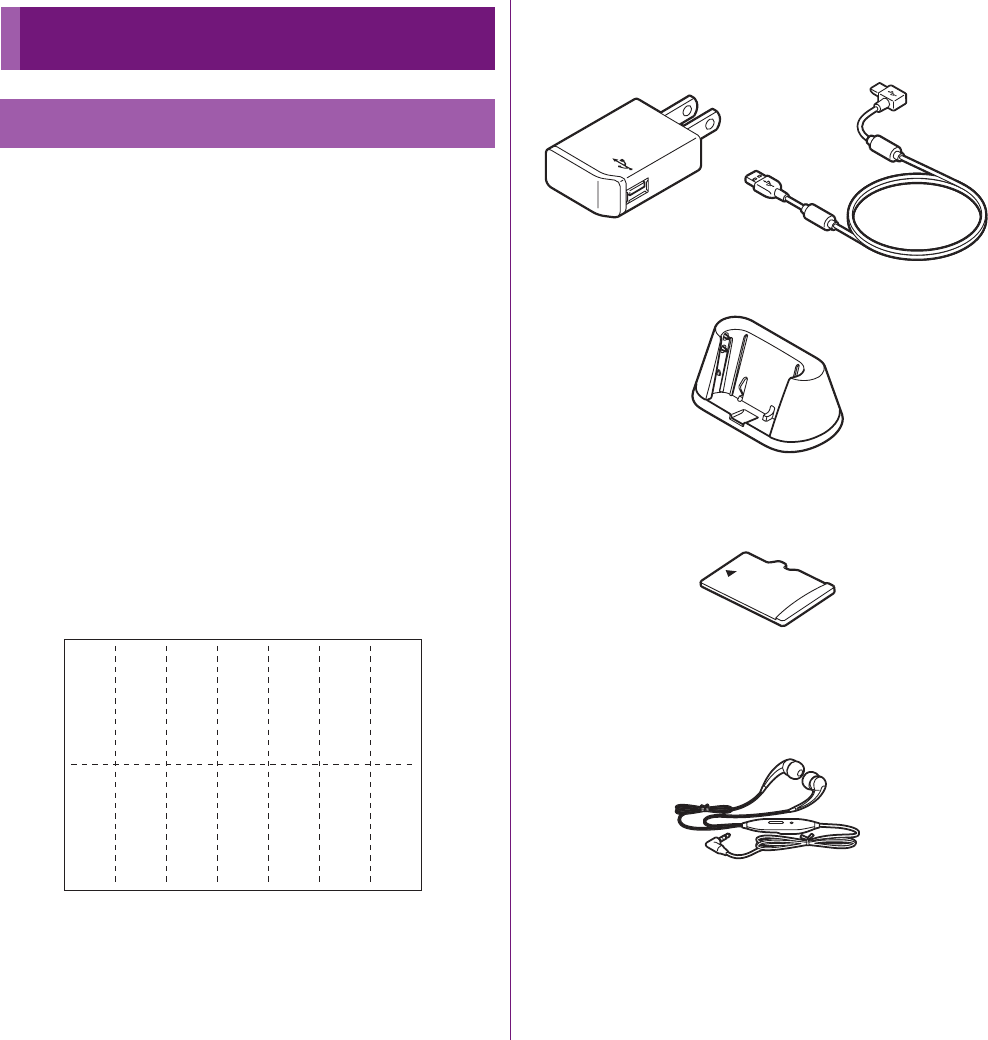
1
・
SO-04D (with warranty)
・
クイックスタートガイド
(Quick Start Guide)
(In Japanese only)
・
SO-04D
のご利用にあたっての注意事項
安全上/取り扱い上のご注意
(Notes on usage Safety/Handling
precautions) (In Japanese only)
・
AC Adapter Cable SO04 (with warranty)
・
Desktop Holder SO12 (with warranty)
・
microSD card (2GB)
*
(Sample)
(with manual)
* Inserted in the terminal when purchased.
・
Stereo Headset with Microphone (Sample)
(with manual)
For details on optional devices, see "Optional
and related devices" (P.243).
Supplied accessories
Supplied accessories
クイック
スタート
ガイド
<AC adapter> <microUSB cable>

2
In addition to this manual, the operations of
SO-04D are described in "
クイックスタートガ
イド
(Quick Start Guide)" (in Japanese only)
and "Instruction Manual" application of the
terminal.
The initial operations and settings after
purchasing the terminal, screen view
contents and operations of main function are
explained. (In Japanese only)
Similarly to this manual, operations and
settings of each function are explained.
To use "Instruction Manual" application, from
the Home screen,
u
Tap [Instruction
Manual]. For the first time using, download
and install it according to the onscreen
instructions. You can use the application as
an electronic book. You can also shift to
actual operations by tapping the description
in the contents or view reference contents.
❖
Note
・
For downloading or updating the application, a high
packet communication charge will be applied
because of a large amount data communication. For
this reason, subscription of packet flat-rate service is
highly recommended.
* If you use Wi-Fi function to download, packet
communication charges are not applied.
Operations and settings of each function are
explained.
It can be downloaded from NTT DOCOMO
website.
http://www.nttdocomo.co.jp/english/
support/trouble/manual/download/
index.html
* You can download the latest information of
"
クイックスタートガイド
(Quick Start Guide)"
(in Japanese only). The URL and contents are
subject to change without prior notice.
❖
Note
・
Reproduction or reprint of all or part of this manual
without prior permission is prohibited.
・
Important information for SO-04D is posted in the
following website. Be sure to check before using.
http://www.sonymobile.co.jp/support/use_support/
product/so-04d/
About manuals of SO-04D
"
クイックスタートガイド
(Quick
Start Guide)" (Supplied
accessories)
"Instruction Manual"
(Application of the terminal)
"Instruction Manual" (PDF file)

3
In this manual, each key operation is
described with
p
,
x
,
y
,
t
,
m
,
k
. And selection operations of
the icons or function items on the touch
panel are described as follows.
❖
Information
・
In this manual, the instructions are described with
the default Home screen. If you set the other
application to the home screen, the operations may
differ from the descriptions.
・
Display examples and illustrations used in this
manual are just images for explanations and may be
different from actual ones.
・
In this manual, the easier procedure is described for
the functions and settings which have multiple
operating procedures.
・
Please note that "SO-04D" is called "the terminal" in
this manual.
・
In this manual, explanations for "docomo" as Home
application are provided. To switch the Home
applications, see "Learning Home screen" (P.66).
Operation descriptions
Description Operation
From the Home
screen, tap
t
and tap [Settings].
From the Home screen, tap
t
(Menu) key and tap
"Settings" on the screen.
Tap
[Settings]
u
[Date
& time]
u
[Set
date].
Tap "Settings" displayed on the
screen, and then tap "Date &
time" on the next screen and
"Set date" on the following
screen in order.
Tap to zoom
in or out on a map.
Tap displayed on the
screen to zoom in or out the
map.
Touch and hold
icon.
Keep touching the icon longer
(1-2 seconds).

4
Contents/Precautions
Contents/Precautions
Supplied accessories . . . . . . . . . . . . . . . . . . . . . . . . . . . . . . . . . . . . . . . . . . . . . . . . . . . . . . . . . . . . . . . . 1
About manuals of SO-04D. . . . . . . . . . . . . . . . . . . . . . . . . . . . . . . . . . . . . . . . . . . . . . . . . . . . . . . . . . . 2
Notes on usage . . . . . . . . . . . . . . . . . . . . . . . . . . . . . . . . . . . . . . . . . . . . . . . . . . . . . . . . . . . . . . . . . . . . . 7
Safety Precautions (Always follow these directions) . . . . . . . . . . . . . . . . . . . . . . . . . . . . . . . . . . 9
Handling precautions . . . . . . . . . . . . . . . . . . . . . . . . . . . . . . . . . . . . . . . . . . . . . . . . . . . . . . . . . . . . . . 18
Contents
Before Using the Terminal
→
P.29
・
Part names and functions ................................................................... 29
・
UIM .............................................................................................................. 30
・
microSD card ........................................................................................... 31
・
Charging.................................................................................................... 33
・
Turning power on/off ........................................................................... 37
・
Initial settings (Setup guide).............................................................. 39
・
Status bar .................................................................................................. 41
・
Notification panel .................................................................................. 42
・
Notification LED...................................................................................... 43
・
Basic operations ..................................................................................... 44
・
Searching information in the terminal and web pages ........... 46
・
Character entry ....................................................................................... 47
・
Setting character entry ........................................................................ 60
・
Setting Japanese keyboard................................................................ 60
docomo Palette UI
→
P.66
・
Home screen............................................................................................ 66
・
Applications screen............................................................................... 71
Calling/Network Services
→
P.81
・
Making/Receiving a call....................................................................... 81
・
Call history ................................................................................................ 85
・
Phonebook............................................................................................... 87
・
Network Services.................................................................................... 96

5
Contents/Precautions
Settings
→
P.107
・
Viewing the setting menu ................................................................107
・
docomo service ....................................................................................107
・
Xperia
™ ...............................................................................
108
・
Wireless & networks............................................................................109
・
Call settings............................................................................................119
・
Sound .......................................................................................................119
・
Display......................................................................................................122
・
Location & security..............................................................................124
・
Applications ...........................................................................................129
・
Accounts & sync....................................................................................132
・
Privacy......................................................................................................135
・
Storage.....................................................................................................136
・
Language & keyboard ........................................................................138
・
Voice input & output...........................................................................138
・
Accessibility............................................................................................139
・
Date & time.............................................................................................139
・
About phone .........................................................................................140
Mail/Internet
→
P.141
・
sp-mode mail.........................................................................................141
・
Message (SMS) ......................................................................................141
・
Email .........................................................................................................144
・
Using Gmail............................................................................................151
・
Google Talk.............................................................................................151
・
Early Warning "AreaMail"...................................................................152
・
Using Browser........................................................................................153
File management
→
P.158
・
Handling a file .......................................................................................158
・
Transferring and moving data.........................................................158
・
Using Infrared communication.......................................................163
・
Using Bluetooth function..................................................................166
・
Sharing files with DLNA devices via Connected devices (Media
server).......................................................................................................170

6
Contents/Precautions
Applications
→
P.172
・
Shooting with the camera ................................................................172
・
Capturing the screenshot .................................................................191
・
Playing multimedia content.............................................................192
・
Viewing photos/videos......................................................................193
・
Playing YouTube video.......................................................................198
・
Connecting the terminal to TV to watch photos and videos
....................................................................................................................199
・
Music player...........................................................................................200
・
Using Android Market ........................................................................204
・
Timescape
™ ........................................................................
205
・
About location services .....................................................................209
・
1Seg ..........................................................................................................215
・
FM radio...................................................................................................222
・
Osaifu-Keitai...........................................................................................223
・
Calendar ..................................................................................................227
・
Alarm and Clock ...................................................................................229
・
OfficeSuite ..............................................................................................233
・
Other applications...............................................................................233
International roaming
→
P.234
・
Overview of International roaming (WORLD WING)...............234
・
Available Services.................................................................................234
・
Before using ...........................................................................................235
・
Making/Receiving calls in the country you stay .......................238
・
International roaming settings .......................................................240
Appendix/Index
→
P.243
・
Optional and related devices...........................................................243
・
Troubleshooting...................................................................................243
・
Warranty and After Sales Services..................................................249
・
Updating software...............................................................................252
・
Main specification................................................................................255
・
Authorization and Compliance.......................................................257
・
Specific Absorption Rate of Mobile Phone, etc.........................258
・
End User Licence Agreement...........................................................270
・
About Open Source Software..........................................................271
・
Export Controls and Regulations ...................................................272
・
Intellectual Property Right................................................................272
・
Index .........................................................................................................272

7
Contents/Precautions
Contents/Precautions
・
The terminal does not support i-mode sites
(programs) or i-
D
ppli.
・
The terminal automatically performs
communication for synchronizing data,
checking the latest software version, maintain
connection with the server, etc. If you
transmit a large amount of data such as
downloading applications or watching
movie, a packet communication charge
becomes high. Subscription of packet flat-
rate service is highly recommended.
・
Public mode (Driving mode) is not supported.
・
Setting the phone to silent mode does not
mute playback sound of video or music,
alarm, etc.
・
The names of the operators are displayed on
key lock canceling screen (P.39).
・
Your phone number (own number) can be
checked as follows:
From the Home screen, tap
t
and tap
[Settings]
u
[About phone]
u
[Status].
・
The software version of your terminal can be
checked as follows:
From the Home screen, tap
t
and tap
[Settings]
u
[About phone].
・
You can perform software update by
downloading an update file with a PC via
Internet and connecting the PC to the
terminal. For details, see "Connecting to a PC
and updating" (P.254).
・
By some software updates, the operating
system (OS) may be version-upgraded for
improving the terminal quality. For this
reason, you always need to use the latest OS
version. And some applications that used in
the previous OS version may not be available
or some unintended bugs may occur.
・
When using the terminal inserting some UIM
(FOMA card) (green), voice calls and packet
communication may not be available in some
overseas networks. For using overseas, please
visit a docomo Shop near you. DOCOMO
exchanges UIM (FOMA card) (green) for UIM
free of charge.
・
Set the screen lock to ensure the security of
your terminal for its loss. For details, see
"Screen lock" (P.127).
・
If your terminal is lost, change your each
account password to invalidate
authentication using a PC to prevent other
persons from using Google services such as
Google Talk, Gmail, Android Market, etc.,
Facebook, Twitter and mixi.
・
The terminal supports only sp-mode, mopera
U and Business mopera Internet. Other
providers are not supported.
Notes on usage

8
Contents/Precautions
・
Battery is built into the terminal and cannot
be replaced by yourself.
・
To use tethering, subscription of sp-mode is
required.
・
Packet communication charge when using
tethering varies depending on the charging
plan you use. Subscription of packet flat-rate
service is highly recommended.
・
For details on usage charge, etc., refer to http:/
/www.nttdocomo.co.jp/ .
Notice:
Pursuant to the Japanese Radio Law (電波法)
and the Japanese Telecommunications
Business Law (電気通信事業法), this device
has been granted a designation number
according to the
"Ordinance concerning the Technical
Regulations Conformity Certification etc. of
Specified Radio Equipment (特定無線設備の
技術基準適合証明等に関する規則)"
R-(W-CDMA)/Article 2-1-11-3,
R-(W-CDMA)/Article 2-1-11-7,
IEEE802.11bgn (2.4GHz)/Article 2-1-19,
IEEE802.11an (5GHz)/Article 2-1-19-3,
IEEE802.11an (5GHz)/Article 2-1-19-3-2,
LTE/Article 2-1-11-19,
BT/Article 2-1-19:
202-SMA015
and "Ordinance Concerning Technical
Conditions Compliance Approval etc. of
Terminal Equipment (端末機器の技術基準適
合認定等に関する規則)"
T-(W-CDMA): AD 12-0012 202
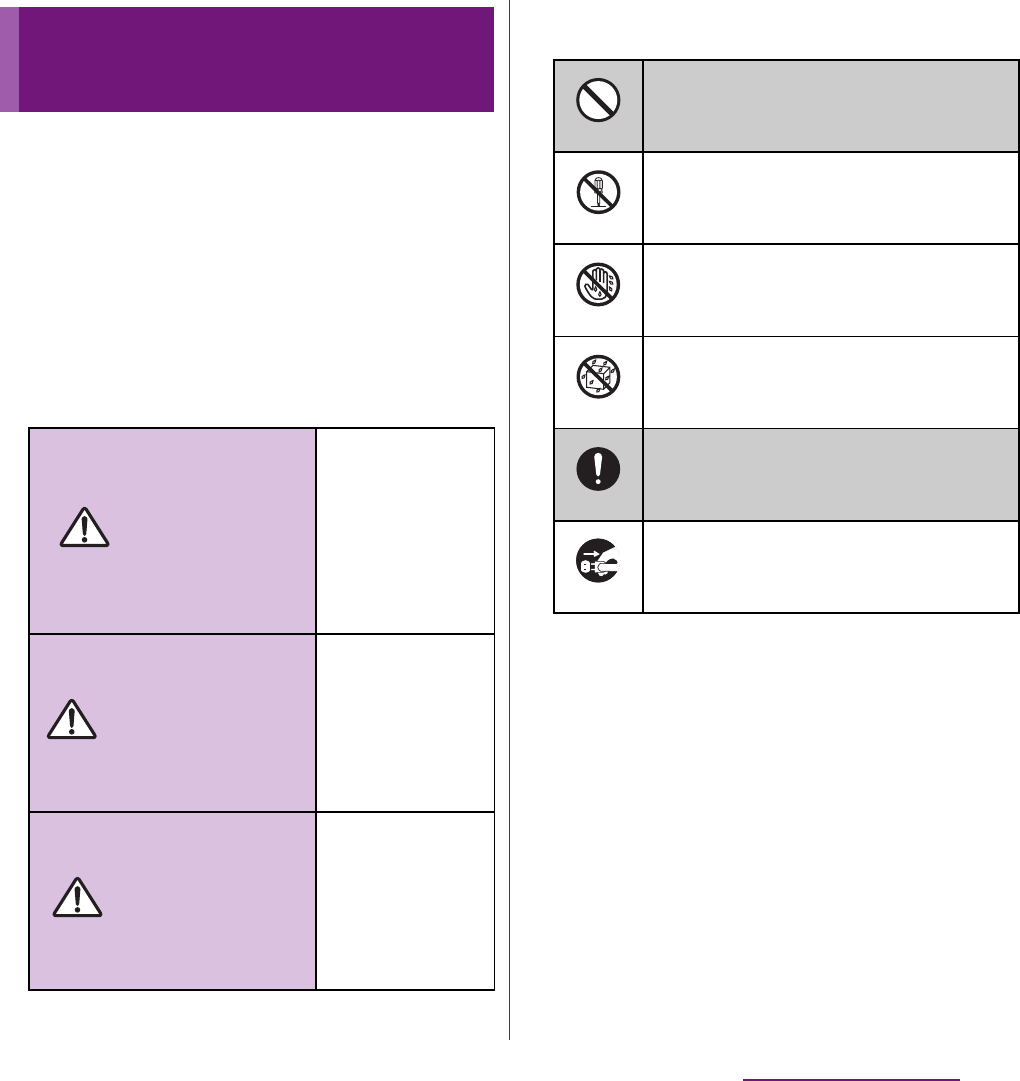
9
Contents/Precautions
■
For safe and proper use of the terminal, please
read the "Safety Precautions" prior to use.
Keep the Manual in a safe place for future
reference.
■
ALWAYS observe the safety precautions since
they intend to prevent personal injury or
property damage.
■
The following symbols indicate the different
levels of injury or damage that may result if
the guidelines are not observed and the
terminal is used improperly.
■
The following symbols indicate specific
directions.
■
"Safety Precautions" are described in the
following categories:
1. Handling the terminal, AC Adapter cable,
Desktop Holder and UIM (general) . . . . . . . . . 10
2. Handling the terminal . . . . . . . . . . . . . . . . . . . . . . 12
3. Handling the adapter and desktop holder. . . 15
4. Handling the UIM . . . . . . . . . . . . . . . . . . . . . . . . . . 16
5. Handling the terminal near electronic medical
equipment . . . . . . . . . . . . . . . . . . . . . . . . . . . . . . . . 16
6. Material list . . . . . . . . . . . . . . . . . . . . . . . . . . . . . . . . 17
Safety Precautions (Always
follow these directions)
Failure to
observe these
guidelines may
immediately
result in death
or serious
injury.
Failure to
observe these
guidelines may
result in death
or serious
injury.
Failure to
observe these
guidelines may
result in injury
and property
damage.
DANGER
WARNING
CAUTION
Indicates prohibited actions.
Indicates not to disassemble.
Indicates not to handle with wet
hands.
Indicates not to use where it could
get wet.
Indicates compulsory actions in
accordance with instructions.
Indicates to remove the power plug
from the outlet.
Don’t
No disassembly
No wet hands
No liquids
Do
Unplug

10
Contents/Precautions
1. Handling the terminal, AC Adapter
cable, Desktop Holder and UIM
(general)
DANGER
Do not use, store or leave the equipment in
hot places (e.g. by the fire, near a heater,
under a kotatsu, in direct sunlight, in a car in
the hot sun). (including the event that you
ware the equipment in the pocket of your
clothes, etc.)
Doing so may cause fire, burns or injury.
Do not place equipment inside cooking
appliance such as a microwave oven or high-
pressure containers.
Doing so may cause fire, burns, injury or
electric shock.
Do not disassemble or modify the
equipment.
Doing so may cause fire, burns, injury or
electric shock.
Do not let the equipment get wet with
water, drinking water, urine of pet animals,
etc.
Doing so may cause fire, burns, injury or
electric shock.
Use the AC adapter cable for the terminal
specified by DOCOMO.
Failure to do so may cause fire, burns, injury or
electric shock.
WARNING
Do not subject the equipment to excessive
force or throw it.
Doing so may cause fire, burns, injury or
electric shock.
Do not allow the microUSB connecting jack,
headset connecting jack or HDMI
connecting jack to come in contact with
conducting foreign substances (a piece of
metal, pencil lead, etc.). Never allow these
objects to get into the connecting jack.
Doing so may cause fire, burns, injury or
electric shock.
Do not cover or wrap the equipment with a
cloth or bedding in use or while charging.
Doing so may cause fire or burns.
Power off the terminal before you step into a
place where flammable gas can leak, such as
gas stations. Stop charging if you charge the
battery.
Gas may catch fire.
When using Osaifu-Keitai in a place such as a
gas station, turn OFF the terminal before using
it.
(When Osaifu-Keitai lock is activated,
deactivate it before turning OFF the terminal.)
Don’t
Don’t
No disassembly
No liquids
Do
Don’t
Don’t
Don’t
Do

11
Contents/Precautions
If you notice anything unusual about the
equipment such as an unusual odor,
overheating, discoloration or deformation
during operation, charging or storage,
immediately perform the following
measures.
・
Remove the power plug from the power
outlet.
・
Power off the terminal.
Failure to do so may cause fire, burns, injury or
electric shock.
CAUTION
Do not place on an unstable or inclined
platform.
Doing so may cause the device to fall and
cause injury.
Do not keep in a place that is very humid,
dusty, or subject to high temperature.
Doing so may cause fire, burns or electric
shock.
If children use the terminal, parents or
guardians should give them the proper
instructions for use. Make sure that they use
the terminal as instructed.
Failure to do so may cause injury.
Keep the equipment out of the reach of
babies and infants.
Failure to do so may cause accidental
swallowing or injury.
Be careful especially when you use the
terminal while it has been continuously
connected to the AC adapter cable for a long
period of time.
If you play a game or watch 1Seg for a long
time while charging, the temperature of the
terminal and AC adapter cable may rise.
If you are directly in contact with hot parts for
a long period of time, it may cause your skin to
become red, itchy, or develop a rash
depending on your physical condition and
also it may cause low-temperature burn.
Observe the followings for 3D image
function.
・
Do not view 3D images shot by the terminal
with a 3D compatible monitor for a long
time. Doing so may cause unpleasant
symptom such as eyestrain, fatigue, feeling
ill, etc.
・
For viewing 3D images, you are
recommended to take a proper break.
Necessary break length or frequency varies
by individual. Judge for yourself.
・
When you experience unpleasant symptom,
stop viewing 3D images until you get healed
up and seek the advice of a doctor if
necessary. Also refer to the manuals come
with the device for connecting to the
terminal or software.
・
Vision of child (especially younger than 7
years) is during development. Before a child
views 3D images, seek the advise of a doctor
such as pediatrics or ophthalmologist. Adults
should supervise a child for the above
precautions.
Do
Don’t
Don’t
Do
Do
Do
Do
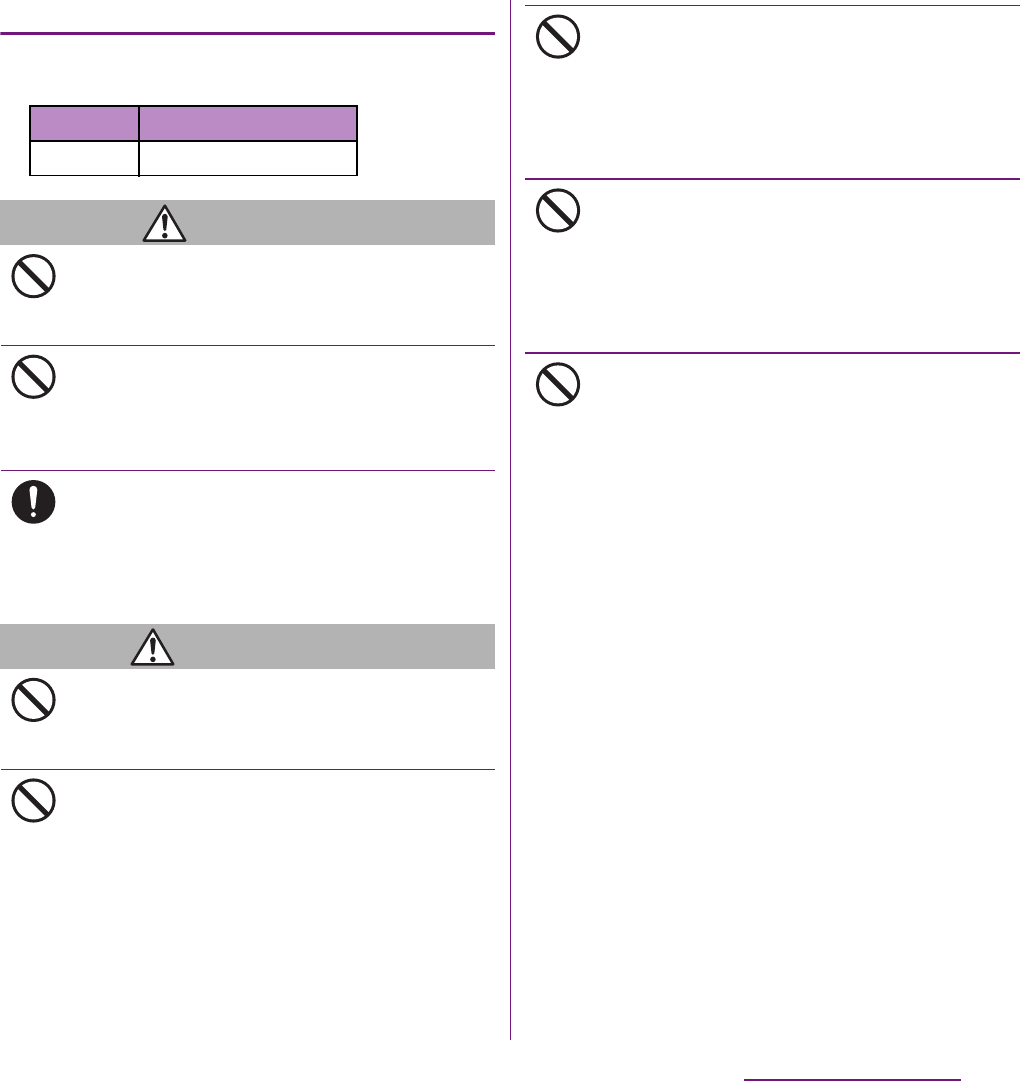
12
Contents/Precautions
2. Handling the terminal
■
The internal battery for the terminal is as
follows.
DANGER
Do not throw the terminal into fire.
Doing so may cause internal battery to ignite,
explode, overheat or leak.
Do not stick a nail into the terminal, hit it
with a hammer, or step on it.
Doing so may cause internal battery to ignite,
explode, overheat or leak.
If the internal battery fluid gets into your
eyes, do not rub, rinse with clean running
water, and get medical treatment
immediately.
Failure to do so may cause blindness.
WARNING
Do not direct the infrared data port toward
your eye and transmit signals.
Doing so may cause harmful effect your eyes.
Do not direct the infrared data port toward
home electric appliances etc. equipped with
infrared device when using infrared
communication.
Doing so may cause an accident because of
malfunction of infrared device.
Do not turn on the light with the lighting
luminescence part close to the eyes.
Especially to shoot infants or young
children, step away from them 1 m or more.
Doing so may cause blurred vision. Or injury
by dazzling eyes or surprising may occur.
Do not allow a foreign substance such as
water and other liquids, metal parts, or
flammables to get in the UIM or microSD
card insertion slot on the terminal.
Doing so may cause fire, burns, injury or
electric shock.
Do not turn on the light toward a driver of a
car etc.
Doing so may disturb driving and cause an
accident.
Display Type of Battery
Li-ion 00 Lithium Ion Battery
Don’t
Don’t
Do
Don’t
Don’t
Don’t
Don’t
Don’t

13
Contents/Precautions
Power off the terminal in a place where the
use is prohibited such as in airplane or
hospital.
Failure to do so may affect electronic
equipment and electronic medical
equipment. If you set the automatic power-on
function, cancel it before powering off the
terminal.
Follow the instructions of each medical facility
for the use of mobile phones on their
premises.
Prohibited acts such as mobile phone usage
on board an airplane may be punished by law.
If usage of mobile phones in an aircraft is
admitted by setting airplane mode, etc., use
the terminal under the direction of the airline.
If the microUSB cable is connected into the
USB connecting jack for charging etc, the
terminal is automatically powered on
although the operations are not available. Be
careful not to connect the microUSB cable in a
place where the use is prohibited such as in
airplane or hospital.
Always keep the terminal away from your
ear when you talk setting the hands-free
function.
Also, when you play game, play back music,
etc. connecting the Earphone/Microphone,
etc. to the terminal, adjust the volume
adequately.
If the volume is too loud, it may cause
difficulty in hearing.
Moreover, if you barely hear the surrounding
sounds, it may cause an accident.
If you have a weak heart, set the vibrator or
ringtone volume carefully.
Failure to do so may affect your heart.
If you are wearing any electronic medical
equipment, check with the relevant medical
electronic equipment manufacturer or
vendor whether the operation may be
affected by radio waves.
The radio waves from the terminal may affect
electronic medical equipment.
Power off the terminal near electronic
devices or equipment operating on high
precision control or weak signals.
Failure to do so may interfere with the
operation of electronic devices or equipment.
* The followings are some electronic devices
or equipment that you should be careful of:
Hearing aids, implantable cardiac
pacemaker, implantable cardioverter
defibrillator, other electronic medical
equipment, fire detector, automatic door,
and other automatically controlled devices
or equipment.
If you use an implantable cardiac
pacemaker, implantable cardioverter
defibrillator, or other electronic medical
equipment, check with the relevant medical
electronic equipment manufacturer or
vendor whether the operation can be
affected by radio waves.
Be careful about broken glasses or exposed
internal from the terminal if the display or
the camera lens is broken.
Shatterproof film-applied hardened glass is
used on the display surface and the acrylic
resin is applied on camera lens so as not to be
shattered when broken. But they may cause
injury if you touch a cut surface or exposed
portion mistakenly.
Do
Do
Do
Do
Do
Do

14
Contents/Precautions
If the internal battery leaks or hears an
unusual odor, immediately stop using and
move it away from fire.
The leaking liquid may ignite fire, catch fire, or
explode.
CAUTION
Do not swing the terminal around by
holding the antenna or strap.
The terminal may hit you or others and cause
accident such as injury.
Do not use damaged terminal.
Doing so may cause fire, burns, injury or
electric shock.
If the display is mistakenly damaged and
when the liquid crystal runs out, do not get
it on your skin such as face, hands, etc.
Doing so may cause blindness or injury on
your skin.
If the liquid crystal gets in your eye or mouth,
rinse with clean running water, and get
medical treatment immediately.
Also, if it gets on your skin or clothes, use
something such as alcohol to wipe off and
wash it with soap in clear water.
Do not discard the battery pack together
with other garbage.
The terminal may become the source of fire or
environmental destruction. Take the used
terminal to our service counter (docomo
Shop, etc.) or follow the instructions of the
local authorities in charge of collecting used
terminals.
To use the terminal in car, check with
automobile manufacturer or dealer to
determine how the device is affected by
radio waves before using.
In rare cases, using the phone in some vehicle
models can cause the vehicle's electronic
equipment to malfunction. In that case, stop
using the terminal immediately.
The use of the terminal may cause itching,
rashes, eczema, or other symptoms
depending on the user's physical condition.
Immediately stop using and get medical
treatment in such a case.
For material of each part
→
P.17 "Material list"
When watching the display, take a certain
distance from the display in a fully bright
place.
Failure to do so may reduce visual acuity.
If fluid etc. leaks out from the internal
battery, do not make the fluid contact with
your skin of face or hands.
Doing so may cause blindness or injury on
your skin.
If the fluid etc. gets into your eyes or mouth, or
contacts skin or clothes, immediately flush the
contacted area with clean running water.
If the fluid gets into the eyes or mouth,
immediately see a doctor after flushing.
Do
Don’t
Don’t
Don’t
Don’t
Do
Do
Do
Do

15
Contents/Precautions
3. Handling the adapter and desktop
holder
WARNING
Do not use the microUSB cable if it is
damaged.
Doing so may cause fire, burns or electric
shock.
Do not use the AC adapter cable or the
desktop holder in a very humid or steamy
place such as bathroom.
Doing so may cause fire, burns or electric
shock.
DC adapter is only for a negative ground
vehicle. Do not use DC adapter for a positive
ground vehicle.
Doing so may cause fire, burns or electric
shock.
Do not touch the AC adapter cable if you
hear thunder.
Doing so may cause electric shock.
Do not short-circuit the microUSB plug
while it is connected to the power outlet. Do
not touch the microUSB plug with your
hands, fingers, or any part of your body.
Doing so may cause fire, burns or electric
shock.
Do not place any heavy objects on the
microUSB cable.
Doing so may cause fire, burns or electric
shock.
When you insert and remove AC adapter
from power outlet, do not contact a metal
strap or other metal objects with the jack.
Doing so may cause fire, burns or electric
shock.
Do not touch the cord of the AC adapter
cable, the desktop holder or the power
outlet with wet hands.
Doing so may cause fire, burns or electric
shock.
Use the adapter only on the specified power
supply and voltage.
Use the AC adapter cable available overseas
when you charge the battery overseas.
Failure to do so may cause fire, burns or
electric shock.
AC adapter : AC 100 V to 240 V (Make sure to
connect the adapter to a household AC power
outlet.)
DC adapter : DC 12 V or 24 V (only for a
negative-ground vehicle)
When the fuse in a DC adapter is blown,
make sure to use the specified fuse.
Failure to do so may cause fire, burns or
electric shock. For the specified fuse, see the
users manuals that supplied with a DC
adapter.
Clean dust from the power plug.
Failure to do so may cause fire, burns or
electric shock.
When you connect the AC adapter to the
power outlet, insert it firmly.
Failure to do so may cause fire, burns or
electric shock.
Don’t
Don’t
Don’t
Don’t
Don’t
Don’t
Don’t
No wet hands
Do
Do
Do
Do
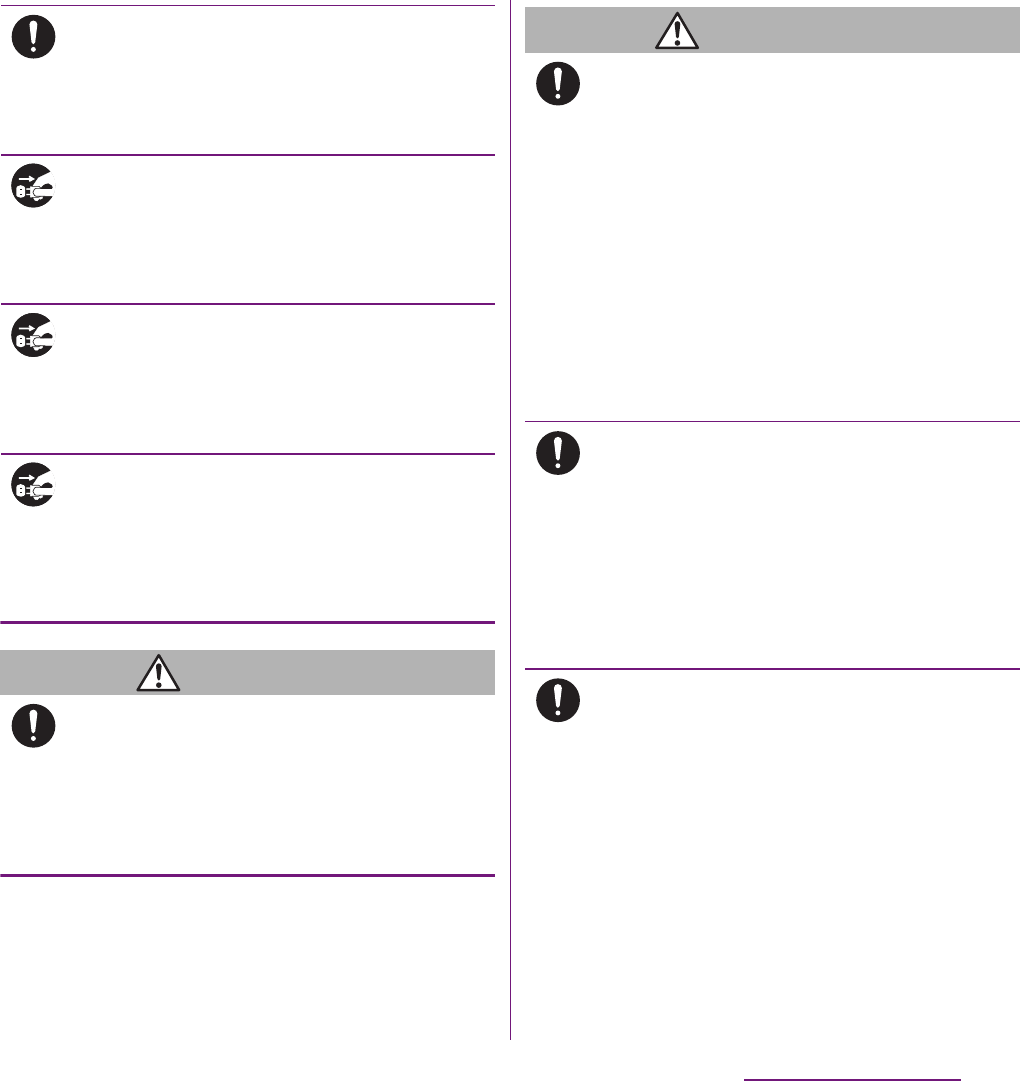
16
Contents/Precautions
Hold the AC adapter, not the microUSB
cable, when you remove the power plug
from the power outlet.
Failure to do so may cause fire, burns or
electric shock.
Remove the power plug from the power
outlet when not used for a long period of
time.
Failure to do so may cause fire, burns or
electric shock.
If liquid such as water gets into the adapter,
immediately remove it from the power
outlet.
Failure to do so may cause fire, burns or
electric shock.
Before cleaning, remove the power plug
from the power outlet.
Failure to do so may cause fire, burns or
electric shock.
4. Handling the UIM
CAUTION
Please be careful not to touch a cut surface
when you remove the UIM.
Failure to do so may cause injury.
5. Handling the terminal near
electronic medical equipment
■
The following instructions observe the
guidelines of the Electromagnetic
Compatibility Conference, Japan to protect
electronic medical equipment from radio
waves from mobile phones.
WARNING
Please observe the following guidelines in
medical facilities.
・
Do not take the terminal into the operating
rooms, ICU (Intensive Care Unit), or CCU
(Coronary Care Unit).
・
Power off the terminal inside hospital wards.
・
Power off the terminal in the lobby and
other places if there are any electronic
medical equipment operating in the vicinity.
・
Follow the instructions of each medical
facility when they specify areas forbidding to
use and carrying a mobile phone.
・
If you set the automatic power-on function,
cancel it before powering off the terminal.
Power off the terminal in crowded places
such as rush-hour trains. There may be a
person with an implantable cardiac
pacemaker or implantable cardioverter
defibrillator near you.
The radio waves from the terminal may affect
the operation of implantable cardiac
pacemaker or implantable cardioverter
defibrillator.
If you use an implantable cardiac pacemaker
or implantable cardioverter defibrillator,
keep the terminal 22 cm or more away from
the implant at all times.
The radio waves from the terminal may affect
the performance of electronic medical
equipment.
Do
Unplug
Unplug
Unplug
Do
Do
Do
Do

17
Contents/Precautions
If you need to use electronic medical
equipment other than implantable cardiac
pacemaker or implantable cardioverter
defibrillator outside medical facilities such
as treating at home, check with the relevant
medical electronic equipment manufacturer
whether the operation may be affected by
radio waves.
The radio waves from the terminal may affect
the performance of electronic medical
equipment.
6. Material list
Part Material Surface
treatment
Exterior case
(cover front)
(terminal color :
Black)
PC resin
(with glass) +
SUS plate
Urethan coating
Exterior case
(cover front)
(terminal color :
Aqua/Sakura/
Ceramic)
PC resin
(with glass) +
SUS plate
UV coating
Exterior case
(rear frame)
PC resin
(with glass)
Discontinuous
evaporation
coating (tin) +
UV coating
Exterior case
(cover back)
(terminal color :
Black)
PC resin
(with glass)
Urethan coating
Do
Exterior case
(cover back)
(terminal color :
Aqua/Sakura/
Ceramic)
PC resin
(with glass)
UV coating
Exterior case (HDMI/
headset/microUSB
connecting jack
cover)
PC resin Discontinuous
evaporation
coating (tin) +
UV coating
Exterior case
(microSD card slot/
UIM card slot cover)
(terminal color :
Black)
PC resin
(with glass)
Discontinuous
evaporation
coating (tin) +
urethane
coating
Exterior case
(microSD card slot/
UIM card slot cover)
(terminal color :
Aqua/Sakura/
Ceramic)
PC resin
(with glass)
Discontinuous
evaporation
coating (tin) +
UV coating
Transparent plate
(camera)
PC resin +
PMMA resin
AR treatment
Transparent plate
(flash)
PC resin
ー
Transparent plate
(display)
Glass + PET
resin
Hard coating
Side keys (power
key, volume key,
camera key)
PC resin UV coating
Whip antenna cap PC/ABS resin
ー
Part Material Surface
treatment

18
Contents/Precautions
■
Common precautions
・
Clean the terminal with a dry soft cloth
(such as used for cleaning eyeglasses).
- Do not rub it roughly with a dry cloth. The
display may be damaged.
- Drops of water or dirt left on the display may
cause stains.
- Do not use alcohol, thinner, benzine, cleaning
detergent, etc. to clean the terminal. These
chemicals may erase the printing on the
terminal or cause discoloration.
・
Clean the terminals occasionally with a
dry cotton swab.
If the jack is soiled, connection gets worse and it
may cause power to be turned off or insufficient
battery charge, so clean the jack with a dry
cotton swab etc. When cleaning, be careful not
to damage the terminals.
・
Do not leave the terminal near the air
conditioning vent.
Extreme temperature changes may produce
condensation and corrode the internal parts of
the terminal, causing it to malfunction.
・
Make sure to use the terminal etc. without
excessive force.
If you put the terminal in a bag full of items or sit
down with the terminal in the pocket of your
cloth, it may damage the display and internal
circuit board, and cause the terminal to
malfunction.
Also, while the external device is connected to
the microUSB connecting jack, headset
connecting jack or HDMI connecting jack, it may
damage the connector and cause malfunction.
・
Do not rub or scratch the display with
metal.
The display may get scratched and it may cause
malfunction or damage.
・
Make sure to see the user's manuals
supplied with the AC adapter cable.
Handling precautions

19
Contents/Precautions
■
The terminal precautions
・
Do not press touch panel surface forcibly,
or not operate with a sharp-pointed
objects such as nail, ballpoint pen, pin,
etc.
Doing so may cause damage of touch panel.
・
Do not use the terminal in extremely hot
or cold places.
Use the terminal where the temperature ranges
between 5
℃
and 40
℃
(limited to the temporary
use in a bathroom etc. when temperature is 36
℃
or more) and humidity ranges between 45% and
85%.
・
Using the terminal near ordinary phone,
television or radio may cause interference
in these electric appliances. Make sure to
move far away from them when using the
terminal.
・
Note down the information saved in the
terminal in a separate note and keep it
safely.
Under no condition will DOCOMO be held liable
for any damaged or lost data saved in the
terminal.
・
Do not drop or give a strong impact to the
terminal.
Doing so may cause malfunction or damage.
・
Do not plug the connector of the external
device into the microUSB connecting jack,
headset connecting jack or HDMI
connecting jack at the slant or pull it while
connecting.
Doing so may cause malfunction or damage.
・
The terminal could become warm while
in use and charging. This condition is not
abnormal. You can continue using the
terminal.
・
Do not leave the camera under direct
sunlight.
If you do so, some of the elements may melt or
become faded.
・
Usually use the terminal with the
connecting jack covers for microUSB/
headset/HDMI and covers for UIM card
slot and microSD card slot closed.
Failure to do so may get dust or water inside and
cause malfunction.
・
Do not remove the microSD card or
power off the terminal while using the
microSD card.
Doing so may cause data loss or malfunction.
・
Do not let magnetic cards, etc. close to
the terminal.
The magnetic data in cash cards, credit cards,
telephone cards, floppy disks, etc. may be erased.
・
Do not bring strong magnetic objects
close to the terminal.
Strong magnetic objects may cause
misoperation.

20
Contents/Precautions
・
The internal battery is a consumable
accessory.
Even if the operating time of the terminal varies
depending on the operating conditions and
other factors, when the length of time you can
use the terminal with a fully charged battery
becomes unusually short, it is time to replace the
internal battery. For replacement of internal
battery, contact "General Inquiries" on the last
page of this manual or the DOCOMO-specified
repair office.
・
Charge the battery pack in an
environment with the proper ambient
temperature (5
℃
to 35
℃
).
・
The operating time of the internal battery
varies depending on the operating
environment and the secular degradation
of the internal battery.
・
Do not store the internal battery in the
following cases:
- The battery is fully charged (immediately after
the charging is complete)
- The battery has run out (the phone cannot
power on)
The performance and life of the internal battery
may deteriorate.
It is recommended that you store the internal
battery with the remaining battery level of about
40 percent as a guide.
■
The adapter precautions
・
Charge the battery pack in an
environment with the proper ambient
temperature (5
℃
to 35
℃
).
・
Do not charge in the following places.
- Places that are very humid, dusty or exposed to
strong vibrations.
- Near ordinary phone or TV/radio.
・
The AC adapter cable could become
warm while charging. This condition is
not abnormal. You can continue using the
terminal.
・
When using the DC adapter for charging,
do not turn off the vehicle engine.
Doing so may cause the vehicle battery run out.
・
When you use the power outlet with a
mechanism to prevent the plug from
being removed, follow the instructions on
the outlet's user's manual.
・
Do not give a strong impact to the
adapter. Also, do not bend or deform the
microUSB plug.
Doing so may cause malfunction.
■
UIM precautions
・
Do not use unnecessary force to insert/
remove the UIM.
・
Note that DOCOMO assumes no
responsibility for malfunctions occurring
as the result of inserting and using UIM
with another IC card reader/writer.
・
Always keep the IC portion clean when
you use the card.
・
Clean the terminal with a dry soft cloth
(such as used for cleaning eyeglasses).

21
Contents/Precautions
・
Note down the information saved in the
UIM in a separate note and keep it safely.
Under no condition will DOCOMO be held liable
for any damaged or lost data saved in the
terminal.
・
Take an expended UIM to sales outlet
such as docomo Shop for proper disposal
in order to protect the environment.
・
Do not carelessly damage, contact, or
short-circuit an IC.
Doing so may cause data loss or malfunction.
・
Do not drop a UIM or subject it to impact.
Doing so may cause malfunction.
・
Do not bend a UIM or place a heavy
object on it.
Doing so may cause malfunction.
・
Do not insert the UIM on which any label
or seal is stuck into the terminal.
Doing so may cause malfunction.
■
Bluetooth function precautions
・
To secure the Bluetooth communication
security, the terminal supports the
security function compliant with
Bluetooth standards, but the security may
not be sufficient depending on the
setting. Concern about the
communication using the Bluetooth
function.
・
Please be aware that DOCOMO is not
responsible for data leak when making
data communications using Bluetooth.
・
Frequency band
The frequency band used by the terminal's
Bluetooth/wireless LAN function is as follows.
2.4 : This radio equipment uses the 2400 MHz
band.
FH/XX/DS/OF
:
Modulation scheme is the
FH-SS, other system, DS-SS,
or OFDM system.
1 : The estimated interference distance is 10
m or less.
4 : The estimated interference distance is 40
m or less.
8 : The estimated interference distance is 80
m or less.
: The full band between 2400 MHz
and 2483.5 MHz is used and the
band of the mobile identification
device can be avoided.
Available channels vary depending on the
country.
For use in an aircraft, contact the airline
beforehand.

22
Contents/Precautions
・
Bluetooth cautions
The operating frequency band of the terminal is
used by industrial, scientific, consumer and
medical equipment including microwave ovens,
premises radio stations for identifying mobile
units used in the manufacturing lines of plants
(radio stations requiring a license), specified low
power radio stations (radio stations requiring no
license) and amateur radio stations (hereinafter
referred to as "another station").
- Before using this equipment, confirm that
"another station" is not being operated nearby.
- In the event of the terminal causing harmful
radio wave interference with "another station",
promptly change the operating frequency or
stop radio wave emission by turning off the
power, etc.
- If you have further questions, contact "General
Inquiries" on the last page of this manual.
■
Wireless LAN (WLAN) precautions
・
Wireless LAN (WLAN) exchanges
information using radio waves, and allows
you to freely establish LAN connection if
you are within an area where radio wave
reaches. On the other side, if you
communicate without appropriate
security settings, communications may
be intercepted or hacked by malicious
parties. It is recommended to make
necessary security settings on your
responsibility and expense.
・
Wireless LAN
Do not use wireless LAN near magnetic devices
such as electrical appliances or AV/OA devices, or
in radio waves.
- Magnetism or radio waves may increase noises
or disable communications (especially when
using a microwave oven).
- When used near TV, radio, etc., reception
interference may occur, or channels on the TV
screen may be disturbed.
- If there are multiple wireless LAN access points
nearby and the same channel is used, search
may not work correctly.
・
2.4 GHz device cautions
The operating frequency band of the WLAN
device is used by industrial, scientific, consumer
and medical equipment including home electric
appliances such as microwave ovens, premises
radio stations for identifying mobile units used in
the manufacturing lines of plants (radio stations
requiring a license), specified low power radio
stations (radio stations requiring no license) and
amateur radio stations (radio stations requiring a
license).
- Before using the device, confirm that premises
radio stations for identifying mobile units,
specified low power radio stations and amateur
radio stations are not being operated nearby.
- If the device causes harmful radio interference
to premises radio stations for identifying
mobile units, immediately change the
frequency band or stop use, and contact
"General Inquiries" on the last page of this
manual for crosstalk avoidance, etc. (e.g.
partition setup).

23
Contents/Precautions
- If the device causes radio interference to
specified low power radio stations or amateur
radio stations, contact "General Inquiries" on
the last page of this manual.
・
5 GHz device cautions
Channels available in Japan are as follows.
・
Outdoor use of 5GHz wireless LAN device
is prohibited by law.
■
FeliCa reader/writer function
precautions
・
FeliCa reader/writer function of the
terminal uses weak waves requiring no
licenses for radio stations.
・
It uses 13.56 MHz frequency band. When
using other reader/writers in your
surroundings, keep the terminal away
sufficiently from them. Before using the
FeliCa reader/writer, confirm that there
are no radio stations using the same
frequency band nearby.
■
Note
・
Do not use altered terminal. Using an
altered device is a violation of the Radio Law.
A "Technical Conformity Mark " affixed on the
manufacturer's specification sticker certifies that
the terminal meets technical regulations for
specified radio equipment that are based on the
Radio Law.
Channel No. (Ch)
Frequency (MHz)
5.2GHz
band
36 5,180
38 5,190
40 5,200
44 5,220
46 5,230
48 5,240
5.3GHz
band
52 5,260
54 5,270
56 5,280
60 5,300
62 5,310
64 5,320
5.6GHz
band
100 5,500
102 5,510
104 5,520
108 5,540
110 5,550
112 5,560
116 5,580
118 5,590
120 5,600
124 5,620
126 5,630
5.6GHz
band
128 5,640
132 5,660
134 5,670
136 5,680
140 5,700
Channel No. (Ch)
Frequency (MHz)

24
Contents/Precautions
If you remove the screws and alter the inside of
the terminal, the technical regulations
conformity certification becomes invalid.
Do not use the terminal with the certification
invalid, as it is a violation of the Radio Law.
・
Be careful when using the terminal while
driving.
Using a handheld mobile phone while driving
will result in a penalty.
However, absolutely necessary cases such as
rescue of a sick person or maintaining public's
safety are exempted.
・
Use the FeliCa reader/writer function only
in Japan.
FeliCa reader/writer function of the terminal
conforms to Japanese radio standards. If you use
this function overseas, you may be punished.
・
Do not alter the basic software illegally.
It is regarded as the software modification and
Repairs may be refused.

25
Before Using the Terminal
a
Light sensor : Used for auto controlling of the screen
brightness.
b
Proximity sensor : Turns on or off the touch screen
to prevent misoperation during a call.
c
Ear speaker
d
Front camera lens
e
Notification LED
f
Touch screen
g
GPS antenna section*
h
Camera lens
i
Xi/Wi-Fi/Bluetooth antenna section*
j
Photo light
k
mark
l
Second microphone : Reduce noise to make easy to
listen.
m
Speaker
n
Xi antenna section*
o
Power key/Screen lock key
p
Strap hole
q
Connector for microUSB cable
r
Volume key/Zoom key
s
Camera key
t
Headset connector
u
Microphone
* The antenna is built into the main body. Covering around
the antenna with your hand may affect the quality.
❖
Note
・
Do not put stickers etc. on each sensors.
Part names and functions
j
l
m
n
s
k
g i t
u
h
oq
r
p
abc d e
f

26
Before Using the Terminal
The UIM is an IC card recorded user
information such as your phone number etc.
If the UIM is not inserted to the terminal, you
cannot use some functions (phone function,
etc.) of the terminal.
・
In this terminal, the UIM (blue) is not available.
If you have a UIM (blue), bring it to the nearest
docomo Shop to replace.
・
Do not use docomo mini UIM card attaching
with conversion adapter. Doing so may cause
malfunction.
・
When inserting/removing the UIM, make sure
to power off the terminal. Do not connect the
AC Adapter cable.
❖
Information
・
Please be careful not to touch or scratch a metal part
(IC) when you handle the UIM. Doing so may cause
malfunction or damage.
■
Security codes of the UIM
The UIM has a Security code, namely PIN. It
is set "0000" at the subscription. They can be
changed by yourself. (P.127)
1
Open the UIM card slot cover, hook
your fingernail by the projection
part ( ) on the edge of the tray to
pull the tray straight out, and then
insert it straight along with the
tray with metal part (IC) of the UIM
down.
・
Check the orientation of UIM corner
cut.
2
Push the tray straight to the end,
close the UIM card slot cover, and
then confirm there is no gap
between the body and cover ( ).
UIM
Inserting UIM
Corner cut
UIM

27
Before Using the Terminal
1
Open the UIM card slot cover, hook
your fingernail by the projection
part on the edge of the tray to pull
the tray straight out, and then
remove the UIM.
2
Push the tray straight to the end,
close the UIM card slot cover, and
then confirm there is no gap
between the body and cover.
You can use microSD card for any other
compatible devices.
・
The terminal supports microSD card of up to
2GB, and microSDHC card of up to 32GB (As of
February, 2012).
・
For compatible microSD cards, contact
manufacturers of microSD cards.
1
Open the microSD card slot cover,
check the orientation of microSD
card to insert it slowly straight into
the terminal until it clicks.
・
Insert the microSD card with metal
contacts side up.
・
" Preparing SD card" appears on the
status bar to notify that reading or
writing from/onto microSD card
becomes enabled.
Removing UIM
microSD card
Inserting microSD card
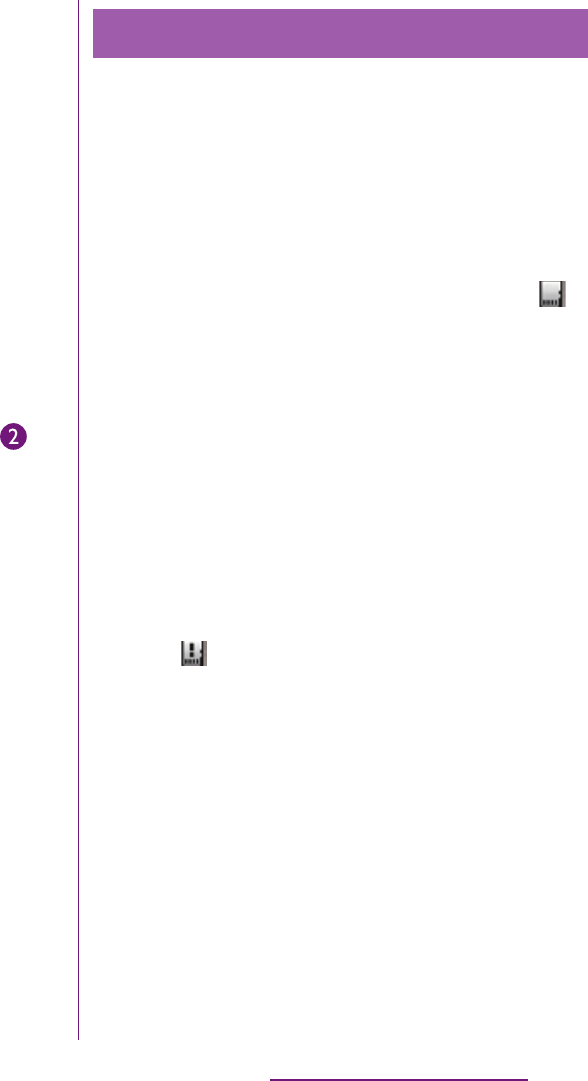
28
Before Using the Terminal
2
Close the microSD card slot cover
and confirm there is no gap
between the body and cover ( ).
Make sure to unmount (disable reading and
writing) microSD card before removing.
1
From the Home screen, tap
t
and tap
[Settings]
u
[Storage]
u
[Unmount
SD card].
・
When unmounting microSD card, "
SD card safe to remove" appears in the
status bar to notify that reading or
writing from/onto microSD card
becomes disabled.
2
Open the microSD card slot cover
and insert the microSD card
straight into the slot all the way
until it clicks.
3
Pull out microSD card slowly.
・
" Removed SD card" appears on the
status bar to notify that microSD card is
removed.
Removing microSD card
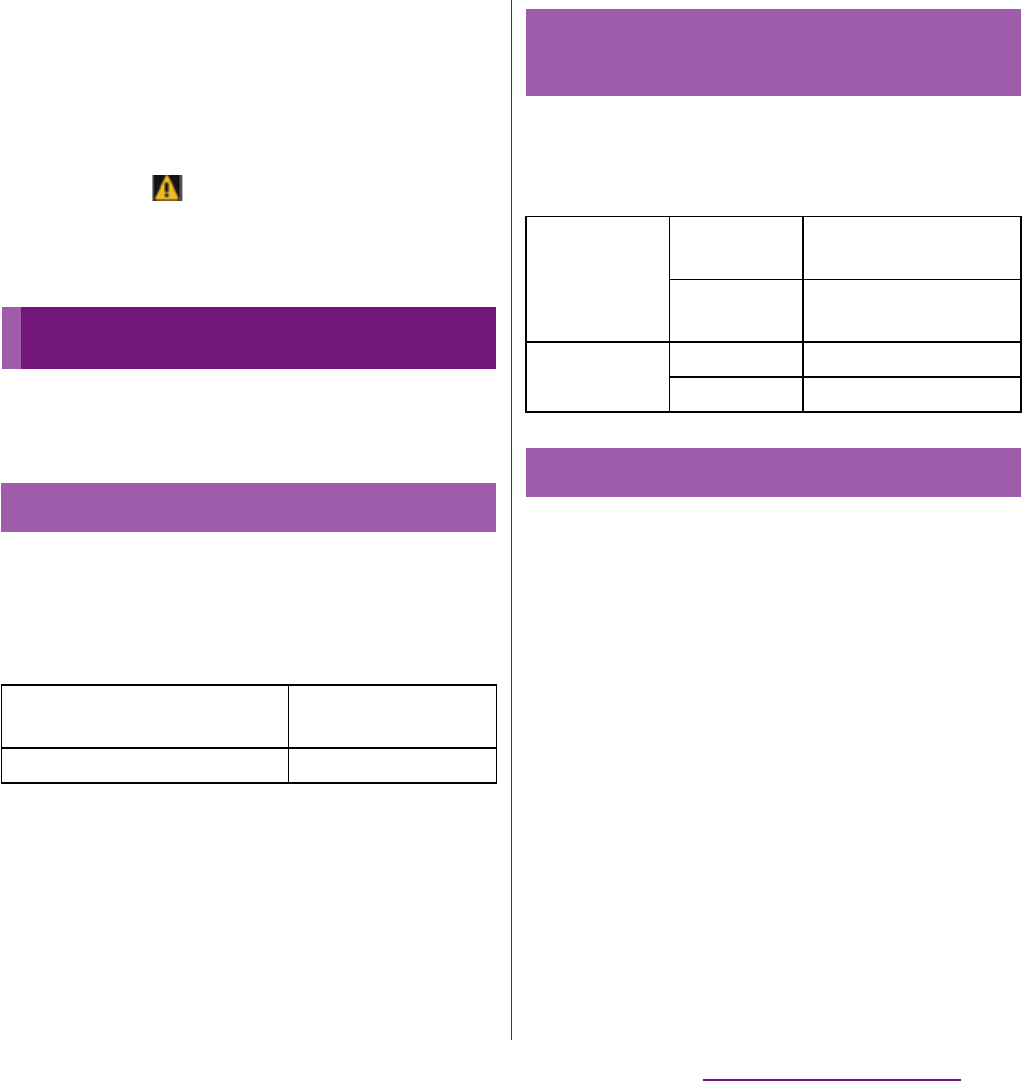
29
Before Using the Terminal
4
Close the microSD card slot cover
and confirm there is no gap
between the body and cover.
❖
Information
・
If you remove the microSD card without
unmounting, " SD card unexpectedly removed"
appears in the status bar and files may be damaged
or data may be lost.
The battery pack is not full charged when you
purchased the terminal.
Charging time is an estimate of the time
required to charge a completely empty
internal battery. Charging under low
temperature requires longer time.
The following time varies by the internal
battery condition or operating environment.
For details, see (P.256).
・
The internal battery is a consumable
accessory. The usage duration of the battery
per one charge decreases gradually each time
the battery is recharged.
・
When the usage duration per one charge
becomes about half of a new battery pack,
the life of the internal battery is assumed to be
almost over. It is recommended that you
replace the battery pack ahead of time.
Charging
Charging time
AC Adapter Cable SO03
(supplied accessory)
Approx. 190 min.
DC adapter 03 (Optional) Approx. 190 min.
Operation time on full charge
(estimate)
Continuous
stand-by time
FOMA/3G Approx. 410 hours
(stationary)
GSM Approx. 290 hours
(stationary)
Continuous
call time
FOMA/3G Approx. 430 min.
GSM Approx. 400 min.
Internal battery life

30
Before Using the Terminal
・
The supplied AC adapter's power plug is
compatible with AC 100 V to 240 V. For using
the terminal overseas, a plug adapter that fits
the electrical outlets in the country you stay is
needed. Do not use an electrical transformer
for overseas use to charge the terminal.
・
Use the supplied AC Adapter cable for
charging.
・
When charging starts, the notification LED
turns on in red/orange/green. Green means
the remaining battery level reaches 90% or
more. To check the battery level, tap
t
from the Home screen, then tap
[Settings]
u
[About phone]
u
[Status] and
check "Battery level". When charging is
completed, "100%" is displayed in the battery
level.
・
When you start charging the battery with the
terminal powered off, the power turns on.
However, you cannot operate the terminal.
Do not charge the battery in a place where
the use is prohibited such as in airplane or
hospital.
Do not charge the battery pack for a
long time (several days)
・
If you remain charging the terminal for a long
time, the power supply starts from the
internal battery after completion of charging.
The usage time duration may be short. In that
case, please charge it again correctly. For
recharging, remove the terminal from the AC
Adapter cable and reconnect it again.
For charging, attach the backside cover to the
terminal. For the backside cover, see "Part
names and functions" (P.29).
1
Insert the supplied microUSB
cable with the microUSB plug
engraved side facing up into the
connecting jack of the supplied
desktop holder ( ).
2
Insert the microUSB cable
horizontally with the USB plug
engraved side facing up into the
USB connecting jack of the
supplied AC Adapter, and insert
the AC Adapter plug to the power
outlet.
Charging
Charging with the desktop
holder

31
Before Using the Terminal
3
Insert the terminal to the desktop
holder.
4
After charging is finished, remove
the terminal from the desktop
holder, and then remove the AC
adapter from the power outlet.
❖
Note
・
The battery cannot be charged by connecting the
desktop holder and a PC.
・
If the microUSB cable is connected into the
connecting jack of the desktop holder for charging
using the desktop holder, the terminal is
automatically powered on although the operations
are not available. Be careful not to connect the
microUSB cable in a place where the use is
prohibited such as in airplane or hospital.
・
Check the connecting direction to connect correctly.
Wrong connection may cause damage.

32
Before Using the Terminal
1
Open the microUSB connecting
jack cover, and insert the
microUSB cable horizontally with
the microUSB plug engraved
side facing down into the
microUSB connecting jack of the
terminal.
2
Insert the microUSB cable
horizontally with the USB plug
engraved side facing up into the
USB connecting jack of the
supplied AC Adapter, and insert
the AC Adapter plug to the power
outlet.
3
When the charging is completed,
remove the microUSB plug of the
microUSB cable from the terminal.
4
Remove the AC Adapter from the
power outlet.
❖
Note
・
If the microUSB cable is connected into the USB
connecting jack for charging etc., the terminal is
automatically powered on although the operations
are not available. Be careful not to connect the
microUSB cable in a place where the use is
prohibited such as in airplane or hospital.
1
Open the microUSB connecting
jack cover, and insert the
microUSB cable horizontally with
the microUSB plug engraved
side facing down into the
microUSB connecting jack of the
terminal.
2
Insert the USB plug of the
microUSB cable horizontally into
the USB port of a PC.
・
When "PC Companion software" screen
appears on the terminal, tap [Skip].
・
When a screen for new hardware
detection etc. appears on the PC, select
[Cancel].
3
When the charging is completed,
remove the microUSB plug of the
microUSB cable from the terminal.
4
Remove the USB plug of the
microUSB cable from the USB port
of the PC.
❖
Note
・
If the microUSB cable is connected into the USB
connecting jack for charging etc., the terminal is
automatically powered on although the operations
are not available. Be careful not to connect the
microUSB cable in a place where the use is
prohibited such as in airplane or hospital.
Charging with AC adapter Charging with a PC

33
Before Using the Terminal
・
Check the connecting direction to connect correctly.
Wrong connection may cause damage.
1
Press and hold
p
for over a
second.
・
The key unlock screen appears.
2
Deactivate the key lock.
・
For deactivating the key lock, see
"Unlocking the keys" (P.39).
❖
Information
・
The first time you turn on, "Setup guide" (P.39)
appears.
・
If you activate the screen lock (P.127) or SIM card lock
(P.126), a canceling the screen lock/PIN code entry
screen appears when turning power on and
canceling the key lock. For canceling the screen lock,
see "Unlocking the screen" (P.128), and for canceling
SIM card lock, see "Entering the PIN code when
powered on" (P.126).
Turning power on/off
Turning power on

34
Before Using the Terminal
1
Press and hold
p
for over a
second.
・
Phone options menu appears.
2
Tap [Power off].
3
Tap [OK].
You can force the terminal quit if the screen
does not respond or the power cannot be
turned off.
1
Press and hold
p
and upper of
m
at the same time for
approximately 10 seconds.
2
Lift up your finger after the
terminal vibrates 3 times.
・
The terminal is forced quit and the
power turns off.
❖
Information
・
To restart the terminal, press
p
and upper of
m
at the same time for approximately 5
seconds, and release your fingers after the terminal
vibrates once.
When the key lock is set, the screen light
turns off. You can avoid the touch screen or
button from false operations.
・
The terminal keys are locked with turning the
screen light off after the specified time
duration.
1
Press
p
.
❖
Information
・
For details on settings for turning the backlight off
and the duration of time before the key lock
activation, see "Adjusting the idle time before the
screen turns off" (P.123).
・
There is no function to deactivate the key lock.
・
You can check the notifications or activate
application even if you do not unlock the keys. For
details, refer to "Setting information displayed on the
key unlock screen" (P.123).
・
If you set the screen lock, entering the pattern, PIN or
password is needed when the key lock is canceled.
For setting the screen lock, see "Screen lock" (P.127).
Turning power off
Performing force-quit Setting key lock
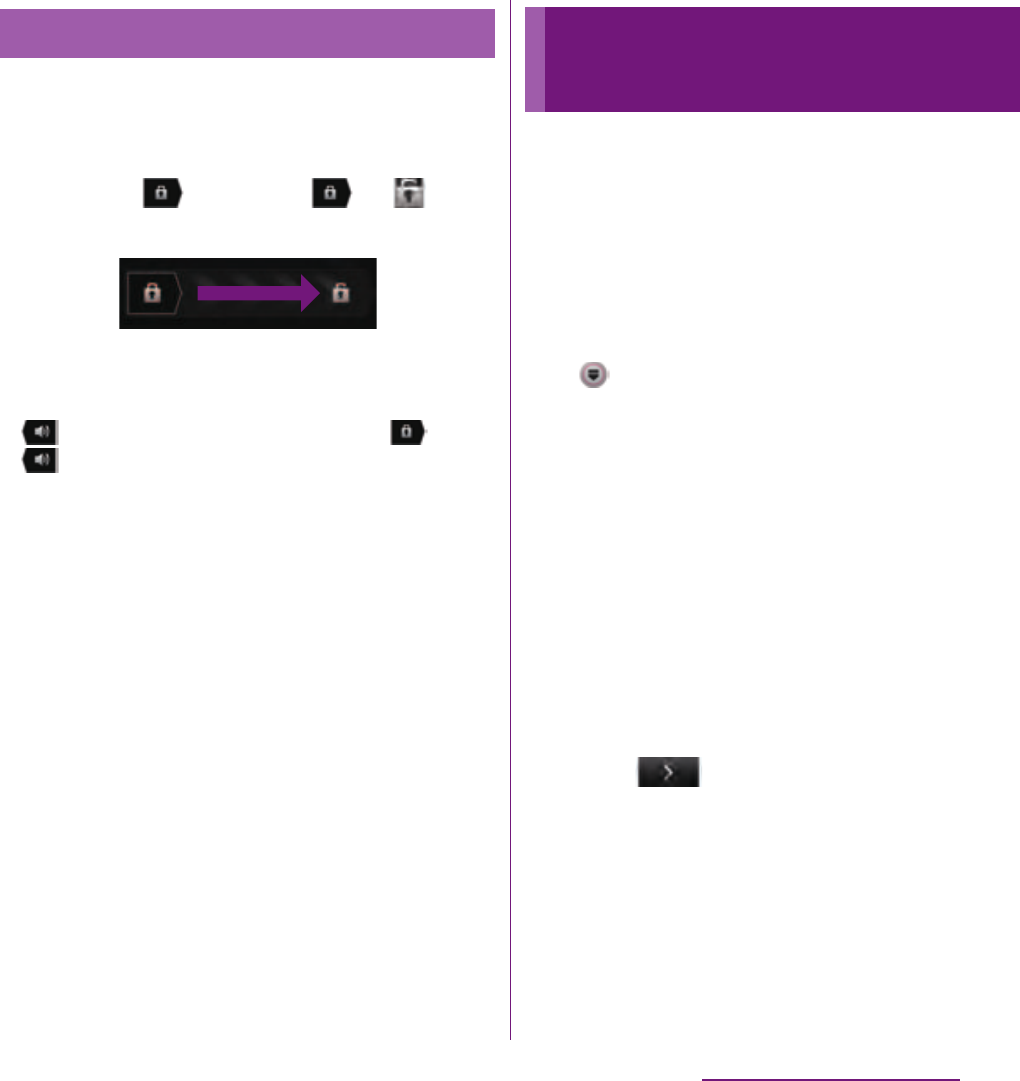
35
Before Using the Terminal
A key unlocking screen appears when
turning the power on or the backlight on by
pressing
p
.
1
Touch and drag to until
it laps over.
❖
Information
・
appears on the right until you touch . Touch
and drag left to switch the manner mode on
and off without unlocking the keys or screen lock.
When you turn on the terminal for the first
time, Setup guide appears to set up the
display language, wireless network, online
services, etc. and to import contacts.
❖
Information
・
You can set or change the items later as required.
To change the settings later, from the Home screen,
tap , then tap [Settings] or [Setup guide] to set up
from the menu.
1
Press and hold
p
for over a
second.
・
A screen for selecting language
appears.
2
Tap [English (United
States)]
u
[Done].
・
"Welcome!" screen appears and you
can learn how to use the function and
make initial settings.
3
Tap .
・
The Internet connection screen
appears. Tap [Mobile network and Wi-
Fi] or [Wi-Fi only] to select.
Unlocking the keys
Key lock
Initial settings (Setup
guide)

36
Before Using the Terminal
4
Tap .
・
The wireless network screen appears.
Tap [Search for networks] to add Wi-Fi
network.
5
Tap .
・
A service screen appears. Make settings
of "Google (P.132)", "Facebook (P.133)",
"Exchange ActiveSync (P.144)".
6
Tap .
・
Automatic renewal screen appears. Tap
[Synchronize automatically] or [No
thank you] to select.
7
Tap .
・
The import contacts screen appears.
For information on import contacts, see
"Using PhoneBookCopy" (P.94).
8
Tap .
・
Preferred applications screen appears.
Tap either [doocmo applications] or
[Xperia
™
applications] to select.
9
Tap
u
[Finish].
・
Initial settings (Setup guide) end and an
initial setting screen for docomo service
appears.
10
Tap .
・
Application batch installation screen
appears. Tap [Install] or [Not install] to
select.
11
Tap .
・
Osaifu-Keitai screen appears. Tap [Set]
or [Not set] to select. If you select [Set],
the initial setting screen for Osaifu-
Keitai appears. Follow the onscreen
instructions.
12
Tap .
・
A setting screen for docomo
application password appears. Tap [Set]
and enter a password.
13
Tap .
・
A setting screen for location provision
appears. Tap any of [Location providing
ON]/[Location providing OFF]/
[Unknown blocking] to select.
14
Tap
u
[OK].
・
A home screen appears.
❖
Information
・
Make sure to check if the data connection is available
(3G/GPRS) before setup online services. For checking
the data connection status, see "Status icon" (P.41).
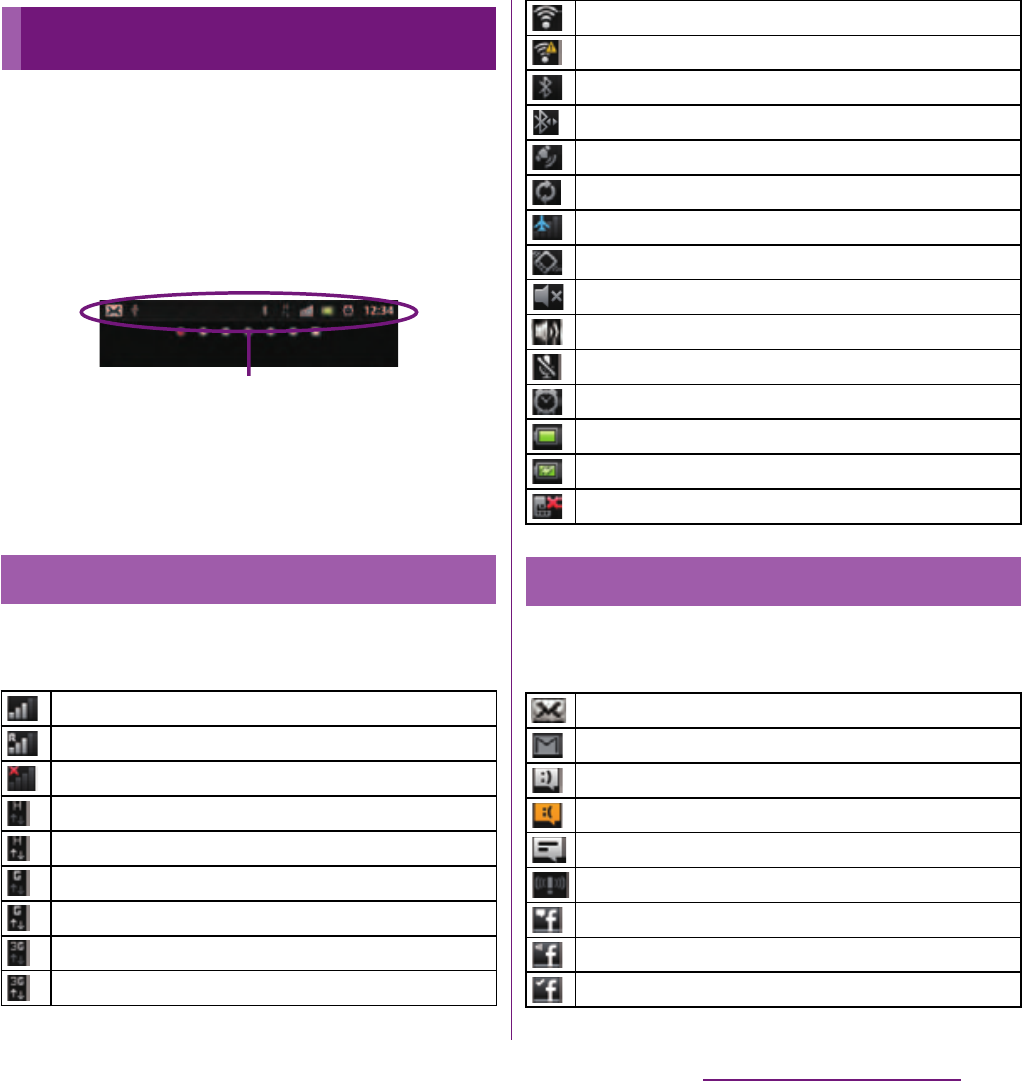
37
Before Using the Terminal
A status bar appears at the top of the screen.
In the status bar, the terminal status and
notification are displayed. Notification icons
appear on the left side, and the terminal
status icons appear on the right side of the
status bar.
❖
Note
・
If you cancel the "status bar" of applications forcibly
(P.130), operations may not be performed correctly.
The main status icons displayed on the
screen are as follows.
The main notification icons displayed on the
screen are as follows.
Status bar
Status icon
Signal strength
During International roaming
No signal
HSDPA available
Communicating in HSDPA
GPRS available
Communicating in GPRS
3G (packet) available
Communication in 3G (packet)
Status bar
Connecting to Wi-Fi
Connecting to Wi-Fi using AutoIP function
Bluetooth function is ON
Connecting to Bluetooth device
Positioning with GPS
During Data synchronization
Airplane mode activated
Silent mode (vibration) ON
Sound OFF (Ringtone volume 0)
Speakerphone ON
Microphone set to mute
Alarm is set
Battery status
The battery is charging
UIM is locked or not inserted
Notification icon
New email message
New Gmail message
New message (SMS)
Problem with message (SMS) delivery
New instant message
New Area Mail
New Facebook message
Uploading data to Facebook
Uploading data to Facebook completed

38
Before Using the Terminal
Notification icons are displayed in the
Notification panel. You can open
notifications, such as messages, remainders,
or event notifications directly from the
Notification panel.
Facebook setting request notification
Receiving/Downloading data
Sending/Uploading data
Bluetooth connection request notification
Unmount microSD card to remove (reading/
writing unavailable)
microSD card is removed
Preparing microSD card/internal storage
Installation is completed (when installing
applications from Android Market, etc.)
Update notification (when update of the
installed market application is notified)
Software update notification or updating
software
Osaifu-Keitai lock is activated
Making or receiving a call, during a call
Calling with Bluetooth device
Call on hold
Missed call
New voice mail
Upcoming calendar event
Stopwatch is running
Timer is set
Playing a track
Activating 1Seg
FM radio in use
USB connected
HDMI connected
Available to activate TV launcher
Accessory connected
Communicating via Infrared
Data communication invalid
Wi-Fi open network available
Connecting to a VPN
Not connected to a VPN
Media server executed in Connected Device
Media server connection request notification by
Connected devices
Red: Error messages
Yellow: Warning messages
Problem with sync
Setup guide unchecked
Personal area notification
More (undisplayed) notifications
Setting Wi-Fi tethering
Setting USB tethering
Setting Wi-Fi tethering and USB tethering
Backing up/restoring
AUTO-GPS is set
Green Heart energy saving icon (remove the AC
adapter from the power outlet)
Notification panel

39
Before Using the Terminal
1
Drag the status bar downwards.
・
Tap
x
to close the notification
panel.
1
On the Notification panel, tap
[Clear].
❖
Information
・
Some notifications cannot be cleared.
Notification LED provides information on the
terminal status, incoming/receiving, etc.
Opening/Closing the
Notification panel
Clearing contents on the
Notification panel
Notication panel
Notification LED
LED status
Status Indication
Red
The battery is charging when the
remaining battery level is 10% or
less.
Flashing red
The remaining battery level is
10% or less.
Green
The battery is charging when the
remaining battery level is 90% or
more.
Flashing green
Received Gmail mails while
backlight is off exist.
Flashing blue
While backlight is off, missed
calls/incoming messages (SMS)/
new email messages are notified.
Orange
The battery is charging when the
remaining battery level is 11% -
89%.
Flashing white
microSD card is mounted/
unmounted.

40
Before Using the Terminal
* In this manual, each key operation is described with
x
,
y
,
t
.
Precautions on using touch screen
・
Touch screen is designed for being touched
lightly with fingers. Do not push it forcibly
with a finger or press it with sharp objects
(nail, ballpoint pen, pin, etc.).
・
Touching the touch screen may not work in
the following cases. Note that it may cause
malfunction.
- Operation with gloved hands
- Operation with tip of fingernail
- Operation with foreign object on the screen
- Operation with protective sheet or seal on
the screen
Operations on the touch screen
■
Tap
Touch an item such as icon or menu with
your finger lightly and release it.
・
Double-tap means tapping twice quickly.
■
Touch
Touch and hold an icon or menu item long.
■
Drag
Touch the screen, drag to the desired
position and release the finger.
Basic operations
Basic key operation
x
Back
・
Go back to the previous screen. Or
close a dialog box, Option menu,
or the Notifications panel.
・
Close the software keyboard.
y
Home
・
Go to the Home screen.
・
Touch and hold down to open a list
of recently used applications.
t
Menu
・
Open a list of options available in
the Home screen or application.
・
Touching and holding down when
entering characters switches
display/not display the software
keyboard.
Using the touch screen
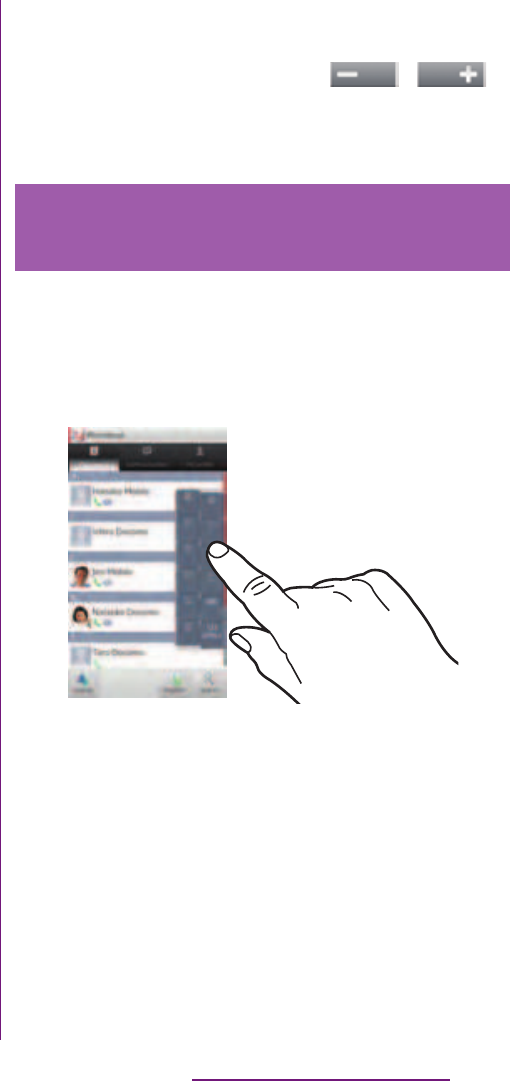
41
Before Using the Terminal
■
Flick
Stroke the screen with your finger lightly
and flick up/down/left/right. Flick operation
is used to switch or scroll the screen.
■
Pinch
Touch the screen with two fingers and
widen (pinch-out) or narrow (pinch-in) the
fingers' distance. On some screens, pinch-
out to zoom in and pinch-in to zoom out.
❖
Information
・
You can zoom in or out also by double-tapping or by
tapping the zoom control icons ( / ).
The zoom control icons may appear when you drag
in any direction on the screen.
Tap the right end of the screen to display
index characters with which you can search
by Japanese syllabary and alphabetic order.
・
Tap the index character to move on the list.
Selecting items quickly from a
list
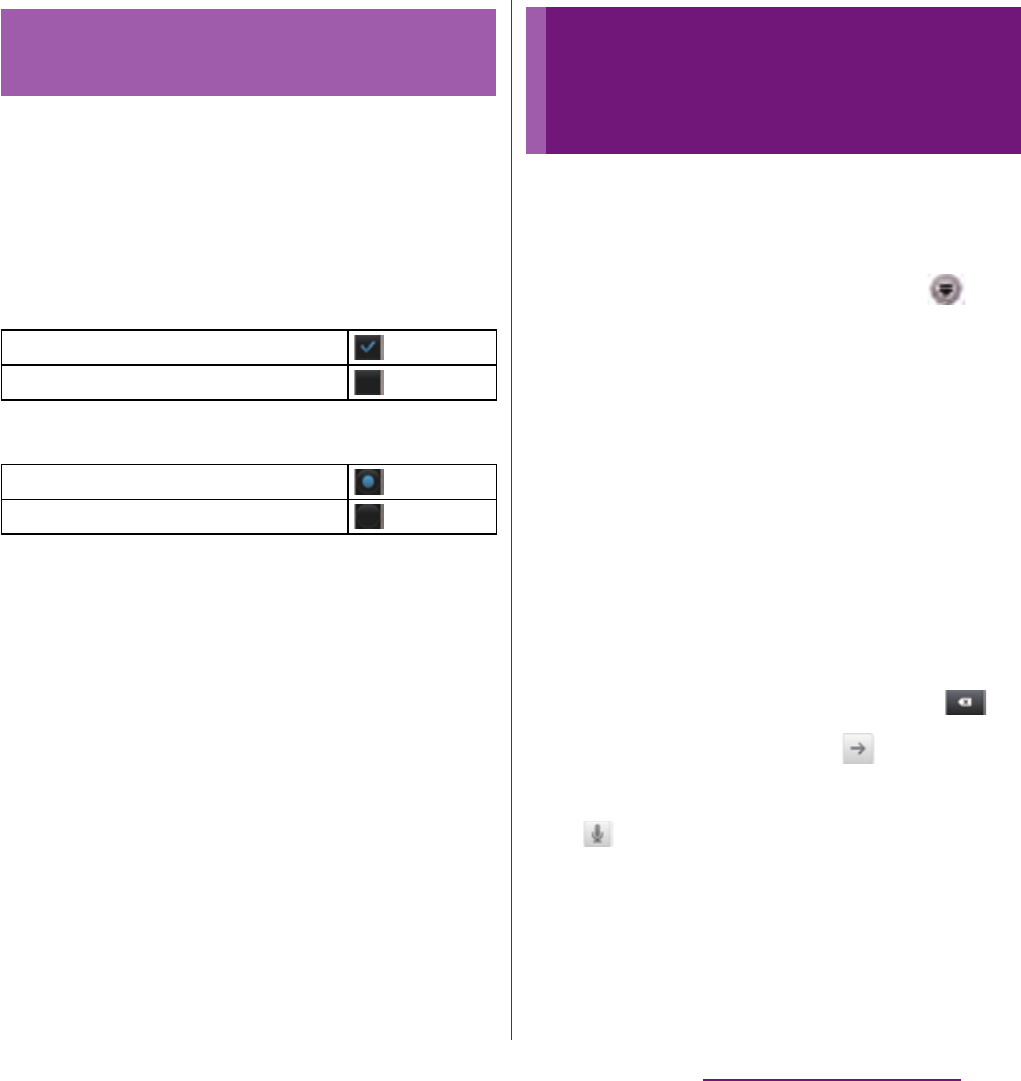
42
Before Using the Terminal
You can switch on/off of the option settings
by marking or unmarking the checkboxes or
radio buttons.
・
To switch on/off of the option setting, tap the
checkbox or radio button.
■
Checkboxes
■
Radio button
Enter a word in the search box to browse the
information in the terminal or on the
Internet.
1
From the Home screen, tap ,
then tap [Google Search].
・
For the first time to join Latitude, a
message confirming whether to agree
to Google's privacy policy appears.
Select [Agree] or [Disagree].
・
The software keyboard appears.
2
Enter a search word.
・
Search suggestions appear as you enter
a character.
・
For character entry, see "Character
entry" (P.47).
・
To enter a new search word, tap .
3
Tap a search item or .
❖
Information
・
Tap on the right of the search box to input a
search word by voice to browse the Internet.
Marking or unmarking option
checkbox
Mark
Unmark
Mark
Unmark
Searching information in
the terminal and web
pages
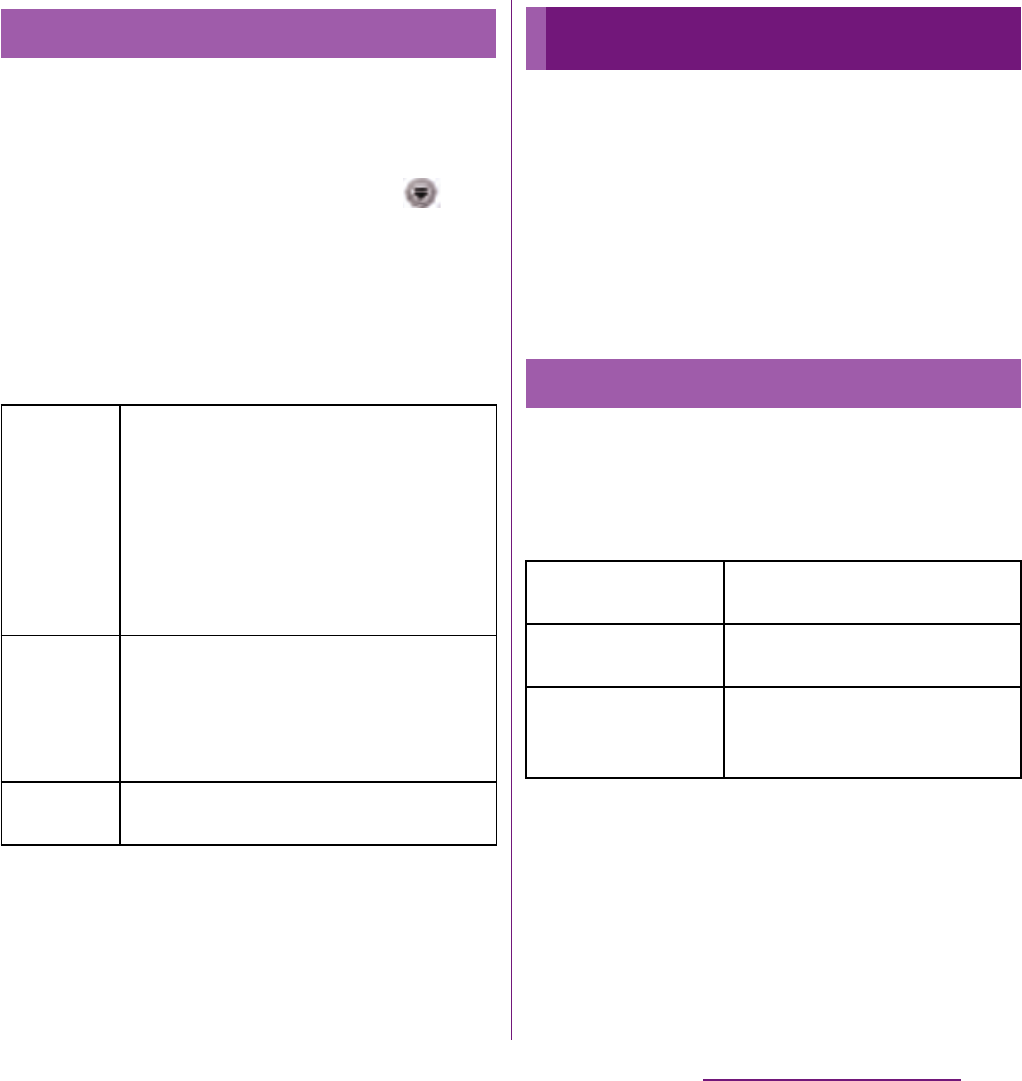
43
Before Using the Terminal
You can set search engines to use for Quick
search box or set search objectives in the
terminal.
1
From the Home screen, tap ,
then tap [Google Search].
2
Tap
t
and then [Search
settings].
・
A search settings screen appears. You
can set the following items.
To enter characters, use the software
keyboard which appears when you tap the
character input box in a message,
phonebook, etc.
❖
Information
・
To return to the previous screen from the character
entry screen, tap
x
.
In this terminal, you can select Input method
(keyboard type) from "Xperia
™
Chinese
keyboard", "Xperia
™
Japanese keyboard" or
"Xperia
™
keyboard".
1
On a character entry screen, touch
and hold the text box.
2
Tap [Input method]
u
[Xperia
™
Chinese keyboard]/[Xperia
™
Japanese keyboard]/[Xperia
™
keyboard].
Search settings
Google
search
Set whether to display search options
when a search word is entered, or
whether to reflect the previous search
result in the search options. You can also
open the web search log settings page
by Browser.
・
You need to create your Google
account.
Searchable
items
Change the search range by marking/
unmarking data categories (Web, Apps,
Contacts, Email, Messaging, Music player,
OfficeSuite, Phonebook, Voice Search) in
the terminal.
Clear
shortcuts
Set not to display recently selected
search results.
Character entry
Selecting input method
Xperia
™
Chinese
keyboard
Select to enter Chinese.
Xperia
™
Japanese
keyboard
Select to enter Japanese.
Xperia
™
keyboard
Select a language for text entry.
Select to enter language other
than Japanese.

44
Before Using the Terminal
❖
Information
・
You can change Input method (keyboard type)
during character entry.
For Japanese keyboard, there are 4 types of
software keyboards: phonepad, QWERTY,
Japanese syllabary and handwritten input.
❖
Information
・
The key display of software keyboard varies
depending on the entry screen, character mode or
settings.
■
Phonepad keyboard
Japanese characters can be entered in
"Kana input" mode.
■
QWERTY keyboard
Japanese characters can be entered in
"Romaji input" mode.
■
Japanese syllabary keyboard
You can use the software keys arranged
according to the Japanese syllabary to enter
Japanese characters in "Kana input" mode.
Software keyboard
Portrait
Landscape
Landscape
Portrait
Portrait
Landscape
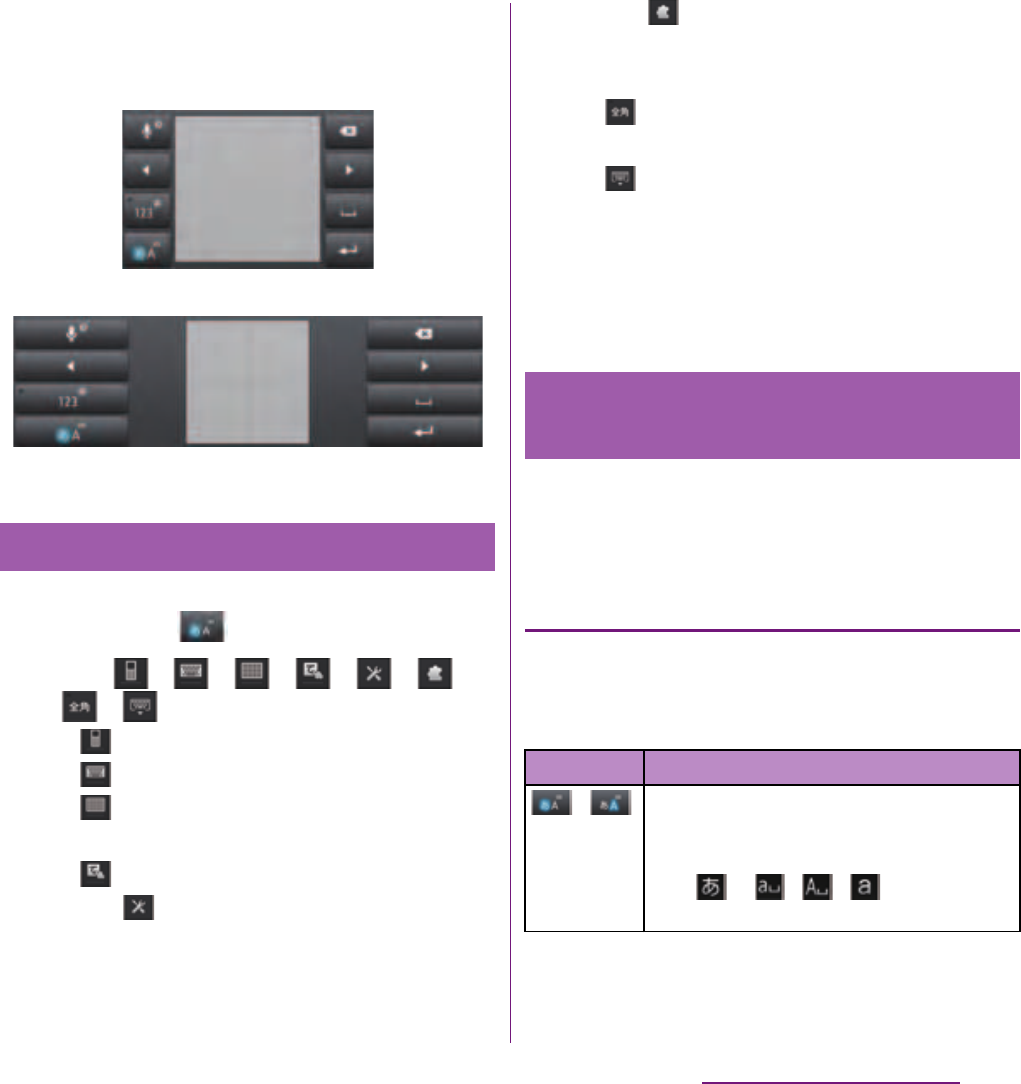
45
Before Using the Terminal
■
Handwritten input
Japanese characters can be entered in
"Handwritten input" mode.
1
On a character entry screen, touch
and hold .
2
Tap / / / / / /
/ .
・
: The phonepad keyboard appears.
・
: The QWERTY keyboard appears.
・
: The Japanese syllabary keyboard
appears.
・
: The handwritten input appears.
・
Tap to display Japanese keyboard
settings screen and you can check/
change the settings.
・
Tap to display plug-in applications
list. Tap [Contact Picker 2.3] to quote
contacts to enter.
・
: Switch one-byte/two-byte
character.
・
: Hide the software keyboard.
❖
Information
・
The phonepad keyboard is set by default. Also, "Auto
capitalization", "Word suggestions", "Error correction"
and "Pop-up on key press" are set to on.
You can use the software keys arranged
according to the Japanese syllabary to enter
Japanese characters in "Kana input" mode.
The main functions of the touch-keys
・
To change character modes and other
entering operations, tap the following icons
on the phonepad keyboard.
Switching the keyboard
Portrait
Landscape
Entering characters on the
phonepad keyboard
Icon Function
/
Each time you tap, the character mode
switches "Hiragana/Kanji"
→
"Alphanumeric" in order and a status
icon,
→
/ / appears in the
status bar.

46
Before Using the Terminal
*1 When any characters are entered, just tap the
desired position on the entered character string to
move the cursor.
/
Touch and
hold
Display a pop-up window.
/ / / : Keyboard switch
(two-byte)/ (one-byte) :
Character mode switch
: Display the setting screen for
Japanese keyboard
: Display plug-in applications list
: Hide the software keyboard
/
Each time you tap, the character mode
switches "Hiragana/Kanji/alphabets"
→
"Number" in order and a status icon,
/ , etc.
→
/ appears in the
status bar.
/
Touch and
hold
Display a one-byte/two-byte symbol list
to enter them. Switch tabs to display
smiley list to enter them. (a pictogram
tab and deco-mail tab are also displayed
when entering in sp-mode mail.)
Displayed before fixing character. Display
word predictions or alphanumeric
conversion candidates assigned to
tapped key.
Appears after conversion is fixed to
return to text before conversion.
Move the cursor
*1
: To the left.
Touch and hold to move continuously.
Or change the range for conversion.
Move the cursor
*1
: To the right.
Touch and hold to move continuously.
Or change the range for conversion.
When there is an unfixed character string
with the cursor at the right end, tap to
enter the same character as the one at
the end.
Icon Function
*2
Fix entered or converted characters.
When characters are already fixed, enter
a line feed at the cursor position.
Delete the character before the cursor.
Touch and hold to delete continuously.
When any character is entered or after
entered character is fixed, a space can be
entered. Touch and hold to input spaces
continuously.
Enter characters by voice. A candidate
list appears. Tap the character string you
want to enter.
Display the previous character (opposite
order).
In Hiragana/Kanji input mode,
conversion candidates can be displayed
to enter.
Touch and
hold
Activate online dictionary.
You need to mark "Online dictionary"
checkbox in the Japanese keyboard
setting screen.
Appears when entering number. One-
byte/two-byte symbol list can be
displayed to enter them. Switch tabs to
display smiley list to enter them. (a
pictogram tab and deco-mail tab are
also displayed when entering in sp-
mode mail.)
Icon Function
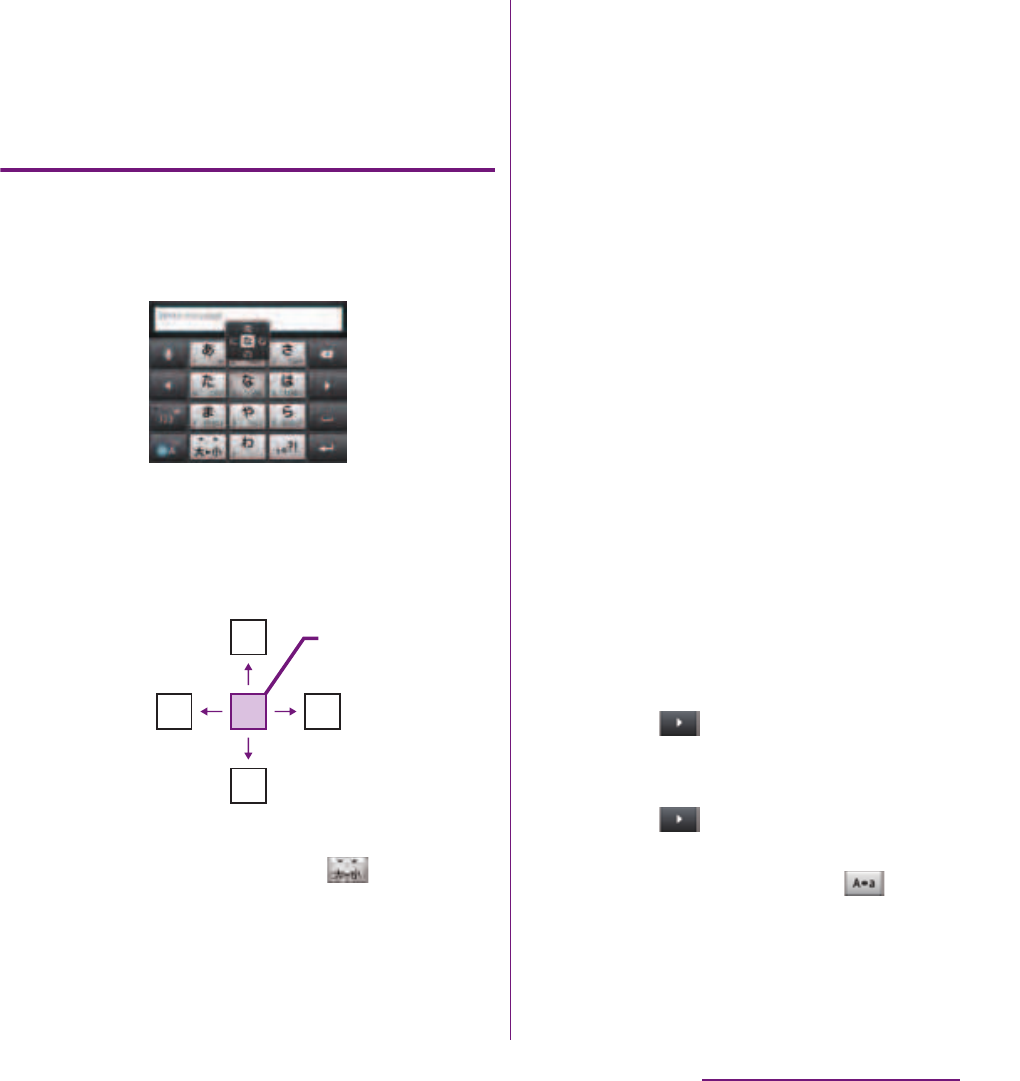
47
Before Using the Terminal
*2 Before the conversion is fixed, "
確定
(Fix)" is
displayed. In some screens such as the search box
or mail account registration screen, "
次へ
(Next)", "
完
了
(Done)", "
実行
(Go)", etc. appear.
Settings of key entry
■
Flick input
Flick up/down/left/right to enter characters
in each column of kana syllabary.
・
Ex: Entering characters in "
な
" column
You can enter "
な
" only by tapping. Flick
left for "
に
", up for "
ぬ
", right for "
ね
" and
down for "
の
".
・
To switch upper/lower case or change to
voiced sound, flick or tap .
・
Flick input is available by default. You can
cancel by the following operation
beforehand.
a
From the Home screen, tap
t
and
tap [Settings].
b
Tap [Language & keyboard]
→
[Xperia
™
Japanese keyboard]
→
[On-
screen keyboard settings].
c
Unmark [Flick input] checkbox.
・
To change sensitivity of the flick input, on
the Japanese keyboard setting screen, tap
[On-screen keyboard settings]
u
[Select
sensitivity], then select "High"/"Medium
(default)"/"Low".
■
Toggle entry
Tap the same key continuously to enter the
assigned character.
To enter characters assigned to the same
key continuously, operate the followings.
・
Ex: To enter "
あお
"
a
Tap "
あ
" once.
b
Tap , and tap "
あ
" 5 times.
・
Ex: To enter "ca"
a
Tap "abc" 3 times.
b
Tap
*
.
c
Tap "abc" once.
※
In some applications, tap in Step
b
.
ぬ
ねに
の
な
Flick left
Flick up Tap
Flick right
Flick down
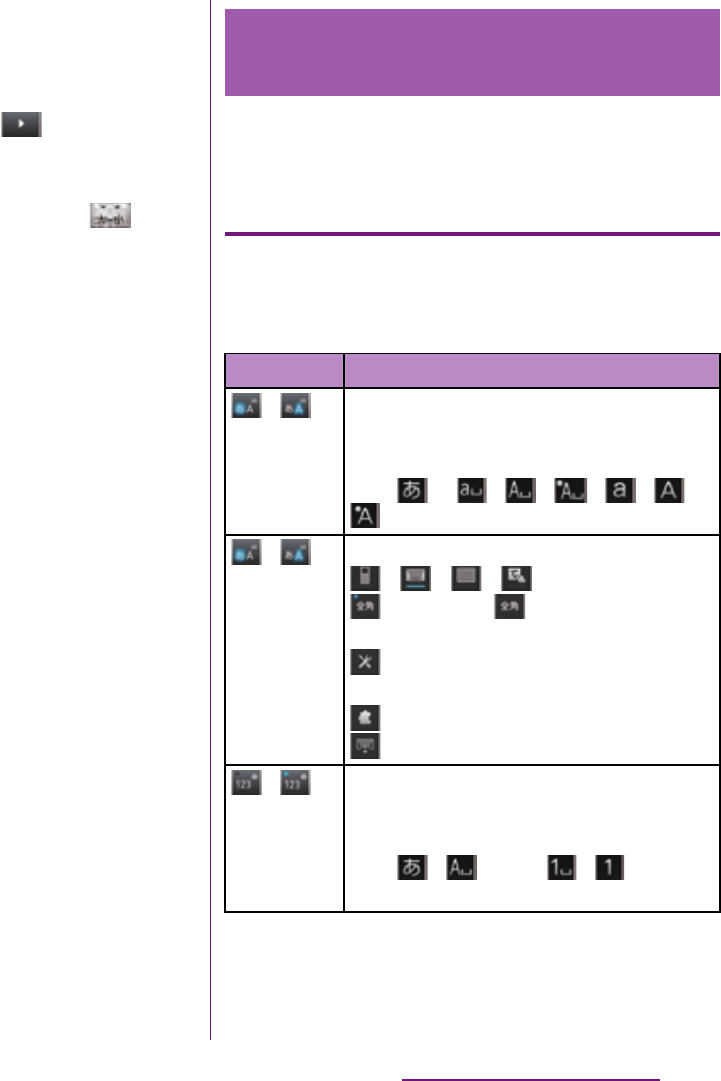
48
Before Using the Terminal
❖
Information
・
When a certain time is passed after the key tapped,
the tapped key's highlighter goes off and you can
enter a character assigned to the same key
consecutively without tapping .
・
To switch upper/lower case or change to
voiced/semi-voiced sound, tap .
・
Multitap text input is available by default.
You can cancel by the following
operation beforehand.
a
From the Home screen, tap
t
and
tap [Settings].
b
Tap [Language & keyboard]
→
[Xperia
™
Japanese keyboard]
→
[On-
screen keyboard settings].
c
Unmark [Multitap text input]
checkbox.
Use the QWERTY keyboard to enter Japanese
characters in "Romaji input" mode.
The main functions of the touch-keys
・
To change character modes and other input
operations, tap the following icons on the
QWERTY keyboard.
Entering characters on the
QWERTY keyboard
Icon Function
/
Each time you tap, the character mode
switches "Hiragana/Kanji"
→
"Alphanumeric" in order and a status
icon,
→
/ / / / /
appears in the status bar.
/
Touch and
hold
Display a pop-up window.
/ / / : Keyboard switch
(two-byte)/ (one-byte) :
Character mode switch
: Display the setting screen for
Japanese keyboard
: Display plug-in applications list
: Hide the software keyboard
/
Each time you tap, the character mode
switches "Hiragana/Kanji/alphabets"
→
"Number/symbol" in order and a status
icon, / , etc.
→
/ appears
in the status bar.
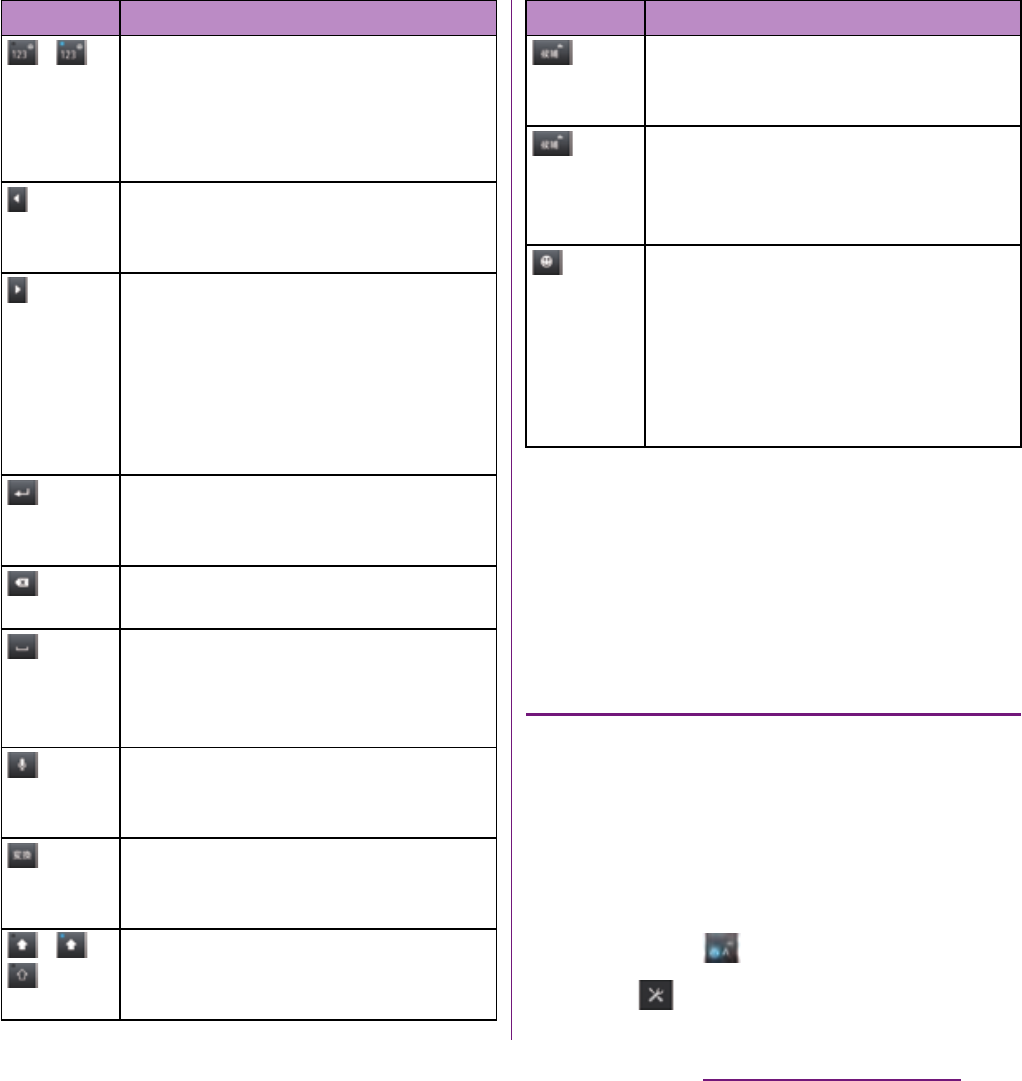
49
Before Using the Terminal
*1 When any characters are entered, just tap the
desired position on the entered character string to
move the cursor.
*2 Before the conversion is fixed, "
確定
(Fix)" is
displayed. In some screens such as the search box
or mail account registration screen, "
次へ
(Next)", "
完
了
(Done)", "
実行
(Go)", etc. appear.
Selecting an assistant keyboard
When you enter in Hiragana/Kanji input
mode using the QWERTY keyboard, you can
change the assistant keyboard to make the
frequent using keys to be displayed widely
for easy tapping.
1
On a character entry screen, touch
and hold .
2
Tap .
/
Touch and
hold
Display a one-byte/two-byte symbol list
to enter them. Switch tabs to display
smiley list to enter them. (a pictogram
tab and deco-mail tab are also displayed
when entering in sp-mode mail.)
Move the cursor
*1
: To the left. Touch and
hold to move continuously. Or change
the range for conversion.
Move the cursor
*1
: To the right. Touch
and hold to move continuously. Or
change the range for conversion.
When there is an unfixed character string
with the cursor at the right end, tap to
enter the same character as the one at
the end.
*2
Fix entered or converted characters.
When characters are already fixed, enter
a line feed at the cursor position.
Delete the character before the cursor.
Touch and hold to delete continuously.
When any character is entered or after
entered character is fixed, a space can be
entered. Touch and hold to input spaces
continuously.
Enter characters by voice. A candidate
list appears. Tap the character string you
want to enter.
Appears before conversion is fixed. Tap
to switch conversion methods to "Direct
conversion".
/ /
In alphanumerics input mode, tap to
switch capitalization/upper case/lower
case.
Icon Function
In Hiragana/Kanji input mode,
conversion candidates can be displayed
to enter.
Touch and
hold
Activate online dictionary.
You need to mark "Online dictionary"
checkbox in the Japanese keyboard
setting screen.
Appears when entering number. One-
byte/two-byte symbol list can be
displayed to enter them. Switch tabs to
display smiley list to enter them. (a
pictogram tab and deco-mail tab are
also displayed when entering in sp-
mode mail.)
Icon Function

50
Before Using the Terminal
3
Tap [On-screen keyboard
settings]
u
[Choose key type].
4
Tap any of [Static key resizing]/
[Key highlight while typing]/
[Dynamic key resizing with
highlight]/[Off].
■
Static key resizing
Widen frequent using key for easy tapping.
■
Key highlight while typing
Widen frequent using key and highlight the
key that is predicted for the next entry.
■
Dynamic key resizing with highlight
Widen the key that is predicted for the next
entry much further and highlight it.
■
Off
Display equally the width of each key.
Changing display keys
・
For Japanese input, you can set not to display
less-frequent-used keys (Q, X, C, etc.) on the
QWERTY keyboard.
1
On a character entry screen, touch
and hold .
2
Tap .
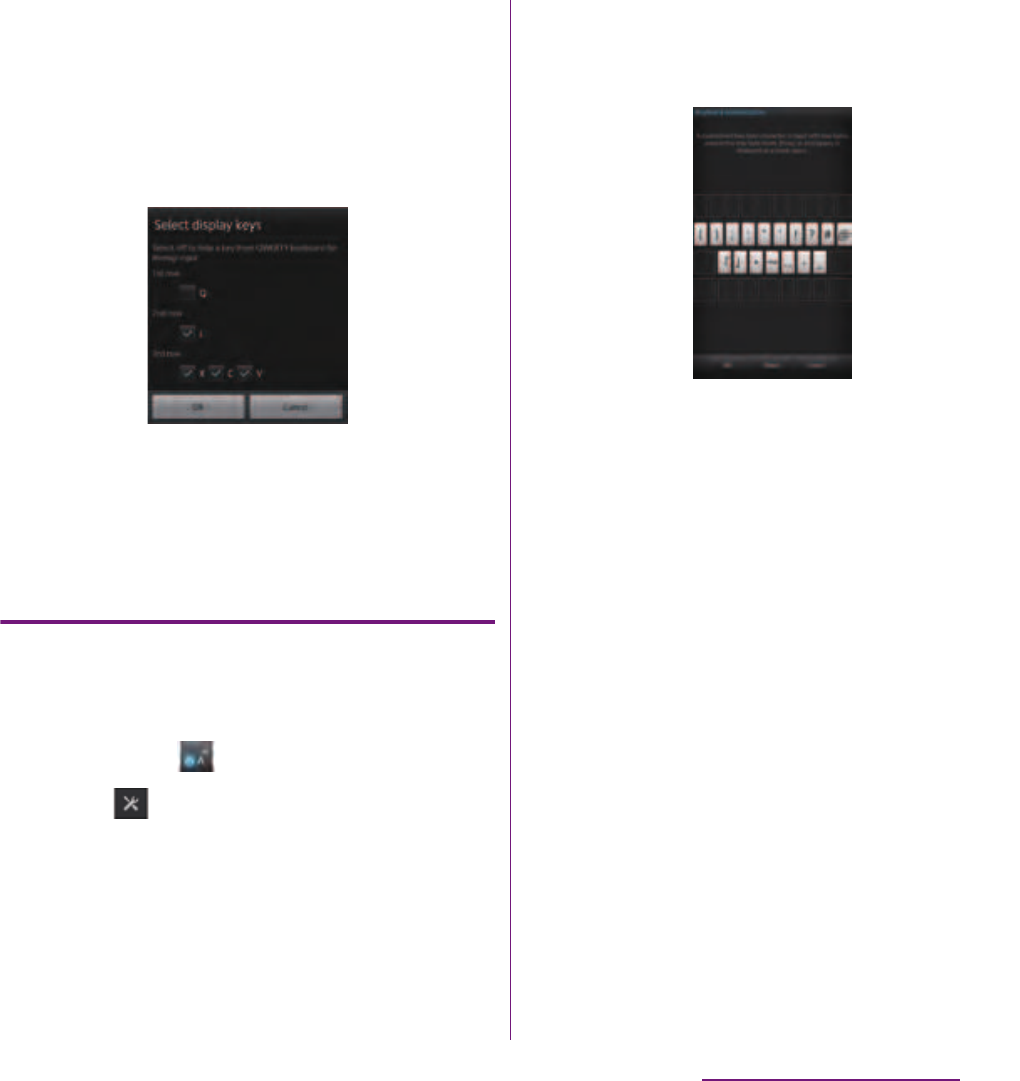
51
Before Using the Terminal
3
Tap [On-screen keyboard
settings]
u
[Select display keys].
・
When the assist keyboard (P.53) is set to
"Off", [Select display keys] cannot be
selected and you cannot change a
displaying key.
4
Unmark the checkbox of the key
you want to hide.
5
Tap [OK].
Customizing keyboard
・
You can switch the position for symbols of the
keyboard displayed when entering numbers.
1
On a character entry screen, touch
and hold .
2
Tap .
3
Tap [On-screen keyboard
settings]
u
[Keyboard
customization].
4
Tap a symbol you want to change
and delete character previously
set, then enter a character to
display.
・
Only one character (two-byte or one-
byte character) can be entered.
5
Tap [OK]
u
[OK].
❖
Information
・
To return to the default status, in Step 3, tap
[Reset]
u
[OK].
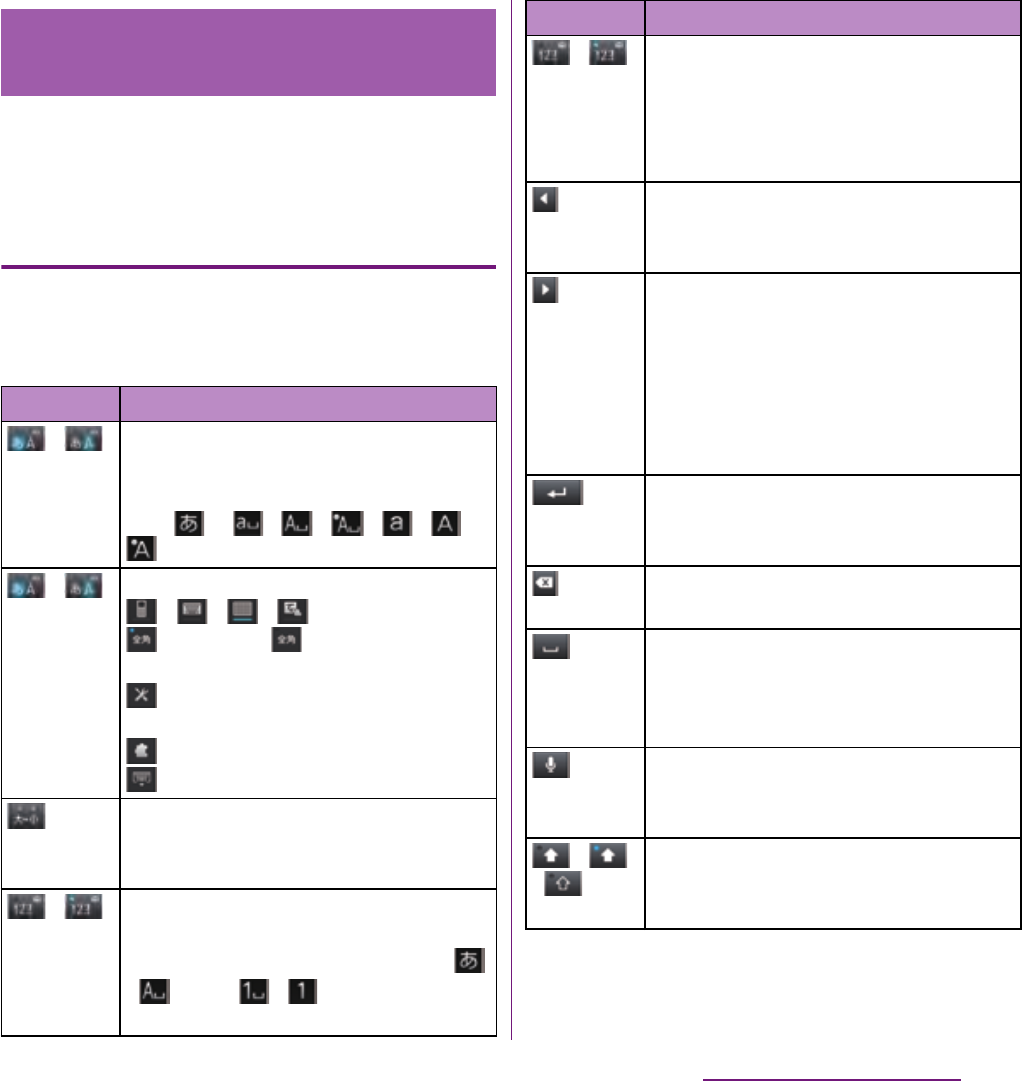
52
Before Using the Terminal
You can use the software keys arranged
according to the Japanese syllabary to enter
Japanese characters in "Kana input" mode.
The main functions of the touch-keys
・
To change character modes and other input
operations, tap the following icons on the
Japanese syllabary keyboard.
Entering characters on the
Japanese syllabary keyboard
Icon Function
/
Each time you tap, the character mode
switches "Hiragana/Kanji"
→
"Alphanumeric" in order and a status
icon,
→
/ / / / /
appears in the status bar.
/
Touch and
hold
Display a pop-up window.
/ / / : Keyboard switch
(two-byte)/ (one-byte) :
Character mode switch
: Display the setting screen for
Japanese keyboard
: Display plug-in applications list
: Hide the software keyboard
Appears in Hiragana/Kanji input mode.
Switch upper/lower case or add voiced
sound/semi-voiced sound.
/
Each time you tap, the character mode
switches "Hiragana/Kanji/alphabets"
→
"Number" in order and a status icon,
/ , etc.
→
/ appears in the
status bar.
/
Touch and
hold
Display a one-byte/two-byte symbol list
to enter them. Switch tabs to display
smiley list to enter them. (a pictogram
tab and deco-mail tab are also displayed
when entering in sp-mode mail.)
Move the cursor
*1
: To the left.
Touch and hold to move continuously.
Or change the range for conversion.
Move the cursor
*1
: To the right.
Touch and hold to move continuously.
Or change the range for conversion.
When there is an unfixed character string
with the cursor at the right end, tap to
enter the same character as the one at
the end.
*2
Fix entered or converted characters.
When characters are already fixed, enter
a line feed at the cursor position.
Delete the character before the cursor.
Touch and hold to delete continuously.
When any character is entered or after
entered character is fixed, a space can be
entered. Touch and hold to input spaces
continuously.
Enter characters by voice. A candidate
list appears. Tap the character string you
want to enter.
/
/
In alphanumerics input mode, tap to
switch capitalization/upper case/lower
case or switch allocated symbols.
Icon Function
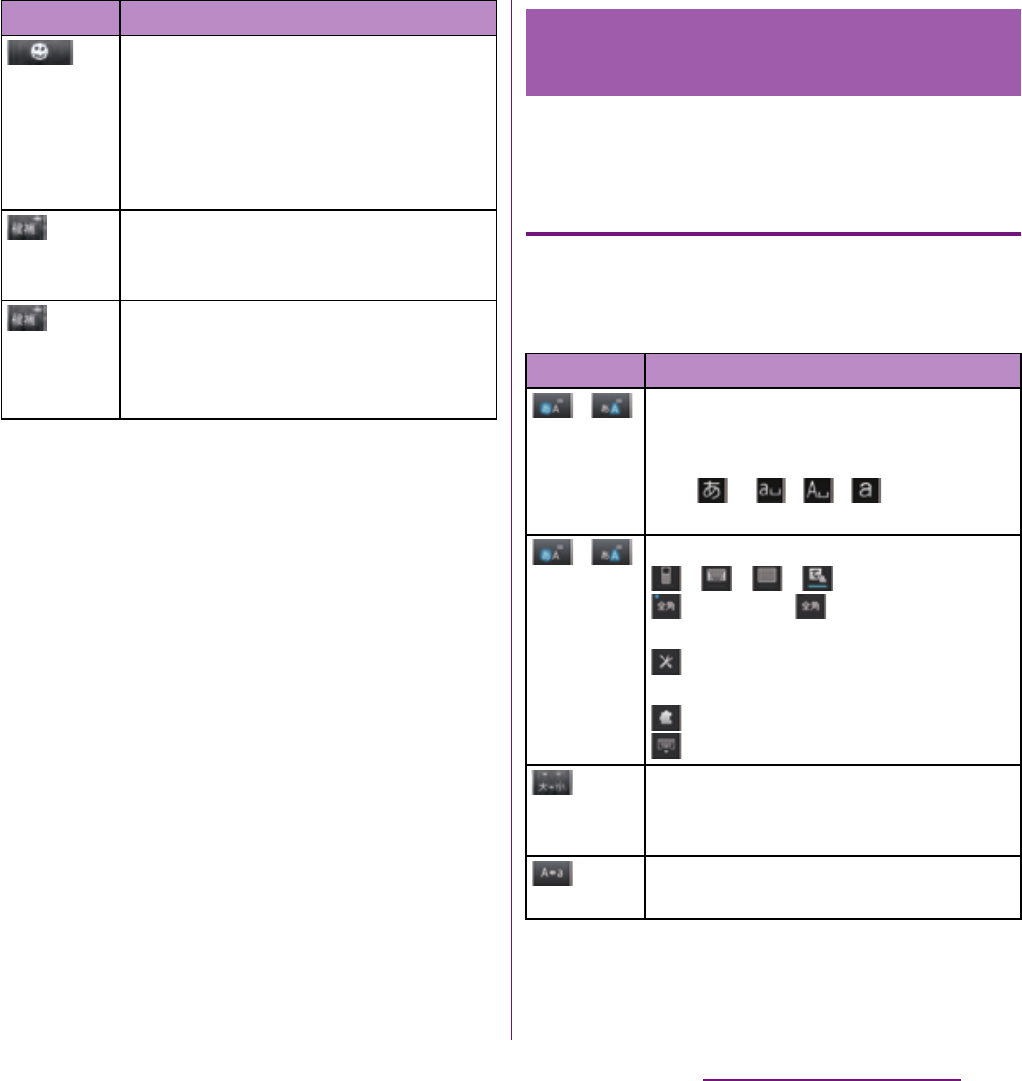
53
Before Using the Terminal
*1 When any characters are entered, just tap the
desired position on the entered character string to
move the cursor.
*2 Before the conversion is fixed, "
確定
(Fix)" is
displayed. In some screens such as the search box
or mail account registration screen, "
次へ
(Next)", "
完
了
(Done)", "
実行
(Go)", etc. appear.
You can use the handwritten input screen to
enter Japanese by "handwriting input".
The main functions of the touch-keys
・
To change character modes and other input
operations, tap the following icons on the
handwritten input.
Appears in landscape view. One-byte/
two-byte symbol list can be displayed to
enter them. Switch tabs to display smiley
list to enter them. (a pictogram tab and
deco-mail tab are also displayed when
entering in sp-mode mail.)
In Hiragana/Kanji input mode,
conversion candidates can be displayed
to enter.
Touch and
hold
Activate online dictionary.
You need to mark "Online dictionary"
checkbox in the Japanese keyboard
setting screen.
Icon Function
Entering characters on the
handwritten input
Icon Function
/
Each time you tap, the character mode
switches "Hiragana/Kanji"
→
"Alphanumeric" in order and a status
icon,
→
/ / appears in the
status bar.
/
Touch and
hold
Display a pop-up window.
/ / / : Keyboard switch
(two-byte)/ (one-byte) :
Character mode switch
: Display the setting screen for
Japanese keyboard
: Display plug-in applications list
: Hide the software keyboard
Appears in Hiragana/Kanji input mode.
Switch upper/lower case or add voiced
sound/semi-voiced sound.
Appears in alphanumerics input mode,
tap to switch upper case and lower case.

54
Before Using the Terminal
*1 When any characters are entered, just tap the
desired position on the entered character string to
move the cursor.
*2 Before the conversion is fixed, "
確定
(Fix)" is
displayed. In some screens such as the search box
or mail account registration screen, "
次へ
(Next)", "
完
了
(Done)", "
実行
(Go)", etc. appear.
/
Each time you tap, the character mode
switches "Hiragana/Kanji/alphabets"
→
"Number" in order and a status icon,
/ , etc.
→
/ appears in the
status bar.
/
Touch and
hold
Display a one-byte/two-byte symbol list
to enter them. Switch tabs to display
smiley list to enter them. (a pictogram
tab and deco-mail tab are also displayed
when entering in sp-mode mail.)
Displayed before fixing character. Display
word predictions or alphanumeric
conversion candidates assigned to
entered letter.
Appears after conversion is fixed to
return to text before conversion.
Move the cursor
*1
: To the left.
Touch and hold to move continuously.
Or change the range for conversion.
Move the cursor
*1
: To the right.
Touch and hold to move continuously.
Or change the range for conversion.
When there is an unfixed character string
with the cursor at the right end, tap to
enter the same character as the one at
the end.
*2
Fix entered or converted characters.
When characters are already fixed, enter
a line feed at the cursor position.
Delete the character before the cursor.
Touch and hold to delete continuously.
Icon Function
When any character is entered or after
entered character is fixed, a space can be
entered. Touch and hold to input spaces
continuously.
Enter characters by voice. A candidate
list appears. Tap the character string you
want to enter.
Touch and
hold
Handwritten input guide in the POBox
Touch User Guide (Japanese) activates
and you can view the detailed
explanations on the handwritten input.
In Hiragana/Kanji input mode,
conversion candidates can be displayed
to enter.
Touch and
hold
Activate online dictionary.
You need to mark "Online dictionary"
checkbox in the Japanese keyboard
setting screen.
Appears when entering number. One-
byte/two-byte symbol list can be
displayed to enter them. Switch tabs to
display smiley list to enter them. (a
pictogram tab and deco-mail tab are
also displayed when entering in sp-
mode mail.)
Icon Function
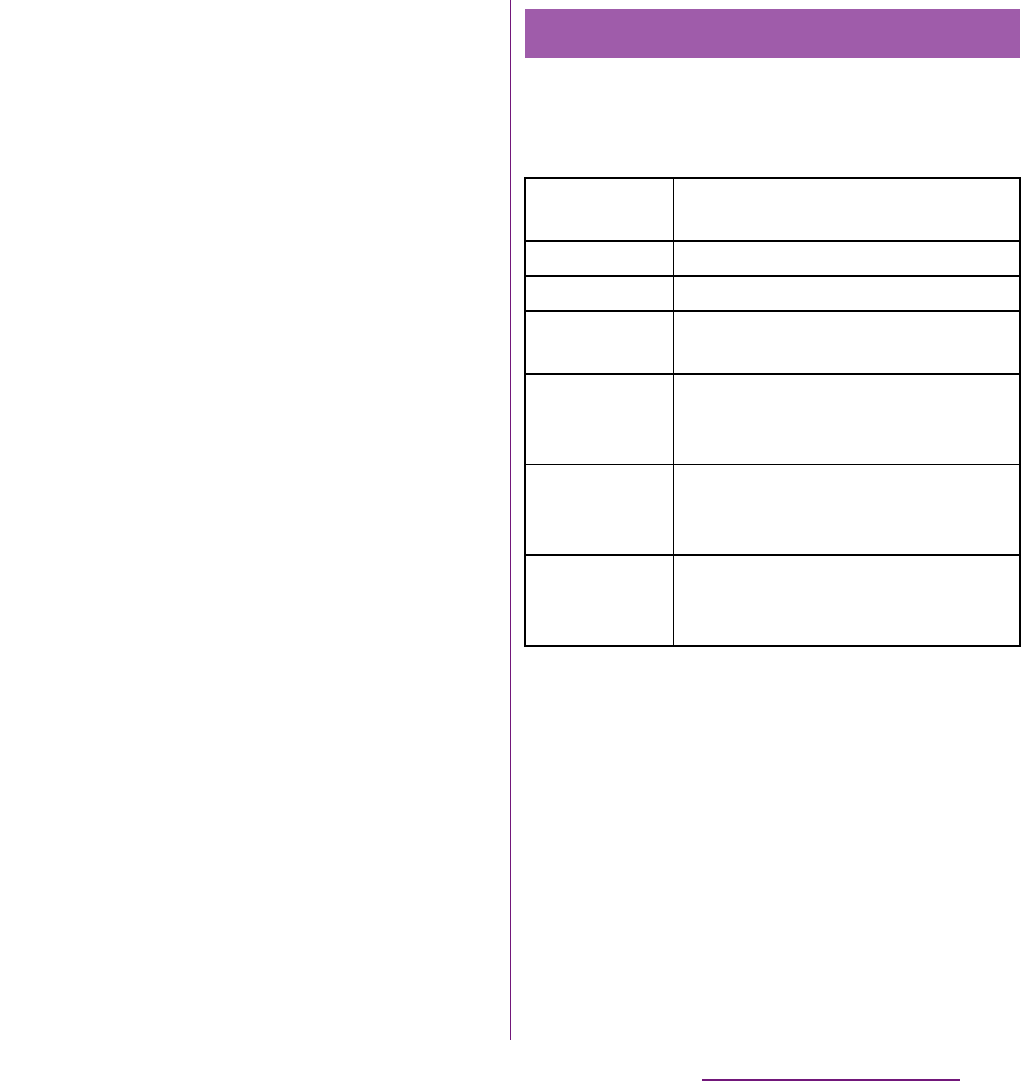
55
Before Using the Terminal
❖
Information
・
When you enter character by handwritten input for
the first time, a screen indicating how to input
appears. Tap [OK] or
x
.
・
In handwritten input, hiragana, alphabet, number,
some symbols can be entered.
・
You can enter a character continuously without
deleting entered character.
・
For voiced sound and semi voiced sound mark, enter
in the right upper part of the handwritten input
screen.
・
For punctuation mark and lower case, enter in the
lower part from the center of the handwritten input.
・
For entering alphabet, enter it with reference to
lower horizontal line of the handwritten input screen.
While entering characters, touch and hold
the text box to display the "Edit text" menu
and edit entered text.
Editing text
Select word
Drag the slider to select a part of
entered text.
Select all
Select all entered text.
Input method
P.47
Add "xx" to
dictionary
Add the entered text to the User
dictionary.
Cut
Display when [Select word]/[Select
all] is selected. Cut the text selected
by [Select word]/[Select all].
Copy
Display when [Select word]/[Select
all] is selected. Copy the text selected
by [Select word]/[Select all].
Paste
Display when [Cut]/[Copy] is
selected. Paste the cut/copied text by
[Cut]/[Copy].
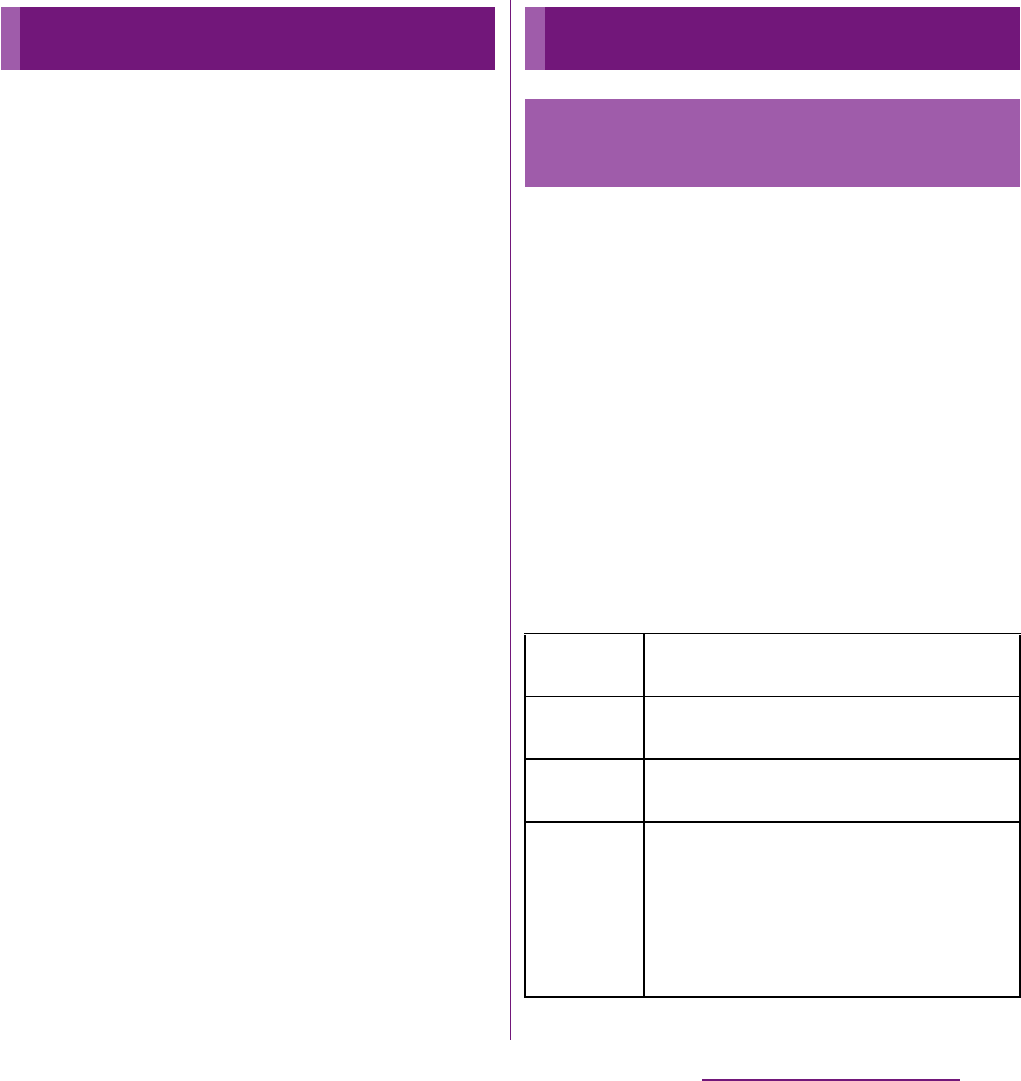
56
Before Using the Terminal
For each type of keyboard, you can make
settings related to character entry.
1
From the Home screen, tap
t
and tap [Settings]
u
[Language &
keyboard].
2
Tap [Xperia
™
keyboard]/[Xperia
™
Chinese keyboard]/[Xperia
™
Japanese keyboard].
・
The settings screen for each keyboard
appears. Tap an item displayed on the
screen to set.
❖
Information
・
The items vary depending on the keyboard type.
Make keyboard settings such as Key sound,
Vibrate, etc.
1
From the Home screen, tap
t
and tap [Settings]
u
[Language &
keyboard]
u
[Xperia
™
Japanese
keyboard].
・
The setting screen for Japanese
keyboard appears.
2
Tap [On-screen keyboard settings].
・
Tap (mark/unmark) an item in
"Common on-screen keyboard
settings" to set.
Setting character entry Setting Japanese keyboard
Common settings of software
keyboard
Key sound
Set whether to sound at the time of key
tapping.
Vibrate
Set whether to vibrate at the time of key
tapping.
Pop-up on
key press
Set to popup the key you have tapped at
the time of key tapping.
Keep
keyboard
type
Set to stabilize the last status of
keyboard (phonepad/QWERTY/
Japanese syllabary keyboard/
handwritten input) in the each portrait/
landscape screen by kana/alphabet/
number input mode.

57
Before Using the Terminal
Auto capitalization
Set to capitalize automatically the top letter
you enter in English input mode.
1
From the Home screen, tap
t
and tap [Settings]
u
[Language &
keyboard]
u
[Xperia
™
Japanese
keyboard].
2
Mark [Auto capitalization].
You can change keyboard skin.
1
From the Home screen, tap
t
and tap [Settings]
u
[Language &
keyboard].
2
Tap [Xperia
™
Japanese keyboard]
u
[Select keyboard skin].
3
Select from displayed keyboards
and tap [Set skin].
❖
Information
・
To download and add keyboard skins from a website,
tap [Search for skin] in Step 3. Some keyboard skins
downloaded from website may not support the
terminal. To delete the downloaded keyboard skin,
from the Home screen, tap
t
, and tap
[Settings]
u
[Applications]
u
[Manage applications],
and tap the keyboard skin you want to delete in the
"Downloaded" tab, and then tap
[Uninstall]
u
[OK]
u
[OK].
The Word suggestion function shows
predicted conversion candidates when you
enter Japanese/English characters. Mark the
checkbox of Word suggestion checkbox to
set options "Error correction" and "Auto
space". These options help you entering
characters with ease.
Setting Word suggestion
1
From the Home screen, tap
t
and tap [Settings]
u
[Language &
keyboard].
2
Tap [Xperia
™
Japanese keyboard].
3
Mark [Word suggestions]
checkbox.
❖
Information
・
Flick or drag downward in the word suggestion field
to enlarge suggestion field in which you can see
more word suggestions and to hide the keyboard.
Tap [
前候補
(previous suggestion)]/[
次候補
(next
suggestion)]/[
確定
(fix)] shown at the bottom of the
word suggestions screen to select/fix characters to
be entered. To show the software keyboard, tap [
戻る
(Back)] or
x
.
Keyboard skin settings
Word suggestion settings

58
Before Using the Terminal
Setting Error correction
・
Error correction corrects mistyped characters
and shows conversion candidates before
conversion in one-byte alphabet input mode
when entering characters with QWERTY
keyboard.
1
From the Home screen, tap
t
and tap [Settings]
u
[Language &
keyboard].
2
Tap [Xperia
™
Japanese keyboard].
3
Mark [Error correction] checkbox.
Setting Auto space
・
When selecting English word suggestion,
Auto space enters next to the entered
character. However, space is not entered
automatically in the mail address or URL input
fields.
1
From the Home screen, tap
t
and tap [Settings]
u
[Language &
keyboard].
2
Tap [Xperia
™
Japanese keyboard].
3
Mark [Auto space] checkbox.
To display the word as the preferred
candidate when entering characters, set the
user dictionary beforehand.
Registering words in user dictionaries
There are 2 types of user dictionaries: "My
words Japanese" and "My words English".
1
From the Home screen, tap
t
and tap [Settings]
u
[Language &
keyboard].
2
Tap [Xperia
™
Japanese keyboard].
3
Tap [My words Japanese]/[My
words English].
4
Tap
t
and [Add].
5
Tap the character input box for
"Reading" and fill it out, then tap
[
次へ
(Next)].
6
Enter a word in the input box for
"Word" and tap [
完了
(Done)].
7
Tap [Save].
❖
Information
・
Up to 50 characters (regardless of one-byte or two-
byte characters) can be stored for a "Reading" and
"Word", and up to 500 items can be stored in the user
dictionary.
User dictionary settings

59
Before Using the Terminal
・
When entering characters, tapping [
直変
(Direct
conversion)] in the word suggestion field may give
priority to some registered words.
Editing user dictionary
1
On the user dictionary screen,
select a word you want to edit.
2
Tap
t
and [Edit].
3
Edit the content and tap [Save].
Deleting words from user dictionary
1
On the user dictionary screen,
select a word you want to delete.
2
Tap
t
and tap [Delete]
u
[OK].
・
To delete all words in the list, tap
[Delete all]
u
[OK].
Setting Words by learning
1
From the Home screen, tap
t
and tap [Settings]
u
[Language &
keyboard].
2
Tap [Xperia
™
Japanese
keyboard]
u
[Learn words].
3
Mark [Save word while typing].
・
To reset already learned words, tap
[Delete saved words]
u
[OK].
❖
Information
・
To delete learned words individually, touch and hold
a word you want to delete and tap [
学習データ削除
(Delete learned word)].
Setting online dictionary
When entering characters, touch and hold
to activate online dictionary.
1
From the Home screen, tap
t
and tap [Settings]
u
[Language &
keyboard].
2
Tap [Xperia
™
Japanese
keyboard]
u
[Online dictionary].
3
Tap [Online dictionary].
4
Read the note and tap [Agree].
・
[Online dictionary] is marked.
Backing up and restoring dictionary
User dictionary and Words by learning can be
backed up onto an internal storage and
restored when needed.
1
From the Home screen, tap
t
and tap [Settings]
u
[Language &
keyboard].
2
Tap [Xperia
™
Japanese
keyboard]
u
[Backup & restore].
3
Tap [Backup]/[Restore].

60
Before Using the Terminal
4
Mark a dictionary you want to
back up or restore from among
[My words Japanese], [My words
English], or [Learn words].
5
Tap [Go].
・
When backing up, a screen asking
whether to overwrite the user
dictionary on the internal storage
appears. When restoring, a screen
asking whether to overwrite the user
dictionary in the terminal appears.
6
Tap [OK]
u
[OK].
・
The data is backed up or restored.
❖
Information
・
If restoring data is failed, user dictionary in the
terminal restores to the default.
・
User dictionary and Words by learning are not
backed up onto microSD card.
When entering characters, touch and hold
and tap to display the plug-in
application list and use desired plug-in
applications.
Using Contact Picker 2.3
If contacts are registered to the Contacts, you
can use "Contact Picker 2.3" to enter contact
information when entering characters.
"Contact Picker 2.3" is a preinstalled plug-in
application.
1
On a character entry screen, touch
and hold .
2
Tap .
3
Tap [Contact Picker 2.3].
4
On the contacts list screen, tap the
contact to be quoted.
5
Mark the item you want to enter
and tap [Done].
・
If you want to select/deselect all items,
tap [Mark all]/[Unmark all].
❖
Information
・
On the contacts list screen, tap [History] or [Favorites]
to display specified contacts.
Adding a plug-in application
You can install and add plug-in applications
to use when entering characters.
1
From the Home screen, tap
t
and tap [Settings]
u
[Language &
keyboard].
2
Tap [Xperia
™
Japanese
keyboard]
u
[Manage extensions].
3
On the Info screen, tap [OK].
・
The POBox plug-in setting screen
appears.
Using a plug-in application

61
Before Using the Terminal
4
Tap [Download new extensions].
5
Tap an application and follow the
onscreen instructions.
❖
Information
・
Marked plug-in applications in the POBox plug-in
setting screen can be activated in the character entry
screen. Checkboxes for preinstalled plug-in
applications, "Contact Picker 2.3" is marked by
default.
You can view the detailed explanations on
the high performance Japanese keyboard
from the basic to application. The latest
information can be obtained from the
websites for plug-in applications or keyboard
skins.
1
From the Home screen, tap
t
and tap [Settings]
u
[Language &
keyboard].
2
Tap [Xperia
™
Japanese
keyboard]
u
[POBox Touch User
Guide].
❖
Information
・
Touch and hold in the handwritten input to
activate the handwritten input guide in the POBox
Touch User Guide (Japanese) to view the detailed
explanations on the handwritten input.
POBox Touch User Guide
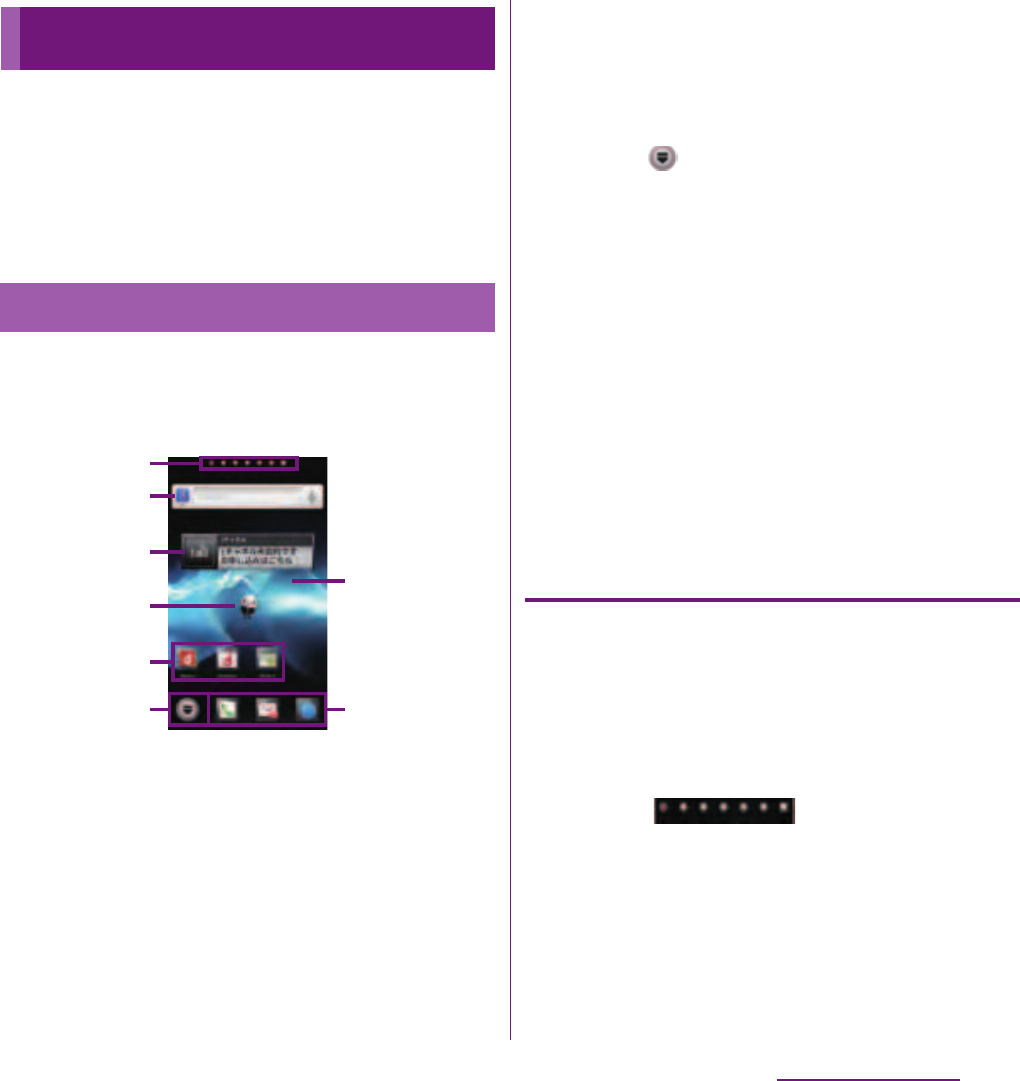
62
docomo Palette UI
docomo Palette UI
Home screen is a start screen for using
applications. You can personalize the Home
screen by adding or moving, for example,
application shortcuts and widgets, or
changing the wallpaper.
Tapping
y
displays Home screen which
consists of up to 12 screens you can use
flicking left and right.
a
Home screen position : Current position in 7 home
screens
b
Widget : Google Search
c
Widget : i-Channel
d
Widget : Machi-chara
e
Shortcuts (applications)
f
Applications button
g
Wallpapers
❖
Information
・
You can switch the home application between
"docomo" and "Xperia
™
" in the terminal.
"docomo" is set to the home application by default.
To switch the home application, from the Home
screen, tap
u
[Setup guide] and on the Preferred
applications screen, [Change now]
u
[Home screen],
or from the Home screen, tap
t
,
[Settings]
u
[Xperia
™
]
u
[Preferred apps
settings]
u
[Home screen]. To switch applications
(Home, phonebook (contacts), video or music player)
to be used in the terminal all at once, from the Home
screen, tap [Preferred apps settings]
u
[OK], or from
the Home screen, tap
t
,
[Settings]
u
[Xperia
™
]
u
[Preferred apps
settings]
u
[Set all to].
・
When the home application is switched, widgets or
shortcuts on the screen may not be displayed
correctly depending on home screen layout etc.
Switching the Home screen
1
Flick the Home screen to left or
right.
・
The Home screen switches.
❖
Information
・
You can check the current position of the Home
screen with at the top of the screen.
・
Alternatively, display "Home screens" (P.67) and then
tap any home screen to switch.
Home screen
Learning Home screen
a
b
c
e
f e
g
d
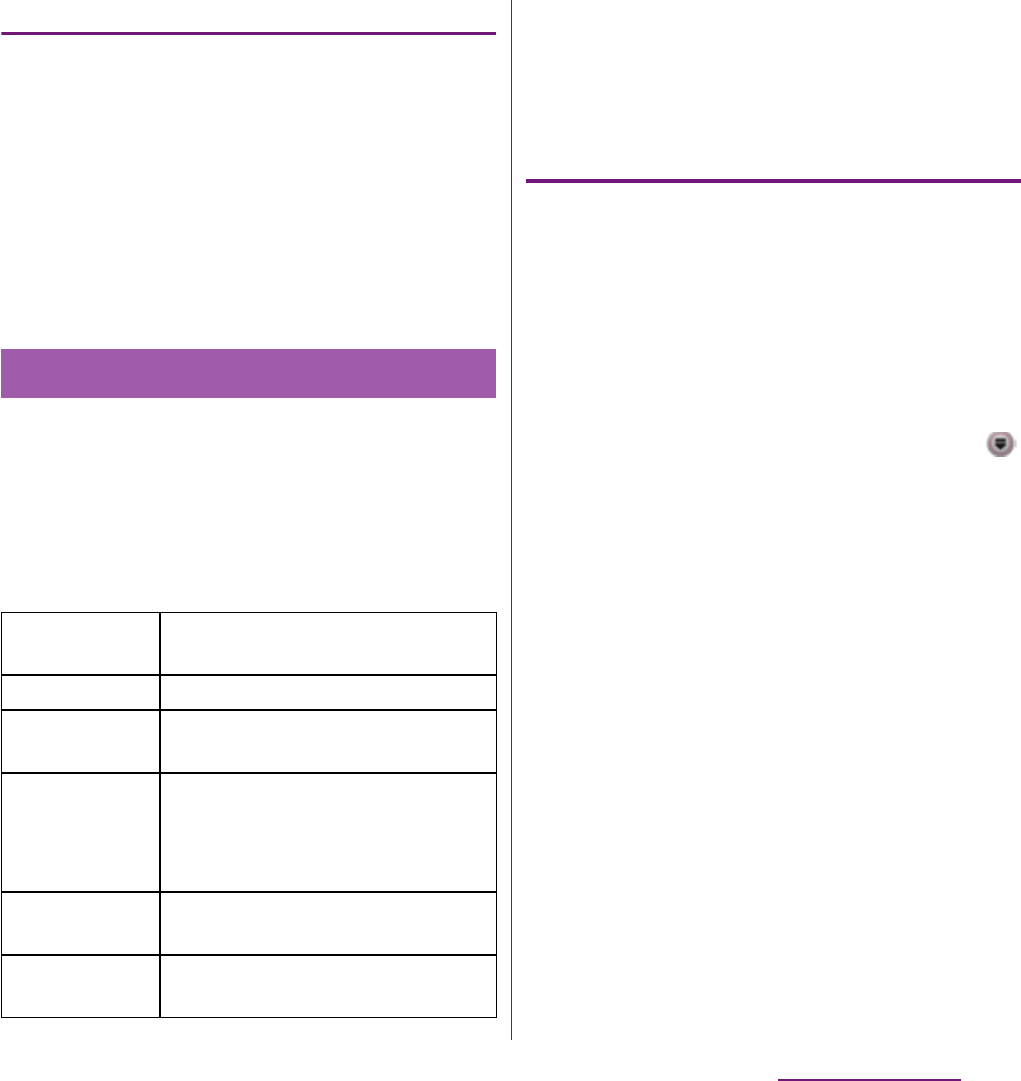
63
docomo Palette UI
Displaying a list of home screens
1
From the Home screen, pinch-in.
・
A home screen list appears.
❖
Information
・
At the left end home screen, tap
y
or from the
Home screen, tap
t
and tap [Home screens] to
display the list.
・
To return to the home screen, pinch-out, or tap
y
or
x
.
1
From the Home screen, tap
t
.
2
Tap [Add].
・
"Add to home screen" menu appears to
change the Home screen.
■
Add to home screen
❖
Information
・
"Add to home screen" appears also by touching and
holding anywhere on the Home screen without
icons.
Adding a shortcut to the Home screen
1
In "Add to home screen" menu, tap
[Shortcut].
2
Select a shortcut you want to add.
・
The shortcut appears on the Home
screen.
❖
Information
・
Alternatively, you can add from the Home screen,
and touch and hold an icon you want to add, tap
[Add].
Adding to the Home screen
Shortcut
Add shortcuts of applications or
setting screens. (P.67)
Widget
Add widgets. (P.68)
Folder
Create new folder or add folders
related to the Phonebook. (P.69)
Kisekae
Change the background of the
home screen or application screen,
or download from website to add.
(P.69)
Wallpaper
Change the wallpaper or download
from website to add. (P.69)
Group
Add group shortcut of applications
screen. (P.70)
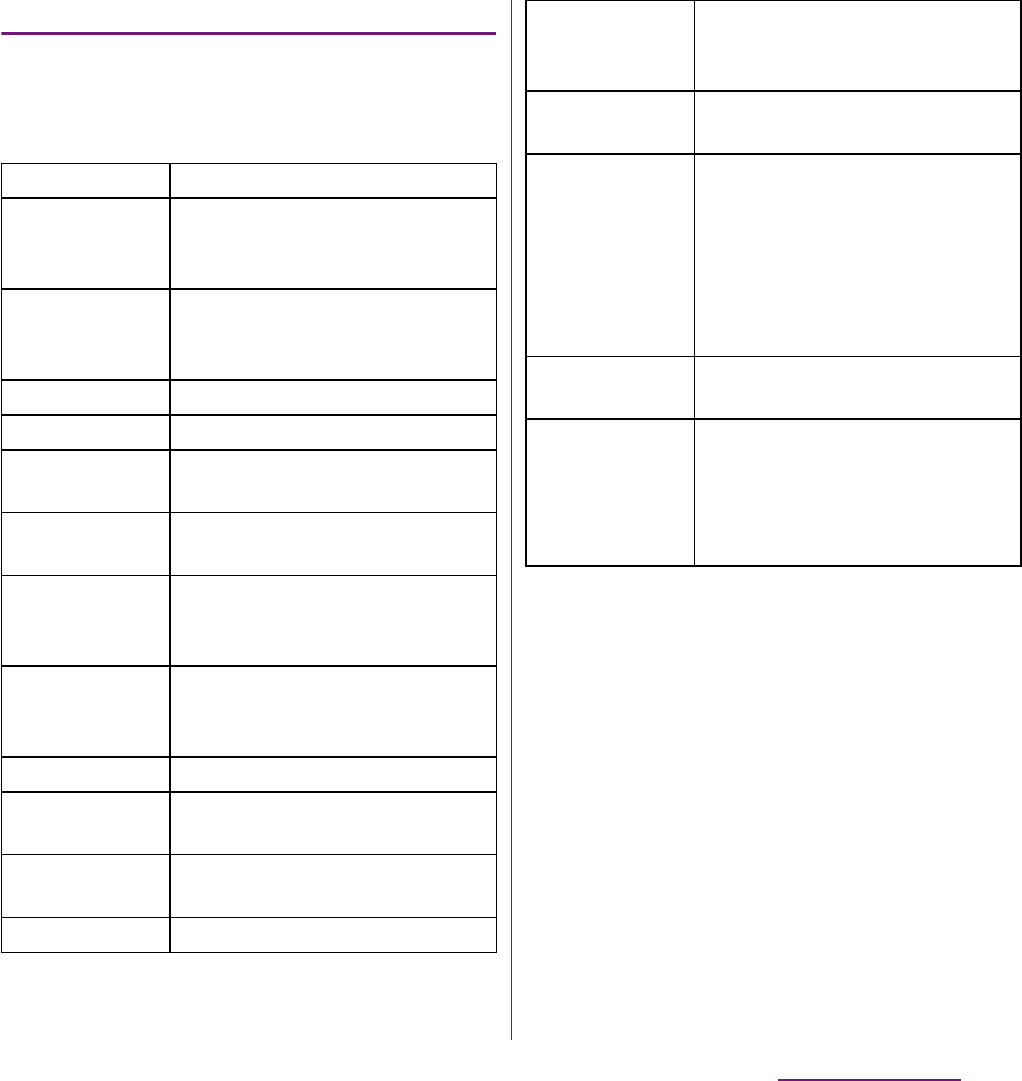
64
docomo Palette UI
Adding a widget to the Home screen
1
In "Add to home screen" menu, tap
[Widget].
・
A list of widgets appears.
2
Select an item.
❖
Information
・
If you install an application with widget from Android
Market, the installed widget is added to the widget
list.
Calendar
Display the calendar.
Contents
Headline
Display the latest contents
information of music, video, e-
book, etc.
docomo
location
information
Display docomo location
information application.
Facebook
View comments of members.
Google Search
Display the Quick search box.
Google+
Display Google+, compose article
to post.
Home screen
tips
Display tips of the Home screen
operation.
Infrared
Display "Send Myself" button and
"Receive file" button for infrared
communication.
i
チャネルウィ
ジェット
(i-
Channel widget)
Display the latest information such
as news or weather information in
ticker.
Latitude
View locations of members.
Machi-chara
Display reception of mails or calls
information with Machi-chara.
Market
Display recommended
applications of Android Market.
Personal area
Display personal area.
Phonebook
Select members
Display history of calls or message
(SMS) of 3 contacts selected from
the Phonebook fixed/at random.
Schedule &
Memo
Display memos or photo memos
on the calendar.
Traffic
Display necessary time to transfer
from your current location to your
destination and the widget on the
Home screen when you enter a
widget name or destination. Tap to
confirm the provided traffic
condition.
YouTube
Display the list of frequently played
movies and recommended.
ドコモ地図ナビ
ウィジェット
(DOCOMO map
navigation
widget)
Display a map around current
location and neighboring spots

65
docomo Palette UI
Adding a folder to the Home screen
1
In "Add to home screen" menu, tap
[Folder].
2
Select a folder you want to add.
・
The folder appears on the Home
screen.
・
You can rename or add items to a folder
by selecting [New folder] on the folder
selection screen.
■
Renaming
Touch and hold a folder you want to
rename
u
Tap [Edit name]
u
Tap the
[Folder name] entry box to enter a folder
name and tap [OK].
■
Adding an item
From the Home screen, touch and hold a
shortcut you want to add to the
folder
u
Drag it onto a folder and lift up
your finger.
・
A shortcut is moved into a folder.
❖
Information
・
Alternatively, open a folder by tapping and then
touch and hold the title bar to display the [Folder
name] entry box to change.
Changing Kisekae
1
In "Add to home screen" menu, tap
[Kisekae].
2
Select Kisekae you want to change
to and tap [Set].
❖
Information
・
You can add Kisekae contents by tapping [Search] to
download from website. To delete added Kisekae
contents, select the image and tap
[Delete]
u
[Delete].
・
Alternatively, from the Home screen, tap
t
and
tap [Kisekae/Wallp].
Changing wallpaper
1
In "Add to home screen" menu, tap
[Wallpaper].
2
Tap [Gallery]/[Live wallpapers]/
[Wallpaper gallery]/[Xperia
™
wallpapers].
・
When you tap [Xperia
™
wallpapers],
select an image to set to the wallpaper,
tap [Set wallpaper].
・
When you tap [Gallery], select an image
to set to the wallpaper, pinch or the
cropping frame or drag it to area you
want to use as wallpaper, and tap [Save]
to set wallpaper.

66
docomo Palette UI
・
When you tap [Live wallpapers], select a
content, tap [Set wallpaper]. You can
also download and add Live wallpaper
content from a web page. For some
contents, you can change type or
contents displayed on the wallpaper by
tapping [Settings].
・
When you tap [Wallpaper gallery],
select an image you want to use as
wallpaper, then tap [Set wallpaper].
❖
Information
・
Alternatively, from the Home screen, tap
t
and
tap [Kisekae/Wallp].
Adding a group to the Home screen
1
In "Add to home screen" menu, tap
[Group].
2
Select a group of applications you
want to add.
❖
Information
・
Alternatively, on the Applications screen (P.71), touch
and hold the group name and then tap [Add].
You can add, delete, sort home screens while
the home screen list is displayed.
・
For details on the home screen list, see
"Displaying a list of home screens" (P.67).
Adding a home screen
1
From the Home screen, tap
t
and tap [Home screens].
2
Tap .
❖
Information
・
There are 7 home screens by default. You can add 5
home screens moreover.
Deleting a home screen
1
From the Home screen, tap
t
and tap [Home screens].
2
Touch and hold a home screen you
want to delete and tap [Delete].
❖
Information
・
Alternatively, touch and hold a home screen you
want to delete from the home screen list and drag to
displayed at the bottom of the screen.
Sorting home screens
1
From the Home screen, tap
t
and tap [Home screens].
2
Touch and hold a home screen you
want to sort.
3
Drag it to the place you want to
move and lift up your finger.
Changing the Home screen
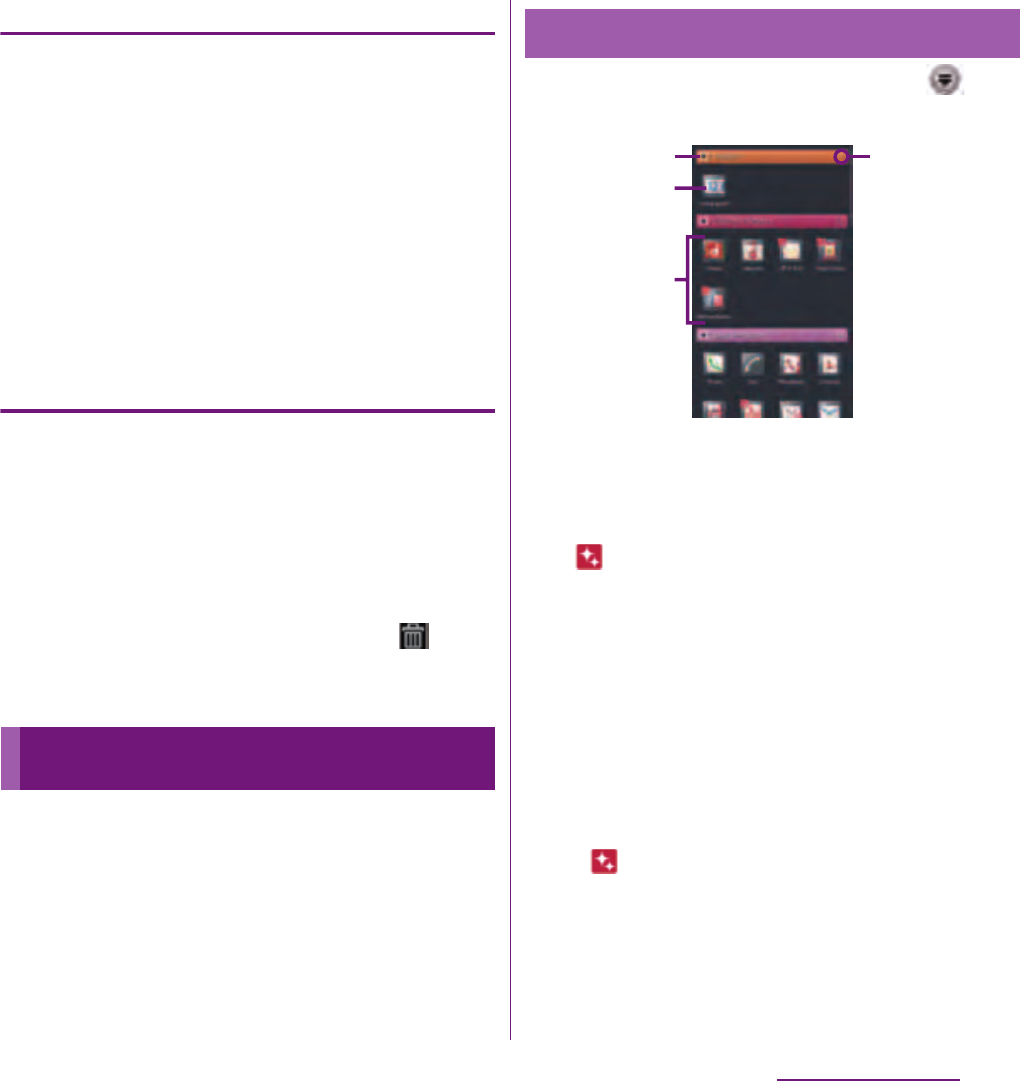
67
docomo Palette UI
Moving an icon on the Home screen
1
From the Home screen, touch an
icon you want to move.
2
Drag it anywhere.
・
To move to another Home screen, keep
touching the icon and drag to left or
right.
3
Release your finger from the icon.
Deleting an icon from the Home
screen
1
From the Home screen, touch an
icon you want to delete.
2
Tap [Delete].
❖
Information
・
Alternatively, touch and hold an icon you want to
delete from the Home screen and drag to
displayed at the bottom of the screen.
You can access the applications installed in
the terminal using the Applications screen.
1
From the Home screen, tap .
・
The Applications screen appears.
a
Group name
・
To display/hide applications in the group, tap the
group name.
b
Application icon
・
is displayed for newly arrived application.
・
Some application icons are displayed with a
number of missed calls or unread mails.
c
Applications in the group
・
To display/hide all applications in the group,
pinch on the Applications screen.
d
Number of applications in the group
❖
Information
・
To close the Applications screen, tap
x
or
y
.
・
If you download applications from website, icons
with are added to the Applications screen.
Applications screen
Learning Applications screen
ad
c
b
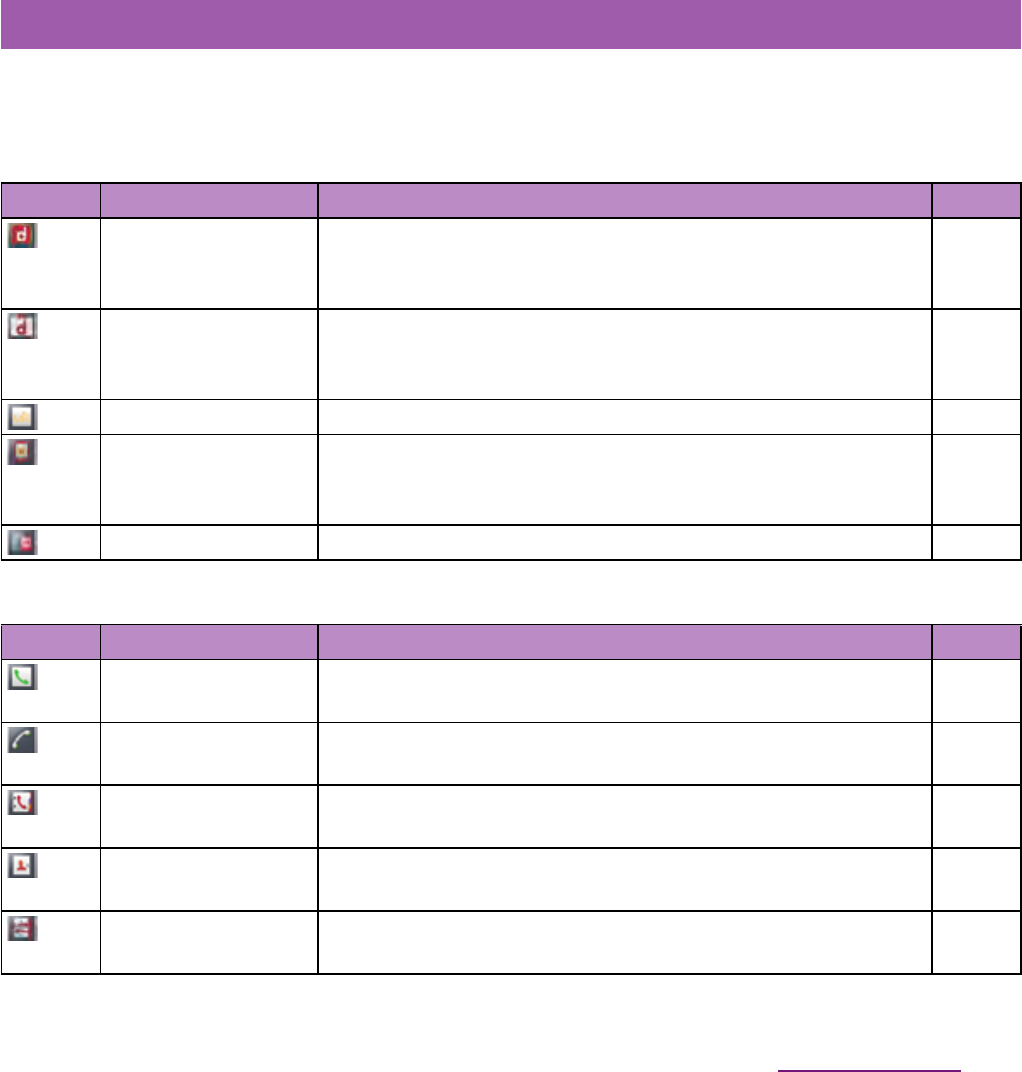
68
docomo Palette UI
The applications displayed on the Applications screen by default are as follows.
・
For usage of some applications, separate subscription (Charged) is required.
■
DOCOMO Services
■
Basic Functions
Applications
Icon Applications Description Page
dmenu A shortcut application for "dmenu" to find contents that you used
in i-mode and joyful and convenient contents for smartphones
readily.
−
dmarket Activate dmarket. You can buy contents such as music, videos,
books at the dmarket. Applications on the Android market are also
featured.
−
i
チャネル
(i-Channel) An application for using i-Channel.
−
Machi-chara An application for displaying character on the terminal screen. The
character moves on the widget and informs you i-concier
information, mail reception, incoming calls, etc.
−
docomo backup Back up or restore phonebook data etc.
−
Icon Applications Description Page
Phone Activate DOCOMO phone application to make/receive calls, and
switch between calls.
P.81
Dial Activate Xperia
™
phone application to make/receive calls, and
switch between calls.
−
Phonebook Activate DOCOMO phonebook application to manage phonebooks
of your friends or colleagues.
P.87
Contacts Activate Xperia
™
phonebook application to manage contacts of
your friends or colleagues.
−
PhoneBookCopy An application to move or copy phonebook data using external
memory such as microSD card.
P.94
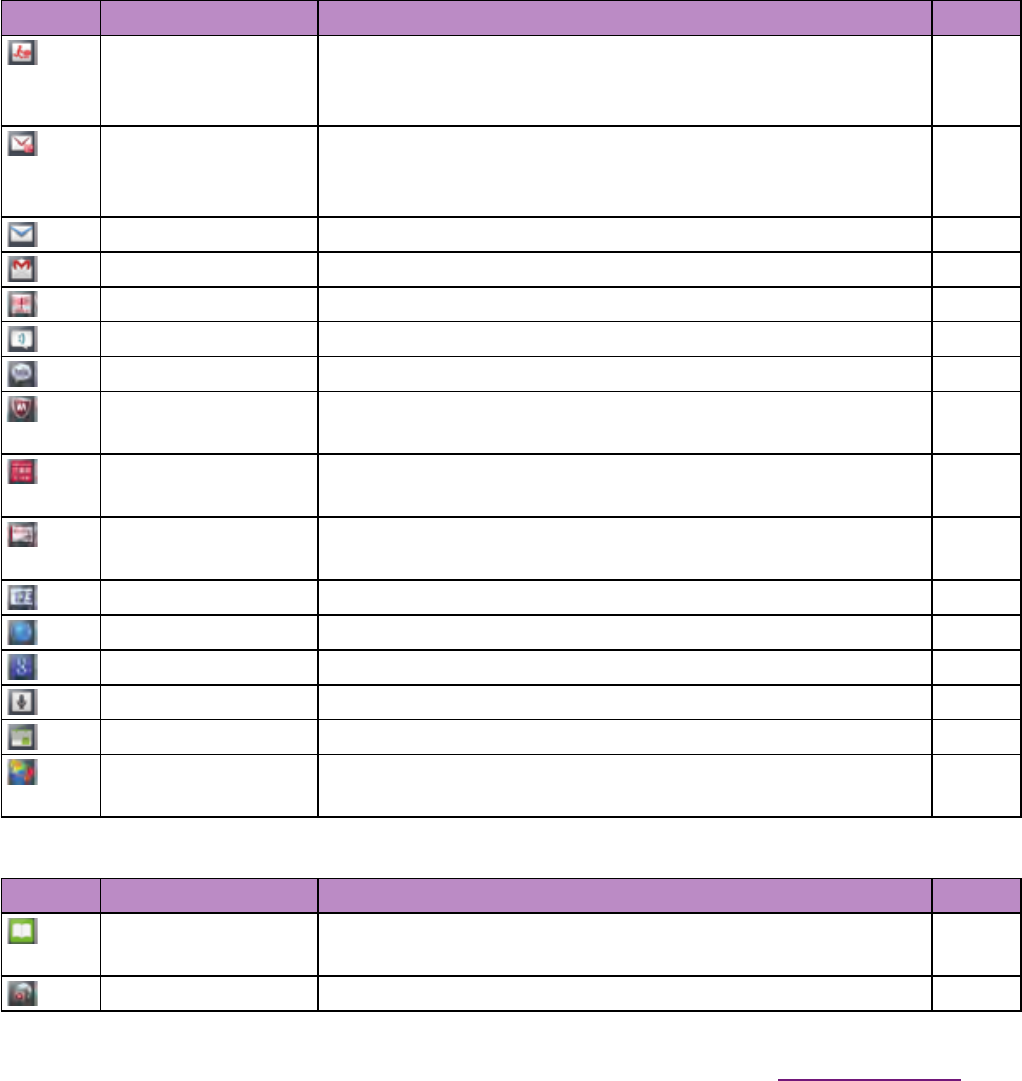
69
docomo Palette UI
■
Entertainment
声の宅配便
(Koe-no-
Takuhaibin)
Use "Koe-no-Takuhaibin" easily and conveniently on the
smartphone. You can record and play voice messages with a simple
operation.
P.105
sp
モードメール
(sp-
mode mail)
Send/receive mails using docomo mail address (@docomo.ne.jp).
You can use pictogram and Deco-mail. Mails can be received
automatically.
P.141
Email Send and receive emails (multiple accounts are also available). P.144
Gmail Send and receive mails from/to a Google account. P.151
Area Mail Receive early warning "Area Mail" and view received Area Mail. P.152
Messaging Send and receive messages (SMS). P.141
Talk Chat with friends using Google Talk instant messaging. P.151
Anshin Scan Protect your terminal from virus damage. Detect virus hidden in
installed applications or microSD card.
−
災害用キット
(Disaster
kit)
An application which helps you to record and check messages on
the docomo Disaster Message Board.
−
Instruction Manual Display the terminal instruction manual. You can start a function
you want to use from the explanation.
P.2
Setup guide Display Setup guide. P.39
Browser Browse Web and WAP sites (except for WML) and download files. P.153
Google Search Search information in the terminal and web pages from keywords. P.46
Voice Search Use Google search by voice input. P.46
Market Access to the Android Market, download and buy new applications. P.204
APP NAVI Introduce applications for Android terminals. You can search
applications from categories, rankings, etc.
−
Icon Applications Description Page
Book Store MyShelf An application for viewing e-books you purchased on the dmarket
BOOK store.
−
Media Player Play music and videos.
−
Icon Applications Description Page
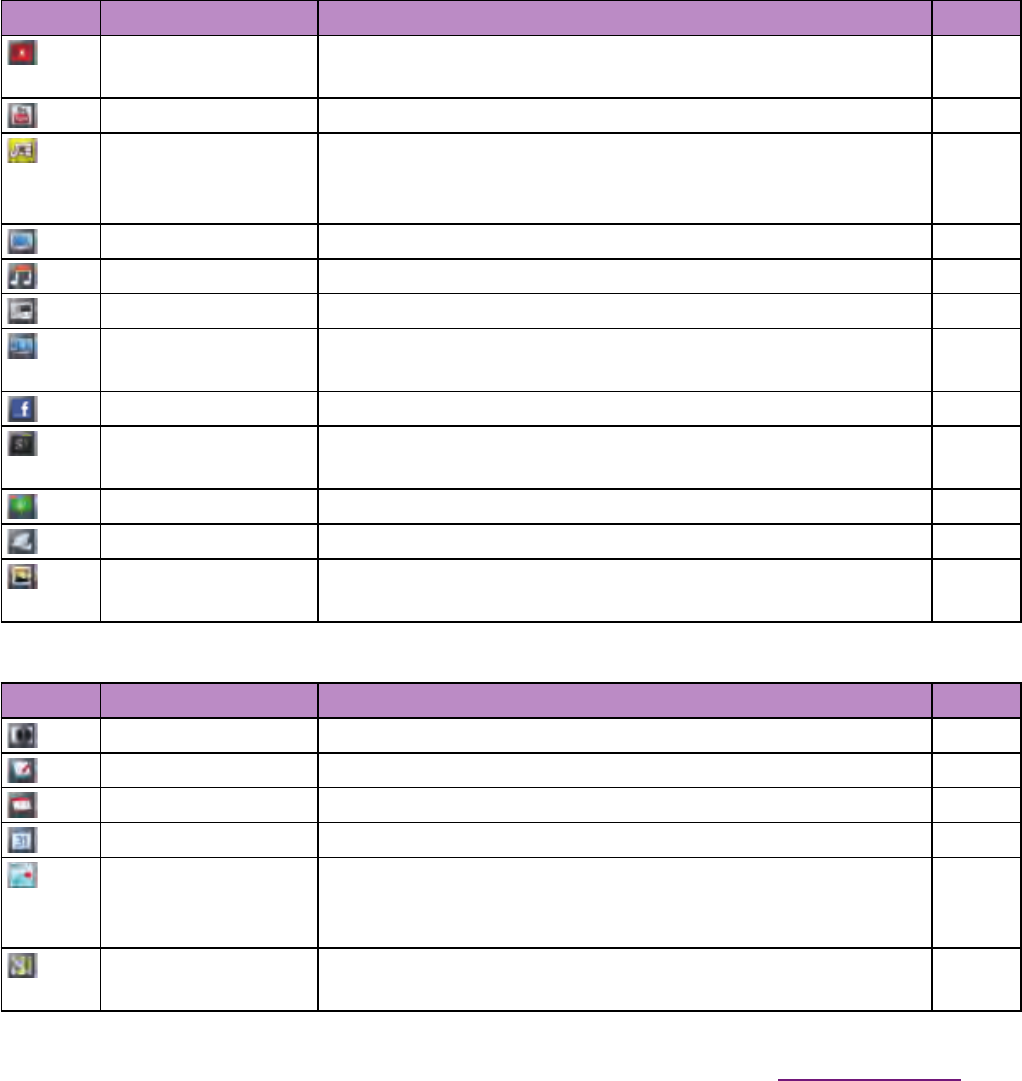
70
docomo Palette UI
■
Tools
Videos An application for accessing movie rental service of Android
market. Select a movie you want to watch and rent it.
−
YouTube Playback videos around the world or upload recorded videos. P.198
G
ガイド番組表
(G-Guide program
table)
View ground-based broadcasting, BS digital broadcasting.
Searching programs by key words or categories,watching 1Seg, and
remote recording 1Seg program from outside are available.
−
1Seg Watch 1Seg program. P.215
Music player Playback music data stored on the internal storage or microSD card. P.200
FM radio Use FM radio. P.222
Connected devices Set and manage media server via Connected devices, and connect
DLNA device to the terminal via Wi-Fi network to share files.
P.170
Facebook Activate Facebook client application. P.133
Google+ Activate Social Network Service (SNS) client application "Google+"
provided by Google.
−
Messenger Chat with friends using Google+ instant messaging.
−
Timescape
™
View Social Networking Service (SNS) history. P.205
Gallery View photos and videos you took, and images posted on Picasa or
Facebook.
P.193
Icon Applications Description Page
Camera Take photos and record video clips. P.172
Memo Create/Manage memos.
−
Schedule Create/Manage schedule.
−
Calendar Display a calendar and manage schedule. P.227
地図アプリ
(Map
Application)
Functions such as
地図
(Map),
お店や施設検索
(Shop and facility
search),
ナビ
(Navigation),
乗換
(Transfer function),
訪れた街
(Visited
places) support your outing.
−
Maps Use Google map services, such as viewing current location, finding
another location and calculating routes.
P.211
Icon Applications Description Page

71
docomo Palette UI
■
Osaifu/Shopping
■
Settings
Navigation Display Google map navigation to receive detailed guides for your
destination.
P.213
Places Use various information registered on Google map, such as shops
around the current location.
P.212
Latitude Check and share the location information of specified friends. P.214
Name card creator Create original name card to display in the My profile field of
docomo "Phonebook" application.
−
Infrared An application which allows you to send and receive phonebook
data, etc. via infrared communication.
P.163
Calculator Perform basic calculations such as addition, subtraction,
multiplication, and division.
−
Alarm and Clock Display clock or set an alarm, etc. P.229
OfficeSuite View and read Office documents. P.233
Icon Applications Description Page
Osaifu-Keitai Use Osaifu-Keitai. P.223
iD
設定アプリ
(iD
setting application)
Make settings for use of electronic money, iD. P.226
ToruCa Acquire, display, search, or refresh ToruCa. P.226
Icon Applications Description Page
Settings Make the terminal settings. P.107
eco
モード
(eco mode) An application to set "eco mode" for reducing battery consumption
by adjusting each setting such as display brightness.
−
AUTO-GPS Use GPS compatible services which inform you weather
information, location information such as shop locations, tourist
information, etc. according to your location.
−
Icon Applications Description Page
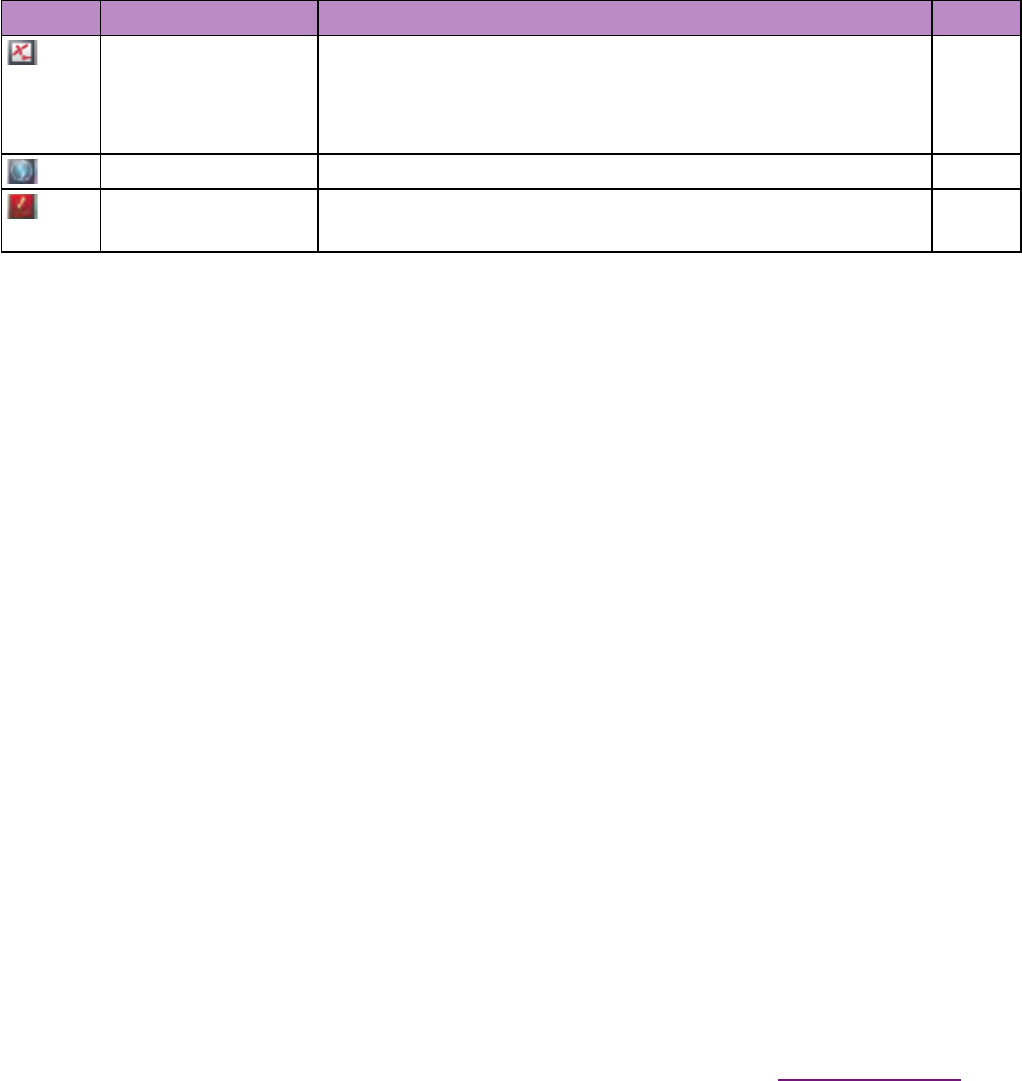
72
docomo Palette UI
❖
Information
・
Some application names may not be displayed fully.
・
Some application require downloading and installation. If you cannot download application by tapping, from
the Home screen, tap
t
and [Settings]
u
[Applications]
u
[Unknown sources]
u
[OK], mark the checkbox and
then tap the application.
docomo location
information
Provide location information such as imadoco search,
imadocokantan search, Keitai-Osagashi Service, Emergency
Location Report.
Also access service website to change or make various settings.
−
Update center Update the latest software or application. P.252
Flash Player Settings Change settings for controlling application running method in
Flash Player.
−
Icon Applications Description Page

73
docomo Palette UI
From the Applications screen, you can add
icons, sort icons, uninstall applications. Also
you can change group setting.
Adding an application icon to the
Home screen
1
From the Applications screen,
touch and hold an icon you want to
add to the Home screen.
2
Tap [Add].
・
The application icon is added onto the
Home screen.
❖
Information
・
From the Home screen, tap
t
and
[Add]
u
[Shortcut]
u
Tap [Application] and select an
application to add.
Sorting application icons
1
From the Applications screen,
touch and hold an application icon
you want to sort.
2
Drag it to the place you want to
move and lift up your finger.
・
The application icon moves.
❖
Information
・
To move an application icon to another application
group, touch and hold the icon on the Applications
screen, tap [Move], then select a group you want to
move to.
Uninstalling an application
Some application icons can be deleted from
the Applications screen.
・
Before uninstalling application, back up
contents related to the application that you
want to save including data saved in the
application.
・
Some applications cannot be uninstalled.
1
From the Applications screen,
touch and hold an icon of
application you want to uninstall.
2
Tap [Uninstall].
・
Uninstall screen appears.
3
Tap [OK]
u
[OK].
❖
Information
・
Some applications pre-installed in the terminal may
not be uninstalled.
・
Application icons can be deleted from the managing
applications screen. For details, refer to "Deleting
installed application" (P.131).
Changing the Applications
screen

74
docomo Palette UI
Adding a shortcut of group to the
Home screen
1
From the Applications screen,
touch and hold a group you want
to add to the Home screen.
2
Tap [Add].
・
Shortcuts to the group is added to the
Home screen.
❖
Information
・
From the Home screen, tap
t
and [Add]
u
Tap
[Group] and select a group to add.
Changing a label color of the group
name
1
From the Applications screen,
touch and hold a group you want
to change the color.
2
Tap [Edit label] and select label
color to change.
・
The color for group name is changed.
Deleting a group
1
From the Applications screen,
touch and hold a name of a group
you want to delete.
2
Tap [Delete]
u
[OK].
・
Application icons belonged to the
deleted group move to the "Download
Application" group.
❖
Information
・
"Recently", "DOCOMO Services", and "Download
Application" groups cannot be deleted.
Changing a group name
1
From the Applications screen,
touch and hold a group name you
want to rename.
2
Tap [Edit name].
3
Enter a group name in the [Group
name] entry box and tap [OK].
・
The group is renamed.
❖
Information
・
"Recently", "DOCOMO Services", and "Download
Application" groups cannot be renamed.
Adding a group
1
From the Applications screen, tap
t
and tap [Add group].
2
Enter a group name in the [Group
name] entry box and tap [OK].
・
A new group is added.

75
docomo Palette UI
Sorting groups
1
From the Applications screen,
touch and hold an group name you
want to sort.
2
Drag it to the place you want to
move and lift up your finger.
・
The group is moved.
You can view and access recently used
applications from this window.
1
Touch and hold
y
.
・
Recently used applications appear on a
list.
Search application installed into the terminal
to activate.
1
From the Applications screen, tap
t
and then tap [Search].
・
For the first time to join Latitude, a
message confirming whether to agree
to Google's privacy policy appears.
Select [Agree] or [Disagree].
・
The software keyboard appears.
2
Tap at the left of the search box
and select [Apps].
3
Enter application name you want
to search.
・
Search suggestions appear as you enter
a character.
4
Tap a search item.
・
The application activates.
❖
Information
・
Alternatively, from the Home screen, tap , then
tap [Google Search] to search application. For details,
refer to "Searching information in the terminal and
web pages" (P.46).
Opening the recently used
applications window
Searching applications

76
docomo Palette UI
Icons on the Applications screen can be
displayed in a list or tiles.
1
From the Applications screen, tap
t
and then tap [List format]/
[Tile format].
You can check information on the home
application and make display setting.
Displaying the Home application
information
1
From the Home screen, tap
t
and then tap [More].
2
Tap [Application info].
・
The home application information
appears.
Making display setting for the Home
screen
1
From the Home screen, tap
t
and then tap [More].
2
Tap [Home settings].
・
The "Home settings" screen appears
and the following setting can be made.
Switching application screens
Home application information
Personal area
Set whether to display personal area
on the Home screen.
Wallpaper loop
Set whether to loop wallpaper on
the Home screen.
Sync function
Set whether to automatically refresh
personal area information.
International
roaming
Set whether to automatically refresh
personal area information during
International roaming.

77
Calling/Network Services
Calling/Network Services
1
From the Home screen, tap
[Phone]
u
[Dial].
2
Enter the number of the recipient
and tap .
・
If a wrong number is entered, tap
to delete the number.
❖
Information
・
To activate Xperia
™
phone application, from the
Home screen, tap , then tap [Dial].
Entering pause (,)
This function allows you to operate voice
mail at home, to reserve tickets, or to check
the balance of a bank account, etc.
1
From the Home screen, tap
[Phone]
u
[Dial].
2
Enter the phone number, then tap
t
and tap [Add 2–sec pause].
When the terminal is within range of the
service area, you can make an emergency call
of 110 (Police), 119 (Fire and ambulance), or
118 (Japan Coast Guard).
1
From the Home screen, tap
[Phone]
u
[Dial].
2
Enter the number of the
emergency call and tap .
・
If a wrong number is entered, tap
to delete the number.
❖
Note
・
If UIM is not inserted to the terminal, emergency calls
(110, 119, 118) cannot be made in Japan.
・
This terminal supports "Emergency call location
information". If you use the terminal to place a call to
emergency numbers such as 110, 119, or 118, the
information of a location where you are calling from
(location information) is automatically notified to the
Emergency call acceptance organization such as the
Police Station.
The Emergency call acceptance organization may not
be able to figure out your exact location depending
on the location where you place a call or radio wave
condition.
If you make a call hiding your caller ID, such as by
entering a phone number with "184" for each call, the
location information and phone number are not
notified. However, the Emergency call acceptance
organization may decide to obtain the location
information and phone number regardless of your
settings when they consider it is necessary for
lifesaving, etc. Note that the areas/time for which the
"Emergency call location information" is ready to be
used vary depending on the preparatory state of each
Emergency call acceptance organization.
Making/Receiving a call
Making a call
Emergency call
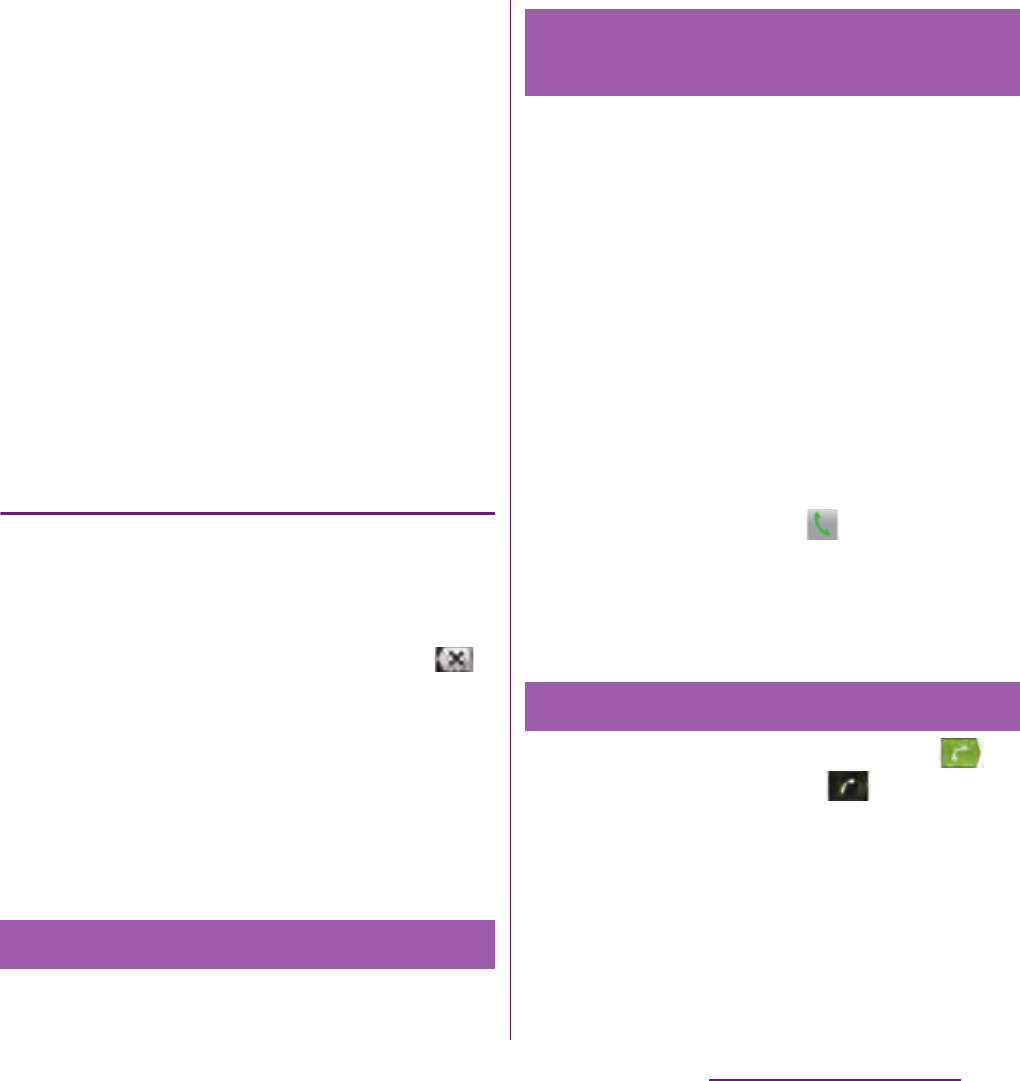
78
Calling/Network Services
・
When calling 110, 119 or 118 for emergency from the
terminal, tell that you are calling from a mobile
phone, and give your phone number and your
current location precisely for checking callback from
the police/fire department. Also, make a point to call
in a stationary position to prevent the call from being
dropped. Do not power off the terminal for at least
10 minutes after the emergency call just in case the
Police or Fire/Ambulance may have to get in contact
with you.
・
Note that you may not connect to the local Fire
Department or Police Station depending on where
you are calling from. In this case, try to call from a
public phone or an ordinary phone in the
neighborhood.
Making an emergency call while UIM
is locked
1
Tap [Emergency call].
2
Enter the emergency number and
tap [Call].
・
If a wrong number is entered, tap
on the right of the phone number field
to delete the number.
❖
Note
・
In Japan, while entering PIN code on the screen
(P.126) or during PUK lock (P.127), the emergency
numbers of 110/119/118 are not available.
1
Tap [End call].
For details on WORLD CALL, refer to
DOCOMO International Services website.
1
From the Home screen, tap
[Phone]
u
[Dial].
2
Touch and hold [0] key until "+"
sign appears.
・
When making an international call, "+"
is replaced by an international access
code.
3
Enter Country code
u
Area code
(City code)
u
the number of the
recipient and tap .
・
If the area code begins with "0", omit "0".
However, "0" may be required to dial to
some countries or areas such as Italy.
1
While receiving a call, touch
(left) and drag it to (right).
❖
Information
・
If you are using regular headphones without a
microphone, you need to speak to the microphone
of the terminal.
・
Even during the screen lock or key lock, the icon
appears and you can answer a call by the same
operation.
Ending a call
Making an international call
(WORLD CALL)
Receiving a call

79
Calling/Network Services
1
While receiving a call, touch
(right) and drag it to (left).
❖
Information
・
Even during the screen lock or key lock, the icon
appears and you can decline a call by the same
operation.
You can make or answer a call with Stereo
Headset with Microphone (Sample)
connecting to the terminal.
■
Making a call
1
Make a call with Stereo Headset
with Microphone (Sample)
connected.
・
An operation of making a call is the
same as usual operation. (P.81)
2
Press the switch to end the call.
■
Receiving a call
1
While receiving a call, press the
switch of Stereo Headset with
Microphone (Sample).
・
The call is connected.
・
When receiving a call, you can decline
the call by pressing the switch for a
second or more.
2
To end a call, press the switch
again.
❖
Information
・
Even when you listen to music with Stereo Headset
with Microphone (Sample) connecting to the
terminal, you can answer a call by pressing the
switch. Music pauses on calling. Music restarts when
ending the call automatically depending on the
player application.
・
Connecting and removing Stereo Headset with
Microphone (Sample) repeatedly during a call may
disconnect a call.
Declining a call
Using Stereo Headset with
Microphone

80
Calling/Network Services
1
During a call, press
m
to
adjust.
❖
Information
・
You can adjust the ear speaker volume only during a
call.
1
When receiving a call, press
m
.
❖
Information
・
Alternatively, press
p
to mute the ringtone for
incoming call.
・
From the Home screen, press
m
to mute the
ringtone for an incoming call.
■
Calling screen
a
Name of the other party
b
A photo saved in Phonebook
c
Call duration time
d
Speaker : Set speakerphone on/off.
・
Other party's voice can be heard from the speaker
and handsfree call can be made.
・
When the speakerphone is on, a speakerphone
icon appears in the status bar.
e
Phonebook : View phonebook entry list screen.
f
Number of the other party
g
Mute : Set muting on/off of the microphone during
a call.
・
When the microphone is muted, a mute icon
appears in the status bar.
h
Dial key : Enter the phone number you want to add
to make a call.
・
The ongoing call is automatically on hold.
・
To add a call, "Call waiting" subscription is
required. (P.101)
i
End call
Adjusting the ear speaker
volume
Muting the ringtone for an
incoming call
Operations during a call
e
f
a
i
h
b
c
g
d
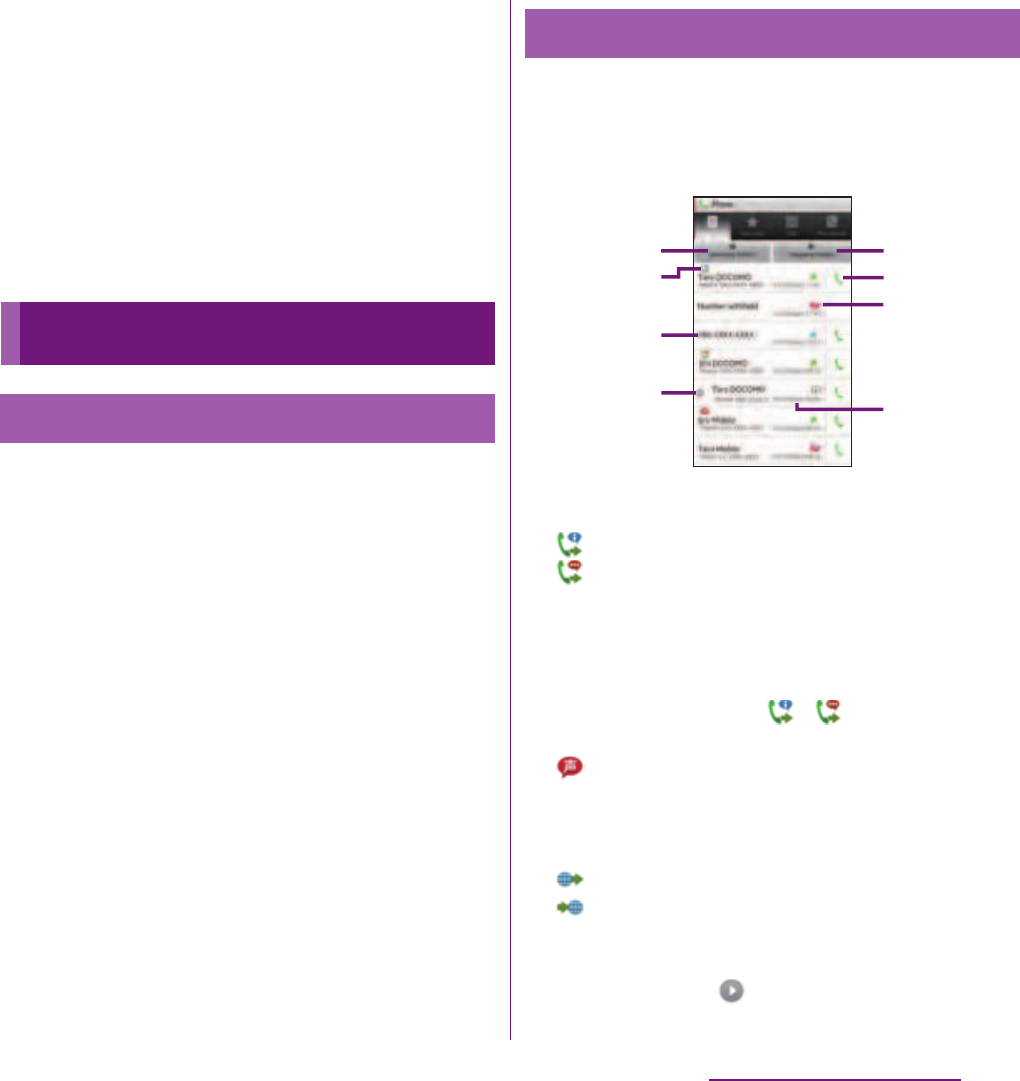
81
Calling/Network Services
❖
Information
・
During a call/on hold, tap
t
to display "Hold"/
"Retrieve call".
・
To set a call on hold, "Call waiting" subscription is
required. (P.101)
❖
Note
・
Do not bring the terminal close to your ear with the
speakerphone on to avoid from hearing damage.
1
From the Home screen, tap
[Phone]
u
[Recent calls].
・
The Recent calls screen appears.
On the Recent calls screen, incoming call
history and outgoing call history are
displayed in chronological order.
a
Incoming history
b
Call status icons
: Caller ID notified
: Caller ID hidden
・
Notified if calls are made with "186" (Notify)/"184"
(Hide) prefixed to the number.
・
If entering phone number and tap
t
, then
select [Caller ID notification]
u
[Notify]/[Not
notify] to make a call, / does not appear in
the call log list.
: Koe-no-Takuhaibin
・
For details on Koe-no-Takuhaibin, refer to "
声の宅
配便
(Koe-no-Takuhaibin)" (P.105) or NTT
DOCOMO website.
: Outgoing international call
: Incoming international call
c
Phone number/name
d
Consecutive calls with the same party
・
Tap a history or to display combined history,
tap again to display individually.
Call history
Showing call history
Recent calls screen
a
b
c
e
g
h
d
f

82
Calling/Network Services
・
Number in bracket indicates number of
combined history.
e
Outgoing history
f
Outgoing
g
History icons
: Missed call
: Incoming call
: Outgoing call
h
Date
❖
Information
・
On the Recent calls screen, tap
t
and tap [Search
location] to check the current location of the party
using imadocokantan search.
When you have missed calls, appears in
the status bar.
1
Drag the status bar downwards.
2
Tap [Missed call].
❖
Information
・
When you have missed calls, a missed call icon
appears on the key lock screen. For details on the
setting to show/hide icons, see "Setting information
displayed on the key unlock screen" (P.123).
1
On the Recent calls screen (P.85),
tap .
1
On the Recent calls screen (P.85),
touch and hold a phone number
and then tap [Add to phonebook].
・
You can also select by tapping the
number and then [Add to phonebook]
at the bottom of the screen.
2
Tap desired phonebook entry, or
tap [Register new].
・
Tap [Register new] to display a screen
for selection of the saving locations
appears. You can select Phone contacts
or docomo as the saving location.
3
Edit the phonebook entry and tap
[Save].
1
On the Recent calls screen (P.85),
tap [Incoming history]/[Outgoing
history].
2
On the incoming history list
screen/outgoing history list
screen, tap
t
and tap [Delete
all]
u
[OK].
Displaying missed calls
Making a call from call history
Adding a number from the call
history to Phonebook
Deleting a call history

83
Calling/Network Services
❖
Information
・
On the Recent calls screen, touch and hold a log you
want to delete, tap [Remove from call log]
u
[OK] to
delete an item.
In the Phonebook, you can enter various
information for contacts, for example, phone
numbers, mail addresses and web service
accounts. You can display phonebook entry
to get quick access to that contact.
1
From the Home screen, tap ,
then tap [Phonebook].
・
The phonebook list screen appears.
・
Alternatively, from the Home screen,
tap [Phone] and tap [Phonebook] tab to
display phonebook list screen.
❖
Information
・
To activate Xperia
™
phone application, from the
Home screen, tap , then tap [Contacts].
On the phonebok list screen, you can view
details of your contacts. You can add a
picture to a phonebook entry, and display
phonebook entries by group.
a
Phonebook tab
b
Entry items
・
Icons indicate entry items.
c
Name registered in the phonebook entry
d
Photo set in the phonebook entry
e
Group
・
Select a group to be displayed.
f
Communication tab
・
History of communication exchanged by calls
and mails is shown.
g
My profile tab
h
Index character area
・
Tap the right end of the phonebook list screen to
display index character with which you can
search a name in Japanese syllabary and
alphabetic order.
i
Register
j
Search
Phonebook
Opening Phonebook
Phonebook list screen
i
a
f
j
b
c
d
e
g
h

84
Calling/Network Services
Adding a new phonebook entry
1
On the phonebook list screen
(P.87), tap [Register].
2
Tap [Phone contacts]/[docomo].
・
When you set Google account etc., set
account appears as a saving location.
3
Enter a name.
4
Select or enter desired additional
information for the contact.
・
You can add items besides ringtone,
phone number and mail address by
tapping in "Others", then tap [Add]
to add items.
5
Tap [Save].
❖
Information
・
When you save "Phonetic name (family/given)",
phonebook list is displayed according to Japanese
syllabary order or alphabets order of "Phonetic
name".
Using shortcuts of Phonebook
When you tap the photo (image) part on the
phonebook list screen, shortcuts for phone,
mail, etc. appear. Tap the shortcut to make a
call, or create and send a mail.
* You can also use the registered addresses, etc.
❖
Information
・
When you tap a part other than photo (image) on
the phonebook list screen, profile screen of the
phonebook appears instead of shortcuts.
・
Email shortcut appears when email address is saved
in the selected phonebook entry and you have set
your email account. If you have not set your email
account, shortcut for Gmail ( ) appears.
・
For a phonebook entry with only name, tapping
photo (image) does not display the shortcut.
Searching for a phonebook entry
1
On the phonebook list screen
(P.87), tap [Search].
2
Enter name or reading you want to
search in the search field.
・
All phonebook entries beginning with
those letters appear.
Managing phonebook
Make a call to saved phone number.
Create and send message (SMS).
Select Email application to create and send an
email.
・
If [Use by default for this action.] checkbox is
marked, application selection screen will not
appear for the next time.

85
Calling/Network Services
Changing display conditions for
phonebook entries
You can set registered phonebook entries to
be displayed in the phonebook list.
1
On the phonebook list screen
(P.87), tap
t
, then tap
[Others]
u
[Display settings].
■
Setting display condition
Mark [Only contacts with phones].
・
Only phonebook entries with phone
numbers registered are displayed.
■
Setting show/hide
Tap a Social Networking Service (SNS)
name which is made phonebook entry
saving location setting or account setting
(P.133)
u
Mark/Unmark [Other
phonebook], [All phonebook].
・
Mark to display synchronized
phonebook entries, or unmark not to
display them.
2
Tap [Done].
Editing a phonebook entry
1
On the phonebook list screen
(P.87), tap a phonebook entry to
edit.
・
The profile screen of the phonebook
appears.
2
Tap [Edit].
・
By tapping [Add] on the profile editing
screen, you can add information to
enter.
3
Edit the desired information and
tap [Save].
❖
Information
・
Alternatively, touch and hold a phonebook entry in
the phonebook list and tap [Edit] to display profile
editing screen.
Combining phonebook entries
You can bind multiple phonebook entries
together into one.
1
On the phonebook list screen
(P.87), tap a phonebook entry to
combine.
・
The profile screen of the phonebook
appears.
2
Tap
t
and [Join/Separate].
・
Phonebook entries to be combined are
displayed.
3
Tap the phonebook entry to
combine.
❖
Information
・
To cancel binding, on the profile screen of the
phonebook, tap
t
, then tap [Join/
Separate]
u
[Separate].

86
Calling/Network Services
Deleting a phonebook entry
1
On the phonebook list screen
(P.87), tap
t
, then tap [Delete].
2
Mark the phonebook entry you
want to delete.
・
If you want to delete all phonebook
entries, tap [Select all].
3
Tap [Delete]
u
[OK].
❖
Information
・
Alternatively, on the phonebook list screen, touch
and hold a phonebook entry you want to delete, tap
[Delete]
u
[OK] to delete.
Making a call using the phonebook
1
On the phonebook list screen
(P.87), tap a phonebook entry to
call.
・
The profile screen of the phonebook
appears.
2
Tap a desired phone number.
3
Tap [Call].
❖
Information
・
Alternatively, touch and hold a phonebook entry in
the phonebook list and tap [Phone] to make a call.
Checking My profile and editing
information
1
On the phonebook list screen
(P.87), tap [My profile].
2
Tap [Edit].
・
Profile editing screen appears.
3
Enter the new information or make
the changes you want.
・
By tapping [Add] on the profile editing
screen, you can add information to
enter.
・
Tap in "Others", then tap [Add] to
add information.
4
When you are done, tap [Save].
❖
Information
・
You can register multiple phone numbers, mail
addresses, etc. in "My profile". Registered phone
number and logs of calls and mails between you and
registered phone numbers can be displayed in the
"Communication" tab.

87
Calling/Network Services
Sending phonebook via infrared
communication/Bluetooth/Email/
Gmail
Registered phonebook and My profile
information can be sent using infrared
communication (P.163), Bluetooth function
(P.166), or email attachment function.
■
Sending phonebook
1
Tap a phonebook entry you want
to send on the phonebook list
screen (P.87).
・
The profile screen of the phonebook
appears.
2
Tap
t
and [Share].
3
Select sending method and follow
the onscreen instructions.
■
Sending My profile
1
Tap [My profile] on the phonebook
list screen (P.87).
2
Tap
t
and [Share].
3
Select sending method and follow
the onscreen instructions.
❖
Information
・
If you use Bluetooth function, tap [Turn on] to turn
on the Bluetooth function, search receiver's
Bluetooth device and send.
・
If you want to send data as files attached to email/
Gmail, send from the compose screen for the mail
service in which you have set an account. When you
have not set a Gmail account, setup wizard appears.
You can create and send email after settings are
done.
・
Messaging is not available.
・
You cannot send some information such as name
card data set in phonebook.
・
For sending all phonebook entries, see "Sharing
phonebook entry currently displayed" (P.94).
Registering a phonebook entry to
Favorites
You can mark a phonebook entry as a
favorite. The favorite list provides quick
access to the phonebook entry you have
marked.
1
On the phonebook list screen
(P.87), tap a phonebook entry you
want to mark.
・
The profile screen of the phonebook
appears.
2
Tap .
❖
Information
・
Only phonebook entries saved to the docomo
account can be added to Favorites.
・
To display phonebook entries added to Favorites, tap
[Groups] on the phonebook list screen
u
[Favorites]
or from the Home screen, tap [Phone]
u
[Favorites]
tab.

88
Calling/Network Services
・
From the Home screen, tap [Phone]
u
[Favorites] to
display the phonebook data registered in Favorites
and "Commonly used phonebook data". Touch and
hold the phonebook data registered in Favorites or
Commonly used phonebook data to select "Remove
from favorites"/"Add to favorites".
Setting photo in a phonebook entry
1
On the phonebook list screen
(P.87), tap a phonebook entry you
want to add a picture.
・
The profile screen of the phonebook
appears.
2
Tap [Edit].
3
Tap [Settings] for image.
4
Tap [Add image]/[Take photo].
・
If you select [Add image], select a saved
photo and tap [Save].
・
Select [Take photo] to shoot a photo
and save it.
5
Tap [OK].
6
Tap [Save].
❖
Information
・
You can also set photo to a phonebook entry by the
following operation.
From the Home screen, tap
u
[Gallery]. View an
image you want to set and tap
t
, [Set
as]
u
[Phonebook icon]/[Contact picture]. Select a
phonebook entry to register to and tap [Save].
You can export/import phonebook entries
from/to microSD card or UIM. This is useful,
for example, when you want to transfer the
contact information to another phone.
❖
Information
・
You can also use a synchronization service for
synchronizing your phonebook. For details, refer to
"Data synchronization" (P.134).
Exporting phonebook to microSD
card
1
On the phonebook list screen
(P.87), tap
t
, then tap
[Others]
u
[Import/Export].
2
Tap [Export to SD card].
3
Select a phonebook you want to
export.
・
Tap to select any of [Export one
phonebook data]/[Export multiple
phonebook data]/[Export all
phonebook data], then tap [OK].
・
If you select [Export one phonebook
data]/[Export multiple phonebook
data] and tap [OK], select phonebook
entries to export then tap [OK].
Exporting/Importing
phonebook entries

89
Calling/Network Services
4
Select [Yes]/[No] to attach name
card.
5
Tap [OK].
Importing phonebook from microSD
card
1
On the phonebook list screen
(P.87), tap
t
, then tap
[Others]
u
[Import/Export].
2
Tap [Import from SD card].
3
Tap [Phone contacts]/[docomo].
・
When you set Google account etc., it
appears as an import destination.
4
Select vCard file you want to
import.
・
If there is only one file, vCard file
selection screen does not appear. The
file is imported immediately.
・
If a file has multiple phonebook entries,
they are imported all at once.
・
If there are two or more vCard files, tap
any of [Import one phonebook data]/
[Import multiple phonebook data]/
[Import all phonebook data] to select.
5
Tap [OK].
・
If you select [Import one phonebook
data]/[Import multiple phonebook
data] and tap [OK], select vCard files to
import then tap [OK].
❖
Information
・
For some phonebook entries, a part of data may not
be imported or exported.
Importing phonebook entries from
UIM
1
On the phonebook list screen
(P.87), tap
t
, then tap
[Others]
u
[Import/Export].
2
Tap [Import from SIM card].
3
Tap [Phone contacts]/[docomo].
・
When you set Google account etc., it
appears as an import destination.
4
To import one contact, tap the
contact you want to import.
・
To import all contacts, tap [Import all].
・
If there is a phonebook entry whose
name is matched with the imported
entry, the entry is imported as a
separated one.
❖
Information
・
Names and phone numbers can be imported.

90
Calling/Network Services
・
Alternatively, on the phonebook list screen, tap [My
profile] tab, then tap
t
and [General
settings]
u
[Data management]
u
[Import]
u
[Import
from SIM card] to import contacts from the UIM.
・
To export phonebook entries to UIM, use Xperia
™
phonebook application. Note that only name and
the first phone number can be saved because of
memory space of UIM. For some phonebook entries,
a part of data may not be exported.
Sharing phonebook entry currently
displayed
1
On the phonebook list screen
(P.87), tap
t
, then tap
[Others]
u
[Import/Export].
2
Tap [Share phonebook data].
3
Select sending method and follow
the onscreen instructions.
・
If [Use by default for this action.]
checkbox is marked, application
selection screen will not appear for the
next time.
❖
Information
・
If display conditions for phonebook (P.89) are set,
only phonebook entries to be displayed are
exported.
・
If you use Bluetooth function, tap [Turn on] to turn
on the Bluetooth function, search receiver's
Bluetooth device and send.
・
If you want to send data as files attached to email/
Gmail, send from the compose screen for the mail
service in which you have set an account. When you
have not set a Gmail account, setup wizard appears.
You can create and send email after settings are
done.
・
Messaging is not available.
・
When sending two or more phonebook entries via
infrared communication, you need to enter a
passcode to authenticate. Passcode is a 4-digit
number fixed up between you and other parties in
advance.
・
You cannot send some information such as name
card data set in phonebook.
Phonebook data can be copied to another
terminal using microSD card. You can also
copy the Contacts data registered in Google
account to docomo account.
1
From the Home screen, tap ,
then tap [PhoneBookCopy].
・
When you use for the first time, agree to
"
使用許諾契約書
(License Agreement)".
Using PhoneBookCopy

91
Calling/Network Services
Importing phonebook from microSD
card
1
Attach the microSD card with
phonebook entries saved to the
terminal.
2
On the "
インポート
(Import)" tab
screen, tap a file you want to
import.
3
Tap [
上書き
(Overwrite)]/[
追加
(Add)].
・
Imported phonebook data is saved in
docomo account.
Exporting phonebook to microSD
card
1
Attach the microSD card to the
terminal.
2
On the "
エクスポート
(Export)" tab
screen, tap [
開始
(Start)].
・
The Phonebook data saved in docomo
account is saved onto the microSD
card.
Copying contacts registered in
Google account to docomo account
1
On the "docomo
アカウントへコピー
(Copy to account)" tab screen, tap
a Google account you want to
copy.
2
Tap [
上書き
(Overwrite)]/[
追加
(Add)].
・
Copied phonebook data is saved in
docomo account.
・
You can also copy the phonebook data
saved in "Phone contact" to docomo
account as well as Google account.
❖
Information
・
If phonebook item names (e.g. Phone number, etc.)
of the other terminal are different from ones of your
terminal, the item names may be changed or
deleted. Also, some text may be deleted in copied
destination, because savable characters in a
phonebook entry vary by terminal.
・
When importing phonebook entries from microSD
card, files created by "all backup" cannot be loaded.
・
When exporting phonebook entries to microSD card,
data without Name cannot be copied.
・
If you use phonebook entries created (exported) by
PhoneBookCopy in other than PhoneBookCopy, they
may not be displayed correctly.
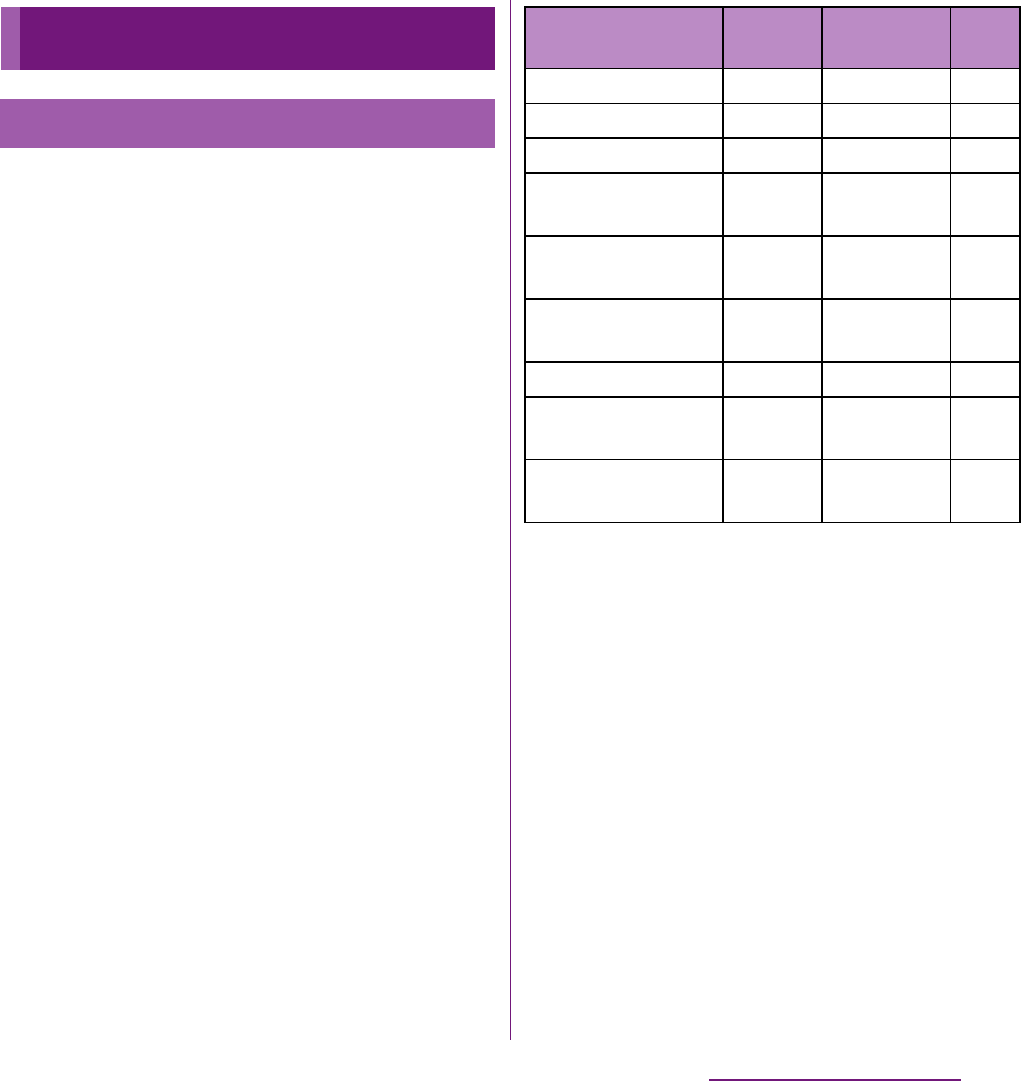
92
Calling/Network Services
You can use the following DOCOMO network
services on the terminal. For details on the
outline and how to use each service, see the
relevant pages indicated in the following
table.
・
You cannot use the network services when
you are outside of the service area or in a
location without the radio wave.
・
"Stop of service" does not mean canceling the
subscription such as Voice Mail service, Call
Forwarding Service, etc.
・
For details, see the "Mobile Phone User's
Guide [Network Services]".
・
For subscription and inquiry, contact "General
Inquiries" on the last page of this manual.
・
Besides, you can use International roaming
setting (P.240).
❖
Information
・
In this manual, the outlines of each network service
are described with menu operations.
Network Services
Available Network Services
Service name Monthly
charge Application Page
Voice Mail service
Paid Required P.97
Call forwarding
Free Required P.99
Call Waiting
Paid Required P.101
Caller ID
Notification
Free Not required P.102
Nuisance Call
Blocking service
Free Not required P.103
Caller ID Display
Request Service
Free Not required P.103
Second call settings
Free Not required P.104
Remote operation
settings
Free Not required P.104
声の宅配便
(Koe-no-
Takuhaibin)
Free Not required P.105

93
Calling/Network Services
The Voice Mail Service takes messages for
you, as long as it answers a call with the
answering message, if there is an incoming
call when you are in a location without the
radio wave, while the terminal is powered off,
or when you cannot answer a call within the
preset ring time.
・
When the Voice Mail service is set to "Activate"
and if you do not answer an incoming voice
call, the call is saved in "Recent calls" as a
"Missed call" and (Missed call) appears in
the status bar.
❖
Information
・
This terminal does not have Record message
function which records voice messages on internal
memory. Use the Voice Mail Service.
・
The message can be recorded up to 3 minutes for 1
message, up to 20 messages, and stored up to 72
hours.
・
The number of Voice Mail messages appears until
you have played all messages.
Basic flow of the Voice Mail Service
Voice Mail service
Your terminal receives a call
If you do not answer the call, it is
connected to the Voice Mail service center
The caller leaves a message
The receiver is notied that the Voice Mail
service center has taken the voice message
Play the voice message
▼
Activate the Voice Mail Service
▼
▼
▼
▼
If you are in a hurry and wish to leave a
message without listening to the Voice Mail
answering message, you can interrupt the
answering message and switch to message
recording mode immediately by tapping
[Dialpad]→[#]
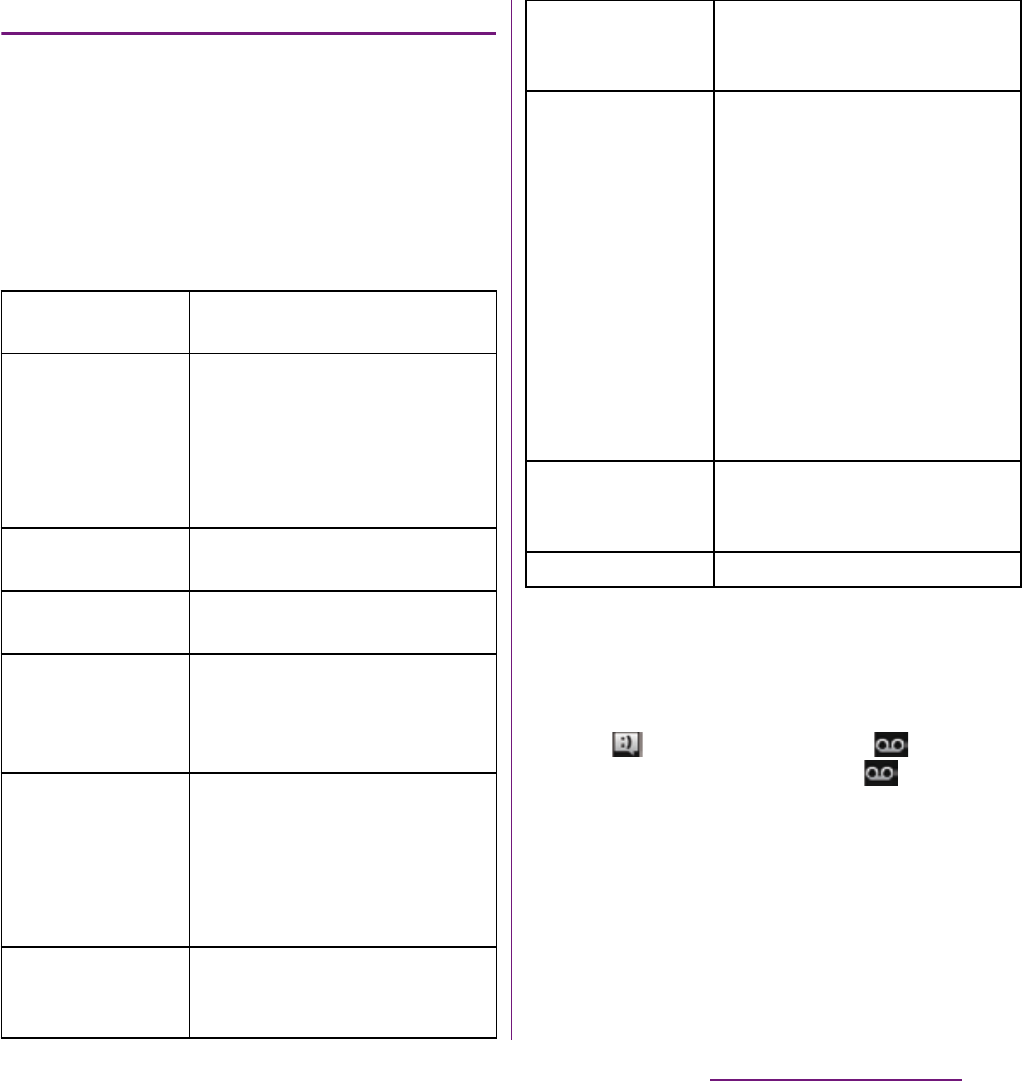
94
Calling/Network Services
Setting Voice Mail Service
1
From the Home screen, tap
t
and tap [Settings].
2
Tap [Call settings]
u
[Network
service setting].
3
Tap [Voicemail].
・
Select items you want to use.
* After operation is finished, you receive the "NTT
DoCoMo VM:XX" SMS.
❖
Information
・
If messages are stored at the Voice Mail service
center, (New SMS message) and (Voice Mail
message) appear on the status bar. (Voice Mail
message) disappears when you delete all messages.
・
The notification setting and notifications (message
(SMS) reception) are not charged.
Activate Voicemail
Tap [OK] to activate the Voice
Mail Service.
Set ring time
Enter the ring time (0 to 120
seconds).
It changes only the ring time.
If the ring time is set to 0
seconds, an incoming call is not
saved in "Recent calls".
Deactivate
Voicemail
Tap [OK] to deactivate the Voice
Mail Service.
Check Voicemail
setting
Check the current service
settings.
Play messages
*
Tap [OK] to call the Voice Mail
service center. After this step,
follow the voice prompts to play
the message.
Voicemail setting
*
Tap [OK] to change the Voice
Mail setting with the voice
prompts. The call is connected to
the Voice Mail service center.
After this step, follow the voice
prompts to operate.
Check messages
*
Check if a new message is stored.
After checking, the completion
message appears.
Notification
settings
Set whether to alert you of a new
message with the tone or
vibration.
Activate Missed
Call Notif.
When it is received while the
terminal is powered off or
outside of the service area, an
SMS is sent to notify you of the
information about the call (date,
time and the caller ID) once you
turn the terminal back on or
move back in to the service area.
Select [All Calls] to notify you of
all received calls.
Select [Calls with Caller ID] to
notify you of only the calls with
the caller ID.
Deactiv. Missed
Call Notif.
While starting the notification,
tap [OK] to deactivate the
notification.
Check setting
Check the notification settings.

95
Calling/Network Services
Playing the voice message
1
When the SMS notification "NTT
DoCoMo VM:XX" appears, tap
[New message] from the
Notification panel (P.43).
・
A recorded message plays.
2
Follow the voice prompts to
operate.
The Call Forwarding Service forwards a voice
call to a preset forwarding number when you
are in a location without the radio wave, the
terminal is powered off, or you do not answer
the call within the preset ring time.
・
When the Call Forwarding Service is set to
"Activate Call Forwarding" and if you do not
answer an incoming voice call, the call is
saved in "Recent calls" as a "Missed call" and
(Missed call) appears in the status bar.
Basic flow of the Call Forwarding
Service
Call charge for the Call Forwarding
Service
Call forwarding
▼
▼
▼
Save the forwarding number
Activate the Call Forwarding Service
Your terminal receives a call
If you do not answer the call, it is
automatically forwarded to the specied
forwarding number
Call Forwarding Service subscriber
Caller
Forwarding party
The caller is charged for a call fee
The Call Forwarding Service
subscriber is charged for a call fee
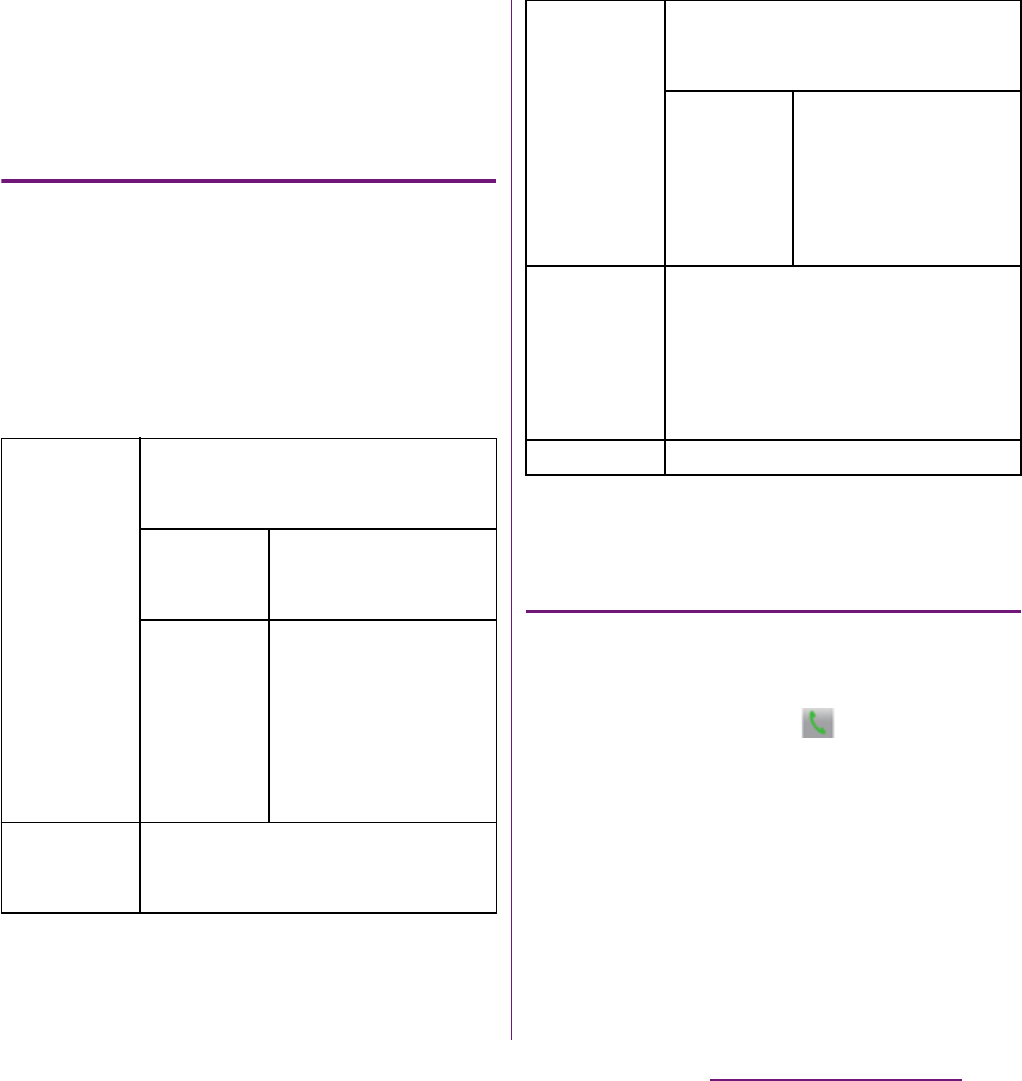
96
Calling/Network Services
❖
Information
・
Even when the Call Forwarding Service is set to
"Activate Call Forwarding", you can answer the call
during a ringtone sounds.
Setting Call Forwarding Service
1
From the Home screen, tap
t
and tap [Settings].
2
Tap [Call settings]
u
[Network
service setting].
3
Tap [Call Forwarding].
・
Select items you want to use.
* A subscription of Voice Mail service is required.
Setting on/off of the Call Forwarding
guidance
1
From the Home screen, tap
[Phone]
u
[Dial].
2
Tap [1][4][2][9]
u
.
・
Follow the voice prompts to operate.
For details, see the "Mobile Phone
User's Guide [Network Services]".
Activate Call
Forwarding
Enter the forwarding phone number
and ring time, then tap [OK] to
activate the Call Forwarding Service.
Change
forwarding
number
Mark the checkbox and
enter the forwarding
number.
Register
ring time
Mark the checkbox and
enter the ring time (0 to
120 seconds).
If the ring time is set to
0 seconds, an incoming
call is not saved in
"Recent calls".
Deactivate
Call
Forwarding
Tap [OK] to deactivate the Call
Forwarding Service.
Register
number
Change the forwarding phone
number. Enter the forwarding phone
number and tap [OK].
Activate Call
Forwarding
Mark the checkbox to
change the forwarding
phone number and to
activate the Call
Forwarding Service
simultaneously.
If fwd
number
busy
*
When the forwarding number is busy,
an incoming call is connected to the
Voice Mail service center. Tap
[Connect] to turn on the setting; tap
[Do not connect] to turn off the
setting.
Check setting
Check the current service settings.

97
Calling/Network Services
When there is another incoming call while
you are on a call, the in-call ringtone notifies
you of the second call. You can answer the
second call by putting the first call on hold.
You can also put your current call on hold
and place a call to another party.
❖
Information
・
Even when the call is on hold, the caller is charged for
a call fee.
Setting Call Waiting
1
From the Home screen, tap
t
and tap [Settings].
2
Tap [Call settings]
u
[Network
service setting].
3
Tap [Call Waiting].
・
Select items you want to use.
Putting the current call on hold and
answering an incoming call
1
When you hear the beep during a
call, tap [Answer].
・
The first call is put automatically on
hold and the incoming call is received.
- The terminal does not support
Conference call.
- Tap [Busy] to connect the incoming
call to the Voice Mail service center.
Activating Voice Mail service is
required beforehand.
2
Switch to the first call.
・
To end the later call, tap [End call].
The later call is terminated and switched
to the first call.
・
To put the later call on hold, tap [Switch
to this call].
The later call is put on hold and
switched to the first call. Tapping
[Switch to this call] switches the party.
Ending the current call and
answering an incoming call
1
When you hear the beep during a
call, tap [End current call and
answer].
・
The first call is terminated and the
incoming call is received.
Call Waiting
Activate Call
Waiting
Tap [OK] to activate the Call
Waiting Service.
Deactivate Call
Waiting
Tap [OK] to deactivate the Call
Waiting Service.
Check settings
Check the current service
settings.

98
Calling/Network Services
Putting the current call on hold and
making a call to another party
1
During a call, tap (Phonebook)/
(Dialpad).
2
Enter the other party's phone
number, then tap .
・
The first call is automatically on hold
and switched to the new call you made.
You can also search for a party by
tapping (Phonebook).
3
Switch to the first call.
・
To terminate the new call, tap [End call].
The new call is terminated and switched
to the first call.
・
To put the new call on hold, tap [Switch
to this call].
The new call is put on hold and
switched to the first call. Tapping
[Switch to this call] switches the party.
When making a call, your phone number can
be shown in the display of the recipient's
phone you are calling. The caller ID is
important personal information. Carefully
decide whether you notify a recipient of your
caller ID.
・
You cannot set the Caller ID notification
where the terminal indicates the outside of
service area ( ).
・
The setting is available only the other party's
phone can display the caller ID.
・
If an announcement requesting caller ID is
heard when making a call, set Caller ID
notification or add prefix 186 to the phone
number to call again.
1
From the Home screen, tap
t
and tap [Settings].
2
Tap [Call settings]
u
[Network
service setting].
3
Tap [Caller ID Notification].
・
Select items you want to use.
Caller ID Notification
Activate Caller
ID Notification
Enter the Network security code,
then tap [OK].
Your phone number is notified to
the other party.
Deactivate
Caller ID
Notification
Enter the Network security code,
then tap [OK].
The caller ID notification is
deactivated.
Check settings
Check the current settings.
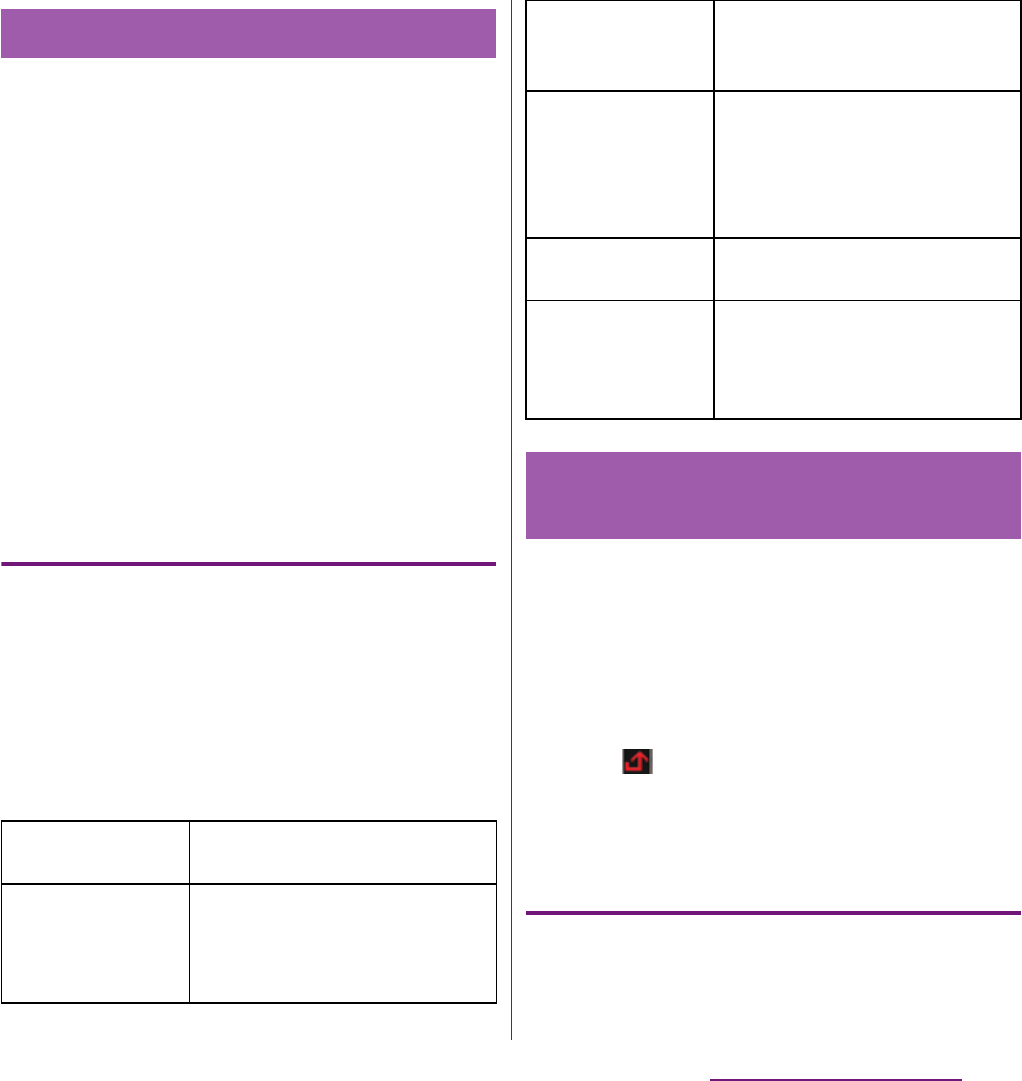
99
Calling/Network Services
You can register "crank call" such as prank call
not to be received. When call rejection is
registered, follow-on incoming calls are
automatically rejected. Guidance responds to
the caller.
And, you can register, check, delete phone
numbers to be rejected connecting Nuisance
Call Blocking service setting site.
・
Even if there is an incoming call from the
phone number with rejection registered,
ringtone does not sound. And the call is not
recorded in the call log.
Setting Nuisance Call Blocking
service
1
From the Home screen, tap
t
and tap [Settings].
2
Tap [Call settings]
u
[Network
service setting].
3
Tap [Nuisance call blocking].
・
Select items you want to use.
Request number notification for calls without
phone number with guidance. Calls can be
ended automatically after guidance.
・
When a call is not received because of the
Caller ID Display Request Service, the call is
not recorded in "Recent calls" as "incoming
call" or (Missed call) does not appear on
the status bar.
Setting Caller ID Display Request
Service
1
From the Home screen, tap
t
and tap [Settings].
Nuisance Call Blocking service
Caller ID reject
registration
Tap [OK] to register the last
answered call to be rejected.
Specified caller ID
reject
Enter a phone number you want
to reject and tap [OK]
u
[OK] to
reject incoming calls from the
specified phone number.
Delete all
registered caller ID
Tap [OK] to delete phone
numbers with rejection
registered.
Delete latest
registered number
Tap [OK] to delete the last
registered phone number. By
repeating the same operation,
you can delete registrations one
by one from the last.
Check the number
of registration
Check number of registrations.
Advanced settings
Connect Nuisance Call Blocking
service setting site to make
advanced settings. To sign in, a
network security code is needed.
Caller ID Display Request
Service

100
Calling/Network Services
2
Tap [Call settings]
u
[Network
service setting].
3
Tap [Caller ID request service].
・
Select items you want to use.
Set how to respond incoming call and 64K
data communication during a call for the
customers subscribed Voice Mail Service, Call
forwarding Service and Call Waiting Service.
・
If you do not subscribe Voice Mail Service, Call
forwarding Service and Call Waiting Service,
an incoming call during a call cannot be
responded.
・
To use Second call settings, set Second call
settings to "Activate". When Call Waiting is set
to "Activate", you do not need to set Second
call settings to "Activate Second call settings".
Setting Second call settings
1
From the Home screen, tap
t
and tap [Settings].
2
Tap [Call settings]
u
[Network
service setting].
3
Tap [Second call settings].
・
Select items you want to use.
Set to operate Voice Mail Service or Call
forwarding Service using push system land-
line phone, public phone or DOCOMO
mobile phone, etc.
Setting remote operation
1
From the Home screen, tap
t
and tap [Settings].
2
Tap [Call settings]
u
[Network
service setting].
3
Tap [Remote operation
settings]
u
[OK].
・
Call "159" and follow the voice prompts
to operate.
Activate caller ID
request
Tap [OK] to activate Caller ID
Display Request Service.
Deactivate caller
ID request
Tap [OK] to deactivate Caller ID
Display Request Service.
Check settings
Check the current service
settings.
Second call settings
Activate second
call settings
Tap [OK] to activate the Second
call settings.
Deactivate second
call settings
Tap [OK] to deactivate the
Second call settings.
Check settings
Check the current service
settings.
Remote operation settings

101
Calling/Network Services
Koe-no-Takuhaibin is a service of taking voice
messages for you.
・
The message can be recorded up to 15
minutes for 1 message, up to 500 messages,
and stored for 720 hours. And up to 5
messages can be protected. (Unprotected
messages will be erased after 720 hours
automatically.)
・
It is unavailable from overseas.
・
Koe-no-Takuhaibin is a service requiring no
subscription/monthly charge. But for
recording and playing a message, a call
charge is applied.
・
For details, refer to NTT DOCOMO website.
Basic flow of Koe-no-Takuhaibin
*1 When a caller presses a specified button or
ends a call after recording a message, a
record notification message (SMS) is sent to
the recipient.
*2 When a recipient plays the message, a play
notification message (SMS) is sent to the
caller. Even if a recipient plays a message
several times, a play notification message
(SMS) is sent only when the recipient plays
the message for the first time. If you do not
want to notify a message played to a caller,
stop play notification function. By default,
play notification function is on.
声の宅配便
(Koe-no-Takuhaibin)
Specify the other party and make a call
with Koe-no-Takuhaibin
The other party plays the message
Receive a message (SMS) *2 notifying the
message played
Follow the voice prompts to record a message
Message (SMS)*1 is sent to the other party
to notify your message recorded
▼
▼
▼
▼
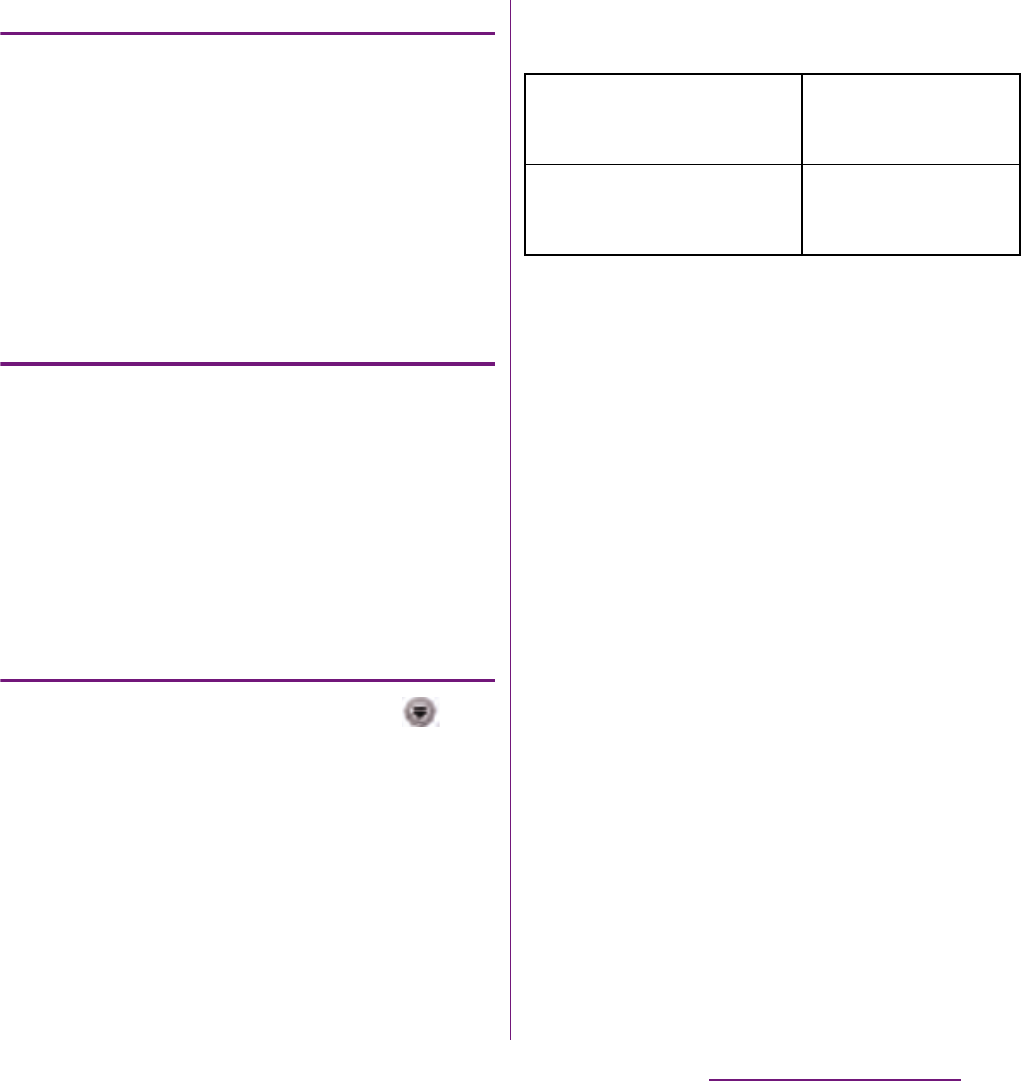
102
Calling/Network Services
Recording a message
You can record a message by making a call
with Koe-no-Takuhaibin.
1
From the Home screen, tap
[Phone]
u
[Dial] tab.
2
Enter a phone number and tap
[Koe-no-Takuhaibin].
・
Operate the following voice prompts.
Playing the voice message
Play a recorded message in Koe-no-
Takuhaibin. Follow the voice prompts to
operate. You can delete or protect a message
after playing.
1
Call a phone number displayed in a
record notification message (SMS).
・
Operate the following voice prompts.
Setting Koe-no-Takuhaibin
1
From the Home screen, tap ,
then [
声の宅配便
(Koe-no-
Takuhaibin)].
・
Activate Koe-no-Takuhaibin application.
2
Tap [
設定
(Setting)].
・
Select items you want to use.
設定確認・変更(サイト接続)
(Check/change settings
(connecting website))
Connect website to
check/change settings.
設定確認・変更(音声発信)
(Check/change settings
(voice prompt))
Make a call to check/
change settings.

103
Settings
Settings
1
From the Home screen, tap
t
.
2
Tap [Settings].
■
Setting menu
❖
Information
・
Alternatively, from the Home screen, tap , then
tap [Settings].
You can set passwords for applications
provided by docomo or to use the services
supporting AUTO-GPS.
Viewing the setting menu
docomo service
P.107
Xperia
™
P.108
Wireless & networks
P.109
Call settings
P.119
Sound
P.119
Display
P.122
Location & security
P.124
Applications
P.129
Accounts & sync
P.132
Privacy
P.135
Storage
P.136
Language & keyboard
P.138
Voice input & output
P.138
Accessibility
P.139
Date & time
P.139
About phone
P.140
docomo service
Application
manager
Set to check update for
applications regularly.
Wi-Fi
Set to use docomo service via
Wi-Fi.
docomo apps
password
Set a password for applications
provided by docomo.
AUTO-GPS
Set to use the services
supporting AUTO-GPS.
Open source
licenses
View open source licenses.
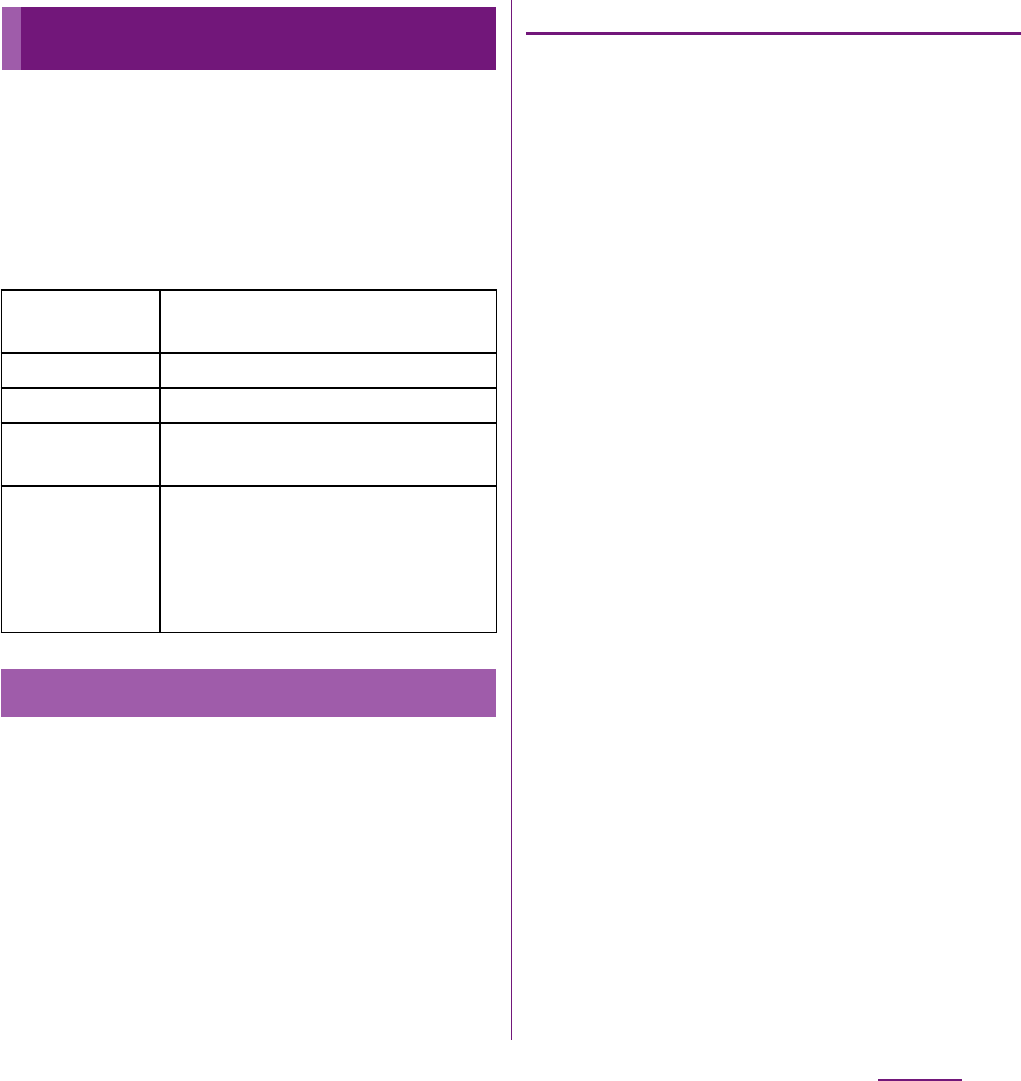
104
Settings
You can back up/restore data or files in the
terminal or set preferred applications. You
can also set synchronization function for
Facebook in the terminal, make settings for
USB connection or Wi-Fi connection to a PC
or other devices.
Back up contacts, call log, messages (SMS),
bookmarks in the terminal or photos and
videos shot by the terminal camera to
microSD card, and restore them when
needed. Mount a microSD card in advance.
❖
Information
・
Do not perform "Unmount SD card" during backup/
restore.
Backing up to microSD card
Back up contacts, call log, messages (SMS),
bookmarks in the terminal or photos and
videos shot by the camera of the terminal to
the microSD card.
1
From the Settings screen (P.107),
tap [Xperia
™
]
u
[Backup &
restore].
2
Tap [Back up].
■
Contacts/Call log/Message (SMS)/
Bookmark
Tap [Back up data now]
u
[OK].
・
Contacts, call log, messages (SMS) and
bookmark data are copied to the
microSD card.
・
You cannot back up phonebook
registered to docomo account (P.134),
Google account (P.132), etc.
■
Photos and videos taken with the
terminal
Tap [Back up media now]
u
[OK].
・
Photo and video files are copied to the
microSD card.
・
Check that the battery level is high
enough.
❖
Information
・
You cannot back up sp-mode mails, Gmails, photos
or videos downloaded from websites, etc.
Xperia
™
Backup &
restore
P.108
Battery life
View built-in battery performance.
Connectivity
P.158
Facebook
inside Xperia
™
P.133
Preferred apps
settings
Set applications used for the
terminal (Home, phonebook,
playing video or music) to "docomo"
or "Xperia
™
" collectively or
individually.
Backing up and Restoring
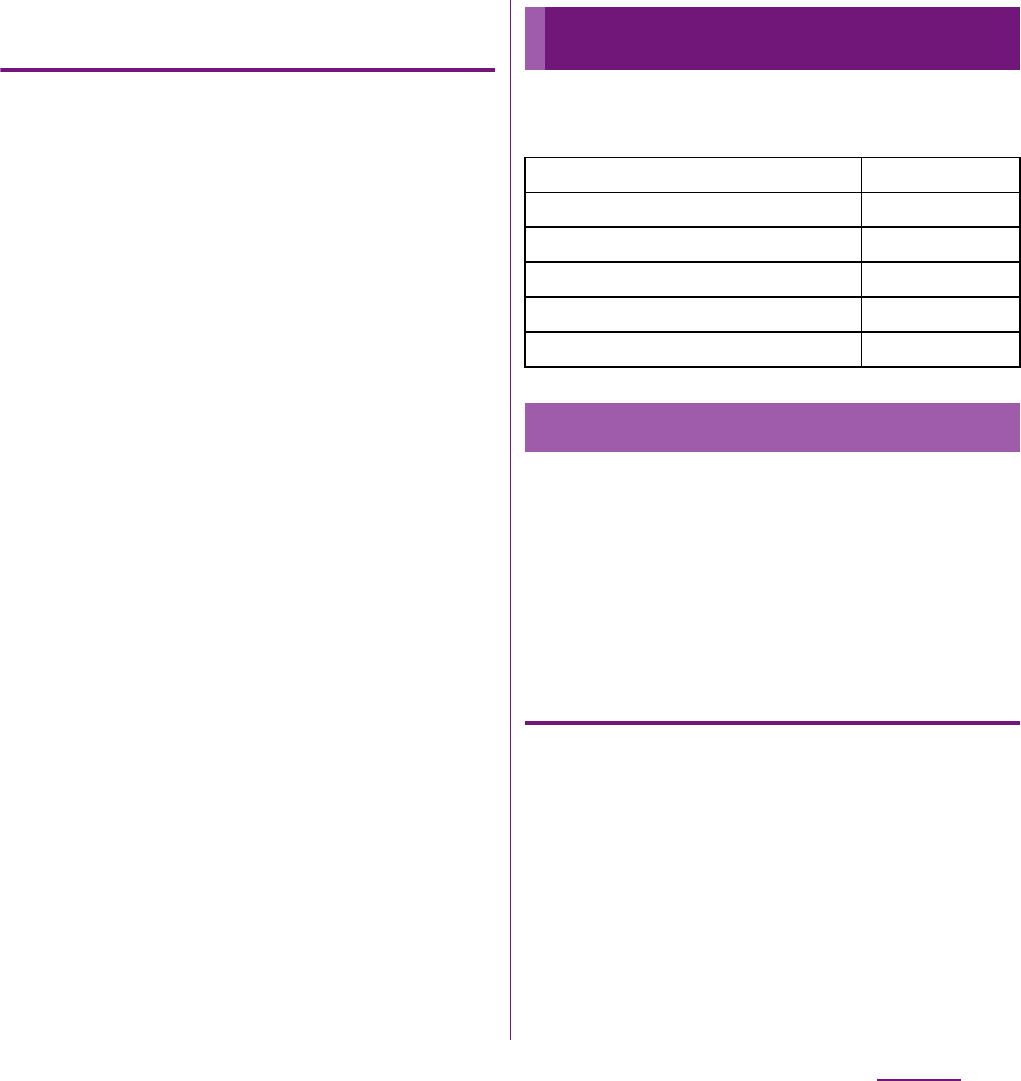
105
Settings
Restoring the back up file to the
terminal
You can restore data or files previously
backed up to the microSD card.
1
From the Settings screen (P.107),
tap [Xperia
™
]
u
[Backup &
restore].
2
Tap [Restore].
■
Contacts/Call log/Message (SMS)/
Bookmark
Tap [Restore data now]
u
[OK]
u
[OK].
・
The back up data in the microSD card is
restored to the terminal. If the restoring
data already exists in the terminal, the
back up data cannot be added.
■
Photos and videos taken with the
terminal
Tap [Restore media now]
u
[OK]
u
[OK].
・
Photo and video files are deleted and
backup file of photo and video in the
microSD card are restored.
・
Check that the battery level is high
enough.
❖
Information
・
Do not turn off the power for 5 minutes after
restoring contacts, call log, messages (SMS) and
bookmarks since the system operates in the
background.
You can make settings related to networks
such as Wi-Fi, Bluetooth function.
An access point for connecting to the
Internet (sp-mode, mopera U) is already
registered. You can add or change it if
necessary.
By default, sp-mode (P.110) is set for the usual
access point.
Checking the access point you use
1
From the Settings screen (P.107),
tap [Wireless &
networks]
u
[Mobile
networks]
u
[Access Point Names].
・
Available access points (APN) appear.
・
It is recommended that you use the
displayed access point without editing.
Wireless & networks
Airplane mode
P.111
Wi-Fi/Wi-Fi settings
P.112
Bluetooth/Bluetooth settings
P.166
Tethering
P.116
VPN settings
P.118
Mobile networks
P.109, P.238
Setting an access point

106
Settings
❖
Information
・
If you have several available connections, a marked
radio button to the right indicates the active network
connection.
Setting an access point additionally
1
From the Settings screen (P.107),
tap [Wireless &
networks]
u
[Mobile
networks]
u
[Access Point Names].
2
Tap
t
.
3
Tap [New APN].
4
Tap [Name], enter a name and tap
[OK].
5
Tap [APN] and enter the access
point name and tap [OK].
6
Tap and enter all other
information required by your
network operator.
7
Tap
t
and [Save].
❖
Information
・
Do not change the MCC/MNC. If you change MCC/
MNC to other than the default value (440/10), the
settings do not appear on the APNs screen. When
the MCC/MNC settings do not appear on the APNs
screen, make APN settings with [Reset to default] or
[New APN] again.
・
Note that, when using the prediction conversion by
one-byte alphabet entry mode (English mode) with
mark in [Auto space] checkbox on Japanese
keyboard settings screen (P.62), spaces may be
entered automatically. In this case, delete spaces.
By initializing an access point, the default
state is restored.
1
From the Settings screen (P.107),
tap [Wireless &
networks]
u
[Mobile
networks]
u
[Access Point Names].
2
Tap
t
and tap [Reset to
default].
sp-mode is ISP for NTT DOCOMO
smartphone. In addition to accessing
Internet, you can use the mail service using
the same address as imode mail
(@docomo.ne.jp), etc. sp-mode is a service
requiring subscription. For details on sp-
mode, refer to NTT DOCOMO website.
Initializing an access point
sp-mode

107
Settings
mopera U is ISP of NTT DOCOMO's Internet
connection. If you have subscribed to
mopera U, you can use Internet after making
the simple settings. mopera U is a service
requiring subscription.
Setting mopera U
1
From the Settings screen (P.107),
tap [Wireless &
networks]
u
[Mobile
networks]
u
[Access Point Names].
2
Mark [mopera U (
スマートフォン定
額
) (mopera U (Smartphone flat-
rate))]/[mopera U
設定
(mopera U
settings)] radio button.
・
Return to the Home screen and open
the Browser. You can enjoy the nice
Internet access.
❖
Information
・
"mopera U
設定
(mopera U settings)" is an access
point for setting mopera U. When you use the access
point for setting mopera U, packet communication
charges for setting do not apply. Note that you can
set only the initial setting screen or the change
setting screen. For details on mopera U settings, refer
to mopera U website.
・
Subscription to packet flat-rate service is required for
using "mopera U (
スマートフォン定額
) (mopera U
(Smartphone flat-rate))". For details on mopera U
(Smartphone flat-rate), refer to NTT DOCOMO
website.
In this mode, the functions of using radio
wave transmissions such as calling, accessing
to the Internet (including sending/receiving
mails), etc. are disabled. It is useful when you
want to operate the terminal with no
interruption of incoming calls or mails.
Turning on Airplane mode
1
From the Settings screen (P.107),
tap [Wireless & networks].
2
Mark [Airplane mode] checkbox.
・
When you unmark [Airplane mode]
checkbox, the Airplane mode turns off.
❖
Information
・
You can also switch on/off of the Airplane mode by
pressing and holding
p
for over a second to
switch to the Phone options menu, then tapping
[Airplane mode].
・
Even if Airplane mode is on, Wi-Fi and Bluetooth
function can be turned on.
mopera U
Airplane mode

108
Settings
Using the Wi-Fi function, you can connect to
an access point for your home, company
network or public wireless LAN services to
use mail and Internet.
・
Even when Wi-Fi is on, packet communication
is available. However, while you connect Wi-Fi
network, Wi-Fi comes first.
・
When a Wi-Fi network is disconnected,
connection is automatically switched to a 3G/
GPRS network. Note that packet
communication fee applies for using 3G/
GPRS network.
・
Turn the Wi-Fi function to off when you do
not use Wi-Fi to cut battery power
consumption.
Before using Wi-Fi
To use Wi-Fi, turn on Wi-Fi and search
available Wi-Fi network, then connect it.
・
To access the Internet using Wi-Fi, connect to
Wi-Fi network in advance.
❖
Information
・
Make sure to receive enough signal strength for
using Wi-Fi. The signal strength of the Wi-Fi network
varies by the location of the terminal. Moving closer
to the Wi-Fi router might enhance the signal
strength.
■
Reception interference caused by
Bluetooth devices
Bluetooth devices and wireless LAN
(IEEE802.11b/g/n) devices use the same
frequency band (2.4GHz). If you use
Bluetooth devices near a wireless LAN
device, reception interference may occur or
the communications speed may lower.
Also, you may hear noise or have a
connection problem. Communication may
be interrupted or sound may be lost while
streaming data, etc. In these cases, do the
following:
・
Keep the terminal and Bluetooth device
to be connected wirelessly 10 or more
meters away from a wireless LAN device.
・
Within 10 meters, turn off the Bluetooth
device to be connected.
1
From the Settings screen (P.107),
tap [Wireless & networks].
2
Mark [Wi-Fi] checkbox.
・
The terminal scans for available Wi-Fi
networks.
❖
Information
・
It may take a few seconds before the Wi-Fi
connection is on.
About Wi-Fi
Turning on Wi-Fi
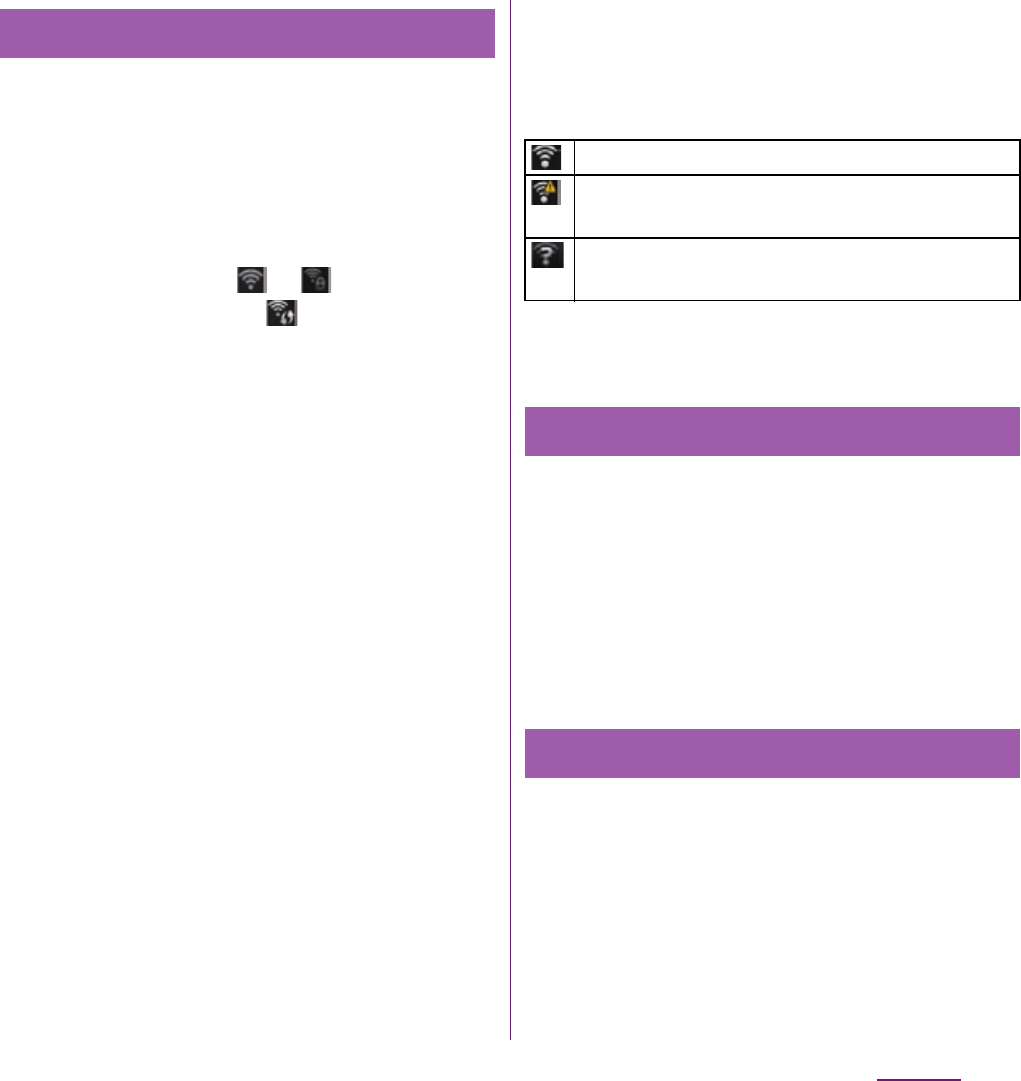
109
Settings
1
From the Settings screen (P.107),
tap [Wireless & networks]
u
[Wi-Fi
settings].
・
Available Wi-Fi networks are displayed
under "Wi-Fi networks". The available
networks may be open or secured. This
is indicated by or next to the Wi-
Fi network name. appears next to
the name of the Wi-Fi network that can
be connected with WPS functions.
2
Select Wi-Fi network you want to
connect, tap [Connect].
・
If you are trying to connect to a
protected Wi-Fi network, you are asked
to enter the security key for that Wi-Fi
network before you can connect to it.
❖
Information
・
The next time you connect to a Wi-Fi network, the
security key is saved in the terminal.
・
If you enter a wrong security key (WEP key) when
connecting to Wi-Fi network, "Limited connectivity"
may appear after IP address acquisition starts, when
the terminal is not connected to Wi-Fi network.
Check the security key (WEP key) and reconnect.
If the above method cannot solve the problem, the
correct IP address may not have been acquired.
Check the signal status and reconnect.
■
Wi-Fi network status icons on status
bar
The following icons appear according to the
Wi-Fi network connection status.
* Without connected to Wi-Fi network, you need to set
Wi-Fi Network notification to on beforehand. (P.114)
1
From the Settings screen (P.107),
tap [Wireless & networks]
u
[Wi-Fi
settings].
2
Touch and hold the Wi-Fi network
that you are connected to.
3
Tap [Forget network].
When you are connected to a Wi-Fi network
or when there are Wi-Fi networks available in
your vicinity, you can see the status of these
Wi-Fi networks. You can also set the terminal
to notify you when an unsecured Wi-Fi
network is detected.
Connecting to a Wi-Fi network
Appears when connected to Wi-Fi network.
Appears when connected to Wi-Fi network
using AutoIP function.
Appears when any open network within the
service area is detected.
*
Disconnecting a Wi-Fi network
Wi-Fi network status

110
Settings
Setting the Wi-Fi network notification
to ON
1
Confirm Wi-Fi is ON and from the
Settings screen (P.107), tap
[Wireless & networks]
u
[Wi-Fi
settings].
2
Mark [Network notification]
checkbox.
Scanning for Wi-Fi networks
manually
1
From the Settings screen (P.107),
tap [Wireless & networks]
u
[Wi-Fi
settings].
2
Tap
t
.
3
Tap [Scan].
・
Scanning for Wi-Fi networks is started,
and they are displayed under "Wi-Fi
networks".
4
Tap a Wi-Fi network in the list to
connect to it.
You need to turn on the Wi-Fi setting
beforehand. (P.112)
Connecting to Wi-Fi network using a
WPS device
WPS is a function that enables you to simply
make complicated settings for wireless LAN
connection and security. WPS function in the
terminal enables you to connect to Wi-Fi
network using a WPS compatible wireless
LAN device as an access point. Make setting
for the WPS device as required.
1
From the Settings screen (P.107),
tap [Wireless & networks]
u
[Wi-Fi
settings].
2
Tap [Auto setup (WPS)].
3
Press the WPS button of the WPS
device that functions as an access
point within 120 seconds.
・
Press the WPS button according to the
settings of the WPS device.
Adding a Wi-Fi network manually
1
From the Settings screen (P.107),
tap [Wireless & networks]
u
[Wi-Fi
settings].
2
Tap [Add Wi-Fi network].
Advanced Wi-Fi settings

111
Settings
3
Enter [Network SSID] name of the
Wi-Fi network you want to add.
4
Tap [Security] field, then mark a
radio button of security type for
the Wi-Fi network you want to add.
・
4 options, "Open", "WEP", "WPA/WPA2
PSK", or "802.1x EAP", appear.
5
If required, enter security
information for the Wi-Fi network
you want to add.
6
Tap [Save].
Viewing detailed information on a
connected Wi-Fi network
1
From the Settings screen (P.107),
tap [Wireless & networks]
u
[Wi-Fi
settings].
2
Tap the Wi-Fi network that you are
currently connected to.
・
The detailed network information is
displayed.
❖
Information
・
From the Settings screen (P.107), tap [Wireless &
networks]
u
[Wi-Fi settings] and tap
t
and
[Advanced] to check "MAC address" and "IP address".
By changing Wi-Fi sleep policy, you can
choose to disable the Wi-Fi function in the
terminal when the screen backlight turns off.
You can also set the terminal to always turn
on the Wi-Fi function or to turn it on when
the terminal is charged.
❖
Information
・
When a Wi-Fi network is disconnected, connection is
automatically switched to a 3G/GPRS network.
Adding a Wi-Fi sleep policy
1
From the Settings screen (P.107),
tap [Wireless & networks]
u
[Wi-Fi
settings].
2
Tap
t
.
3
Tap [Advanced].
4
Tap [Wi-Fi sleep policy].
5
Tap any of [When screen turns off]/
[Never when plugged in]/[Never].
Wi-Fi sleep policy

112
Settings
You can set up the terminal to connect to a
Wi-Fi network using a static IP address.
Setting up a static IP address
1
From the Settings screen (P.107),
tap [Wireless & networks]
u
[Wi-Fi
settings].
2
Tap
t
.
3
Tap [Advanced].
4
Mark [Use static IP] checkbox.
・
Item of IP settings can be selected.
5
Tap an item to enter necessary
information.
・
Enter "IP address", "Gateway", "Netmask",
"DNS 1" to use a static IP address.
6
Tap
t
.
7
Tap [Save].
Tethering stands for using mobile devices
such as smartphone as modem to allow USB
compatible devices or wireless LAN devices
to access the Internet.
❖
Information
・
Packet communication charge when using tethering
varies depending on the charging plan you use.
Subscription of packet flat-rate service is highly
recommended.
・
For details on usage charge, etc., refer to
http://www.nttdocomo.co.jp/ .
・
For details on tethering, from the Settings screen
(P.107), tap [Wireless &
networks]
u
[Tethering]
u
[Help] to refer.
Setting USB tethering
Connecting the terminal to a USB compatible
PC with supplied microUSB cable, and using
the terminal as a modem, you can connect
the PC to the Internet.
1
From the Settings screen (P.107),
tap [Wireless &
networks]
u
[Tethering].
2
Connect the terminal to a PC using
a microUSB cable (P.36).
・
When you connect a USB cable for the
first time, driver software for the
terminal is installed to the PC. Wait for a
while until installation is completed. A
confirmation screen for installation of
PC Companion software appears when
the driver software installation is
completed.
3
Tap [Skip].
Using a static IP address
Using tethering function

113
Settings
4
Tap [USB tethering].
5
Confirm details of the cautions
displayed, tap [OK].
・
[USB tethering] is marked.
❖
Information
・
System requirements (OS) for USB tethering are as
follows. A required driver is automatically installed.
- Microsoft Windows 7
- Microsoft Windows Vista
- Microsoft Windows XP
Setting up a portable Wi-Fi hotspot
You can use the terminal as a Wi-Fi access
point to connect up to 8 wireless LAN devices
to the Internet simultaneously.
1
From the Settings screen (P.107),
tap [Wireless &
networks]
u
[Tethering].
2
Tap [Port. Wi-Fi hotspot settings].
3
Tap [Configure Wi-Fi spot].
4
Enter [Network SSID] of the Wi-Fi
hotspot to set.
・
By default, "Xperia acro HD SO-
04D_XXXX" is set.
5
Tap [Security] field and mark the
radio button for the security type
of Wi-Fi hotspot to set.
・
Either "WPA2 PSK" or "Open" appears.
6
Enter security information of the
Wi-Fi hotspot to set as required.
7
Tap [Save].
❖
Information
・
By default, the password is set at random. You can
change the password as desired.
Setting Wi-Fi tethering
1
From the Settings screen (P.107),
tap [Wireless &
networks]
u
[Tethering].
2
Tap [Portable Wi-Fi hotspot].
3
Confirm details of the cautions
displayed, tap [OK].
・
[Portable Wi-Fi hotspot] is marked.
❖
Information
・
If USB tethering starts while connecting to Wi-Fi
network, Wi-Fi network is disconnected and
automatically connected when Wi-Fi tethering ends.
Alternatively, when the terminal and DLNA device
are connected via Wi-Fi network, starting/ending Wi-
Fi tethering affects Wi-Fi connection.
・
USB tethering and Wi-Fi tethering can be used at the
same time.

114
Settings
Virtual Private Network (VPN) is a technology
to connect to the information in a protected
local network from another network.
Generally, VPNs are provided to companies,
schools and other facilities. A user can access
to the information in the local network from
outside of the premises.
To set up a VPN access from the terminal, you
need to retrieve the information related to
security from your network administrator. For
details, refer to http://www.sonymobile.co.jp/
support/.
❖
Information
・
If you set sp-mode as an ISP, you cannot use PPTP.
Adding a VPN
1
From the Settings screen (P.107),
tap [Wireless & networks]
u
[VPN
settings].
2
Tap [Add VPN].
3
Tap a VPN type to add.
4
If a setting screen appears, follow
the instruction of the network
administrator to set required
items of VPN settings.
5
Tap
t
and [Save].
・
A new VPN is added in the list on VPN
settings screen.
❖
Information
・
Added VPNs can be edited or deleted.
To edit VPNs, touch and hold a desired VPN, then tap
[Edit network]. Change the VPN settings as required
and tap
t
and tap [Save].
To delete, touch and hold a VPN to be removed, then
tap [Delete network]
u
[OK].
Connecting to a VPN
1
From the Settings screen (P.107),
tap [Wireless & networks]
u
[VPN
settings].
・
Added VPNs are displayed in the list on
the VPN setting screen.
2
Tap a VPN to connect to.
3
If the dialog box appears, enter the
desired authentication
information and tap [Connect].
・
When you are connected to a VPN,
appears in the status bar. When you are
disconnected, the notification
indicating to return to the VPN setting
screen appears, so that you can
reconnect to. When not connected,
appears in the status bar.
Connecting to a VPN (Virtual
Private Network)
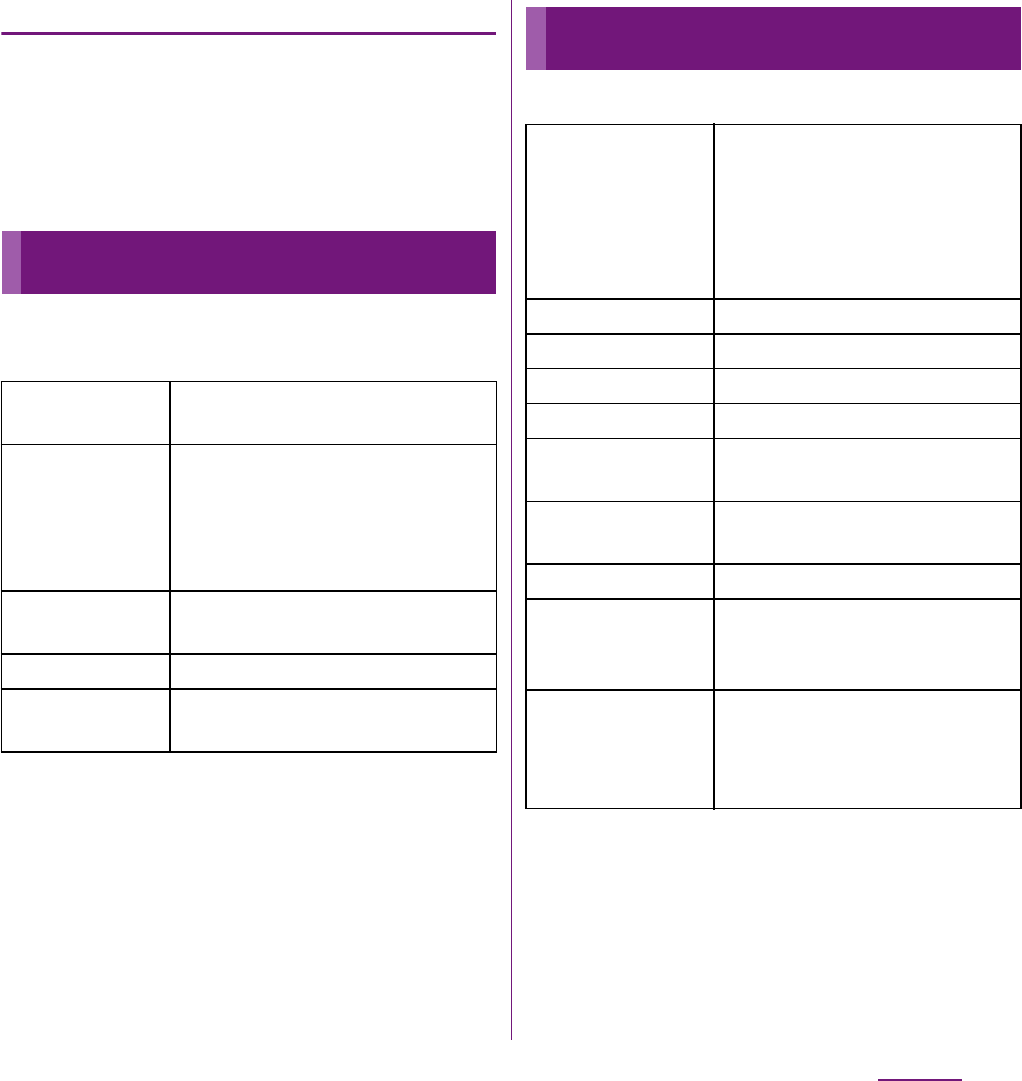
115
Settings
Disconnecting a VPN
1
Open the Notification panel, and
tap the VPN connecting
notification.
・
Tap a connecting VPN to disconnect.
You can use the network services and search
for available networks.
Set ringtones, operation sound, vibrator, etc.
Call settings
Network service
setting
P.96
Service
providers
When you start using overseas or
move out of your operator's
network, the terminal searches
another available network and
reconnects to it.
Noise
suppression
Make the voice clear to understand
for the other party during a call.
Accounts
Set Internet phone (SIP) account.
Use Internet
calling
Set Internet phone (SIP) call
method.
Sound
xLOUD
™
Set audio playback level
enhancement technology
("xLOUD") to enjoy powerful
sounds with the built-in speaker
when playing music, YouTube,
Gallery, etc.
Silent mode
P.120
Vibrate
P.120
Volume
P.120
Phone ringtone
P.121
Notification
ringtone
P.121
Audible touch
tones
P.121
Audible selection
P.121
Screen lock
sounds
Set whether to emit sound or
not when unlocking the key or
the screen.
Haptic feedback
Set whether to vibrate the
terminal for some operations
such as specified software key
operation.

116
Settings
1
Press and hold
p
for over a
second.
・
Phone options menu appears.
2
Tap [Silent mode].
❖
Information
・
Alternatively, from the Settings screen (P.107), tap
[Sound] and mark [Silent mode], or from the key
unlocking screen (P.39), touch and drag to the
left to set silent mode.
・
Setting the phone to silent mode does not mute
sounds for playback of video or music, alarm, etc.
1
From the Settings screen (P.107),
tap [Sound]
u
[Vibrate].
2
Tap any of [Always]/[Never]/[When
sound is off]/[When sound is on].
1
From the Settings screen (P.107),
tap [Sound]
u
[Volume].
・
Adjust the volume of following items.
- Ringtone
- Media (sounds of the Music player,
Gallery and FM radio, etc.)
- Alarm
- Notification tone
2
Drag the slider left or right to
adjust the level.
・
Drag the slider to the left for volume
down, or to the right for volume up.
3
Tap [OK].
❖
Information
・
By default, Notification volume is adjusted to the
same as Ringtone volume. To adjust Ringtone and
Notification separately, unmark [Use incoming call
volume for notifications] in Step 1. Ringtone and
Notification volume adjustment sliders appear, then
drag each slider to the right or left to adjust volume.
Setting Silent mode
Setting vibrator
Adjusting each sound volume

117
Settings
1
From the Home screen, press up or
down of
m
.
・
The volume adjustment bar appears,
you can adjust the volume up or down.
❖
Information
・
You can also press
m
or
p
to mute the
ringtone for an incoming call.
1
From the Settings screen (P.107),
tap [Sound]
u
[Phone ringtone].
2
Select a ringtone and tap [Done].
・
You can set voice file in ".wav", ".m4a" or
in other format which is transferred
from Media Go (P.162) or downloaded
from the Internet as a ringtone. (P.203)
❖
Information
・
To set a ringtone other than the ones stored by
default, you can also set from "Music library".
1
From the Settings screen (P.107),
tap [Sound]
u
[Notification
ringtone].
2
Select a ringtone and tap [Done].
❖
Information
・
To set a notification sound other than the ones
stored by default, you can also set from "Music
library".
1
From the Settings screen (P.107),
tap [Sound].
2
Mark [Audible touch tones],
[Audible selection].
・
If you unmarked them, any operation
tone does not sound when you touch
or tap.
❖
Information
・
"Audible touch tones" is a tone for numeric key
operations. "Audible selection" is a tone when
selecting menu item.
・
To set the key sound of software keyboard, from the
Settings screen (P.107), tap [Language & keyboard],
and select a type of software keyboard.
Adjusting the ringtone volume
with the volume key
Setting a ringtone
Selecting a notification
ringtone
Setting touch tones to ON

118
Settings
Set brightness, orientation of the screen, etc.
* Setting Mobile BRAVIA Engine improves image
quality when using Xperia
™
application.
1
From the Settings screen (P.107),
tap [Display]
u
[Brightness].
2
Drag the slider to the right or left.
・
Drag the slider to the left for dimmer
screen, or to the right for brighter
screen.
3
Tap [OK].
You can set the screen orientation to change
automatically between landscape and
portrait view when you turn the terminal
sideways/paleways.
❖
Information
・
Even when you change the orientation of the
terminal, the screen may not change to landscape
view depending on the screen such as Home screen,
etc.
Setting to change to landscape view
1
From the Settings screen (P.107),
tap [Display].
2
Mark [Auto-rotate screen]
checkbox.
Set animation effect which shows transition
of screen smoothly.
1
From the Settings screen (P.107),
tap [Display]
u
[Animation].
2
Select an animation option.
Display
Mobile BRAVIA
Engine
To view photos or movies
colorfully and beautifully, set
image quality improving
procedure (Mobile BRAVIA
Engine). It adjusts contrast,
color shade, etc.
*
Brightness
P.122
Auto-rotate screen
P.122
Animation
P.122
Screen timeout
P.123
Theme
Set the background image for
the Home screen or Settings
screen.
Lock screen settings
P.123
Adjusting the screen
brightness
Changing orientation of the
screen
Setting animation effect to
transition

119
Settings
1
From the Settings screen (P.107),
tap [Display]
u
[Screen timeout].
2
Select a time option before the
screen back light turns off.
❖
Information
・
To turn the screen back light off immediately, press
p
.
Yon can set information displayed on the key
unlock screen (P.39).
1
From the Settings screen (P.107),
tap [Display]
u
[Lock screen
settings].
■
Displaying notification
Mark [Missed calls]/[New sp-mode mails]/
[New messages]/[New emails]/[Calendar
events].
・
By default, "Missed calls", "New sp-
mode mails" and "New messages"
checkboxes are marked.
・
When you log in to Facebook and set
"Facebook inside Xperia
™
" (P.134),
"Facebook notifications" checkbox
appears. Mark the checkbox to display
the notification for a new Facebook
message on the key unlock screen.
(Some notifications such as "Friends
requests", "Event invites", etc. cannot be
displayed.)
■
Hiding detailed information on
notification
Mark [Privacy] checkbox.
・
Notification and a number of messages,
calls, etc. are displayed while
information on the other party or
message contents are not displayed.
■
Changing shortcuts of applications
Tap [Application shortcuts]
u
[Add new
shortcuts]/[Contacts]/[Messaging]/
[Google Search] and flick up and down to
select the application you want to
change.
・
By default, "Contacts", "Messaging" and
"Google Search" are set, which can be
customized.
Adjusting the idle time before
the screen turns off
Setting information displayed
on the key unlock screen

120
Settings
・
Flick right around date and time
displayed on the key unlock screen to
display a shortcut for the preset
application, or flick left to display Music
player widget. You can activate the
application or play music without
unlocking key lock. You cannot replace
the Music player widget.
■
Changing wallpaper
Tap [Wallpaper]
u
[Gallery]/[Xperia
™
wallpapers].
・
For setting procedure, see Step 2 (P.69)
in "Changing wallpaper".
■
Displaying Machi-chara
Mark [Machi-chara] checkbox.
・
Set "Machi-chara" widget on the Home
screen in advance. For setting
procedure, see "Adding a widget to the
Home screen" (P.68).
・
If [Machi-chara] checkbox is marked,
three checkboxes or less can be marked
for Notification (P.123).
Set options related to location information
and security.
*1 To use Omakase Lock, enable "Omakase Lock".
Omakase Lock is not available as of February, 2012.
Location & security
Use wireless networks
P.211
Use GPS satellites
P.211
Set up screen lock
P.127
Set up SIM card lock
P.126
Visible passwords
Set whether to show the
input character before "
・
"
appears on the password
entry screen.
Select device
administrators
Set whether to enable
device administrators. By
default, "Omakase Lock" is
activated.
*1
Use secure credentials
Allow applications to
access secure certificates
and other credentials.
*2
Install from internal
storage
Install encrypted
certificates from internal
storage.
Set password
Set or change the
credential storage
*3
password.
Clear storage
Delete all certificates and
credential information
from the credential
storage
*3
and reset its
password.

121
Settings
*2 Set the password to the credential storage in
advance.
*3 Save certificates and credential information in the
credential storage.
Some functions provided for convenient use
of the terminal require the security code to
use them. Besides the security code for
locking the terminal, the network security
code necessary for the network services etc.
are available. Make use of the terminal using
an appropriate security code according to
the purpose.
■
Notes on the security codes
・
Avoid using a number that is easy to
guess, such as "birth date", "part of your
phone number", "street address number
or room number", "1111", and "1234".
Make sure to make a note of the security
code you set lest you should forget it.
・
Be very careful not to let others know your
security code. If your security code is
known by anyone else, DOCOMO shall
have no liability for any loss due to any
unauthorized use of it.
・
If you forget your security codes, you must
bring your official identification (such as
drivers license), the terminal, and UIM
with you to the nearest docomo Shop. For
details, contact the "General Inquiries" on
the last page of this manual.
・
The PUK code is written on the
subscription form (copy for customer)
handed at the subscription in the
docomo Shop. If you subscribed other
than docomo Shop, you must bring your
official identification (such as drivers
license), the UIM with you to the nearest
docomo Shop or contact the "General
Inquiries" on the last page of this manual.
Network security code
The network security code is a 4-digit
number necessary for identification or using
the docomo Network Services at reception of
your request in docomo Shop or at docomo
Information Center. It can be set any number
at the subscription and also changed later by
yourself.
You can change your network security code
to the new one using the PC if you have the
"docomoID"/"Password" for the "My
docomo"
*
General support site for PC.
* For information on "My docomo", see the
previous page of the last page of this manual.
Protecting the UIM

122
Settings
You can set a security code called PIN code to
the UIM. The code is set to "0000" at the time
of subscription. It can be changed by
yourself.
PIN code is a 4- to 8-digit number (code) that
must be entered for user confirmation to
prevent unauthorized use by a third party
every time you insert the UIM into the
terminal or when the terminal is powered on.
Entering the PIN code enables making/
receiving calls and terminal operation.
・
If you use a newly purchased terminal with
UIM you have been using inserted, use the
PIN code set on the former terminal. If you did
not change the setting, the code is "0000".
・
If you enter a wrong PIN code 3 times
consecutively, the PIN code is locked and
cannot be used anymore. In this case, unlock
with "PUK". (P.126)
PUK code (Personal Unblocking Key)
The PUK code is an 8-digit number for
canceling the locked PIN code. The PUK code
cannot be changed by yourself.
・
If you failed to enter PUK code 10 times
consecutively, the UIM is locked. Please
contact a docomo Shop.
By setting PIN (security code) and entering
PIN code when powered on, you can protect
the UIM from improper use.
1
From the Settings screen (P.107),
tap [Location & security]
u
[Set up
SIM card lock]
u
[Lock SIM card].
2
Enter the PIN code of the UIM and
tap [OK].
・
[Lock SIM card] is marked.
Entering the PIN code when powered
on
1
On the PIN code entry screen,
enter the PIN code of the UIM.
2
Tap [OK].
❖
Information
・
Even if you do not unlock the SIM card lock, you can
make an emergency call by tapping [Emergency call]
on the screen unlocking screen after unlocking the
SIM card lock. For details, refer to "Emergency call"
(P.81).
PIN code Enabling the UIM PIN

123
Settings
Changing the PIN code
・
You can change the PIN code only when the
UIM PIN is enabled.
1
From the Settings screen (P.107),
tap [Location & security]
u
[Set up
SIM card lock]
u
[Change SIM PIN].
2
Enter the current PIN code of the
UIM and tap [OK].
3
Enter a new PIN code of the UIM
and tap [OK].
4
Enter the new PIN code of the UIM
again and tap [OK].
Unblocking the locked UIM
1
On the PUK code entry screen,
enter the PUK code and tap [OK].
2
Enter the new PIN code of the UIM
and tap [OK].
3
Enter the new PIN code of the UIM
again and tap [OK].
You can secure your data by requiring a
screen unlock pattern every time the
terminal is turned on or every time it is
activated from sleep mode.
There are 3 types of screen lock settings:
"Pattern", "PIN" and "Password". (P.127)
❖
Information
・
You can use Key lock (P.38) to prevent unintended
operation or save the power consumption of the
terminal without setting screen lock.
Setting screen unlock method
1
From the Settings screen (P.107),
tap [Location & security]
u
[Set up
screen lock].
2
Tap [Pattern]/[PIN]/[Password].
・
When you tap [Pattern], follow the
onscreen instructions to enter screen
unlock pattern.
Set security question and answer in case
you forget the pattern.
・
When you tap [PIN], follow the
onscreen instructions to enter 4 or
more numbers. This "PIN" code is
different from a PIN code to be set to
UIM (P.126).
Screen lock

124
Settings
・
When you tap [Password], follow the
onscreen instructions to enter 4 or
more characters including alphabets.
Changing screen unlock method
1
From the Settings screen (P.107),
tap [Location &
security]
u
[Change screen lock].
・
Enter current screen unlock pattern, PIN
or password.
・
If you should fail 5 times when you
enter the unlock pattern, wait 30
seconds and then try again.
2
Tap [Pattern]/[PIN]/[Password].
・
Select items you want to change into.
For setting procedure, see Step 2 (P.127)
of "Setting screen unlock method".
Locking the screen
Once screen unlock pattern (P.127) is set, keys
and screen are locked when the terminal
enters in the sleep mode or when
p
is
pressed.
Unlocking the screen
1
Press
p
to turn the backlight
on.
2
Unlock the key lock (P.39), then
enter the screen unlock pattern,
PIN, or password.
・
Enter preset screen unlock pattern, PIN
or password.
❖
Information
・
Even if you do not unlock the screen lock, you can
make an emergency call by tapping [Emergency call]
on the screen unlocking screen after unlocking the
key lock. For details, refer to "Emergency call" (P.81).
If you forget how to unlock
■
If you set "Pattern"
"Incorrect pattern" appears when you enter
incorrect unlock pattern 5 times
consecutively.
・
Tap [Next], and answer the security
question that you set for the unlock
pattern setting, then tap [Unlock] to
unlock the screen lock.
・
If you set Google account, on the
"Incorrect pattern" screen, tap [Next] to
display "Answer question" and "Enter
Google account details".
- Mark [Answer question] and tap [Next],
and answer the question that you set for
the unlock pattern, then tap [Unlock] to
unlock the screen lock.

125
Settings
- Mark [Enter Google account details], tap
[Next], and enter Google account and
password, then tap [Unlock] to unlock
the screen lock.
・
When setting new unlock pattern after
unlocking screen lock, "Screen unlocked"
appears. Tap [Yes] to reset unlock pattern.
❖
Information
・
Tap [Try again] to retry entering pattern in 30
seconds.
・
Alternatively, tap [Try again] and [Forgot pattern?] to
display answering question screen that you set the
unlock pattern.
・
You can set multiple Google accounts. To unlock the
screen with Google account and password, enter
one of those accounts.
■
If you set "PIN"/"Password"
Please contact a docomo Shop.
Canceling screen lock
You can cancel screen lock pattern after you
set.
1
From the Settings screen (P.107),
tap [Location & security]
u
Tap
[Change screen lock].
・
Enter preset screen unlock pattern, PIN
or password.
2
Tap [None].
You can set options related to application
display and management.
Before you can download unknown source's
applications, set the terminal to enable
downloading.
Applications you download may be of
unknown origin. To protect your terminal
and personal data, only download
applications from trusted sources such as the
Android Market etc.
1
From the Settings screen (P.107),
tap [Applications].
2
Tap [Unknown sources].
Applications
Unknown sources
P.129
Manage applications
P.130
Running services
Display/Manage the currently
running services.
Storage use
Display size of all applications,
usage condition, etc.
Battery use
Display operations which has
been using the battery.
Development
Set options for application
development.
Permitting downloading
unknown source's application

126
Settings
3
Read the cautions displayed, tap
[OK].
・
[Unknown sources] checkbox is
marked.
Checking downloaded applications
You can check data downloaded from
websites, such as unknown source's
applications, in the following steps.
1
From the Home screen, tap
[Browser].
2
Tap
t
and tap
[More]
u
[Downloads].
❖
Information
・
Applications downloaded from Android Market do
not appear.
Manage and delete installed applications,
display memory usage condition, etc. or
change the settings.
Viewing permitted operation of the
applications in the terminal
You can check functions which are permitted
to access to each application in the progress
of performing, such as network
communication function or location
information function of the terminal.
1
From the Settings screen (P.107),
tap [Applications]
u
[Manage
applications].
2
Tap an application to view.
3
Scroll down the screen to view
permitted operations.
・
If all permitted operations do not
appear, tap [All].
Shutting down an application
If a pop-up window that indicates the
application does not reply appears, you can
force quit the application.
1
From the Settings screen (P.107),
tap [Applications]
u
[Manage
applications].
2
Tap an application to force-quite.
3
Tap [Force stop].
4
Read the cautions displayed, tap
[OK].
❖
Information
・
When you do not want to force stop the application,
tap [Cancel] and wait for a reply of the application.
❖
Note
・
If you cancel the "status bar" of applications forcibly,
operations may not be performed correctly.
Managing your applications

127
Settings
Deleting all data of the application
・
Before deleting all installed application data,
back up contents related to the application
that you want to save including data saved in
the application.
1
From the Settings screen (P.107),
tap [Applications]
u
[Manage
applications].
2
Tap an application to delete the
data.
3
Tap [Clear data].
4
Read the cautions displayed, tap
[OK].
Deleting installed application
・
Before deleting installed application, back up
contents related to the application that you
want to save including data saved in the
application.
・
Some applications cannot be deleted.
1
From the Settings screen (P.107),
tap [Applications]
u
[Manage
applications].
2
Tap an application to be deleted.
3
Tap [Uninstall].
4
Tap [OK].
5
When uninstallation is completed,
tap [OK].
❖
Information
・
Some applications pre-installed in the terminal
cannot be uninstalled.
・
Applications can be deleted from the Applications
screen. For details, refer to "Uninstalling an
application" (P.77).
Deleting cache of the application
1
From the Settings screen (P.107),
tap [Applications]
u
[Manage
applications].
2
Tap an application to delete cache.
3
Tap [Clear cache].
Deleting settings for activating the
application
You can delete settings for activating the
application and restore to the default.
1
From the Settings screen (P.107),
tap [Applications]
u
[Manage
applications].
2
Tap an application to delete its
settings.
3
Tap [Clear defaults].
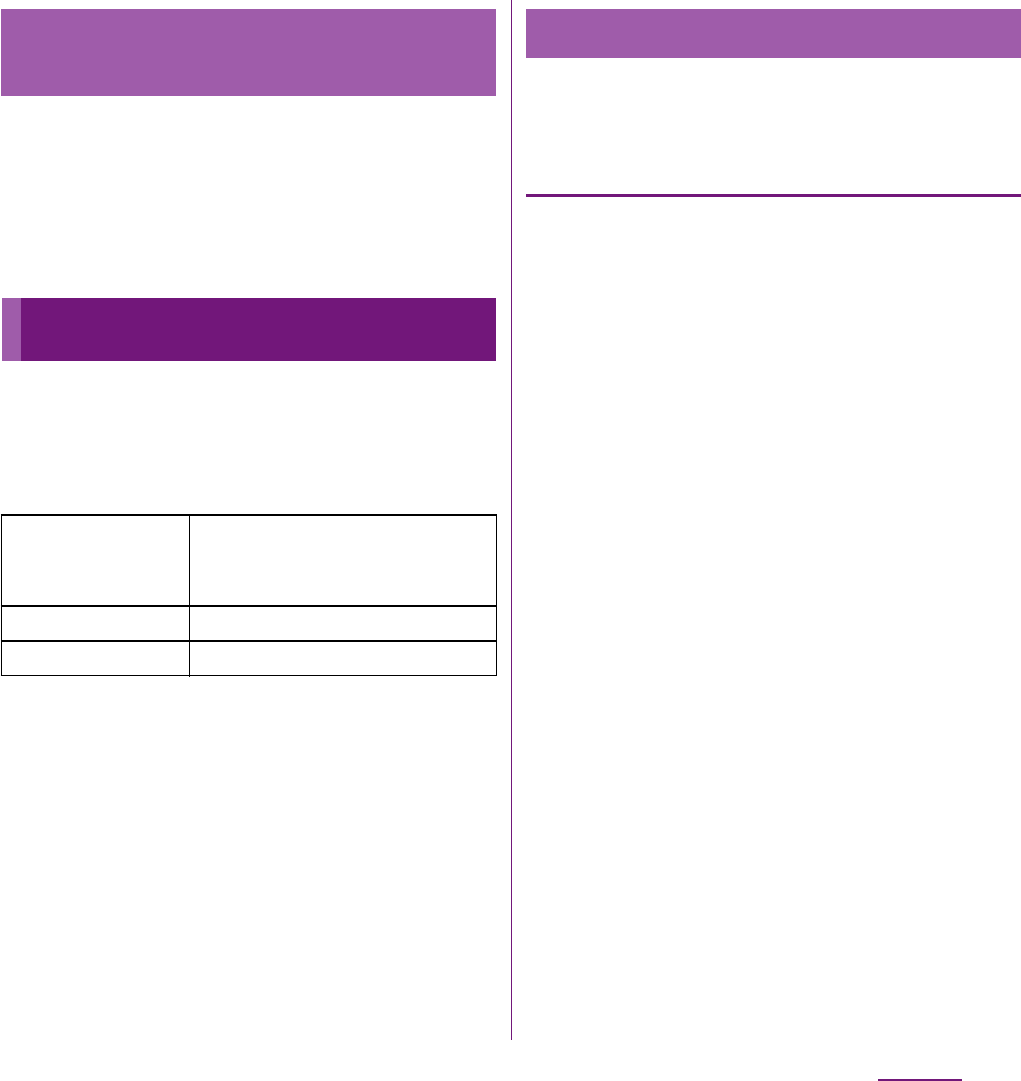
128
Settings
1
From the Settings screen (P.107),
tap [Applications]
u
[Development].
2
Mark [Stay awake] checkbox.
You can manage (add or delete) online
service accounts or synchronize contacts,
messages, etc. saved in online services with
the terminal.
You can add or delete an online service
account.
Setting Google account
You can create a Google account on your
terminal and use Google services such as
Gmail, Google Talk, Google Calendar, Android
Market, etc.
You can set multiple Google accounts on the
terminal.
1
From the Settings screen (P.107),
tap [Accounts & sync]
u
[Add
account]
u
[Google].
2
Follow the registration wizard, set
a Google account.
・
If you have no Google account, create
an account.
・
If you have already the Google account,
sign in.
❖
Information
・
You can use the terminal without creating your
Google account, however the services such as
Google Talk, Gmail, Android Market, etc. are not
available.
・
To sign in, you need a Google account and a
password.
Keeping the screen backlight
ON while charging
Accounts & sync
Background data
traffic
All the applications installed to
the terminal perform automatic
data communications.
Activate auto-sync
P.135
Manage accounts
P.132
Managing accounts

129
Settings
・
If you set a Google account, you can tap your Google
account displayed on the "Accounts & sync" screen in
the setting menu to manually synchronize data from
the following items.
* To upload photos automatically, select settings to
enable the instant upload on the confirmation
screen when you set a Google account to log in
Google+.
・
If you set a Google account and use Picasa in it, "Sync
Picasa Web Albums" appears. Tapping to synchronize
displays Picasa Web Album in the Gallery on the
terminal.
・
If you set a Google account and use Google+ in it,
"Sync Google+" appears. Tap it to synchronize and
display instant upload photos in the Gallery in the
terminal.
・
Make sure to check if the data connection is available
before sign in to the Google account. For checking
the data connection status, see "Status icon" (P.41).
Setting Facebook account
When you register or sign in Facebook, you
can display profile information published by
online "Friend" to Phonebook. And you can
display Facebook updates of "Friends" in
Timescape.
❖
Information
・
If you do not have a Facebook account, you can also
create a new account at http://www.facebook.com.
・
If you download and install client applications for
Twitter, mixi, you can setup accounts and
synchronize contacts information in the same
manner as Facebook.
1
From the Settings screen (P.107),
tap [Accounts & sync]
u
[Add
account]
u
[Facebook].
・
If you already have a Facebook account
and set account from Phonebook or
Timescape of the terminal, you need
not add a new account.
2
Enter your sign in information.
・
If you have no Facebook account,
register an account.
・
If you have Facebook account, sign in.
Sync Instant
Upload
*
Synchronize photos taken with the
camera or screen shots or photos in
a microSD card with photos in
Google+.
Sync Contacts
Synchronize contacts stored in
Gmail with the phonebook stored in
the terminal.
Sync Gmail
Synchronize Mail logs used in Gmail
account with Gmail on the terminal.
Sync Calendar
Synchronize calendar information
such as schedule, etc., stored in
Google account with Calendar in the
terminal.

130
Settings
❖
Information
・
Set Facebook account to display in the status bar.
Drag the status bar downwards, tap [Facebook inside
Xperia
™
], mark the [Facebook integration] checkbox,
read the displayed note, and then tap [Accept]. Tap
(Facebook inside Xperia
™
) added to the
"Accounts & sync settings" screen, and tap the
following items to synchronize and display
corresponding data.
Setting other account
■
Exchange ActiveSync account
・
If you have Exchange ActiveSync account,
from the Settings menu screen (P.107),
tap [Accounts & sync]
u
[Add
account]
u
[Exchange Active Sync] and
set according to the onscreen instruction.
■
docomo account
・
docomo account helps you to use
"docomo backup" service (P.72) provided
by NTT DOCOMO. docomo account is set
by default.
Deleting an account
1
From the Settings screen (P.107),
tap [Accounts & sync] and select a
service account you want to
delete.
2
Tap [Remove account]
u
[Remove
account].
❖
Information
・
The first set Google account cannot be removed
from "Remove account". To remove the first set
Google account, reset the terminal. For resetting
procedure, see "Resetting the terminal" (P.135).
・
docomo account cannot be deleted.
Synchronize online information such as your
Gmail, calendar, contacts, etc. to the terminal.
You can display and edit information on the
terminal or a PC.
❖
Information
・
You need to set your online service account such as
Google account, etc. on the terminal to synchronize.
You can set to synchronize manually or automatically
through use of background data.
Sync Calendar
Synchronize events such as Friends'
birthdays, etc., stored in Facebook
with Calendar in the terminal.
Sync Albums in
Gallery
Display images posted on Facebook
onto the album in Gallery of the
terminal.
Sync Contacts
Synchronize profile of Friends stored
in Facebook with the phonebook
stored in the terminal.
Data synchronization
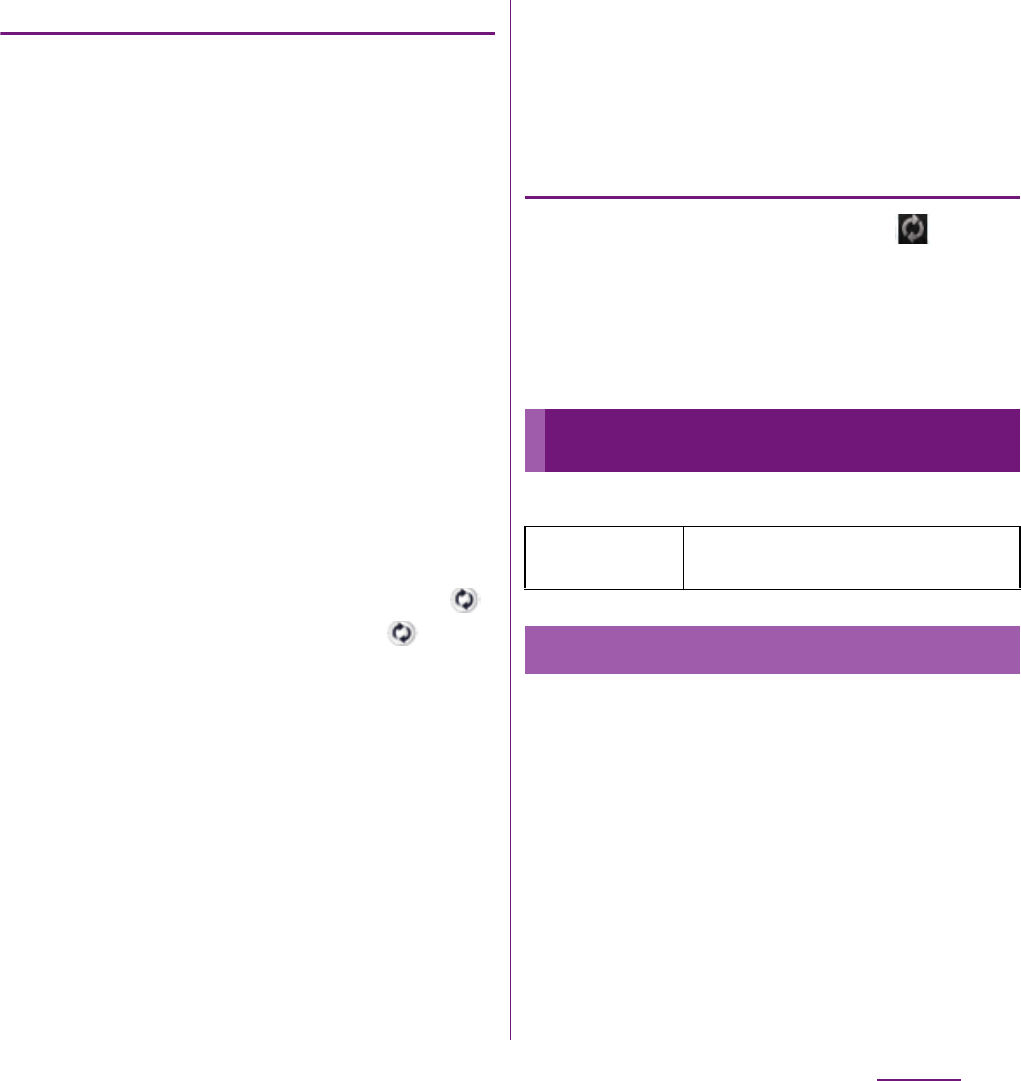
131
Settings
Setting Auto-sync
1
From the Settings screen (P.107),
tap [Accounts & sync].
2
Mark [Background data traffic]
checkbox.
3
Tap [Activate auto-sync].
4
Read the cautions displayed, tap
[OK].
・
[Activate auto-sync] checkbox is
marked.
5
Tap an online service whose
account is set.
6
Tap to mark an item for automatic
synchronization.
・
If the items to be synchronized are
marked and checkboxes are led by ,
synchronization starts. When is not
displayed, tap
t
and tap [Sync now]
to start synchronization.
❖
Note
・
If you mark [Background data traffic], all the
applications installed to the terminal are permitted
automatic data communications to online services
whose accounts are set. And, if you mark [Activate
auto-sync], your Gmail, calendar, contacts, and profile
information published by "Friend", etc. are permitted
automatic data communications by Google account.
These communications may cause you to pay packet
communications charges.
・
If you do not mark "Activate auto-sync", you can
synchronize manually. On the settings screen (P.107),
tap [Accounts & sync], tap the service where your
account is set to display the synchronizing items,
then tap items you want to synchronize.
Canceling synchronization
1
During synchronization (
appears in the status bar), tap
t
.
2
Tap [Cancel sync].
Restore the terminal to default.
Resetting the terminal deletes all data,
including downloaded applications and
Google accounts, and resets the terminal
back to the initial (default) state. Make sure to
back up important data you have on the
terminal before you reset the terminal.
For the initial settings, see "Initial settings
(Setup guide)" (P.39).
Privacy
Factory data
reset
P.135
Resetting the terminal

132
Settings
1
From the Settings screen (P.107),
tap [Privacy]
u
[Factory data
reset]
u
[Reset phone].
・
Mark [Erase internal storage] checkbox
to delete all contents (music, photos,
videos, etc.) on the internal storage.
・
Enter your screen unlock method as
required.
2
Tap [Erase everything].
・
By tapping [Erase everything], the
terminal restarts automatically.
❖
Information
・
If you reset the terminal, license information for the
DRM protected content may be erased making the
content unable to be played.
Check memory volume of the microSD card,
USB storage, internal storage and phone
memory. And you can format microSD card,
USB storage and internal storage.
USB storage is an external memory such as a
microSD card connected to the terminal
using commercially available reader/writer
cable.
* Display changes depending on condition of USB
storage or microSD card recognition.
Storage
microSD card
Total space
Check memory volume of microSD
card.
Available space
Check available memory of a
microSD card.
Unmount SD
card
*
Cancel connection of microSD card
to remove it safely.
Mount SD card
*
Have microSD card recognized.
Erase SD card
P.137
USB storage
Total space
Check memory volume of USB
storage.
Available space
Check available memory of USB
storage.
Mount USB
storage
*
Have USB storage recognized.
Unmount USB
storage
*
Cancel connection of USB storage
to remove it safely.
Clear USB
storage
P.137
Internal storage
Total space
Check memory volume of internal
storage.
Available space
Check available memory of internal
storage.
Clear internal
storage
P.137
Phone memory
Available space
Check available memory of the
phone memory.

133
Settings
❖
Information
・
Note that when available memory of internal storage
becomes 32KB or less, microSD card cannot be
mounted.
Formatting microSD card
1
From the Settings screen (P.107),
tap [Storage]
u
[Unmount SD
card].
2
Tap [Erase SD card].
3
Tap [Erase SD card]
u
[Erase
everything].
❖
Information
・
Formatting microSD card deletes all the data in it.
Formatting USB storage
Insert external memory such as a microSD
card into commercially available reader/
writer cable and connect the cable to the
terminal in advance.
1
From the Settings screen (P.107),
tap [Storage]
u
[Unmount USB
storage].
2
Tap [Clear USB storage].
3
Tap [Clear USB storage]
u
[Erase
everything].
❖
Information
・
Formatting USB storage (external memory such as
microSD card) deletes all the data in it.
Formatting the internal storage of the
terminal
1
From the Settings screen (P.107),
tap [Storage]
u
[Clear internal
storage].
2
Tap [Clear internal storage].
3
Tap [Erase everything].
❖
Information
・
Formatting the terminal deletes all the data in it.
Checking total memory space and
available memory of internal storage.
1
From the Settings screen (P.107),
tap [Storage].
・
Check total volume and available
memory of microSD card, USB storage,
internal storage and phone memory.
Managing memory

134
Settings
Increasing the available memory of
the terminal
If the terminal has a small memory, you can
perform the following operations to increase
available memory:
・
In the browser, you can clear all temporary
Internet files and browser history information.
For details, refer to "Clearing history" (P.157).
・
Uninstall programs that you no longer use. For
details, refer to "Deleting installed application"
(P.131).
You can select language and keyboard input.
Changing phone language
1
From the Settings screen (P.107),
tap [Language &
keyboard]
u
[Select language].
2
Select a language and tap [Done].
・
When you select Japanese, "
完了
(Done)" is displayed, but its display
varies by the language you selected.
❖
Information
・
If you choose the wrong language and cannot read
the menu texts, go to http://www.sonymobile.co.jp/
so-04d/faq.html for help.
You can set Google voice recognizer and
Text-to-speech settings.
■
Voice recognizer settings
■
Text-to-speech settings
Language & keyboard
Select language
P.138
User dictionary
Register words.
Xperia
™
keyboard
P.60
Xperia
™
Chinese keyboard
Xperia
™
Japanese keyboard
Voice input & output
Language
Select language used for Google
voice search.
SafeSearch
Set filter explicit.
Block
offensive
words
Set whether to display recognized
offensive voice results.
Listen to an
example
Playback sample of audio synthesis.
Always use my
settings
Overwrite application settings with
content of "Default Engine", "Install
voice data", "Speech rate", "Language"
and "Pico TTS".
Default
Engine
Set audio synthesis engine to read
out text. By default, "Pico TTS" is set.
Install voice
data
Install voice data required to voice
synthesis. If voice data is not installed,
connect to Android Market to search
voice data.
Speech rate
Set speed at reading out text.
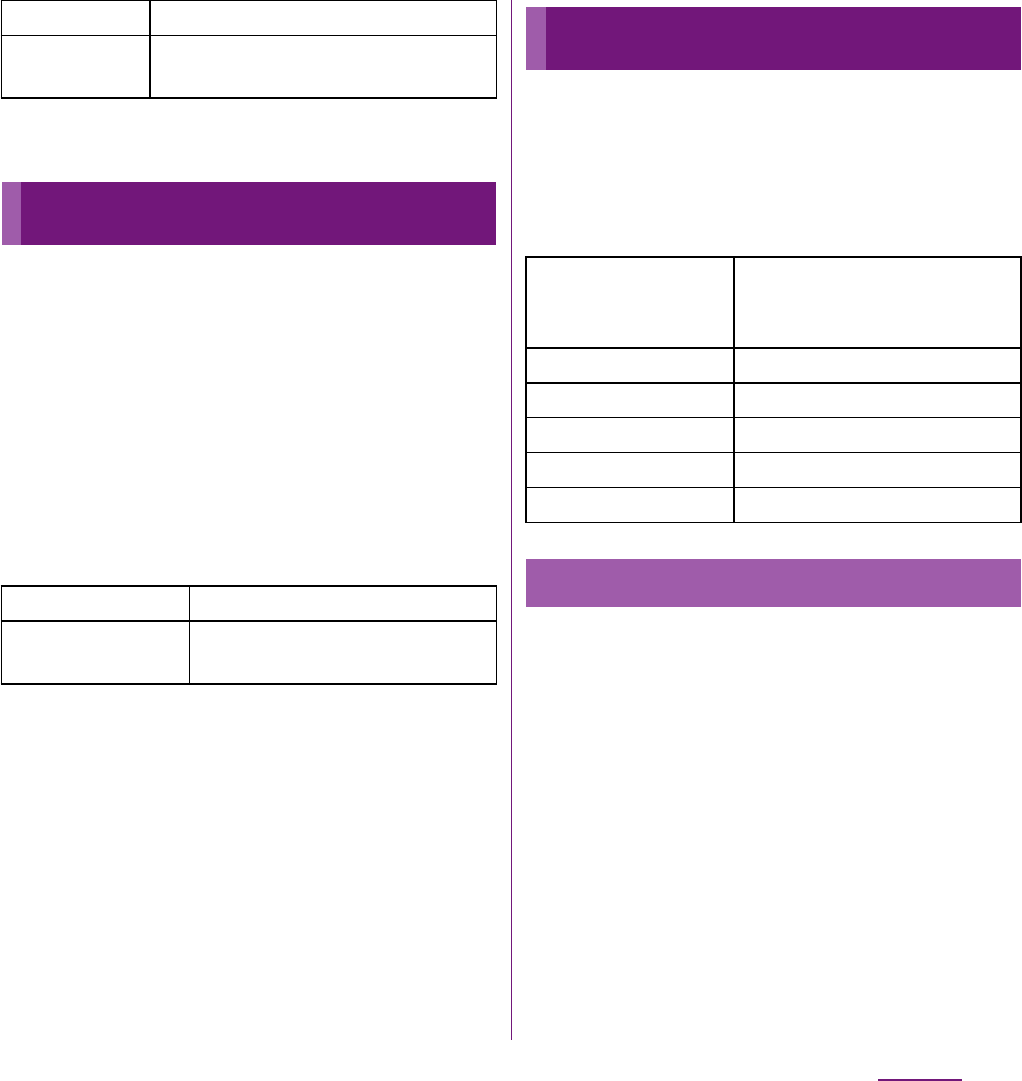
135
Settings
* Japanese is not supported.
You can set call end operation and user
support service which sounds or vibrates
according to user's operation.
❖
Information
・
A user support application is not installed by default.
For the first time of use, install a screen reader for the
terminal from the Android Market according the
onscreen instructions.
・
To use Android Market, you need to set Google
account (P.132).
You can change the date and time in the
terminal.
To set date, time zone and time manually,
unmark "Automatic" (Use network-provided
values) under Date & time settings.
1
From the Settings screen (P.107),
tap [Date & time]
u
[Set date].
2
Tap number to adjust the date.
3
Tap [Set].
❖
Information
・
Correction of the time differences may not be
performed correctly depending on the overseas
telecommunication carrier. In that case, set time
zone manually (P.140).
Language
Set language for reading out text.
Pico TTS
*
Make settings for installed voice
synthesis engine.
Accessibility
Accessibility
Set user support service on/off.
Power button ends
call
Set to end a call by pressing
p
.
Date & time
Automatic
Adjust date, time zone, and
time automatically by using
network-provided information.
Set date
P.139
Select time zone
P.140
Set time
P.140
Use 24-hour format
P.140
Select date format
P.140
Setting the date
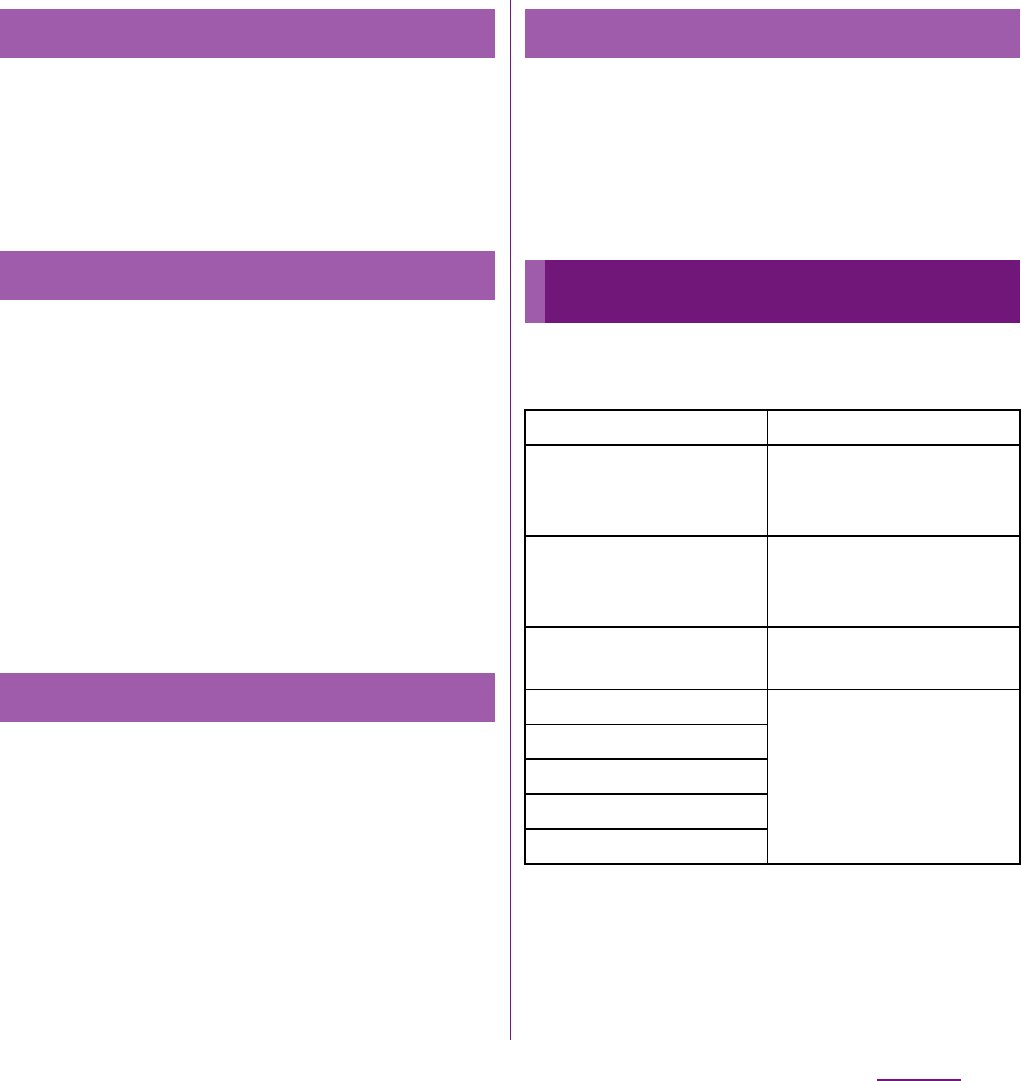
136
Settings
1
From the Settings screen (P.107),
tap [Date & time]
u
[Select time
zone].
2
Select time zone you want to set.
1
From the Settings screen (P.107),
tap [Date & time]
u
[Set time].
2
Tap number to adjust the hour and
minute.
・
When you unmark [Use 24-hour
format], you can change AM/PM. When
you tap [am], it changes to [pm] (or vice
versa).
3
Tap [Set].
1
From the Settings screen (P.107),
tap [Date & time] and mark/
unmark [Use 24-hour format]
checkbox.
・
Mark the checkbox to shift to 24-hour
format, and unmark to shift to 12-hour
format.
1
From the Settings screen (P.107),
tap [Date & time]
u
[Select date
format].
2
Select date format you want to set.
You can check your own phone number,
signal level, legal information, etc.
Setting the time zone
Setting the time
Setting the time format
Setting the date format
About phone
Software update
P.252
Status
Check your own phone
number, signal level,
battery level, etc.
Battery use
Display operations which
have been using the
battery.
Legal information
Check license agreement,
terms of use, etc.
Model number
Check version and
number.
Android version
Baseband version
Kernel version
Build number

137
Mail/Internet
Mail/Internet
Send/receive mails using i-mode mail
address (@docomo.ne.jp).
You can use pictogram and Deco-mail. Mails
can be received automatically. For details on
sp-mode mail, refer to "
ご利用ガイドブック
(sp
モード編
) (Mobile Phone User's Guide [sp-
mode])" (in Japanese only).
1
From the Home screen, tap [sp
モー
ドメール
(sp-mode mail)].
2
Scroll the screen, then tap [
ダウン
ロード
(Download)].
・
After this step, follow the instructions
on the screen.
❖
Information
・
When you receive an sp-mode mail, an icon
indicating sp-mode mail appears on the key unlock
screen. For the setting to show or hide icons, see
"Setting information displayed on the key unlock
screen" (P.123).
You can send and receive text messages up
to 70 two-byte characters (160 one-byte
characters) with a mobile phone number as
the destination.
1
From the Home screen, tap ,
then tap [Messaging].
2
Tap (New mail).
3
Tap , then mark a checkbox for
the other party to send to from the
contacts list.
・
When you enter a name or phone
number in the box at the top of the
screen, a list of contacts beginning with
the entered numbers or letters appears.
・
Alternatively, you can enter a phone
number in the box at the top of the
screen, then tap [Add] to add a
recipient.
4
Tap [Done].
sp-mode mail Message (SMS)
Sending message (SMS)

138
Mail/Internet
5
Tap "Write message" field and
enter a message.
・
When the number of entered
characters comes close to a limit, a
counter appears on the upper left of
the text box and you can check the
remaining entry space.
6
Tap [Send].
❖
Information
・
For the character entry, see "Character entry" (P.47).
・
You can also send/receive text messages to/from
customers of overseas network operators. See
"Mobile Phone User's Guide [International Services]"
or the DOCOMO International Services website.
・
To send SMS to users of overseas network operators,
enter "+", "Country code" and then "the recipient
mobile phone number". Enter the phone number
without a leading "0", if any. You can also enter "010",
"Country code" and "the recipient mobile phone
number" to send messages (To reply to the received
SMS overseas, enter "010").
1
From the Home screen, tap ,
then tap [Messaging].
2
Tap someone whose messages you
want to read from the recipient
list.
・
A received message appears.
❖
Information
・
When you receive a message (SMS), appears on
the status bar. To read the mail, drag the status bar
downward, tap an item of notified message (SMS).
・
When you receive a message (SMS), an icon
indicating message appears on the key unlock
screen. For the setting to show or hide icons, see
"Setting information displayed on the key unlock
screen" (P.123).
・
Tap / in the message to turn to (yellow).
From the Home screen, tap , then tap
[Messaging]
ut
, and tap [Starred messages] to
quickly access to the mail you have marked.
1
From the Home screen, tap ,
then tap [Messaging].
2
Select a thread whose phone
number you want to save.
3
Tap
t
, then tap [Add to
Contacts].
4
Tap [Register new].
5
Tap [Phone contacts]/[docomo].
・
When you set Google account etc., it
appears as a saving location.
6
Enter required items and tap
[Save].
Receiving and reading message
(SMS)
Saving phone number of
message to Contacts
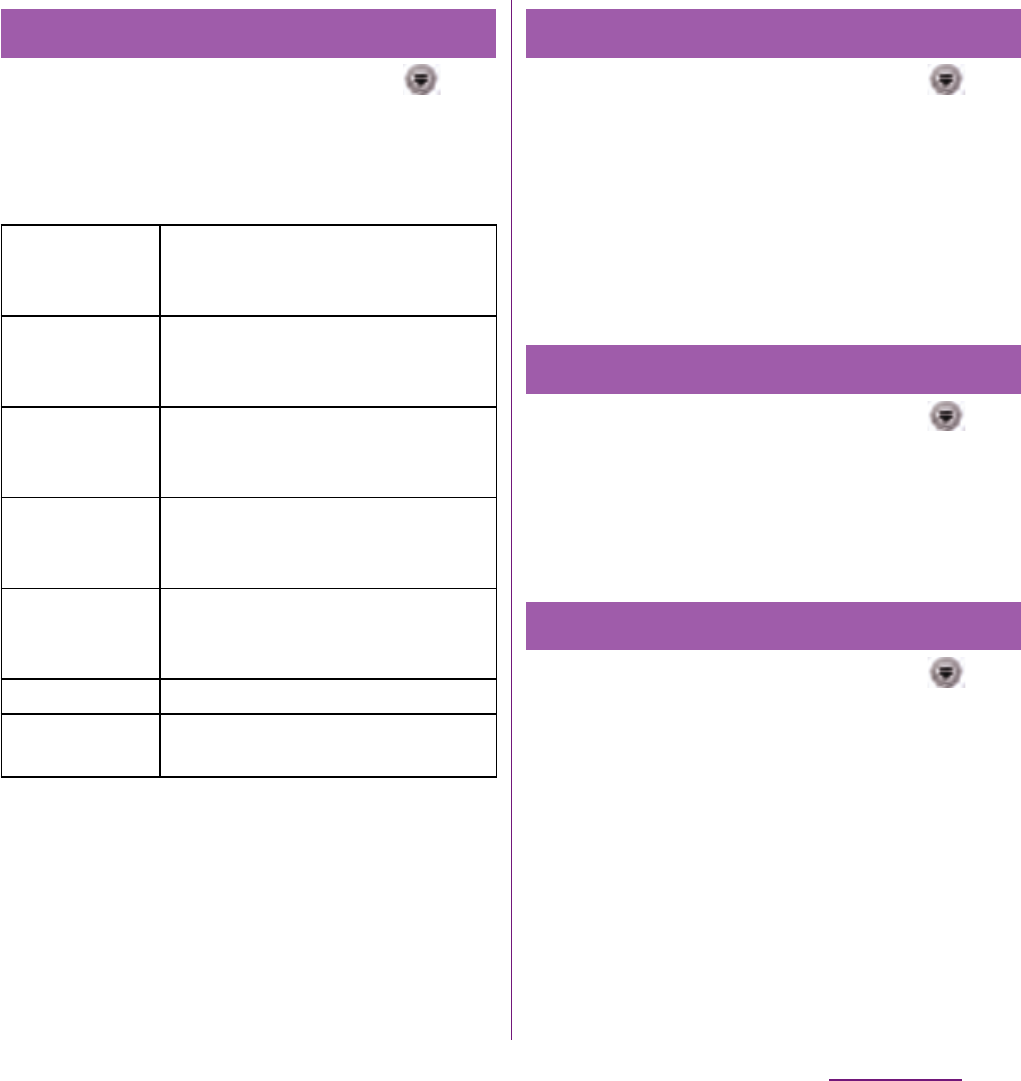
139
Mail/Internet
1
From the Home screen, tap ,
then tap [Messaging].
2
Tap
t
and [Settings].
・
You can set the following options.
❖
Information
・
Even if Notification light is unmarked, notification
LED blinks white once, letting you know that a
message has arrived.
1
From the Home screen, tap ,
then tap [Messaging].
2
Tap a thread to select.
3
Touch and hold a message you
want to delete.
4
Tap [Delete message]
u
[Yes].
1
From the Home screen, tap ,
then tap [Messaging].
2
Touch and hold a thread to delete.
3
Tap [Delete conversation]
u
[Yes].
1
From the Home screen, tap ,
then tap [Messaging].
2
Tap
t
and tap [Delete several].
3
Tap [Mark all]
u
[Delete].
・
After tapping [Mark all], you can tap
individual thread to unmark. Tap
[Unmark all] to unmark all of the
threads.
Setting message (SMS)
Delivery report
Mark to mark a message thread you
sent each time a recipient receives
the message.
Notifications
Mark if you want to receive a
notification in the status bar when a
new message arrives.
Notification
tone
Set if you want to receive a
notification in selected ringtone
when a new message arrives.
Notification
vibration
Set if you want to receive a
notification by vibration when a
new message arrives.
Notification
light
Mark to set to notify of reception by
notification LED when notification
setting is made.
SIM messages
Manage messages saved to UIM.
Push settings
Reports of message settings can be
received from the provider.
Deleting a message
Deleting a thread
Deleting all threads

140
Mail/Internet
You can create an email account provided by
mopera U mail, a POP3 or IMAP compatible
email account provided by general ISP
(provider), or an Exchange ActiveSync
account to send or receive email.
Email setup wizard appears. Set according
the onscreen instructions. Multiple email
accounts can be set.
1
From the Home screen, tap ,
and then tap [Email].
2
Enter your email address and
password.
3
Tap [Next].
・
To make the email account settings
manually, tap [Manual setup] and
follow the onscreen instructions.
4
Enter an account name and name
you want to display on outgoing
messages.
・
If "What type of account is this?"
appears, tap an email account type and
follow the onscreen instructions to set.
・
If you set an Exchange ActiveSync
account, a name displayed for sent mail
cannot be set.
5
Tap [Done].
・
Inbox for set email account appears.
❖
Information
・
If you need to make the settings manually, contact
your email service provider or system administrator
for the correct email account settings.
・
If you set an Exchange ActiveSync account as email
account, and if server manager sets Remote wipe,
the data saved in the terminal may be deleted.
・
Emails are not displayed in Timescape.
1
From the Home screen, tap ,
and then tap [Email].
2
Tap (New mail).
3
Enter the email address of
recipient.
・
Tap to display the contacts list
screen to select from registered
contacts. If you enter alphabets or a
name, email address options appear
from the contacts beginning with the
entered character.
・
To Cc or Bcc, tap
t
and tap [Add
Cc/Bcc].
Email
Making initial setting for Email
Creating and sending email
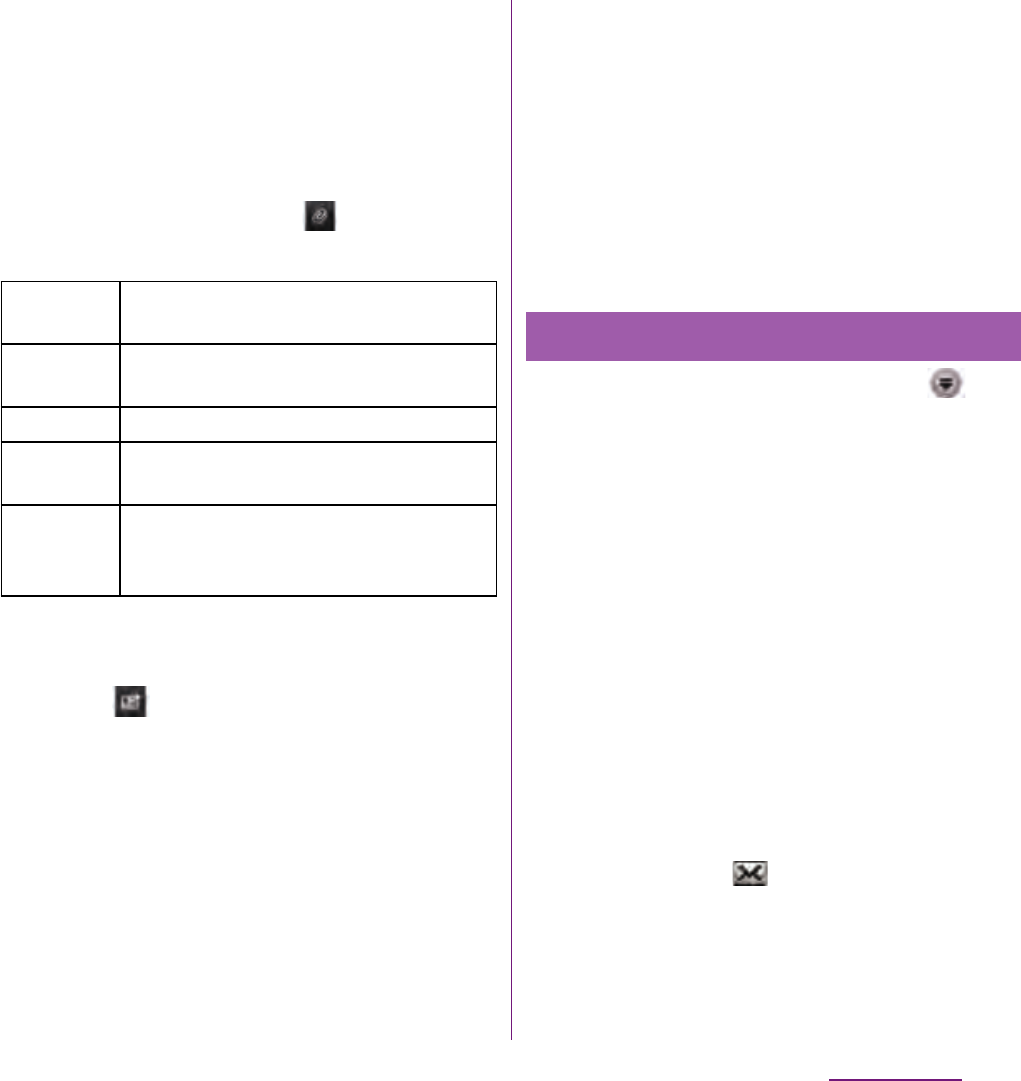
141
Mail/Internet
・
To enter multiple email addresses
directly, separate with a comma (,) and
then enter the next email address.
4
Enter a subject.
5
Enter a message text.
6
To attach a file, tap .
・
Attach a file in the following operations.
・
Image/video/music file up to 5MB can
be attached in Email.
7
Tap (Send).
❖
Information
・
When you want to save a mail as draft while creating
a mail, enter any of recipient, subject or message or
attach a file. If you do not enter or attach anything, a
mail is not saved as draft. (When only automatic
signature is attached, a mail is not saved as draft
either.)
・
While creating a mail, tap
x
and tap [Yes] in the
"Save as draft" screen to save a mail as draft. Also,
when you move to the other screen while creating a
mail, the mail is automatically saved as draft.
・
In sent/received emails, a communication data is also
included other than text and image displayed on the
screen and charges will apply to the data.
・
Email is handled as an email from a PC. You cannot
send or receive email if "Reject emails from PCs" is set
on a recipient terminal.
1
From the Home screen, tap ,
and then tap [Email].
・
When two or more email accounts are
set, the Email screen appears. Tap and
select an email account to receive from
an account list.
2
On the Inbox, tap
t
and tap
[Refresh].
3
Tap an email.
❖
Information
・
The sender name of a received email is the name set
on sender's terminal.
・
If you set "Email notifications" in Account settings
(P.148) and set "Inbox check frequency" to an item
other than "Manual", appears in the status bar
when you receive a new email. Drag the status bar
downwards to read the received email.
Add
picture
Select a file from the saved image file list.
Take photo
Start the camera to take a photo and
attach it.
Add video
Select a file from the saved video file list.
Record
video
Start the camera to record a video and
attach it.
Add sound Music player
: Select a saved music file.
Sound Recorder
: Record a voice
message and attach it.
Receiving and reading email
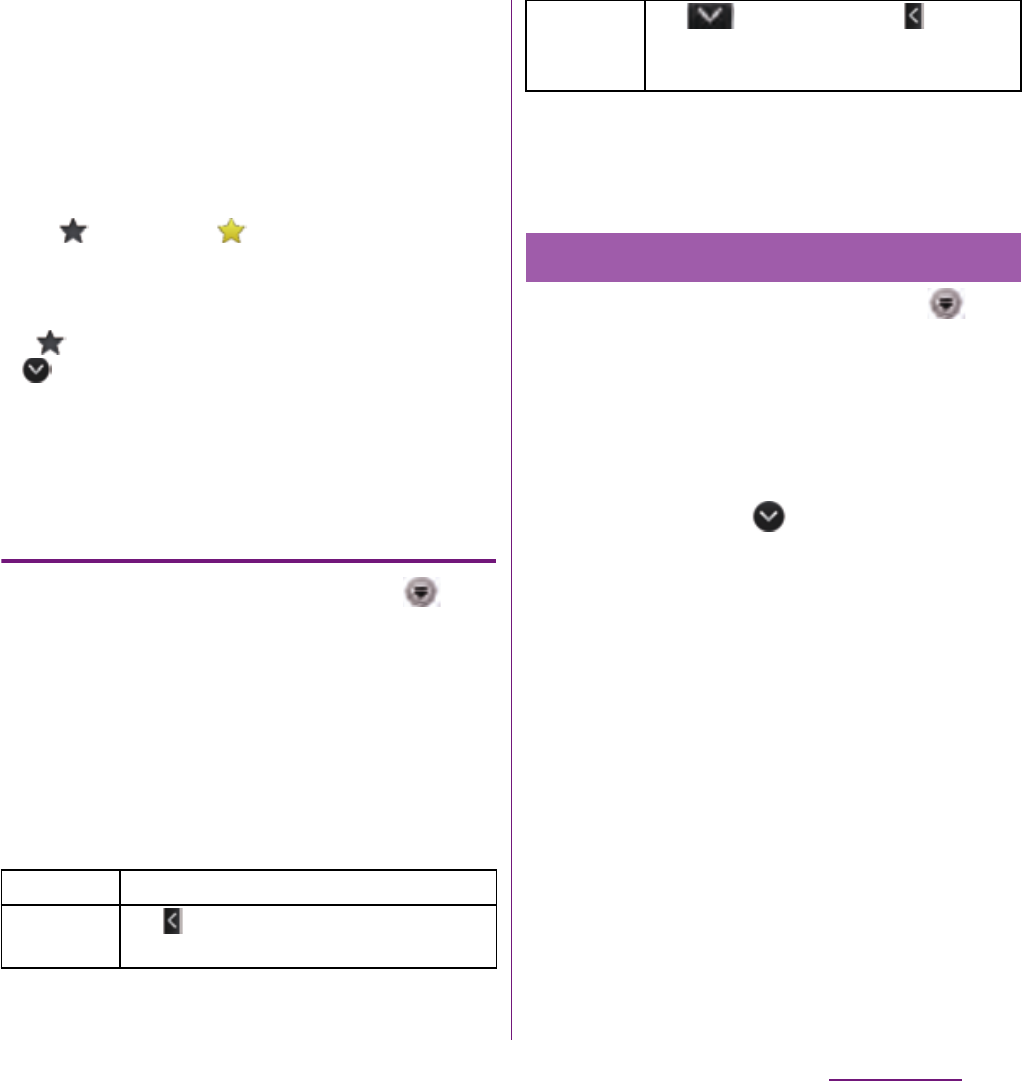
142
Mail/Internet
・
If you set "Inbox check frequency" in Account
settings (P.148) to an item other than "Manual", and if
you are using the pay-as-you-go data
communication, you may be charged every time you
check your email.
・
If you tap the address of a received email, you can
register it in Contacts. If it has been already
registered, you can display the details of the contact.
・
Tap (gray) to turn (yellow) on the mail
message screen to add the marked mail to "Starred"
on the email screen. From "Starred", you can quickly
access to the mail you have marked.
If is not displayed on the mail message screen, tap
to display.
・
When phone memory becomes low, a message
indicating low memory space appears and receiving
emails is not available. Delete saved mails etc. to
make available memory space.
Changing Inbox view
1
From the Home screen, tap ,
and then tap [Email].
・
When the Email screen appears, tap
and select an email account to receive
from an account list.
2
Tap
t
, then tap
[More]
u
[Preview pane].
・
You can set the following options.
❖
Information
・
If you have two or more accounts, change made in
any of the accounts applies to all accounts.
1
From the Home screen, tap ,
and then tap [Email].
・
When the Email screen appears, tap
and select an email account whose
attachment you want to save from an
account list.
2
Tap mail and .
・
The attachment icon is displayed.
3
Tap the icon of a file you want to
save, then tap [Save].
・
The attached file is saved on the
internal storage.
・
You can display attachment files by
tapping [Open].
Off
Inbox is not shown piecewise.
Landscape
Tap in landscape view to cut the
Inbox to show the selected mail body.
On
Tap in portrait view or in
landscape view to cut the Inbox to show
the selected mail body.
Saving attachment file of email

143
Mail/Internet
1
From the Home screen, tap ,
and then tap [Email].
・
When the Email screen appears, tap
and select an email account whose
email you want to reply or forward from
an account list.
■
Replying
Tap an email
u
Tap (Reply) or
(Reply all)
u
Enter the text and tap
(Reply).
■
Forwarding
Tap an email
u
Tap (Reply)
u
Enter
the email address of recipient
u
Enter the
text and tap (Reply).
❖
Information
・
When you reply or forward an email, the original
message contents for replying or forwarding is
quoted. To delete the quoted message text, tap .
・
When you forward an email, the attachment file of
the original message is quoted. To cancel quoting
attached file, tap .
・
You can also touch and hold the email to reply or
forward an email.
1
From the Home screen, tap ,
and then tap [Email].
・
When the Email screen appears, tap
and select an email account whose
email you want to delete from an
account list.
2
Touch and hold an email you want
to delete.
3
Tap [Delete]
u
[Yes].
❖
Information
・
To delete several emails at the same time, operate as
follows.
Tap
t
, then tap [Mark several]
u
Checkboxes to
the right of mails you want to delete, tap at the
bottom of the screen, and then tap [Yes].
・
To delete mail while sending, tap
t
then tap
[Folders]
u
[Outbox], then touch and hold a mail you
want to delete and then tap [Delete]
u
Tap [Yes].
Replying/forwarding email Deleting email

144
Mail/Internet
1
From the Home screen, tap ,
and then tap [Email].
・
When the Email screen appears, touch
and hold an account that you want to
change the settings from an account
list and tap [Account settings] to
change the settings.
2
Tap
t
, then tap
[More]
u
[Account settings].
・
You can set the following options.
❖
Information
・
You can also set "Inbox check frequency", "Sync
contacts", and "Sync calendar" for an Exchange
ActiveSync account. "Outgoing settings" cannot be
set.
・
If you set "Inbox check frequency" to other than
"Manual", and if you are using the pay-as-you-go data
communication, you may be charged every time you
check your email.
1
From the Home screen, tap ,
and then tap [Email].
・
If a screen other than Email screen
appears, tap
t
and tap
[More]
u
[Accounts].
2
Tap
t
and tap [Add account].
3
Enter your email address and
password.
・
If required, mark [Send email from this
account by default.] checkbox.
4
Tap [Next].
・
To make the email account settings
manually, tap [Manual setup] and
follow the onscreen instructions.
Changing Email account
settings
Account name
Change account name.
Your name
Change your name (sender name).
Signature
Change your signature.
Inbox check
frequency
Set whether to check new messages
automatically and intervals of
automatic check.
Default
account
Set to the default account to send
email, if you set two or more email
accounts.
Email
notifications
Set whether to show email arrival
notification in the status bar.
Select ringtone
Set ringtone when receiving an
email.
Vibrate
Set whether to vibrate when
receiving an email.
Incoming
settings
Set mail server for receiving.
Outgoing
settings
Set mail server for sending.
Setting another Email account

145
Mail/Internet
5
Enter an account name and name
you want to display on outgoing
messages.
・
If "What type of account is this?"
appears, tap an email account type and
follow the onscreen instructions to set.
・
If you set an Exchange ActiveSync
account, a name displayed for sent mail
cannot be set.
6
Tap [Done].
・
Inbox for set email account appears.
❖
Information
・
If you need to make the settings manually, contact
your email service provider or system administrator
for the correct email account settings.
・
If you set an Exchange ActiveSync account as email
account, and if server manager sets Remote wipe,
the data saved in the terminal may be deleted.
・
On the Inbox, tap
t
and tap [More]
u
[Accounts]
to display the email screen and set account list.
・
All received mails for the set accounts are shown in
the "Combined Inbox" on the email screen.
・
Tap an account name to open the inbox for selected
account alone.
・
Emails are not displayed in Timescape.
1
From the Home screen, tap ,
and then tap [Email].
・
If a screen other than email screen is
displayed, tap
t
and tap
[More]
u
[Accounts].
2
Touch and hold an account to
delete, and tap [Delete
account]
u
[OK].
mopera U users (for the setting, see "Setting
mopera U" (P.111)) can use mopera U Mail.
In mopera U Mail, POP mail and IMAP mail are
available. The mail box supports 50MB. Also,
the Web mail system is available.
■
POP mail
1
From the Home screen, tap ,
and then tap [Email].
・
If you have already set an email
account, operate the following
operations.
- If the Email screen appears, tap
t
and tap [Add account].
- If a screen other than Email screen
appears, tap
t
and tap
[More]
u
[Accounts]
ut
and
[Add account].
Deleting Email account
Using mopera U Mail

146
Mail/Internet
2
Enter mopera U mail address and
mopera U password, then tap
[Manual setup]/[Next].
・
If you tap [Next], it changes
automatically to POP3 account. Go to
Step 4.
3
Tap [POP3] from the type of the
mail account.
4
Check that you have entered [User
name] and [Password] for mopera
U correctly, and [mail.mopera.net]
for the POP3 server.
・
If you tap [Next] in Step 2,
"mail.mopera.net" is entered in the
SMTP server field.
5
Select the security type.
・
If you do not select, tap [Next] and go
to Step 8.
6
On the security selection screen,
mark the security radio button to
be used.
7
Confirm the entry, then tap [Next].
8
Enter [mail.mopera.net] for the
SMTP server and confirm the entry
of [User name] and [Password] for
mopera U.
・
If you tap [Next] in Step 2, you need to
mark [Require sign–in] to check entered
[User name], [Password] for mopera U.
・
If you tap [Next] in Step 2,
"mail.mopera.net" is entered in the
SMTP server field. Set "587" in the Port
field.
9
Tap [Next].
10
On the option setting screen, set
frequency of checking Emails etc.
and tap [Next].
11
On the mail account registration
screen, enter a name you want to
display on outgoing messages,
then tap [Done].
・
The mailer is displayed and the set mail
account is available.
❖
Information
・
When [Require sign-in.] is unmarked on the SMTP
server setting screen, sending mails is not available.
Mark [Require sign-in.].

147
Mail/Internet
If you have a Google account, you can send/
receive emails by using Gmail on your
terminal. If you have no Google account, see
"Setting Google account" (P.132).
❖
Information
・
Gmail messages are not displayed in Timescape.
1
From the Home screen, tap ,
then tap [Gmail].
2
On the Inbox, tap
t
and tap
[Refresh].
・
Synchronizing Gmail application in the
terminal with your Gmail account starts,
and the Inbox is refreshed.
❖
Information
・
For details Gmail, on Gmail screen, tap
t
and tap
[More]
u
[Help] to refer the mobile help.
You can use Google Talk instant messaging to
chat with friends. To use Google Talk, you
need to make settings of your Google
account. For details, refer to "Setting Google
account" (P.132).
Signing in Google Talk
Signing in is unnecessary if you have already
set a Google account.
1
From the Home screen, tap ,
then tap [Talk].
2
Tap [Next]
u
[Sign in] and enter
your user name and password.
3
Tap [Sign in].
❖
Information
・
For details on Google Talk, on the Google Talk screen,
tap
t
and tap [More]
u
[Help] to refer to the
mobile help.
Using Gmail
Refreshing Gmail
Google Talk
Sign in and online chat

148
Mail/Internet
Early warning "Area mail" is a service with
which you can receive earthquake early
warning, etc. delivered by the Meteorological
Agency.
・
Area Mail is a free service for which
subscription is not required.
・
Area Mail cannot be received in the following
case.
- During a voice call
- Out of service area
- While power is off
- During International roaming
- During Airplane mode
- While updating software
- When a SIM other than by DOCOMO is
inserted
- While sending/receiving a message (SMS)
・
Area Mail may not be received when
tethering is set or during packet
communications.
・
Area Mail that could not be received cannot
be received later.
When the terminal is in service area, Area
Mail is sent automatically.
1
Receive Area Mails automatically.
2
A dedicated ring tone sounds and
notification LED flashes when an
Area Mail is received.
・
Ringtone and ringtone volume cannot
be changed.
・
The notification LED blinks only when
backlight is off.
3
A message body of Area Mail
appears automatically.
View received Area Mail later
1
From the Home screen, tap ,
then tap [Area Mail].
2
Select an Area Mail from the Area
Mail list.
・
You can view message of Area Mail.
Early Warning "AreaMail"
Receiving Early Warning
"AreaMail"

149
Mail/Internet
1
From the Home screen, tap ,
then tap [Area Mail].
2
Tap
t
and [Settings].
❖
Information
・
Area Mail cannot be set when UIM is not inserted.
1
From the Home screen, tap
[Browser].
1
Tap the search box on the top of
the browser screen.
2
Using the keyboard, enter the web
page address or keyword to be
searched for.
・
As you enter an address or characters,
retrieved web pages list appears.
3
Tap the displayed candidates list
or .
・
You can move the web page.
❖
Information
・
You can tap to enter search words by voice and
search a web page.
Going back to the previous page
1
Tap
x
.
Setting Early Warning
"AreaMail"
Receive
setting
Set whether to receive Area Mails.
Beep tone
Set sounding time for Area Mail
reception and whether to sound a
dedicated ringtone even in silent
mode.
Check screen
image and
beep tone
Check the ringtone and screen for
reception of earthquake early warning
or Area Mail for disaster/evacuation
information.
Other
settings
Set receiving/deleting Area Mail.
Using Browser
Opening Browser
Moving to a web page

150
Mail/Internet
1
Tap
y
.
・
All open windows are closed and
Browser ends.
Browser offers advanced features that let you
view web pages like on a PC.
Opening a new browser window
You can open up to 8 browser windows.
1
While viewing a web page, tap
t
and tap [New window].
・
A new browser window opens in the
default home page.
Switching browser windows
You can easily switch from one website to
another by opening several windows.
1
On the Browser screen, tap
t
and tap [Windows].
2
Tap a browser window you want to
view.
Closing browser window
1
On the Browser screen, tap
t
and tap [Windows].
2
Tap on the browser window
you want to close.
Zooming in/out a web page
To zoom in/out a webpage, perform any of
the following operations.
・
Double-tap at the point you want to zoom in/
out.
・
Pinch-out at the point you want to zoom in or
pinch-in at the point you want to zoom out.
・
Tap the zoom control icon (the zoom control
icon may appear when you drag in any
direction on the screen).
❖
Information
・
Web pages created to fit to the screen cannot be
zoomed in/out.
Searching text in a web page
1
While viewing a web page, tap
t
and tap [More]
u
[Find on
page].
・
The search bar appears in the upper
part of the screen.
Exiting Browser
Displaying web page
Zoom out
Zoom in

151
Mail/Internet
2
Enter the search item.
・
As you enter, matching characters are
highlighted in green.
3
Tap to close the search bar.
Copying text in a web page
1
While viewing a web page, tap
t
and tap [More]
u
[Select
text].
2
Place your finger at the start of the
text you want to copy and then
drag to the end of the text you
want to copy.
・
Copied text is highlighted in orange.
3
Take your finger away from the
screen and tap the selected text.
・
After copying text is completed, a
message "Text copied to clipboard."
appears.
4
To paste text in an email, text
message or multimedia message,
touch and hold the text box on a
message or email and tap [Paste]
in the menu.
❖
Information
・
On some web pages, selecting characters may not
be available.
Auto-fitting a web page
Adjust display size of web pages
automatically to fit the screen.
1
On the Browser screen, tap
t
and [More]
u
[Settings]
u
Mark
[Auto-fit pages].
❖
Information
・
Some web pages cannot be adjusted automatically.
Adjusting Browser settings
1
On the Browser screen, tap
t
and tap [More]
u
[Settings] and
make Browser settings and the
options.
Setting a home page
1
On the Browser screen, tap
t
and tap [More]
u
[Settings].
2
Tap [Set home page], enter URL
you want to set as the home page,
tap [OK].
❖
Information
・
The URL set as the home page appears when
opening a new browser window.
Back to the previous matched item
Go to next matched item

152
Mail/Internet
Operating links in web pages
1
Open the web page you want to
operate the links.
2
To open the web page, tap the link.
・
The links get enclosed in an orange box
when selected.
・
If you touch and hold the link, the
menus, "Open", "Open in new window",
"Bookmark link", "Save link", "Share link"
and "Copy link URL", appear. When you
touch and hold an image or a link
contained image, "Save image", "View
image" and "Set as wallpaper" also
appear. "Share link" enables you to
share the link via Bluetooth, Facebook,
Gmail, Google+, Web page widget
(docomo Palette UI), Messaging, etc.
・
Browser recognizes some phone
numbers that allow you to call the
phone number. Tap the phone number
to call.
・
When you download a file by "Save link"
from websites which require Basic
authentication or SSL session, the
downloading may be failed.
You can check history and store many
bookmarks on the terminal.
Bookmarking a web page
1
On the Browser screen, go to the
web page you want to bookmark.
2
Tap
t
and [Bookmarks].
・
A list of bookmarks appears.
・
You can also access the list screen by
tapping on the right side of the URL.
・
You can switch thumbnail view and list
view by tapping
t
on the
bookmark list screen.
■
Thumbnail view
Tap [
★
Add] at the upper left
screen
u
Edit a bookmark name if
required, and then tap [OK].
■
List view
Tap [Add bookmark...] in the upper part of
the screen
u
Edit a bookmark name as
required, and then tap [OK].
❖
Information
・
Alternatively, in the bookmarks list, tap
t
, then
[Bookmark last-viewed page]
u
Tap [OK] to
bookmark the page.
Operating links Managing bookmarks and
history

153
Mail/Internet
・
Tap [Most visited]/[History] tab in the bookmark list
screen and tap on the right side of the record.
turns into and the web page is added to the
bookmark list.
Opening a bookmark
1
On the Browser screen, tap
t
and [Bookmarks].
2
Tap the bookmark you want to
open.
・
If you do not tap a bookmark but touch
and hold it, the menus, "Open", "Open
in new window", "Edit bookmark", "Add
shortcut to Home", "Share link", "Copy
link URL", "Delete bookmark" and "Set as
homepage" appear. Tap "Add shortcut
to Home" to create a shortcut on the
Home screen. "Share link" enables you
to share the link via Bluetooth,
Facebook, Gmail, Google+, Web page
widget (docomo Palette UI), Messaging,
etc.
Checking browsing history
1
On the Browser screen, tap
t
and tap [Bookmarks]
u
[History]
tab.
2
Tap the time you browsed the web
page, such as [Today], [Yesterday],
etc.
・
To open the web page, tap an item.
・
To check your most visited web pages,
tap [Most visited] tab.
❖
Information
・
On the Browser screen, touch and hold
x
to
check the history.
Clearing history
1
On the Browser screen, tap
t
and tap [Bookmarks]
u
[History]
tab.
2
Tap
t
and tap [Clear history].
・
When you delete the history, a list in
"Most visited" tab is also deleted.
❖
Information
・
To clear temporary internet files such as cache, on
the Browser screen, tap
t
and tap
[More]
u
[Settings] and set each item in "Privacy"
menu.

154
File management
File management
Files in the terminal should be operated on
the file handling application. For example, to
delete files saved in a microSD card, use the
deletion function of the applications such as
Music player or Gallery.
With "Share" function of each application,
you can exchange files via Infrared
communication, Bluetooth or by email file
attachment sending to/receiving from other
compatible devices.
In addition, with the terminal connected to a
PC, you can move to the PC or delete files in
the internal storage or a mounted microSD
card. If you install PC Companion and use
Media Go, you can manage files between a
PC and the terminal mutually.
With "Sync Zone" of PC Companion, you can
synchronize contacts in the terminal and
calendar with Outlook of a PC.
You can transfer and move images, music
data and some other data. Sharing some data
may not be permitted due to copyright.
By connecting the terminal and a PC with the
supplied microUSB cable, you can exchange
data between the terminal and the PC.
Connecting the terminal and a PC
using a microUSB cable
1
Connect the terminal to a PC using
a microUSB cable (P.36).
・
When you connect microUSB cable for
the first time, the driver software for the
terminal is installed to a PC. Wait for a
while until installation is completed. A
confirmation screen for installation of
PC Companion software appears when
the driver software installation is
completed.
Handling a file Transferring and moving
data
Using microUSB cable

155
File management
・
The terminal is connected by "Media
transfer mode (MTP)" and "Mass storage
mode (MSC)", which are USB
connection modes set by default, and 2
screens "Xperia acro HD SO-04D" and
"
リムーバブル
ディスク
(Removal disk)"
appear on the PC. "Media transfer mode
(MTP)" allows you to access the internal
storage and "Mass storage mode
(MSC)" allows you to access the
microSD card inserted into the terminal.
2
Tap [Skip].
❖
Information
・
Window that appears when connecting to a PC may
vary depending on the operating system (OS) of a
PC.
・
While in a connection, drag the status bar
downwards and tap [Internal storage connected] or
tap [SD card connected]
u
[Connectivity settings] to
check connection status or change the following
connection settings.
・
If you mark [Auto connect in MSC] and connect the
terminal to a PC, microSD card can be accessed as a
removal disk. microSD card cannot be accessed from
the terminal and functions using microSD card may
become unavailable in Camera, Gallery, Music player,
etc.
・
If you install PC Companion, you can use the
following applications on a PC for managing media
files, creating backup files, etc. when connecting the
terminal and the PC. For details, check on the PC
Companion screen after installation.
Install PC
Companion
Display PC Companion installation
wizard when connected to a PC.
USB connection
mode
Check initial settings when
connecting to a PC.
Auto connect in
MSC
When the terminal is connected
to a PC, USB connection mode is
set to "MSC" automatically. If you
unmark the checkbox, you cannot
access microSD card from a PC.
Tethering
Set terminal data communication
via USB cable or as portable Wi-Fi
hotspot. (P.116)
Trusted devices
Connect the terminal and a host
device in a pair via Wi-Fi network.
(P.161)
Media Go
P.162
Support Zone
Update software of the
terminal connecting to a PC.
(P.254)
Sync Zone
Synchronize calendar and
contacts between Outlook and
the terminal.
File Manager
Check file type, update time,
location, etc. on the terminal.
Contacts Setup
Copy the contacts data of the
mobile phone previously used
to the terminal.
Back up and restore
Back up the terminal data or
move the data to another
terminal.

156
File management
・
When the terminal is connected to a PC, charging
starts automatically.
Disconnecting the microUSB cable
safely
・
Do not disconnect the microUSB cable during
data transferring. Otherwise, data may be
damaged.
・
If you connect the terminal in the Media
transfer mode (MTP) only, make sure that data
transfer is not in progress and just disconnect
the microUSB cable.
1
Drag the status bar downwards.
・
When "Connect your phone" is
displayed, go to Step 4.
When "SD card connected" is displayed,
go to Step 2.
2
Tap [SD card connected].
3
Tap [Disconnect].
・
"Preparing SD card" then "Connect your
phone" appear in the status bar.
4
Disconnect the microUSB cable.
Dragging and dropping data on the
terminal and a PC
■
Media transfer mode (MTP)
1
Connect the terminal to a PC using
a microUSB cable.
・
"Internal storage connected" appears in
the status bar.
2
Drag and drop selected data
between the terminal and a PC.
■
Mass storage mode (MSC)
1
Connect the terminal to a PC using
a microUSB cable.
・
"SD card connected" appears in the
status bar.
2
Drag and drop selected data
between the terminal and a PC.
❖
Information
・
You can transfer files using a microUSB cable on most
devices and the following operating systems (OSs)
that supports the USB mass-storage memory
interface.
- Microsoft Windows 7
- Microsoft Windows Vista
- Microsoft Windows XP

157
File management
If the terminal and a PC
*
are connected in a
pair on a Wi-Fi network, automatic
connection/disconnection of internal storage
of the terminal or a microSD card with a PC is
enabled when the terminal user comes in
and out of the Wi-Fi area. You can easily
access to files in the internal storage of the
terminal or a microSD card from a connected
PC.
* Use Microsoft Windows 7 to make a pair
setting. Pair setting cannot be made under
Microsoft Windows XP, Microsoft Windows
Vista or other OS.
1
Connect a PC you want to set in a
pair to a Wi-Fi network.
2
Connect the terminal to a Wi-Fi
network (P.113).
3
Connect the terminal to a PC using
a microUSB cable.
・
When a confirmation screen for
installation of PC Companion software
appears on the terminal, tap [Skip].
4
Make sure that "Xperia acro HD
SO-04D" is displayed as a portable
device on the explorer of the PC.
5
Right click the portable device
icon, then click "
ネットワーク構成
(network composition)".
6
Click "
次へ
(Next)".
7
On the pop-up screen of the
terminal, tap [Pair].
8
On the network composition of the
portable device screen of the PC,
click "
完了
(Done)".
9
Disconnect the microUSB cable.
10
From the Home screen, tap
t
and tap [Settings]
u
[Xperia
™
]
u
[Connectivity]
u
Tap "Host name"
(PC name) in the "Trusted devices"
field.
11
Tap [Connect].
・
The terminal and the PC are connected
in "Media transfer mode (MTP)" on a Wi-
Fi network, and you can exchange data
files.
Connecting the terminal to a PC
on a Wi-Fi network

158
File management
❖
Information
・
From the Home screen, tap
t
, then tap
[Settings]
u
[Xperia
™
]
u
[Connectivity] to display
"Host name" (PC name) in the "Trusted devices" field.
To cancel connection setting, tap the host name and
[Forget]. Until "Forget" is tapped, the connection
setting retains even if you connect/disconnect
repeatedly by coming in and out of a Wi-Fi area.
・
If the privacy separator function for Wi-Fi network
(access point) is enabled, pair setting cannot be
made.
The Media Go computer application helps
you transfer and manage media content in
the terminal and PC.
With Media Go, you can load music from a CD
to a PC and transfer to the terminal.
You need one of these operating systems
(OS) to use the Media Go application:
・
Microsoft Windows 7
・
Microsoft Windows Vista
・
Microsoft Windows XP, Service Pack 3 or
higher
❖
Information
・
To learn more about how to use the Media Go
application, see the help section in the main menu of
the Media Go application.
Installing Media Go
1
Connect the terminal to a PC using
a microUSB cable.
・
"PC Companion software" screen
appears on the terminal.
2
Tap [Install].
・
An Installer screen appears on the PC
screen.
3
On the installer screen of PC, select
"English (U.K.)" or "English (U.S.)"
and click "Install".
・
After this step, follow the onscreen
instructions.
4
After the installation, on the "Sony
PC Companion" screen of the PC,
install "Media Go".
❖
Information
・
You can also download Media Go from http://
www.sonymobile.co.jp/mediago/.
Using Media Go

159
File management
Transferring data using Media Go
1
Connect the terminal to a PC using
a microUSB cable.
・
When "PC Companion software" screen
appears on the terminal, tap [Skip].
2
Select Media Go from the PC's start
menu and activate Media Go.
・
Using Media Go, you can move files
between the terminal and the PC.
You can send/receive data of contacts,
photos or videos taken by the camera to/
from terminals etc. supporting infrared
communication function.
・
The communication range for infrared
communication is 20 cm or less. Keep the
devices pointing at the infrared data port
each other, and do not move them until data
exchange completes.
・
If the infrared data port is soiled, clean the
data port with a dry soft cloth to prevent from
scratching. Performing infrared
communication with the data port soiled or
scratched may cause communication failure.
・
Infrared communication may not be
performed in areas exposed to direct sunlight,
directly under fluorescent lights or near
infrared devices.
・
Depending on the terminal of the other party,
it may be difficult to exchange data.
❖
Information
・
Do not cover the infrared data port with the fingers,
etc. while performing infrared communication.
・
Infrared communication for the terminal conforms to
IrMC version 1.1. However, some data cannot be sent
or received even if the receiver's phone conforms
IrMC version 1.1.
・
Authentication passcode may be required while
sending or receiving infrared data. Authentication
passcode is a 4-digit number fixed up between you
and other party in advance. The same number string
must be entered by the sender and receiver.
Using Infrared
communication
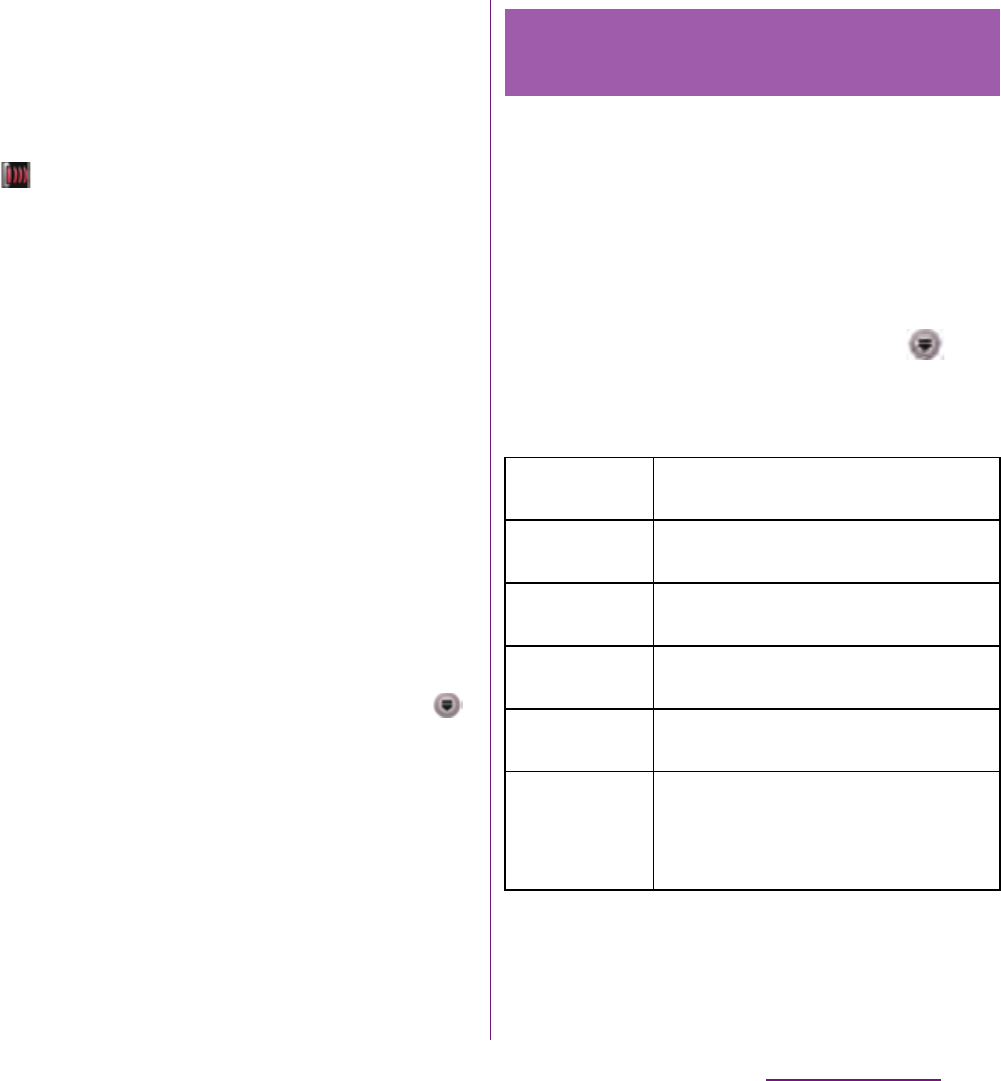
160
File management
・
If the terminal receives a call during infrared
communication, data exchange is interrupted and
the incoming call screen appears.
・
If the set alarm time comes during infrared
communication, data exchange is interrupted and
the alarm starts to sound.
・
is displayed in the status bar during infrared
communication.
・
Up to 2MB of data of contacts
*
, Myself
*
, photos,
videos and music can be sent and received. It may
take a time to exchange data depending on the data
amount or device of other party.
・
Some data, such as data with copyright protection,
etc., cannot be played back on other devices.
・
Received data cannot be played back or saved
depending on the sender's device, data type or data
amount.
・
The received data is saved in the internal storage.
・
If "Notification tone ON" is set with the Infrared
application, when sending/receiving data is
complete, it is notified by notification tone set in
"Selecting a notification ringtone" (P.121). For details
on the notification tone volume settings, see
"Adjusting each sound volume" (P.120). Notification
tone is muted while silent mode is set. To switch on/
off notification tone, from the Home screen, tap
and tap [Infrared]
ut
, then tap [Notification
tone ON]/[Notification tone OFF].
* You cannot send some information such as name
card data set in contacts.
Start Infrared application and select data to
send. Or select "Infrared" as a sending
method from the application menu for
Phonebook, Gallery or Music player.
■
Sending data using infrared
communication application
1
From the Home screen, tap ,
then tap [Infrared]
u
[Send].
2
Select a data type to send.
* You cannot send some information such as name
card data set in contacts.
Sending data via infrared
communication
Myself
*
Send Myself data including own
number.
Contact
*
Select an item from the contact list
screen and send.
All contacts
*
Enter authentication passcode to
send.
Picture
Select an image from an album in the
Gallery and send.
Video
Select a video from an album in the
Gallery and send.
Audio
Select a track from the Artists in the
Music player or record a voice
message using the voice recorder to
send.

161
File management
■
Sending data from an application
menu
1
From the application menu, tap
[Share]
u
[Infrared].
・
To send 1 phonebook entry, from the
Home screen, tap
u
[Phonebook]
u
[(a phonebook entry to
send)]
ut
and tap
[Share]
u
[Infrared].
・
To send all phonebook entries, from the
Home screen, tap
u
[Phonebook]
ut
and tap
[Others]
u
[Import/Export]
u
[Share
phonebook data]
u
[Infrared], then
enter the same authentication
passcode as that of the recipient and
tap [OK].
❖
Information
・
You cannot send two or more images, videos, or
audio data at a time.
・
You can use Infrared widget on the Home screen to
send Myself easily.
・
You cannot send some information such as name
card data set in phonebook.
1
From the Home screen, tap ,
then tap [Infrared]
u
[Receive]/
[Receive several].
・
Enter authentication passcode if you
select "Receive several".
2
When receiving data is completed,
tap [Yes] and store received data.
・
If you received contacts, you can select
saving location.
❖
Information
・
You cannot receive two or more images, videos, or
audio data at a time.
・
You may not be able to save contacts if the phone
memory becomes low.
・
A file name may be changed when saving. A file
named with 127 characters or more (Unicode) may
not be saved properly.
・
You can use Infrared widget on the Home screen to
receive a file easily.
Receiving data via infrared
communication

162
File management
The Bluetooth function creates a wireless
connection to other Bluetooth devices, for
example, handsfree devices. A range within
10 meters, with no solid objects in between,
is recommended. You must turn on the
Bluetooth function to communicate with
Bluetooth devices. You may also have to
make pair setting for the terminal and
Bluetooth device.
❖
Information
・
By default, Bluetooth function is off. If you turn
Bluetooth on and then turn off the terminal,
Bluetooth function turns off. When you turn on the
terminal again, Bluetooth function turns on
automatically.
・
When you do not use Bluetooth function, turn it off
to save the battery.
■
Reception interference caused by
wireless LAN devices
The terminal's Bluetooth function and
wireless LAN devices use the same
frequency band (2.4GHz). If you use the
terminal near a wireless LAN device,
reception interference may occur or the
communications speed may lower. Also,
you may hear noise or have a connection
problem. In these cases, do the following:
・
Keep the Bluetooth device 10 meters or
more away from a wireless LAN device.
・
Within 10 meters, turn off either the
Bluetooth device or the wireless LAN
device.
* The terminal does not communicate
wirelessly with all types of Bluetooth
devices. Bluetooth DUN is not supported.
1
From the Home screen, tap
t
.
2
Tap [Settings]
u
[Wireless &
networks].
3
Mark [Bluetooth] checkbox.
・
appears on the status bar and
Bluetooth function turns on.
4
Tap [Bluetooth settings].
5
Mark [Discoverable] checkbox.
・
The terminal becomes detectable by
other Bluetooth devices for 120
seconds.
Using Bluetooth function
Making the terminal detectable
with the Bluetooth function on

163
File management
You can name the terminal. The name
appears on Bluetooth devices when you use
the Bluetooth function.
1
Make sure that the Bluetooth
function is on.
2
From the Home screen, tap
t
.
3
Tap [Settings]
u
[Wireless &
networks]
u
[Bluetooth
settings]
u
[Device name].
4
Enter a name.
5
Tap [OK].
By making pair setting for the terminal and
another Bluetooth device, you can use the
device such as Bluetooth handsfree headset
etc. connecting to the terminal to make and
receive calls.
Once you have made pair setting for the
terminal and a Bluetooth device, the setting
is saved. When making pair setting for the
terminal and a Bluetooth device, you may
need to enter a passkey (PIN). The terminal
automatically tries the generic passkey
"0000". If this passkey does not work, see the
documentation of your Bluetooth device. You
do not need to re-enter the passkey the next
time you connect to a paired Bluetooth
device already set.
You cannot make pair setting for the terminal
and two Bluetooth headsets. However, you
can pair with two or more Bluetooth devices
of different profiles. The terminal supports
the following Bluetooth profiles: A2DP,
AVRCP, HFP, HSP, OPP, PBAP, and SPP.
Entering the terminal's name Making pair setting for the
terminal and Bluetooth device

164
File management
1
From the Home screen, tap
t
.
2
Tap [Settings]
u
[Wireless &
networks]
u
[Bluetooth settings].
3
Tap [Scan for devices].
・
A list of detected Bluetooth devices
appears.
4
Tap a Bluetooth device name to
pair with the terminal.
5
If necessary, enter the passkey
(PIN).
・
You can use the Bluetooth device that
has been paired. The pairing and
connection status appear below the
device name in the Bluetooth device
list.
・
Some Bluetooth devices make
connections continuously after making
pair setting.
❖
Information
・
Make sure that the Bluetooth function and Bluetooth
detection function of the target device are on.
・
When you make pair setting with the Bluetooth
device supporting Secure Simple Pairing (SSP)
function, a passkey appears on the screen. Check the
passkey and make the pair setting.
1
From the Home screen, tap
t
.
2
Tap [Settings]
u
[Wireless &
networks]
u
[Bluetooth settings].
3
Touch and hold a Bluetooth device
name you want to connect.
・
Touch and hold a device with "Pair with
this device" displayed under the device
name.
4
Tap [Pair & connect].
・
If the pairing is complete, the
connection status appears below the
device name in the Bluetooth device
list. While connecting to a device,
appears in the status bar.
Connecting the terminal with
another Bluetooth device

165
File management
1
From the Home screen, tap
t
.
2
Tap [Settings]
u
[Wireless &
networks]
u
[Bluetooth settings].
3
Touch and hold the currently
connected Bluetooth device name.
・
The pairing and connection status is
shown below the connected device
name.
4
Tap [Disconnect].
・
Alternatively, tap the device name and
tap [OK] on the confirmation screen to
disconnect. The display under the
device name changes to "Paired but
not connected" while the pair setting
remains set. To reconnect, tap the
device name.
1
From the Home screen, tap
t
.
2
Tap [Settings]
u
[Wireless &
networks]
u
[Bluetooth settings].
3
Touch and hold the currently
connected Bluetooth device name.
4
Tap [Disconnect & unpair].
・
Connection disconnects and the pair
setting is canceled.
❖
Information
・
When the terminal is only set to pair with Bluetooth
device (not connected), "Unpair" appears.
Deactivating the connection of
a Bluetooth device
Canceling the pair setting of a
Bluetooth device
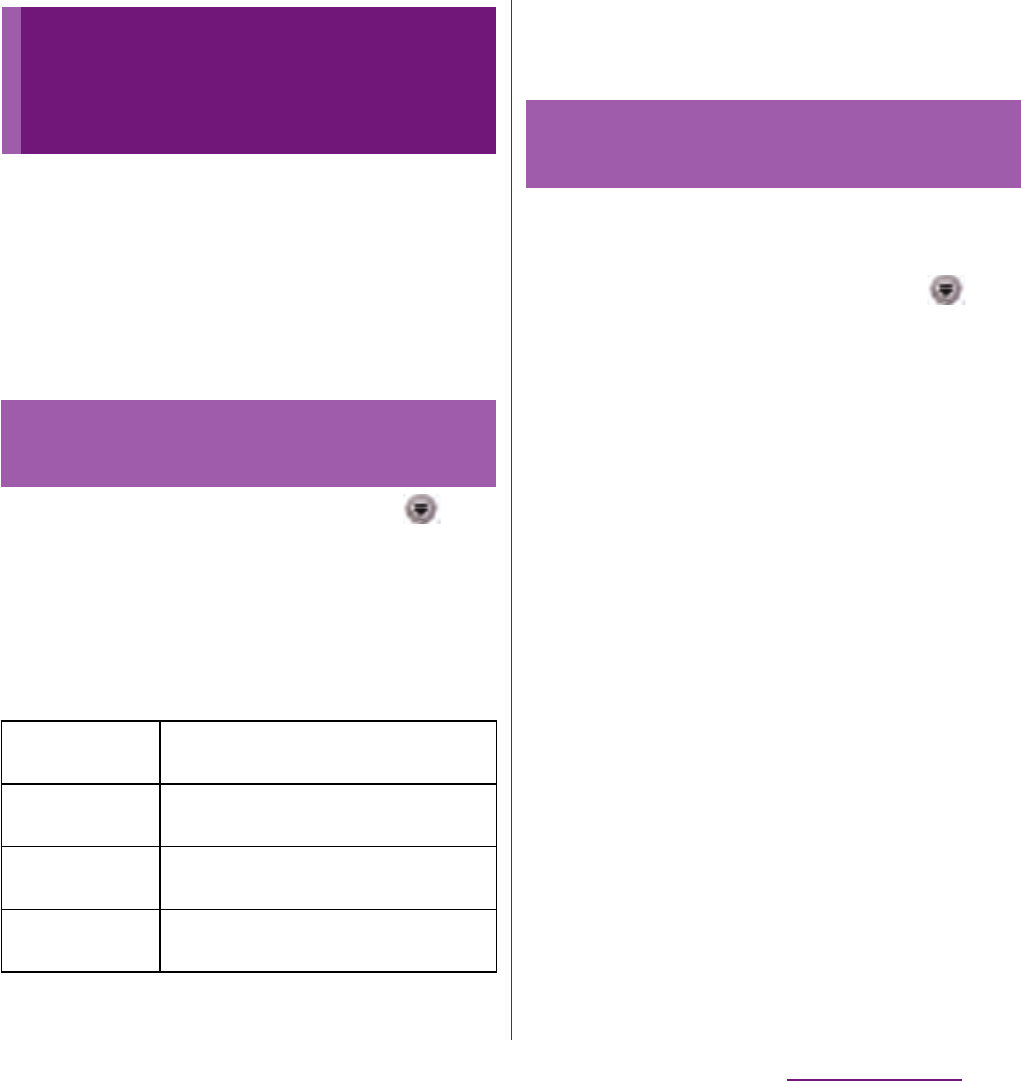
166
File management
With Media server, you can share media files
with other client (DLNA: Digital Living
Network Alliance) devices using Wi-Fi
function.
Set Wi-Fi connection (P.112) with another
client device.
1
From the Home screen, tap ,
then tap [Connected devices].
・
If you activate for the first time,
"Welcome!" screen appears. Tap [Done].
2
Tap
t
, then tap [Media server].
・
You can set the following options.
❖
Information
・
Tap
t
to set Wi-Fi connection or check help.
Set Wi-Fi connection with a DLNA device to
allow access from the terminal in advance.
1
From the Home screen, tap ,
then tap [Connected devices].
・
If the device name appears in the server
list, go to Step 4.
2
Tap [Wireless & networks] to mark
[Wi-Fi] checkbox.
3
Tap
x
.
・
Go back to "Connected devices" screen.
4
Tap the device name displayed in
the server list and tap the desired
category folder.
5
Tap a media file to play it.
Sharing files with DLNA
devices via Connected
devices (Media server)
Setting Connected devices
(Media server)
Media server
settings
Rename the terminal (server)
displayed on a client device.
Share contents
Set to connect from a client device
to the terminal via Wi-Fi.
Pending
devices
Manage client devices waiting
access permissions.
Registered
devices
Manage client device registered to
the terminal.
Playing media files in the DLNA
device with the terminal

167
File management
Set Wi-Fi connection on a DLNA device in
advance.
1
From the Home screen, tap ,
then tap [Connected devices].
2
Tap
t
, then tap [Media server]
to mark [Share contents]
checkbox.
3
Tap [OK] to mark [Wi-Fi] checkbox.
・
"Media server turned on" appears in the
status bar.
4
Tap
y
and tap and [Gallery].
・
Album list screen appears.
5
Tap an album, then tap a file you
want to play.
6
Tap
t
and [Play on].
・
A "Play on device" screen appears.
7
Tap a device displayed on the "Play
on device" screen.
・
The file is played by a DLNA device.
Playing a media file in the
terminal with a DLNA device

168
Applications
Applications
You can shoot still picture and video by
tapping the shutter icon or screen or using
the camera key (
k
). You can hold the
camera horizontally or vertically to shoot still
pictures (when shooting with 3D Sweep
Panorama/Sweep Multi Angle/Sweep
Panorama, hold the camera horizontally). For
recording videos, screen display supports
landscape only. Still pictures and videos are
saved automatically in the internal storage or
a microSD card.
・
Insert a microSD card before using the
camera. All pictures or videos that you
capture on the terminal are stored into the
internal storage or a microSD card. You
cannot take a photo while the terminal is
reading/writing data, for example transferring
a file from Media Go.
・
If you use microSD card with an i-mode
compatible terminal, photos and videos shot
by the terminal cannot be shown.
・
Avoid copyright infringements when you
handle photos, videos, or sound recorded
using the terminal, e.g. copy/edit. In addition,
avoid rights infringements of portraits by
using these photos without consent, altering
them or by other means. Note that capturing
or recording a stage performance,
entertainment or exhibition may be
prohibited even if for personal use.
■
About the Copyright and Portrait rights
Objects, such as movies, still images, and sounds,
recorded using the terminal are prohibited by the
copyright law from use without consent of the
copyright holders, unless intended for personal use
or any other purpose permitted by law. Also, using
or transformation of other person's portrait or
name without his or her permission may violate the
portrait right. When you present recorded images
or sounds in a public place such as on an Internet
home page, make sure to be aware of the copyright
and portrait right. Note that some performances,
shows, and exhibitions may not allow
photography, movie shooting, or sound recording
even for personal use. Transmission of images
related to copyright or beyond the scope provided
in the copyright law is not available.
Please be considerate of the privacy of
individuals around you when taking and
sending photos using camera-equipped
mobile phones.
If you cause the public any trouble using the
terminal, you may be punished under law or
regulations (for example, nuisance
prevention ordinance).
Shooting with the camera
Before using the camera

169
Applications
Note on 3D Sweep Panorama/Sweep
Multi Angle/Sweep Panorama
・
In the following cases, 3D Sweep Panorama/
Sweep Multi Angle/Sweep Panorama do not
work properly.
- Shooting a moving object
- Shooting the main object that is too close to
the camera
- Shooting an object with repetition of the
same pattern such as a sky, beach, grass, etc.
- Shooting a big object
- Shooting an object with constantly
changing pattern such as a wave, waterfall,
etc.
・
If shooting angle does not increase enough
for 3D Sweep Panorama/Sweep Multi Angle/
Sweep Panorama within a certain period of
time, the part which was not taken is recorded
in gray.
To avoid this, move the camera faster when
shooting.
・
Because two or more images are joined
together, joints may not recorded smoothly.
・
Images may be blurred or may not be taken in
a dark scene.
・
Under the flickering light source such as a
fluorescent light, you may not be able to
shoot properly since brightness or color
balance of joined image may be unstable.
・
If brightness, color balance and focus point of
whole image to be taken with 3D Sweep
Panorama/Sweep Multi Angle/Sweep
Panorama are radically different from those of
the focused image, image may not be shot
properly.
・
In the following cases, shooting for 3D Sweep
Panorama/Sweep Multi Angle/Sweep
Panorama may be stopped.
- Moved the camera too fast/too slow
- Blurred too much
- Moved the camera in the opposite direction
of the shooting
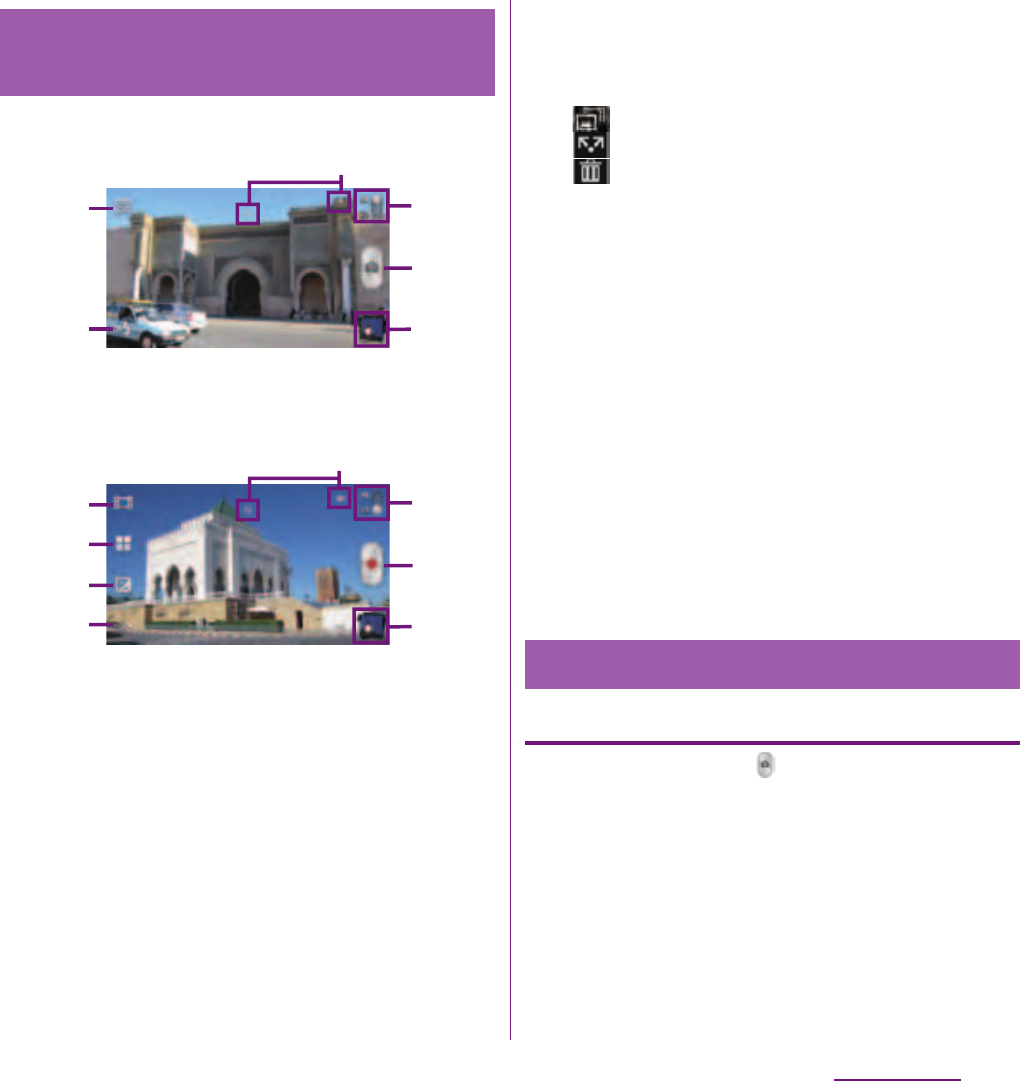
170
Applications
■
Still picture shooting screen
■
Video shooting screen
a
Select capturing mode
b
Flash setting (still picture)
c
Display area of status icons showing selected
settings
d
Switch between still and video camera
e
Shutter (still picture)
Start/Stop recording (video)
f
Recent shooting history
・
Touch the icon on the shooting screen and flick it
to the left of the screen (up when in portrait view)
to display the last 5 shots.
・
Tap to open viewing/playback screen for still
pictures and videos.
・
Tap the icon displayed by touching and holding
to perform the following operations.
: View playback screen of photos and videos
: Share
: Delete
g
Select scenes
h
Exposure value setting
i
Turn Photo light On/Off
❖
Information
・
On the shooting screen, press
m
to zoom in/
out.
・
On the playback screen of the still pictures and
videos taken recently, tap
t
to display "Play on",
"Share", "Delete", "Slide show", "Details", "Set as",
"More", "Edit video".
* "Set as" and "More" are displayed on the still
picture viewing screen, "Details" and "Edit video"
are displayed on the video playback screen.
・
To end the camera, tap
x
.
Shooting a still picture
Tap the shutter icon ( ) or screen, or use
camera key (
k
) to shoot a still picture.
Shot still pictures are automatically saved in
the internal storage/microSD card.
Shooting screen and key
operations
a
b
d
e
f
c
c
i
d
e
f
a
g
h
Shooting still pictures

171
Applications
1
From the Home screen, press and
hold
k
for over a second.
・
The still picture shooting screen (P.174)
appears.
■
Tapping the shutter icon ( )
Tap the shutter icon ( ) on the shooting
screen.
・
To take a photo using auto-focus
function, touch and hold the shutter
icon ( ) and release your finger when
the focus frame turns green and sound
beeps. The photo is taken as soon as
you release the finger. If the focus frame
turns red, auto-focus does not operate
correctly.
■
Tapping the screen
On the shooting screen, tap
tu
[Capturing method]
u
[Touch
capture]
u
Tap the screen.
・
To take a photo using auto-focus
function, touch and hold the screen
and release your finger when the focus
frame turns green and sound beeps.
The photo is taken as soon as you
release the finger. If the focus frame
turns red, auto-focus does not operate
correctly.
■
Using the camera key (
k
)
On the shooting screen, press
k
.
・
Even if "Capturing method" (P.185) is set
to "On-screen button" or "Touch
capture", you can press
k
to shoot.
・
To take a photo using auto-focus
function, press
k
half way and
when the focus frame turns green,
press
k
the rest of the way down
until it stops. If the focus frame turns
red, auto-focus does not operate
correctly. Press
k
halfway again.
❖
Information
・
Auto-focus cannot be operated if "Focus mode"
(P.183) is set to "infinity".
・
When you connect Stereo Headset with Microphone
(Sample), commercially available earphone set or
other Bluetooth device, shutter sound may be softer.
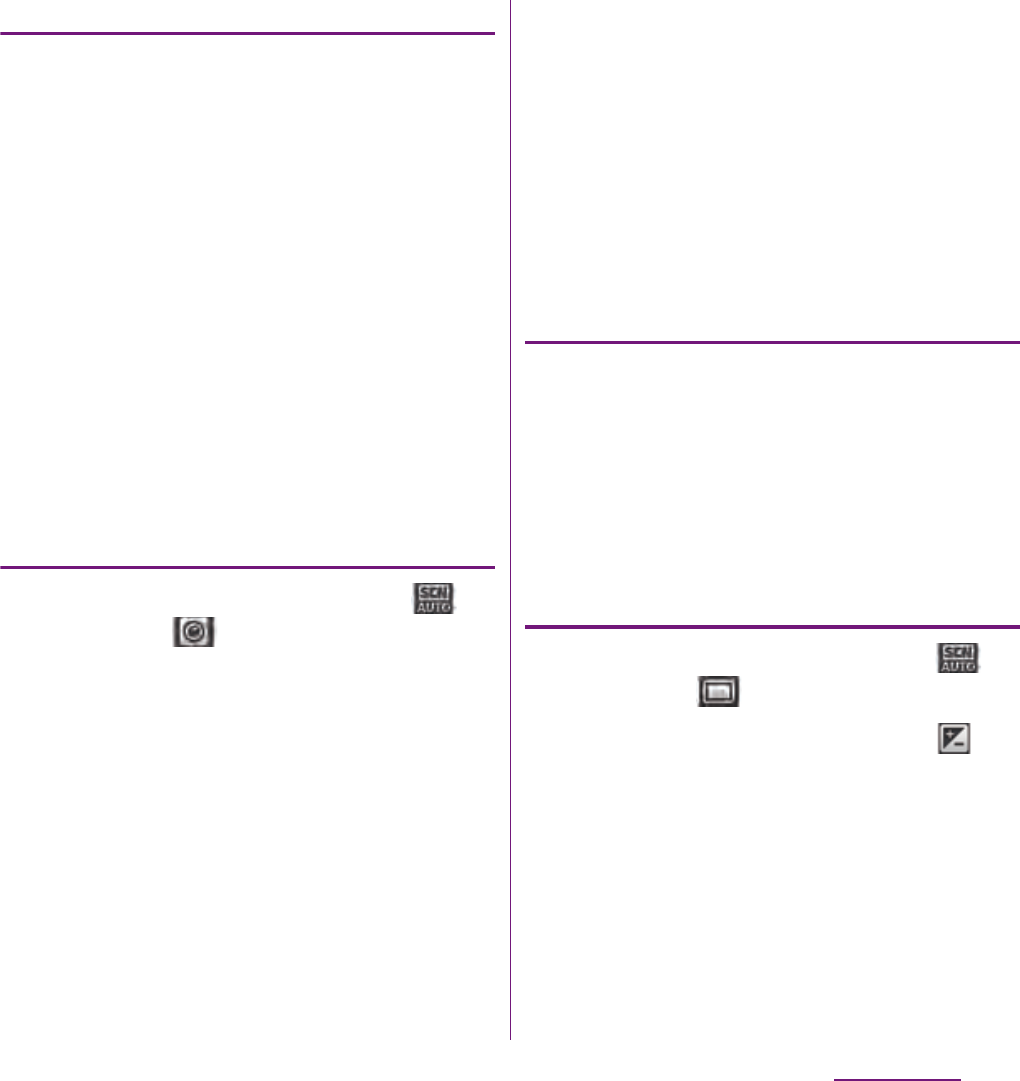
172
Applications
Shooting using Quick launch
1
On the key/SIM/screen unlock
screen, press and hold
k
for
over a second.
・
The camera is activated to shoot a
photo immediately. Shot pictures are
automatically saved in the internal
storage/microSD card.
❖
Information
・
"Quick launch" (P.185) is set to "Launch and capture"
by default. The operation of Quick launch can be
selected from "Launch and capture", "Launch only",
and "Off". When "Quick launch" is set to "Off", pressing
and holding
k
for over a second on the key/SIM/
screen unlock screen does not activate the camera.
Using Front camera to shoot pictures
1
On the shooting screen, tap ,
then tap (Front camera).
2
Shoot a picture.
・
For information on how to shoot
pictures, see "Shooting a still picture"
(P.174).
❖
Information
・
For using Front camera, "Resolution", "Self-timer",
"Smile detection", "Image stabilizer", "Geotagging",
"Capturing method", "Data storage" can be set. Other
"Still camera setting" (P.181) are not supported by
Front camera.
- "Resolution" can be selected from "1MP 16:9", "1MP
4:3" for Front camera.
- The settings other than "Resolution" take over the
camera settings set at the time when switching.
Using zoom
1
On the shooting screen, press
m
.
❖
Information
・
Zoom is not available while using Front camera/3D
Sweep Panorama/Sweep Multi Angle/Sweep
Panorama.
Adjusting Exposure value
1
On the shooting screen, tap ,
then tap (Normal).
2
On the shooting screen, tap
(Exposure value).
3
Tap or drag the bar to adjust the
exposure value.

173
Applications
You can use face detection to bring an off-
center face into focus. The camera
automatically detects up to 5 faces at a time.
A yellow frame indicates a face to focus on,
and white frames indicate the rest. An
appropriate face is determined by distance
from the camera and off-center balance, and
is focused automatically. You can also tap one
of the frames to select which face should be
in focus.
Setting face detection
1
From the Home screen, press and
hold
k
for over a second.
・
The still picture shooting screen (P.174)
appears.
2
On the shooting screen, tap ,
then tap (Normal).
3
On the shooting screen, tap
t
,
then tap "Focus mode" (P.183).
4
Tap (Face detection).
❖
Information
・
"Scenes" (P.181) is set to "Landscape"/"Night scene"/
"Document", Face detection cannot be used.
Taking a photo using face detection
1
With Face detection set, point the
camera at the subject.
・
Each detected face is framed (up to 5
faces).
2
Tap the frame you want to focus on
or let the camera select which face
to focus on without tapping.
・
A yellow frame shows the face in focus.
3
Shoot a picture.
・
For information on how to shoot
pictures, see "Shooting a still picture"
(P.174).
・
The photo is taken as soon as focus is
set. Shot pictures are automatically
saved in the internal storage/microSD
card.
Face detection

174
Applications
Smile detection allows you to capture a face
just as it smiles. The camera detects up to 5
faces and selects 1 face for smile detection
and auto focus. A yellow frame shows which
face is selected. When the selected face
smiles, the frame turns to green and the
camera automatically takes a photo.
Setting smile detection
1
From the Home screen, press and
hold
k
for over a second.
・
The still picture shooting screen (P.174)
appears.
2
On the shooting screen, tap
t
,
then tap "Smile detection" (P.183).
・
You can select smile level for the smile
detection feature from "Big smile"/
"Average smile"/"Small smile"/"Off". Set
"Off" to cancel smile detection.
Taking a photo using smile detection
1
With Smile detection set, point the
camera at the subject.
・
Each detected face is framed (up to 5
faces).
・
The camera selects which face to focus
on. A yellow frame shows the face in
focus.
2
The camera automatically takes
the photo when the subject in
focus smiles.
・
Shot pictures are automatically saved in
the internal storage/microSD card.
・
If no smile is detected, operate the
steps in "Shooting a still picture" (P.174)
to shoot a picture.
Smile detection
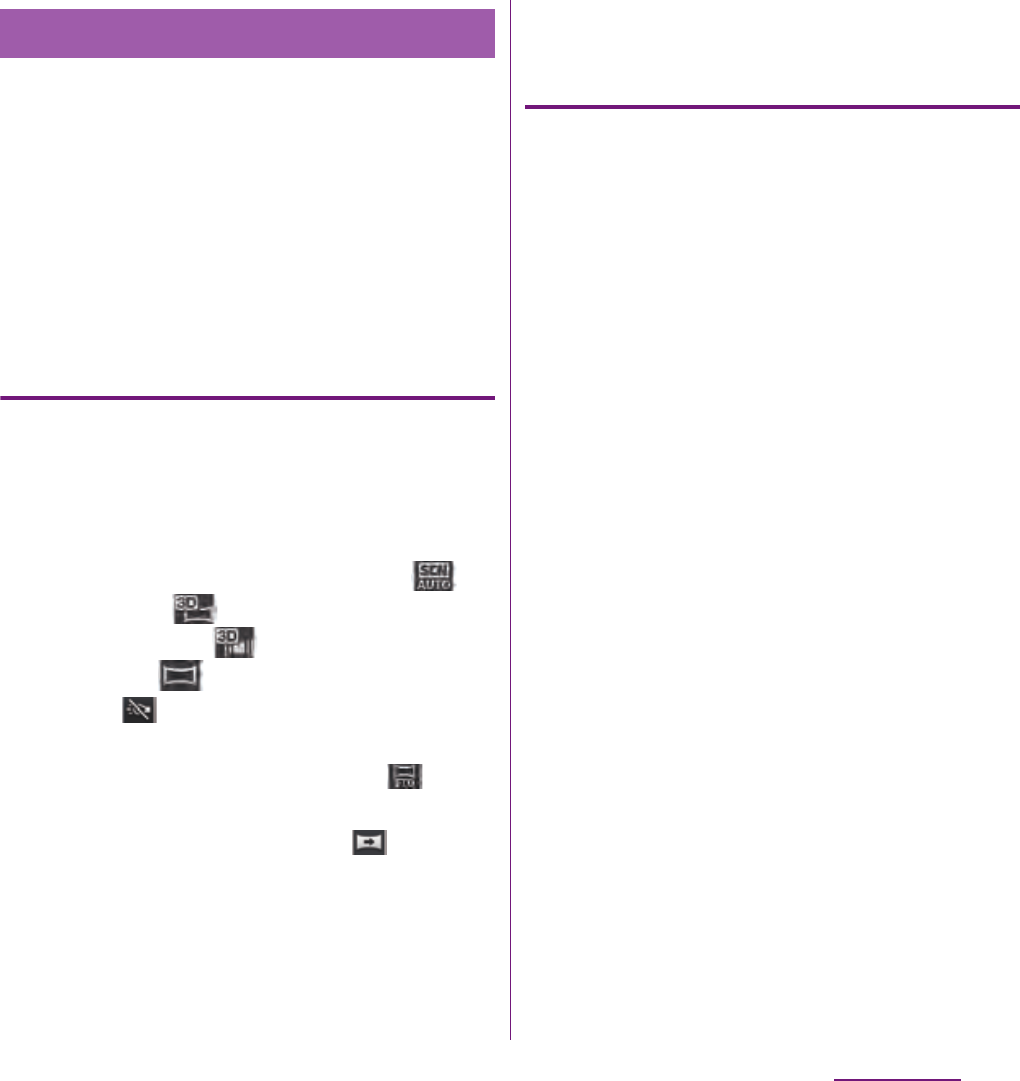
175
Applications
Use Sweep Panorama to shoot panoramic
image with wide angle.
Aligning the white frame on the screen with
the black frame, move the camera slowly
toward the set shooting direction to shoot.
Using 3D Sweep Panorama allows you to
shoot 3D pictures.
Setting 3D Sweep Panorama/Sweep
Multi Angle/Sweep Panorama
1
From the Home screen, press and
hold
k
for over a second.
・
The still picture shooting screen (P.174)
appears.
2
On the shooting screen, tap ,
then tap (3D Sweep
Panorama)/ (Sweep Multi
Angle)/ (Sweep Panorama).
・
Tap to select "On" or "Off" for "Photo
light" (P.185).
・
For 3D Sweep Panorama, tap to
select "Panorama image size" (P.182).
・
For Sweep Panorama, tap to select
"Shooting direction" (P.185).
Using 3D Sweep Panorama/Sweep
Multi Angle/Sweep Panorama to
shoot pictures
1
With 3D Sweep Panorama/Sweep
Multi Angle/Sweep Panorama set,
point the camera at the subject.
2
Shoot a still picture.
・
For information on how to shoot
pictures, see "Shooting a still picture"
(P.174).
・
A white frame and big black frame
appear on the screen.
3
Aligning the white frame with the
black frame, slowly move the
camera from left to right.
・
If you change shooting direction for
Sweep Panorama, slowly move the
camera in the set direction.
・
Shot pictures are saved automatically in
the internal storage/microSD card.
Using Sweep Panorama

176
Applications
1
From the Home screen, press and
hold
k
for over a second.
・
The still picture shooting screen (P.174)
appears.
2
On the shooting screen, tap
t
,
then tap the setting item.
・
Several setting icons are displayed on
the shooting screen in advance. The
displayed setting icons change
depending on the setting conditions.
・
While using 3D Sweep Panorama/
Sweep Multi Angle/Sweep Panorama,
tap the setting item icon displayed on
the shooting screen to change the
setting.
・
For setting items and icons, see "Still
camera setting" (P.181).
3
Tap an option in the selected
setting.
・
If you change setting options, icons
displayed on the shooting screen
change to the set items.
❖
Information
・
On the shooting screen, tap
t
to display setting
items, which you can touch and hold and drag to the
left (up when the shooting screen is in portrait view)
to change setting item icons displayed in the
shooting screen.
・
To delete a setting item icon displayed on the
recording screen, touch and hold a setting item icon
and drag to displayed in the center of the
screen.
・
"Capturing mode" (P.181) icons cannot be changed
or deleted.
・
Setting item icons cannot be changed or deleted
while using Front camera/3D Sweep Panorama/
Sweep Multi Angle/Sweep Panorama.
Changing the recording
settings

177
Applications
Still camera setting
Item Icon Description
Capturing
mode
Select the shooting method.
Scene
recognition
The camera determines
most suitable scene
effect. A corresponding
scene icon appears
when the scene is
recognized.
Normal A standard shooting
mode.
Front
camera
P.176
3D
Sweep
Panorama
P.179
Sweep
Multi Angle
Sweep
Panorama
Scenes
Use Scenes to quickly set up the
camera for various scene conditions.
Use when "Capturing mode" is set to
"Normal".
OFF Adjust color shade or
brightness automatically.
Portrait Settings are optimized to
give brighter and
warmer skin tones.
Scenes
Landscape
Shoot landscape
depicting trees with vivid
color and focusing on
distant objects.
Night
scene
Shoot a crisp and clear
night scene. Due to long
exposure time, be careful
not to shake camera.
Night
portrait
Suitable for shooting
persons against the
nightscape background.
Due to long exposure
time, be careful not to
shake camera.
Beach
and snow
Reconstruct beach and
snowy scene brightly
and vividly.
Sports To shoot fast-moving
object, shorten exposure
time to minimize motion
blurring.
Party Shoot an indoor picture
creating good
atmosphere of indoor
lighting. Due to long
exposure time, be careful
not to shake camera.
Document
Use for shooting text or
graphics. It allows to
capture a clear, bright,
and easy to read text.
Item Icon Description
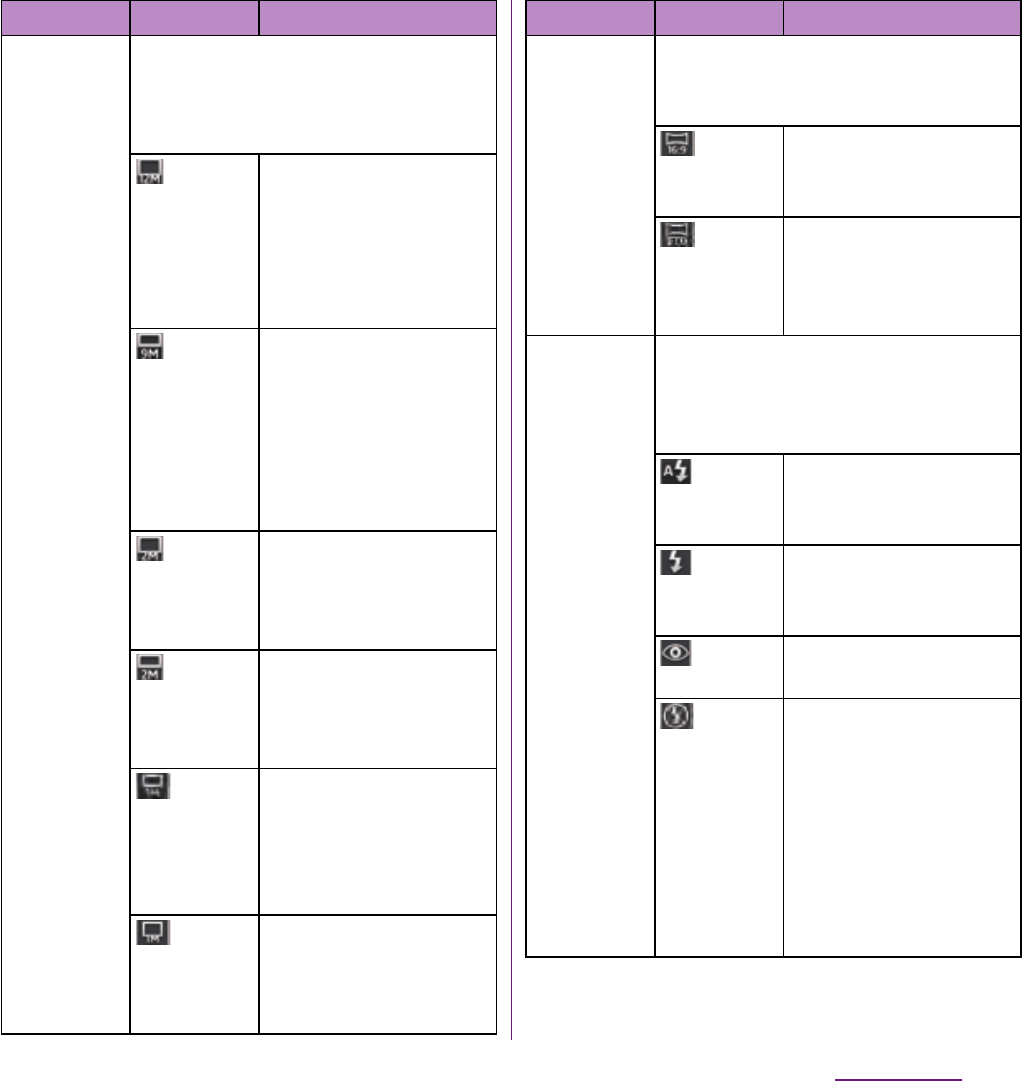
178
Applications
Resolution
Select image sizes and aspect ratios
before shooting. An image with a
higher resolution requires more
memory.
12MP
4:3
12 megapixel image size
with 4:3 aspect ratio.
Suitable for viewing on
normal size screen or
printing in high
resolution.
9MP
16:9
9 megapixel image size
with 16:9 aspect ratio. A
high resolution wide-
screen format. A higher
resolution than full HD.
Suitable for viewing on
wide-screen.
2MP
4:3
2 megapixel image size
with 4:3 aspect ratio.
Suitable for viewing on
normal size screen.
2MP
16:9
2 megapixel image size
with 16:9 aspect ratio.
Suitable for viewing on
wide-screen.
1MP
16:9
1 megapixel image size
with 16:9 aspect ratio.
Use when "Capturing
mode" is set to "Front
camera".
1MP
4:3
1 megapixel image size
with 4:3 aspect ratio. Use
when "Capturing mode"
is set to "Front camera".
Item Icon Description
Panorama
image size
Set image size for 3D Sweep Panorama
Use when "Capturing mode" is set to
"3D Sweep Panorama".
16:9 16:9 aspect ratio. Suitable
for viewing on wide-
screen.
Standard
Standard size for
Panorama image.
Suitable for Panorama
shooting.
Flash
Set whether to turn on the flash when
shooting in the place where lighting
conditions are poor or there is a
backlight.
Auto Turn on the flash
automatically according
to the brightness.
Fill flash Always turn on the flash
regardless of the
brightness.
Red-eye
reduction
Reduce red-eye effect
caused by the flash.
Off The flash does not turn
on.
・
Sometimes still picture
quality can be better
without the flash.
When you do not turn
on the flash, use the
self-timer to avoid
blurring still picture.
Item Icon Description

179
Applications
Self-timer
Use it to take self-portraits, or group
photos where everyone can be in the
photo. You can also use the self-timer
to avoid camera shake.
On
(10 sec.)
Tap or press
k
to
shoot 10 seconds later.
On
(2 sec.)
Tap or press
k
to
shoot 2 seconds later.
Off Tap or press
k
to
shoot immediately.
Smile
detection
Shoot faces at the moment they smile.
The camera detects up to 5 faces and
selects 1 face for smile detection and
auto focus. When the selected face
smiles, the camera automatically
shoots.
・
You can select smile level for the
smile detection feature.
Big
smile
Shoot when a big smile
is detected.
Average
smile
Shoot when a smile is
detected.
Small
smile
Shoot when even a tiny
smile is detected.
Off Cancel smile detection.
Item Icon Description
Focus mode
Set focus controls. Use when
"Capturing mode" is set to "Normal".
Single
autofocus
The camera
automatically focuses on
the subject.
Multi
autofocus
The camera
automatically focuses on
several points on the
shooting screen. The
white focus frames turn
to green if focused on.
Face
detection
P.177
Infinity Use when shooting at a
distance. Focus on
subjects far away.
Subjects close to the
camera may be blurred.
Touch
focus
Tap an object on the
shooting screen. The
focus frame moves onto
the tapped place.
Exposure
value
P.176
Item Icon Description

180
Applications
ISO
Set ISO sensitivity. Shoot clear picture
reducing blur even in a place where
lightning is poor. Use when "Capturing
mode" is set to "Normal".
Auto Set to the appropriate
sensitivity between
" 100" and "
800".
100 Set sensitivity to 100.
200 Set sensitivity to 200.
400 Set sensitivity to 400.
800 Set sensitivity to 800.
White
balance
The white balance setting adjusts the
color balance according to the light
source. Use when "Capturing mode" is
set to "Normal".
Auto Adjust the color balance
automatically to the light
source.
Incandescent
Adjust the color balance
for lighting like
incandescent bulb.
Fluorescent
Adjust the color balance
for lighting like
fluorescent.
Daylight Adjust the color balance
for a sunny place.
Cloudy Adjust the color balance
for a cloudy sky or
shaded area.
Item Icon Description
Metering
Measure the brightness on the
shooting screen to determine a well-
balanced exposure automatically. Use
when "Capturing mode" is set to
"Normal".
Center Put emphasis at the
center of the shooting
screen and measure
photometry at whole
view finder to adjust the
exposure.
Average Adjust the exposure
based on the brightness
of the whole shooting
screen.
Spot Measure photometry
only at the center of the
shooting screen to adjust
the exposure.
Image
stabilizer
Compensate for photo blur caused by
small movements of the hand while
shooting. Use when "Capturing mode"
is set to "Normal".
On Reduce blur.
Off The stabilizer is not used.
Item Icon Description

181
Applications
Geotagging
Tag photos location information for the
shooting spot.
You need to mark "Use wireless
networks" (P.211) or "Use GPS satellites"
(P.211) checkbox in "Location &
security" settings beforehand. For
details on location information, see
"About location services" (P.209).
・
Geotag (location information)
enables to specify the shooting spot
of the photo.
On Location information is
added to the taken
photo.
Off Shooting location
cannot be viewed on a
map.
Capturing
method
Set the shooting method.
On-screen
button
Set whether to tap the
shutter icon on the
shooting screen or press
k
to shoot.
Touch
capture
Set whether to tap the
shooting screen or press
k
to shoot.
Camera key
only
Set to enable shooting
by pressing
k
.
Item Icon Description
Shooting
direction
Set shooting direction for Sweep
Panorama. Use when "Capturing mode"
is set to "Sweep Panorama".
Right Shoot moving the
camera from left to right.
Left Shoot moving the
camera from right to left.
Down Shoot moving the
camera downward.
Up Shoot moving the
camera upward.
Photo light
Use the photo light to shoot when
lighting conditions are poor or in
backlight. Use when "Capturing mode"
is set to "3D Sweep Panorama", "Sweep
Multi Angle", or "Sweep Panorama".
On The photo light turns on.
Off The photo light does not
turn on.
Quick
launch
On the key/SIM/screen unlock screen,
press and hold
k
for over a second
to activate the camera.
Launch
and capture
Activate the camera to
shoot a photo
immediately.
Launch
only
Activate the camera.
Off Cancel quick launcher.
Item Icon Description
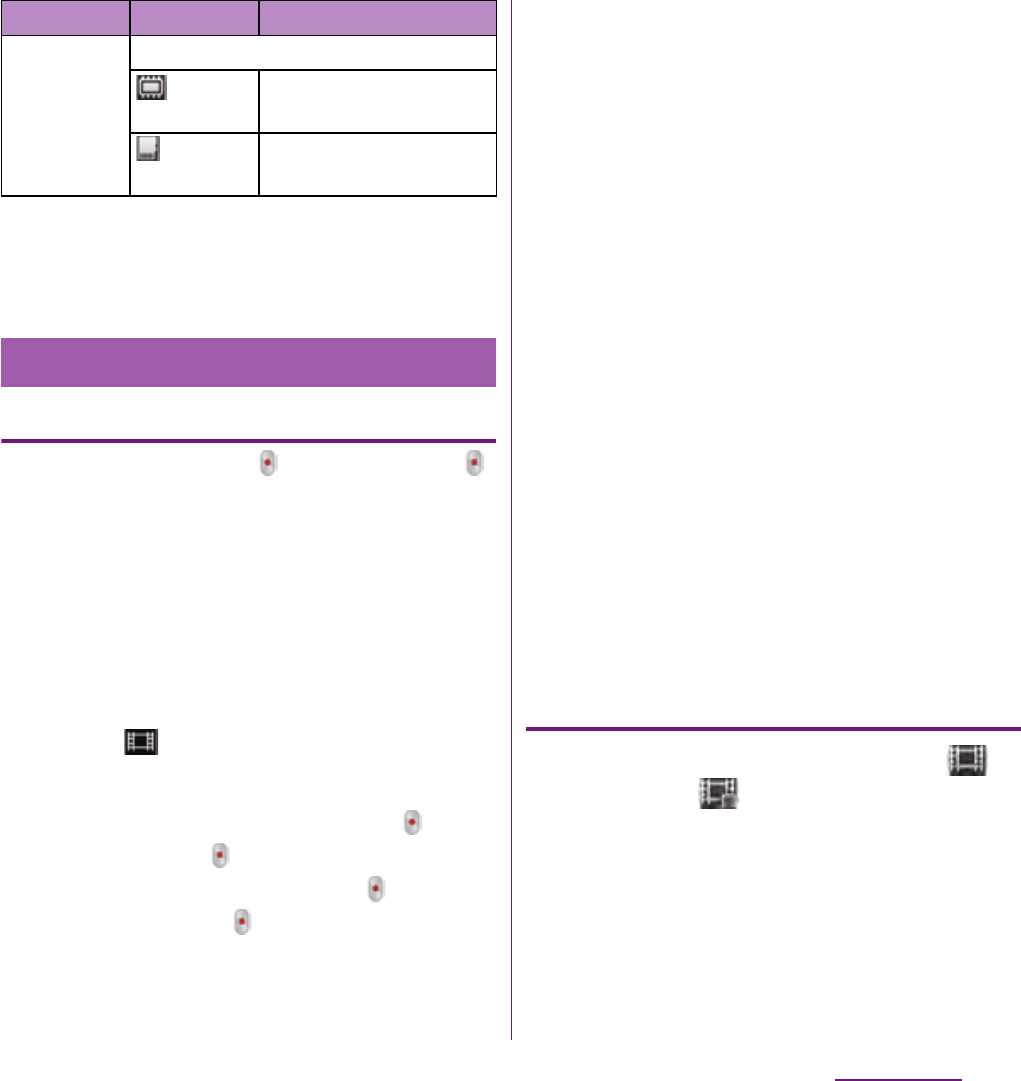
182
Applications
❖
Note
・
Some settings cannot be used in combination with
one another.
Recording
Tap the start recording ( )/stop recording ( )
icon or recording screen, or use camera key
(
k
) to record video. For video recording
screen, only landscape screen is supported.
Recorded data is automatically saved in the
internal storage/microSD card.
1
From the Home screen, press and
hold
k
for over a second.
・
Tap to display the video recording
screen (P.174).
■
Tapping the start recording ( )/stop
recording ( ) icon
On the recording screen, tap to start
recording
u
Tap to stop recording.
■
Tapping the screen
On the recording screen, tap
tu
"Capturing method"
u
"Touch
capture"
u
Tap the screen to start
recording
u
Tap the screen to stop
recording.
■
Using camera key (
k
)
On the recording screen, press
k
to
start recording
u
Press
k
to stop
recording.
・
Even if "Capturing method" (P.191) is set
to "On-screen button" or "Touch
capture", you can press
k
to start/
stop recording.
❖
Information
・
Do not cover the microphone with fingers etc. when
recording videos.
・
When you connect Stereo Headset with Microphone
(Sample), commercially available earphone set or
other Bluetooth device, shutter sound may be softer.
Using Front video camera to record
1
On the recording screen, tap ,
then tap (Front video).
2
Start/Stop recording.
・
For information on how to start/stop
recording, see "Recording" (P.186).
Data
storage
Set the saving location for shot images.
Internal
storage
Save shot images in the
internal storage.
SD card Save shot images in a
microSD card.
Recording videos
Item Icon Description

183
Applications
❖
Information
・
For using Front video camera, "Video size", "Self-
timer", "Microphone", "Capturing method", "Data
storage" can be set. Other "Video camera setting"
(P.188) are not supported by Front camera.
- The settings take over the video settings set at the
time when switching (if "Video size" is set to "Full
HD", the video size is changed to "HD 720p").
Adjusting Exposure value
1
On the recording screen, tap
(Exposure value).
2
Tap or drag the bar to adjust the
exposure value.
On the recording screen, tap the shooting
history at the bottom left or right to display
video, tap
t
and tap [Edit video] to crop
the part of video to save.
1
On the recording screen, tap the
shooting history to display video.
2
Tap
t
and tap [Edit video].
・
(Progress bar) appears at the bottom of
the screen.
3
Drag at the left of the progress
bar to the right, to the starting
point of cropping.
4
Drag at the right of the progress
bar to the left, to the end point of
cropping.
・
Tap the screen to play the cropped part
for check.
5
Tap [Save].
・
Tap [Cancel] to return to the video
playback screen without saving the
cropped video.
❖
Information
・
If "Video size" (P.189) is set to "Full HD", videos cannot
be cropped.
1
From the Home screen, press and
hold
k
for over a second.
・
Tap to display the video recording
screen (P.174).
2
On the video recording screen, tap
t
, then tap the setting item.
・
There are 4 setting icons on the
recording screen in advance. The
displayed setting icons change
depending on the setting conditions.
・
For setting items and icons, see "Video
camera setting" (P.188).
Cropping video Changing the recording
settings
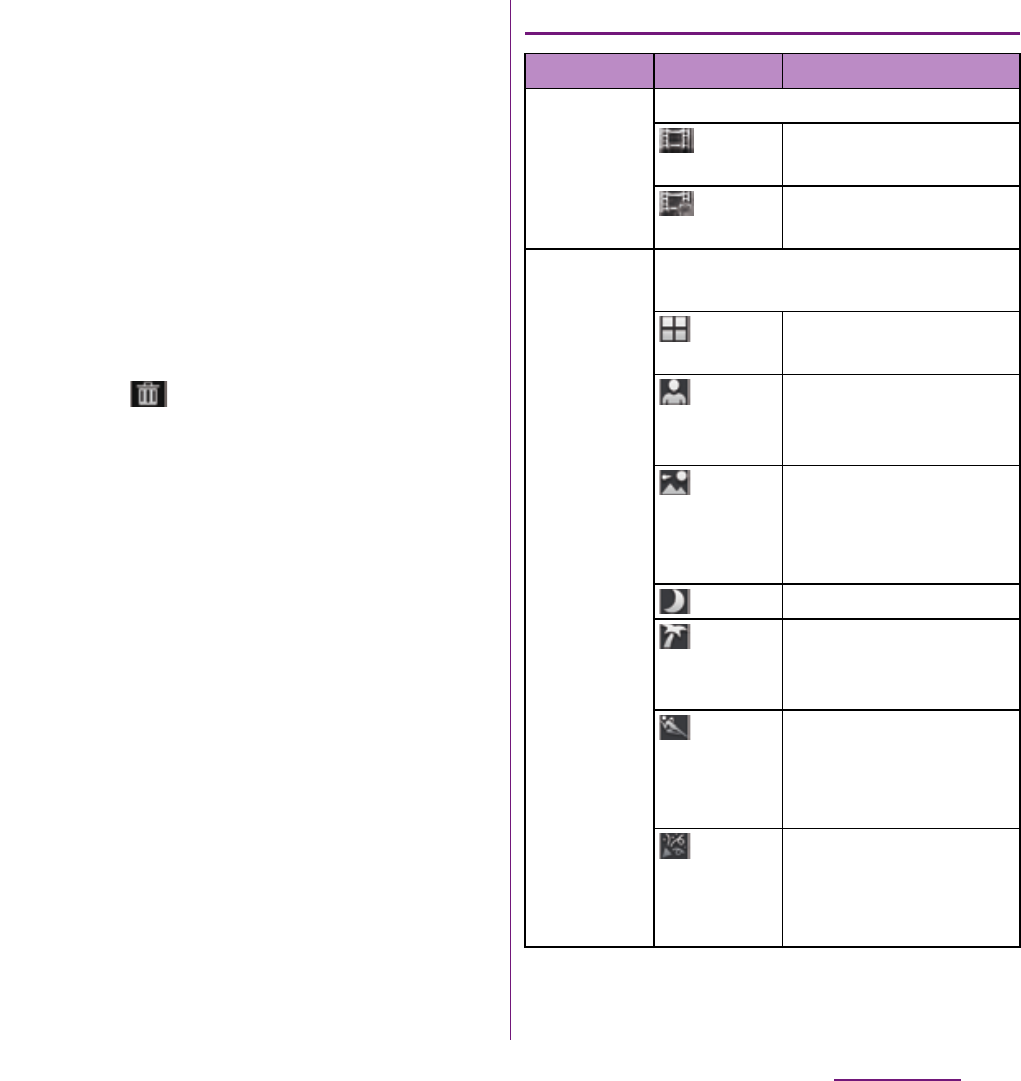
184
Applications
3
Tap an option in the selected
setting.
・
If you change setting options, icons
displayed on the shooting screen
change to the set items.
❖
Information
・
On the recording screen, tap
t
to display setting
items. If you touch and hold an item and then drag it
to the left, you can replace setting item icons
displayed on the recording screen.
・
To delete a setting item icon displayed on the
recording screen, touch and hold a setting item icon
and drag to displayed in the center of the
screen.
・
"Recording mode" (P.188) icons cannot be replaced
or deleted.
Video camera setting
Item Icon Description
Recording
mode
Select the recording method.
Video
camera
P.186
Front
video
P.186
Scenes
Use Scenes to quickly set up the
camera for various scene conditions.
Off Adjust color shade or
brightness automatically.
Portrait Settings are optimized to
give brighter and
warmer skin tones.
Landscape
Shoot landscape
depicting trees with vivid
color and focusing on
distant objects.
Night Suitable for dark places.
Beach
and snow
Reconstruct beach and
snowy scene brightly
and vividly.
Sports To record fast-moving
object, shorten exposure
time to minimize motion
blurring.
Party Shoot an indoor picture
creating good
atmosphere of indoor
lighting.
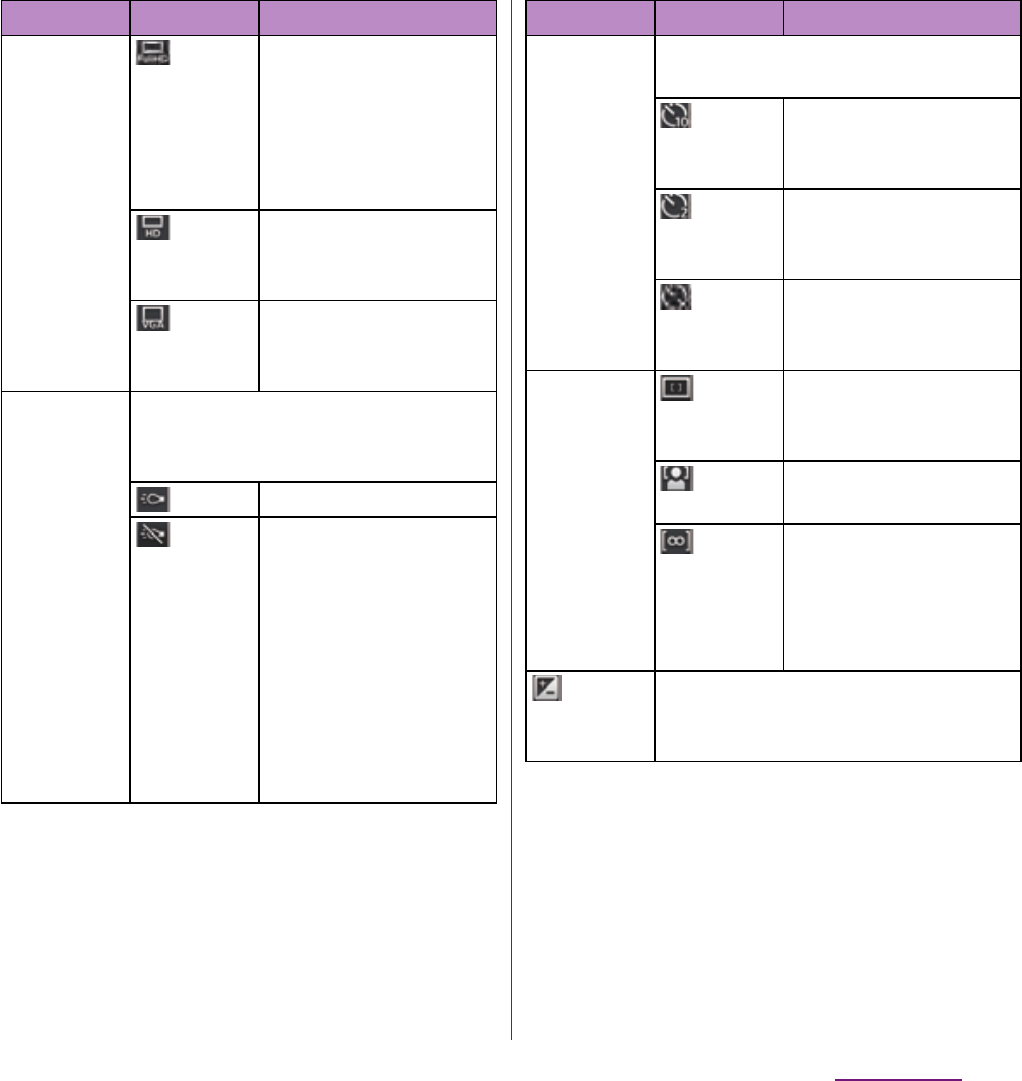
185
Applications
Video size
Full HD Full wide HD format with
16:9 aspect ratio.
1920
u
1080 pixels
Use when "Capturing
mode" is set to "Video
camera".
HD
720p
HD format with 16:9
aspect ratio.
1280
u
720 pixels
VGA VGA format with 4:3
aspect ratio.
640
u
480 pixels
Photo light
Use the photo light to record when
lighting conditions are poor or in
backlight.
On The photo light turns on.
Off The photo light does not
turn on. Sometimes the
video quality can be
better without a photo
light, even if lighting
conditions are poor.
Recording a good video
without using the photo
light requires a steady
hand.
Item Icon Description
Self-timer
Use it to record group videos where
everyone can be in the video.
On (10
sec.)
Tap or press
k
to
start recording 10
seconds later.
On (2
sec.)
Tap or press
k
to
start recording 2 seconds
later.
Off Tap or press
k
to
start recording
immediately.
Focus mode
Single
autofocus
The camera
automatically focuses on
the subject.
Face
detection
P.177
Infinity Use when shooting at a
distance. Focus on
subjects far away.
Subjects close to the
camera may be blurred.
Exposure
value
P.187
Item Icon Description

186
Applications
White
balance
The white balance setting adjusts the
color balance according to the light
source.
Auto Adjust the color balance
automatically to the light
source.
Incandescent
Adjust the color balance
for lighting like
incandescent bulb.
Fluorescent
Adjust the color balance
for lighting like
fluorescent.
Daylight Adjust the color balance
for a sunny place.
Cloudy Adjust the color balance
for a cloudy sky or
shaded area.
Item Icon Description
Metering
Measure the brightness on the
shooting screen to determine a well-
balanced exposure automatically.
Center Put emphasis at the
center of the shooting
screen and measure
photometry at whole
view finder to adjust the
exposure.
Average Adjust the exposure
based on the brightness
of the whole shooting
screen.
Spot Measure photometry
only at the center of the
shooting screen to adjust
the exposure.
Image
stabilizer
Compensate for movements of the
camera while recording a video.
On Reduce blur.
Off The stabilizer is not used.
Microphone
Select whether to pick up the
surrounding sound when recording
videos.
On Pick up the surrounding
sound when recording
videos.
Off Do not pick up the
surrounding sound
when recording videos.
Item Icon Description
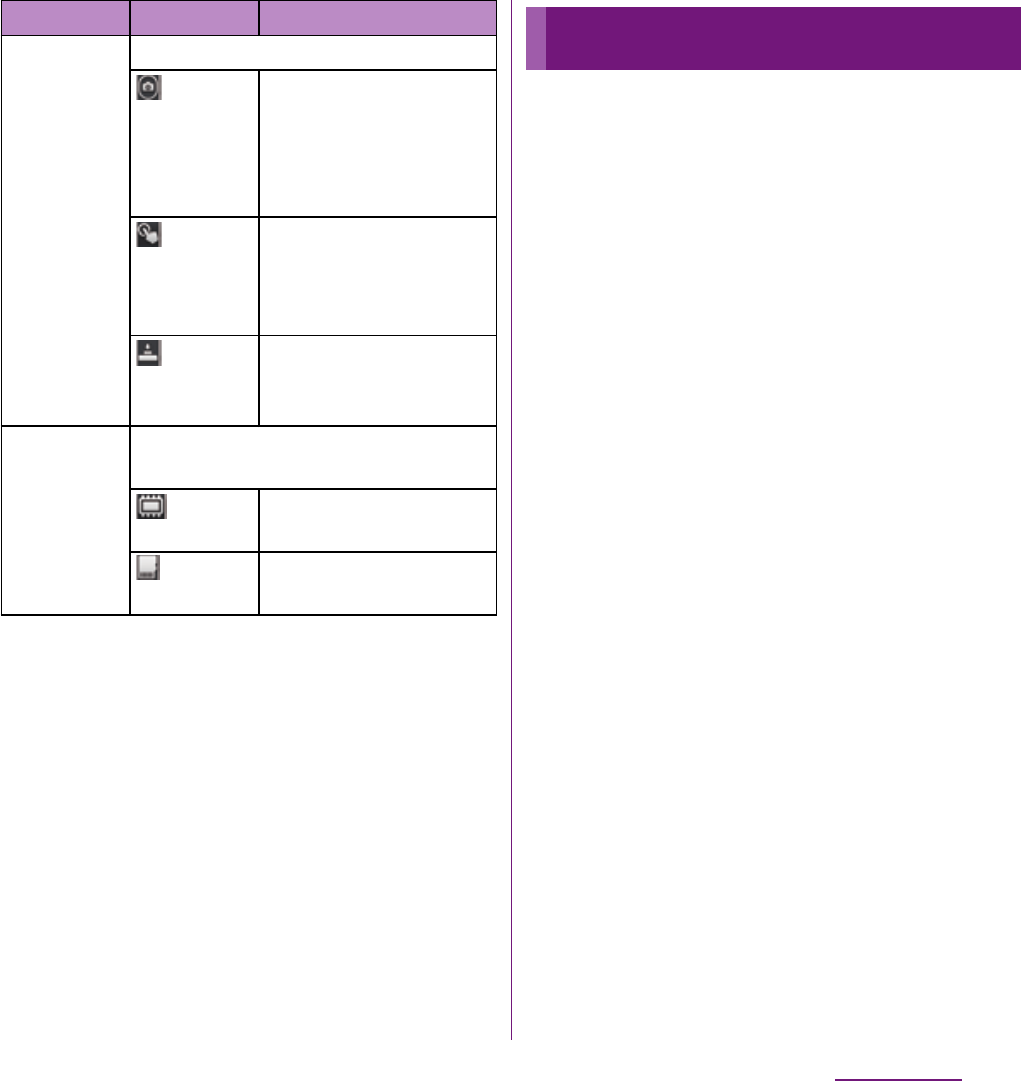
187
Applications
❖
Note
・
Some settings cannot be used in combination with
one another.
You can save the current displayed screen as
an image (screen shot).
Captured screen shots are shown on the
"Pictures" album in the Gallery (P.193).
1
On the screen you want to capture,
press and hold
p
for over a
second.
・
Phone options menu appears.
2
Tap [Take screenshot].
・
A screen shot is taken and a message
notifying the saving location appears
on the screen.
❖
Information
・
By tapping [Share]/[Set as] on the shooting
completion screen, you can share (send) the image
via Bluetooth or email, or register as wallpaper or
contact icon.
Capturing
method
Set the shooting method.
On-screen
button
Set to start/stop
recording videos by
tapping the record
starting/stopping icon or
pressing
k
.
Touch
capture
Set to start/stop
recording videos by
tapping the recording
screen or pressing
k
.
Camera key
only
Set to start/stop
recording by pressing
k
.
Data
storage
Set the saving location for recorded
videos.
Internal
storage
Save recorded videos in
the internal storage.
SD card Save recorded videos in a
microSD card.
Item Icon Description
Capturing the screenshot

188
Applications
You can view/play multimedia contents
(music, photos, videos, etc.) on "Music
Player", "Gallery", "Media Player", etc.,
respectively.
You can play photos and videos shot by the
terminal, transfer files to the built-in storage
by connecting to a PC, and play multimedia
content of the following file formats
downloaded from the Internet.
For details on operations for copying files by
connecting to a PC, see "Transferring and
moving data" (P.158).
Avoid copyright infringements when you
handle photos, videos, or sound recorded
using the terminal, e.g. copy/edit. In addition,
avoid rights infringements of portraits by
using these photos without consent, altering
them or by other means. Note that capturing
or recording a stage performance,
entertainment or exhibition may be
prohibited even if for personal use.
Please be considerate of the privacy of
individuals around you when taking and
sending photos using camera-equipped
mobile phones.
Playing multimedia
content
Type File format
Sound
MP3, 3GPP, MP4, AMR, AMRWB, SMF, XMF,
WAV, iMelody, RTTTL/RTX, OTA, Ogg vorbis
Still
image
JPEG, GIF, PNG, BMP
Video
3GPP, MP4
Copyright protected content

189
Applications
1
Connect the plug of Stereo
Headset with Microphone
(Sample) to headset connector of
the terminal.
・
Check the connecting direction to
connect correctly. Wrong connection
may cause damage.
❖
Information
・
When you listen to Music player/FM radio with
Stereo Headset with Microphone (Sample)
connecting to the terminal, you can switch on/off by
pressing the switch of Stereo Headset with
Microphone (Sample). However, operation may differ
depending on the conditions of use.
・
If receiving a call when using Stereo Headset with
Microphone (Sample), music stops, and the ringtone
sounds.
- If receiving a call when using Music player, playing
music resumes when the call ends.
- If receiving a call when using Media player, playing
music resumes by tapping the play key on the
Media player screen after the call ends.
Images, photos and videos you took can be
viewed and played. Also, use Media Go to
transfer content to the terminal and to take
content from an external device. For details,
refer to "Using microUSB cable" (P.158).
Using Stereo Headset with
Microphone
Viewing photos/videos
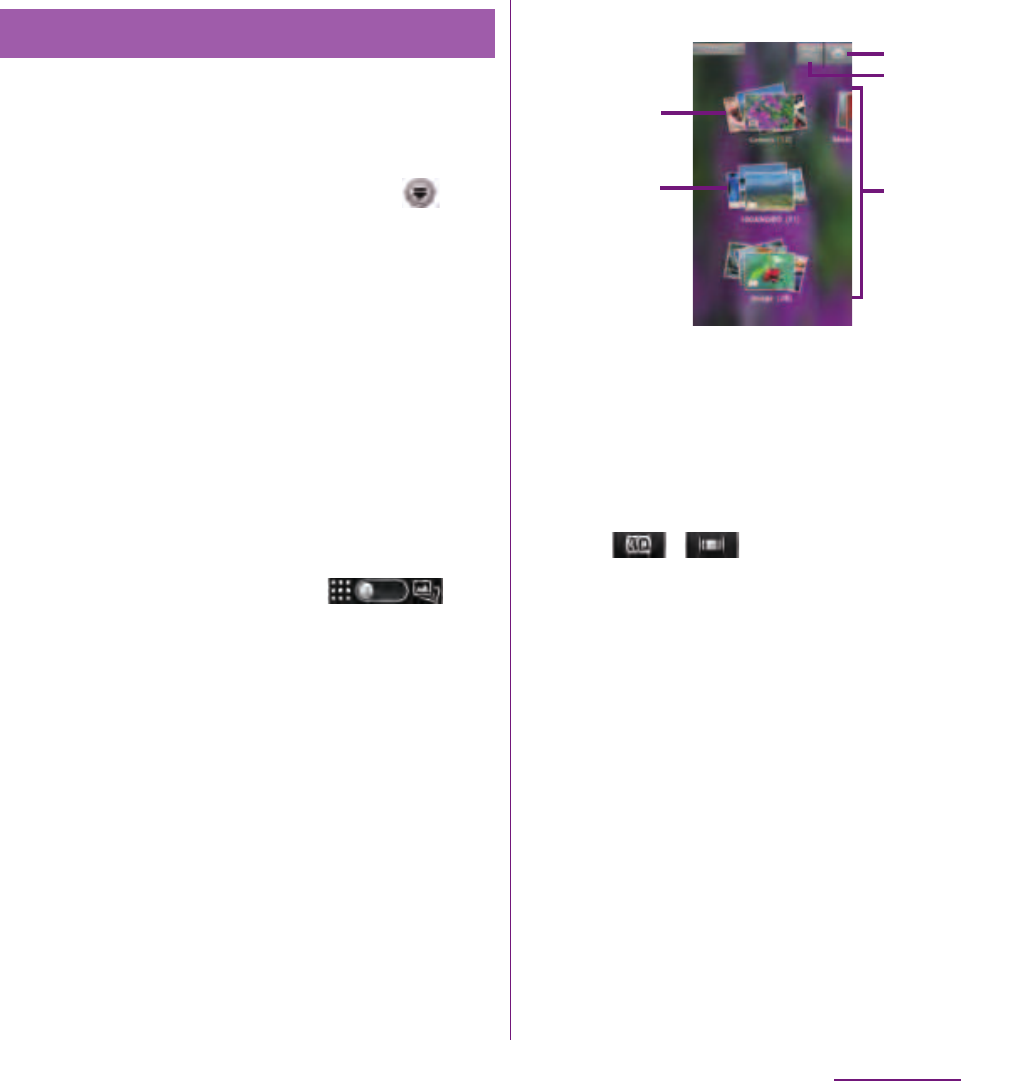
190
Applications
Photos and videos that you took or saved in
the internal storage or microSD card from a
PC are displayed in albums.
1
From the Home screen, tap ,
then tap [Gallery].
・
Album list screen appears.
・
If you signed in online service available
to be synchronized such as Facebook/
Google+/Picasa, online albums also
appear after synchronization.
2
Tap an album you want to view.
・
A screen listing Photo/Video files in
album appears.
❖
Information
・
When you tap an album, then tap to
the upper right of the screen, the albums are sorted
by date. When you tap the date album, the list of all
files appears. The files of selected date appear with
the thicker frame than the other files.
・
Depending on the number of photos saved, it may
take some times to load all photos on the screen.
■
Album list screen
a
Camera album (Camera) : Display still picture/videos
saved in the internal storage.
b
Camera album (100ANDRO) : Display still pictures/
videos saved in the microSD card.
c
Camera button : Activate the camera.
d
3D album : View 3D Sweep Panorama/Sweep Multi
Angle
・
Tap / to switch display.
e
Album list
Viewing photo/video album
a
d
e
b
c
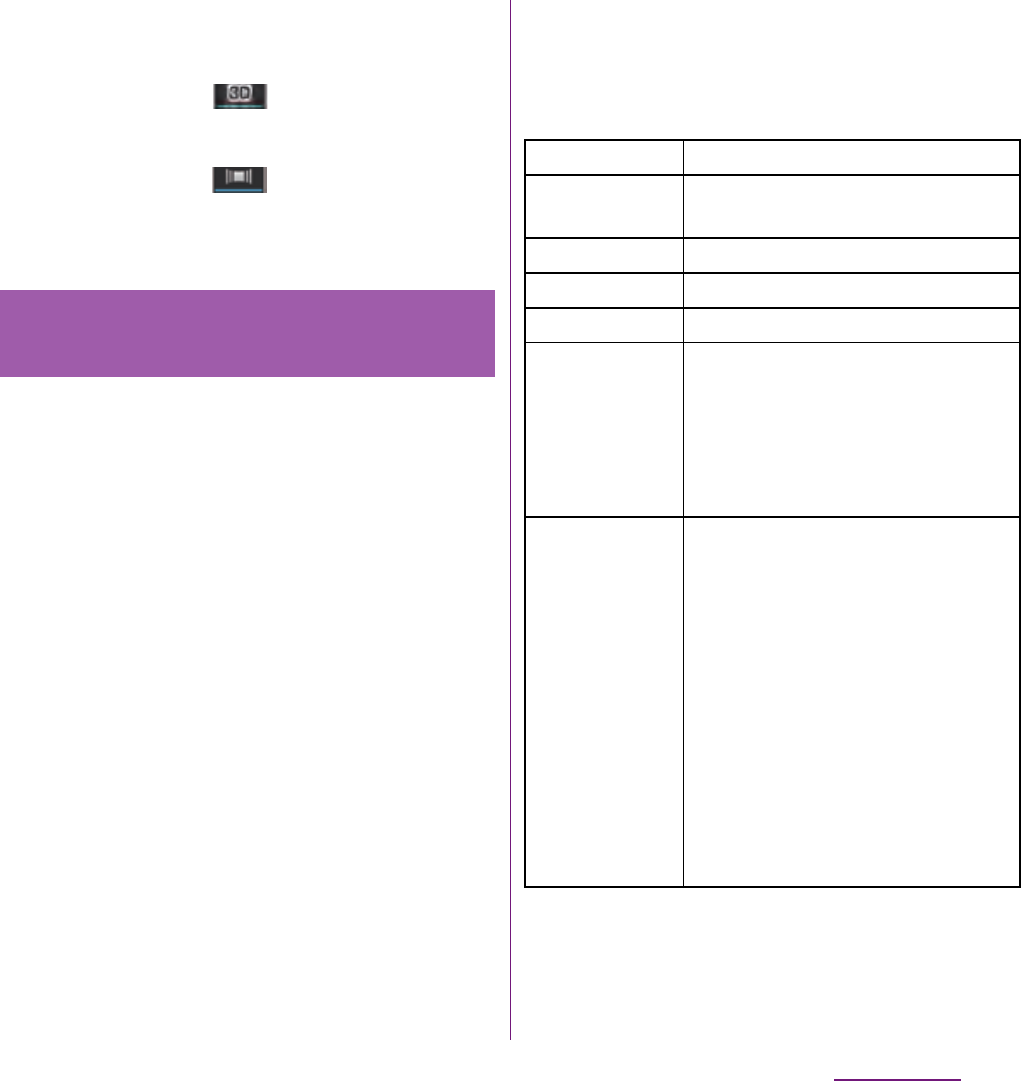
191
Applications
❖
Information
・
Still pictures shot with Sweep Multi Angle also
appear in the album of 3D Sweep Panorama.
・
Still pictures saved in (3D Sweep Panorama)
can be viewed three-dimensionally by connecting
with a 3D viewing device.
・
Still pictures saved in (Sweep Multi Angle) can
be viewed three-dimensionally by tilting the
terminal left and right.
On the photo/video file list screen, you can
select files in the album to operate them at a
time.
1
On the photo/video file list screen,
touch and hold a file.
・
The checkbox is marked and file is
selected. Tap another file in a row to
select two or more files.
・
Tap a selected file to unmark the
checkbox.
2
Tap
t
, then tap displayed
menu.
・
You can perform the following
operations.
・
The items vary depending on the
selected file.
・
Some items cannot be operated in
some files.
Operating Photo/Video files in
album
Play on
Detect DLNA device and connect.
Share
Select a transfer method and send
photos/videos.
Delete
Delete selected photos/videos.
Select All
Select all files in album.
Deselect All
Deselect all files in the album.
Details
Display title, type, date, album
name, location, etc.
・
Only displayed in files of the
albums provided by online
service such as Facebook/
Google+/Picasa.
More Details
: Display title, type, date,
album name, location, etc.
Rotate Left
: Rotate a picture 90
degrees counterclockwise.
Rotate Right
: Rotate a picture 90
degrees clockwise.
Show on map
: Display location
information included in the image
on the map.
Edit video
: Crop the video partially
to save.
・
The items vary depending on the
selected file.

192
Applications
❖
Information
・
While selecting a file, tap
t
and tap [Play on] to
display the connection device selection screen (if
you do not connect Wi-Fi network in advance, tap
[Settings] to display the setting screen for wireless &
networks). Select a device detected on the
connection device selection screen, and tap the
device name to play on to share a file between a
DLNA device and the terminal.
・
For shared files, file size and the file type are not
particularly limited, but may be limited by the
application to transfer. DRM content cannot be
shared.
・
Before selecting a file, tap
t
to automatically
mark the file displayed near the middle of the screen.
If once a certain file is selected, the file in the middle
is not always marked.
・
On the photo viewing screen, tap
t
to operate
picture files individually.
1
From the Home screen, tap ,
then tap [Gallery].
2
Tap an album.
・
A list screen of files in the album
appears.
3
Tap a photo to view it.
■
Still picture viewing screen
a
Album information
b
Zoom out
c
Zoom In
❖
Information
・
On the viewing screen, tap
t
to display "Play on",
"Share", "Delete", "Slide show", "Set as", "More", "Set as
wallpaper", "Details".
* "Set as wallpaper" and "Details" only appear in
images of the albums provided by an online
service such as Facebook/Google+/Picasa.
・
The items vary depending on the selected file.
・
From the photo viewing screen for the Facebook
album, you can post comments or "Like" onto
Facebook.
Starting slideshow
1
On the still picture viewing screen,
tap
t
, then tap [Slide show].
・
A slideshow of the photos or first
frames of videos in the album starts.
Viewing photos
a
b
c
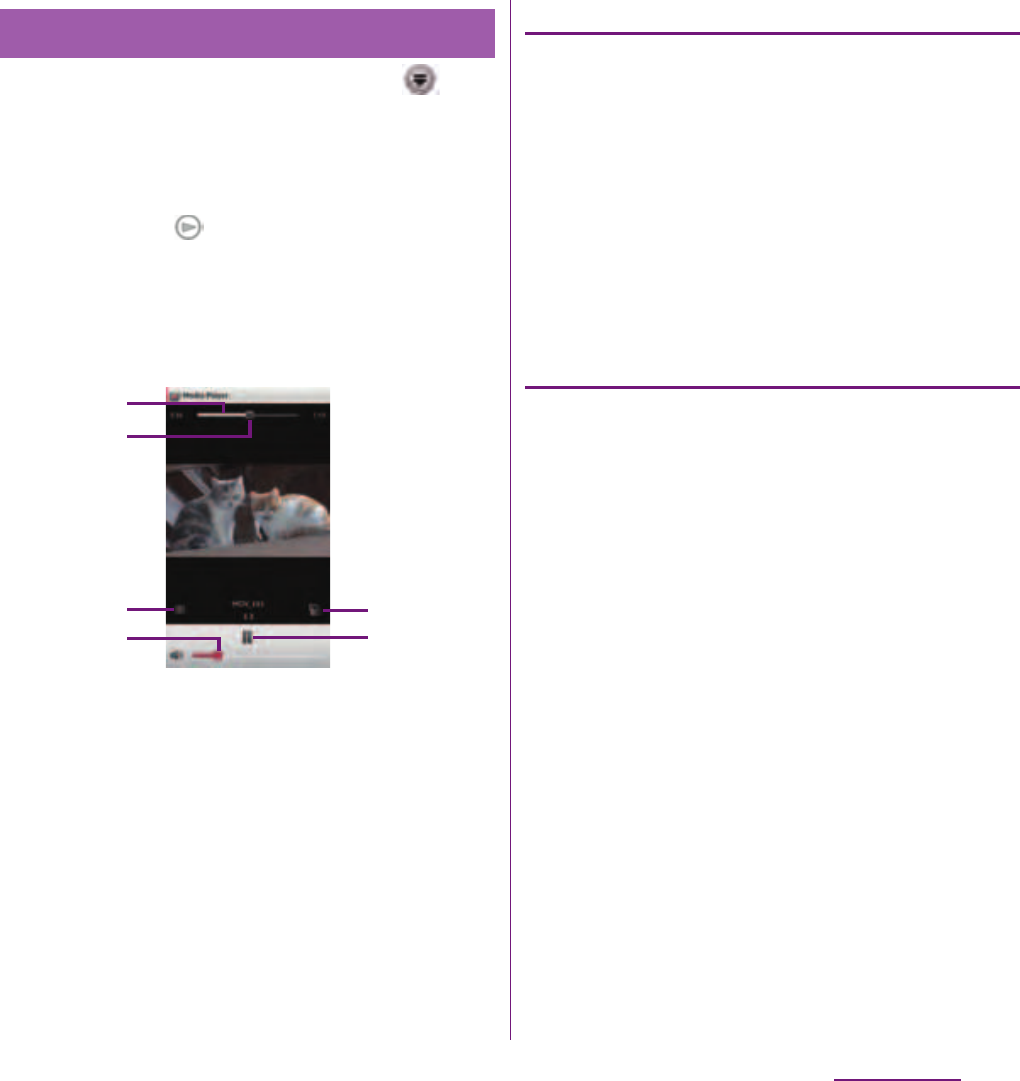
193
Applications
1
From the Home screen, tap ,
then tap [Gallery].
2
Tap an album.
・
A list screen of files in the album
appears. icon is displayed on the
video files.
3
Tap a video.
■
Video playback screen
a
Progress bar : Display the playback position in the
playback duration
b
Marker : Playback position. Drag to change the
playback position
c
Display the Media player list screen
d
Playback volume adjustment bar
e
Auto-rotate screen On/Off switch
f
Play/Pause key
Adjusting the volume of a video
1
On the video playback
screen,press top or bottom of
m
.
❖
Information
・
Volume can be adjusted by operating the playback
volume adjustment bar on the video playback
screen.
Fast forwarding and rewinding a
video
1
Drag the progress bar marker right
or left.
Playing video
a
c
b
e
f
d

194
Applications
YouTube is a free online video streaming
service. You can play, search for and upload
videos.
・
A packet communication charge is applied
when downloading or uploading video
content using 3G network.
1
From the Home screen, tap ,
then tap [YouTube].
・
YouTube video list screen appears.
・
You can tap
t
, then tap [Browse] to
select video from each category.
2
Tap a video to play it.
・
While playing a video, tap the screen to
display the play control keys which you
can switch Play/Pause. Double-tap to
switch landscape/portrait. In landscape,
drag the marker on the progress bar at
the bottom of the play screen left or
right to change playing point.
・
Tap
x
to stop playing and return to
the video list screen.
・
To quit YouTube, tap
y
.
❖
Information
・
For movies with caption function which can display
subtitles, "CC" appears on the playback screen in the
landscape mode. For your first activation, tap [CC]
and tap language for the subtitles.
1
While playing a video, double-tap
the screen to switch to the
landscape screen.
2
Tap the screen to display the play
control keys, then tap [HQ].
❖
Information
・
A video plays in high quality when Wi-Fi is
connected.
・
On the YouTube screen, tap
t
, then tap
[Settings], then mark [High quality on mobile]
checkbox to always play video in high quality even
when 3G network is connected.
Playing YouTube video
Playing YouTube video
Playing YouTube videos in high
quality

195
Applications
1
On the YouTube video list screen,
tap
t
, then tap [Search].
2
Enter the search keyword.
3
Scroll the result and tap a video
you want to play.
1
On the YouTube video list screen,
tap
t
, then tap [Settings].
2
[Clear search history]
u
Tap [OK].
You can watch photos and videos on
television by connecting the terminal using
an HDMI cable (type D).
1
Connect the terminal with Home
screen or application screen
displayed to a TV using an HDMI
cable.
■
When the Home screen is displayed
・
Activate TV launcher automatically.
■
When the Applications screen is
displayed
・
, appear in the status bar. Drag
the status bar downwards and tap [TV
launcher] to activate TV launcher.
Searching for a video with
keywords
Deleting search history
Connecting the terminal to
TV to watch photos and
videos
Connecting TV and activating
an application by TV launcher

196
Applications
2
Scroll an icon left and right to
select the desired application.
・
When you connect an HDMI cable for
the first time, "HDMI cable connected"
appears.
- On the "HDMI cable connected"
screen, tap [Learn more] to show how
to use the TV remote controller.
・
You may be able to operate
applications with the TV remote
controller.
❖
Information
・
While HDMI is connected, drag the status bar
downward and tap [HDMI connected] to set HDMI
control or output. Operations may not be available
depending on the TV remote controller.
・
On the TV launcher screen, select an album art in
Music player on the upper left to display Music player
screen.
・
On the TV launcher screen, select [Add] and select
the desired shortcut to add the shortcut to the TV
launcher screen.
・
On the TV launcher screen, select [Home] to display
the Home screen of the terminal.
・
On the option menu, select [Rearrange] to rearrange
shortcuts on the TV launcher screen.
・
Removing an HDMI cable severs connection,
however, TV may remain to HDMI input mode.
Follow the instructions on the TV to switch to digital
terrestrial television mode, etc.
・
When you do not use HDMI connection, remove the
HDMI cable. If the HDMI cable remains connected,
the battery may be consumed quickly.
You can browse and listen to your music,
playlists and podcasts using Music player.
Tap [MY MUSIC] tab on the Music player
screen, you can browse and play audio
content saved in the internal storage or
microSD card by category.
❖
Note
・
Do not perform "Unmount SD card" while a track is
playing.
1
From the Home screen, tap ,
then tap [Music player].
・
The Music player screen appears.
2
Tap [MY MUSIC] tab.
3
Browse tracks by tapping TRACKS/
ALBUMS/ARTISTS/PLAYLISTS/
SensMe
™
channels/MY FAVORITES
category.
・
When a shortcut is added, you can also
tap the shortcut to view/play a track.
For adding a shortcut, see "Adding a
shortcut" (P.202).
4
Tap a track to play it.
Music player
Playing music
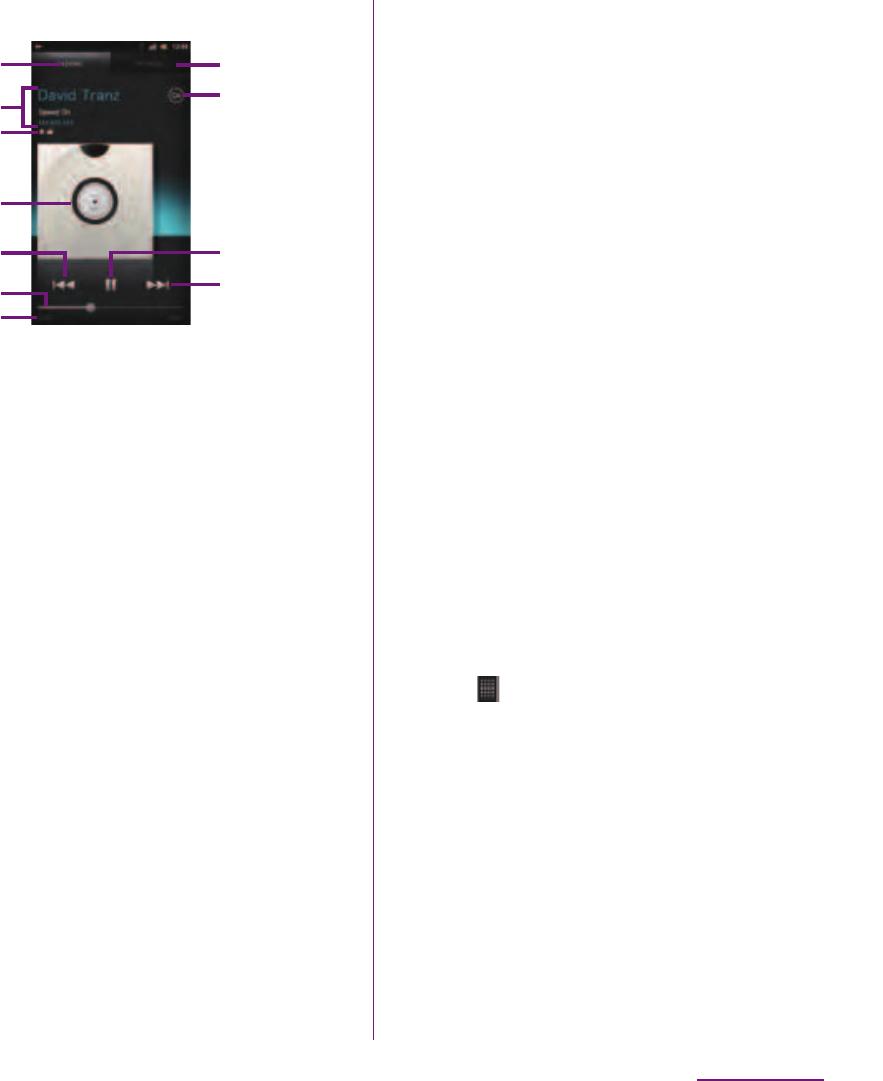
197
Applications
■
Music player screen
a
Playing tab
b
Artist name, song title, album title
c
Favorites/"Like" icon
・
Display when added to Favorites or "Like"
specified.
d
Album art : Tap to display "Like"/Add to favorites/
Play on device/Play queue.
・
"Like" appears if you log in to Facebook.
e
[Previous] key : Go to the previous track, or to the
beginning of the track in the current playlist.
f
Progress bar : Resume playback from the specified
point by dragging or tapping.
g
Track play time
h
My MUSIC tab : Display categories, TRACKS/
ALBUMS/ARTISTS/PLAYLISTS/SensMe
™
channels/
MY FAVORITES.
i
Infinite button : Connect to Google, Wikipedia,
YouTube, etc. to display related information of the
current track.
j
Play/Pause key
k
[Next] key : Go to the next track in the current
playlist.
❖
Information
・
On the playback screen of the Music player, tap
t
to display "Shuffle mode", "Repeat mode", "Equalizer",
"Edit".
- Tap [Equalizer] to change sound quality with
"Equalizer" tab, or to select surround effect for
headphones with "More" tab, or to set xLOUD
™
on/off for speakers.
- Tap [Edit] to enter information such as title of the
track, artist, album, release year, number of track
manually. Alternatively, tap [Edit album art], then
set album art downloaded from network or select
an image from Gallery to set album art. Tap [Save]
in the "Edit music info" screen to display edited
contents on the music player screen.
・
On the playback screen of the Music player, tap
album art and tap [Play queue] to display playing
track and the list containing the track.
- You can switch to play/pause the playing track,
and change the track by tapping other track in the
list.
- Touch and hold a track to display menu items such
as Send, Add to playlist, Set as ring tone, etc.
- Tap [Save] to save tracks on the list as a playlist.
- Drag up and down on the left of the track to
change order.
- To add a track to the list, touch and hold the
desired track from the category of TRACKS/
ALBUMS/ARTISTS/PLAYLISTS/MY FAVORITES, and
tap [Queue track].
・
On the track list of each category, Tap
t
to
display "Download music info".
- Tap [Download music info] and tap [Start] to
download album art, artist image, title of track,
information for artist, album, then manually refresh
album information.
d
k
f
c
a
b
e
g
h
i
j

198
Applications
・
On the unlocking screen, flick left around date to
display the Music player widget to operate by
tapping Play/Pause/[Rewind]/[Forward] key without
unlocking the keys. While playing music, Music
player widget automatically appears on the key
unlock screen.
・
You can return to the Home screen to perform
another operation while listening to the Music player
in the background. To return to the playback screen
of the Music player, from the Home screen, tap
and [Music player], or drag the status bar down to
tap playing music title from the Notification panel.
Adjusting the volume
1
While playing music, press top or
bottom of
m
.
Adding a shortcut
You can add a shortcut of track or album to
MY MUSIC screen.
1
In the Music player screen, tap [MY
MUSIC] tab.
2
Tap TRACKS/ALBUMS/ARTISTS/
PLAYLISTS/SensMe
™
channels/MY
FAVORITES category.
3
Touch and hold a track or album
you want to add as a shortcut.
4
Tap [Add as shortcut].
❖
Information
・
To move a shortcut or tile for each category in MY
MUSIC screen, touch and hold a shortcut or tile for
each category and drag to the desired location.
・
To delete a shortcut in MY MUSIC screen, touch and
hold a shortcut and drag to displayed at the
right of the screen.
Sharing track
You can share (send) files by Bluetooth, email
attachment, infrared communication.
1
In the Music player screen, tap [MY
MUSIC] tab.
2
Tap TRACKS/ALBUMS/ARTISTS/
PLAYLISTS/MY FAVORITES
category.
3
Touch and hold a track you want to
share.
4
Tap [Send].
5
Select sending method and send.
・
Mark [Use by default for this action.]
checkbox not to display the application
selection screen next time.
❖
Information
・
For shared (to be sent) files, file size and the file type
are not particularly limited, but may be limited by the
application to transfer. DRM content cannot be
shared.

199
Applications
Deleting a track
1
In the Music player screen, tap [MY
MUSIC] tab.
2
Tap TRACKS/ALBUMS/ARTISTS/
PLAYLISTS/MY FAVORITES
category.
3
Touch and hold a track you want to
delete.
4
Tap [Delete]
u
[Delete].
Using a track as a ringtone
1
In the Music player screen, tap [MY
MUSIC] tab.
2
Tap TRACKS/ALBUMS/ARTISTS/
PLAYLISTS/MY FAVORITES
category.
3
Touch and hold a track you want to
use.
4
Tap [Set as ringtone].
In Music player, you can create new playlists
with your desired tracks.
You can use Media Go (P.162) to maintain
your music library and create your own
playlists. Playlists that you create by yourself
are stored on the terminal in the m3u format.
You can connect the terminal to a PC using
the supplied microUSB cable and can use the
internal storage or a microSD card as a
removal disk. For details, refer to "Using
microUSB cable" (P.158).
Creating a playlist
1
In the Music player screen, tap [MY
MUSIC] tab.
2
Tap [PLAYLISTS]
u
[Create new
playlist].
3
Tap the entry box to enter a
playlist name and tap [OK].
4
Mark the service you want to post
and tap [Save].
Playlist
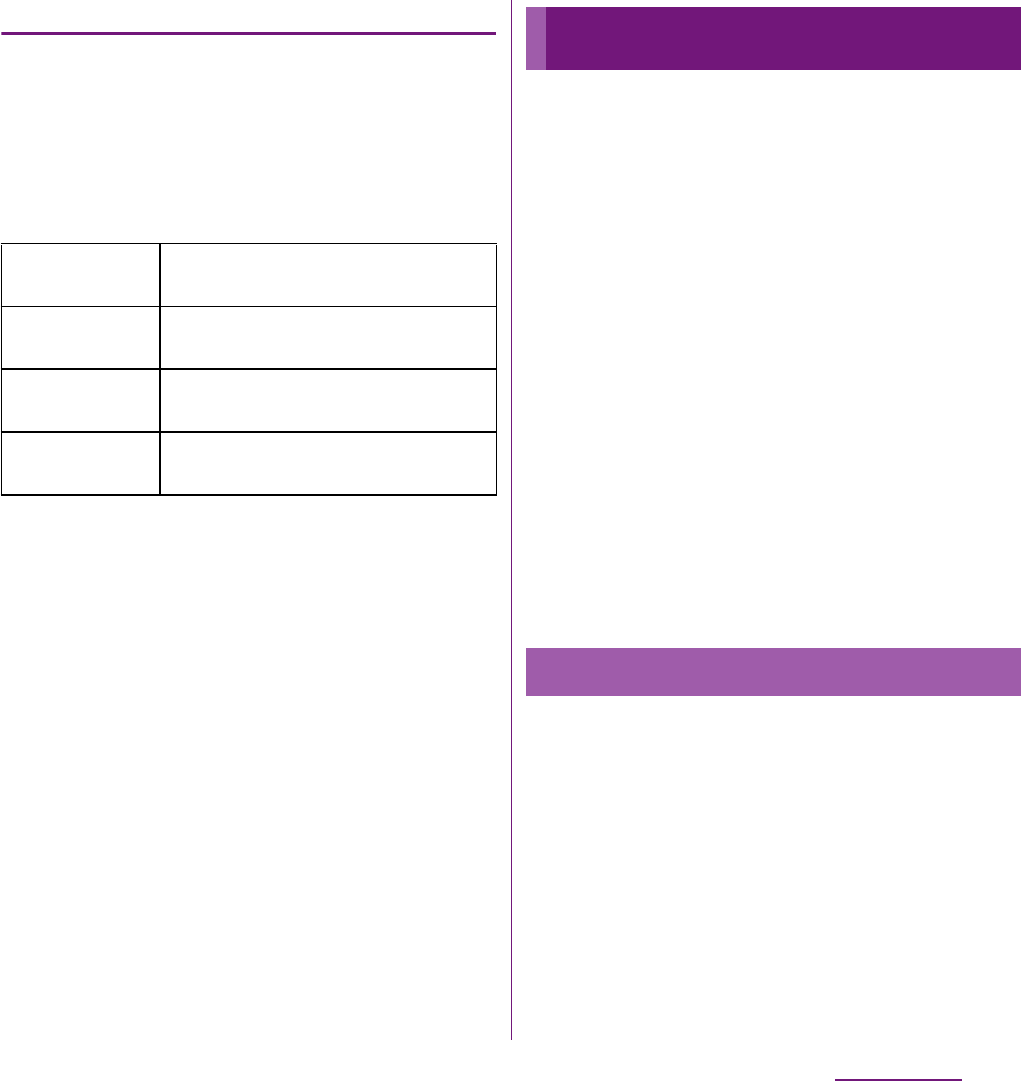
200
Applications
Playing Playlists
1
In the Music player screen, tap [MY
MUSIC] tab.
2
Tap [PLAYLISTS].
・
The following playlists appear by
default.
3
Tap a playlist you want to
play
u
Tap a track.
・
The playlist plays from the track you tap.
With Android Market, you can directly access
useful applications or fun games which you
can download and install on the terminal.
And you can send feedback and comments
about an application, or report objectionable
application or incompatible application with
the terminal as an inappropriate content.
・
To use Android Market, you need to set
Google account (P.132).
・
Some applications and games are free of
charge, and the others are paid. In the
applications list of Market, distinction
between free and paid is clearly specified. For
details on purchasing, returning and
refunding of paid applications, see "Help"
(P.205).
1
From the Home screen, tap
[Market].
・
When you open Android Market for the
first time, the Terms of Service for
Android Market window appears. Tap
[Accept].
My favorites
Display the list of tracks in My
favorites.
Newly added
Display the list of tracks newly
added.
Most played
Display the list of frequently played
tracks.
Never played
Display the list of available tracks
which have not played wholly.
Using Android Market
Opening Android Market

201
Applications
❖
Information
・
Be sure to check the security of application, then
install it at your own risk. The terminal may be
infected with a virus and the data may be damaged.
・
NTT DOCOMO is not liable for malfunctions, if any,
caused by the application you installed. In such case,
the repair is charged even during the warranty
period.
・
NTT DOCOMO is not liable for any disadvantage
brought to you or any third party due to an
application you installed.
・
Some applications automatically perform packet
communications. Packet communication is kept
active unless you disconnect it or the time-out is
occurred. To disconnect packet communication
manually, from the Home screen, tap
t
and
[Settings]
u
[Wireless & networks]
u
Tap [Mobile
networks] and then unmark [Data enabled].
・
Some applications may be updated automatically.
When you need help or have any questions
about Android Market, in the Andoroid
Market screen, tap
t
and tap [Help]. The
Browser opens the Android Market Help web
page.
Timescape
™
(hereinafter referred to as
Timescape) displays various information such
as Facebook, Foursquare, Twitter or mixi
updates, etc. in chronological order. You can
see a tile preview of events before choosing
to view the full content. With (infinite
button), you can view all communication
information related to the registered
contacts. (P.208)
❖
Information
・
To make best use of Timescape, you can set up your
social networking service (SNS) account.
・
Note that, you cannot view emails of Gmail or other
Email application accounts in Timescape.
・
If you do not have a Facebook account, you can
create a new account at http://www.facebook.com.
・
If you do not have a Foursquare account, you can
create a new account at https://ja.foursquare.com.
・
If you do not have a Twitter account, you can create a
new account at http://www.twitter.com.
・
If you do not have a mixi account, you can create a
new account at http://mixi.jp (in Japanese only).
・
You can check the update of set Facebook,
Foursquare, Twitter or mixi by Timescape.
Help
Timescape
™
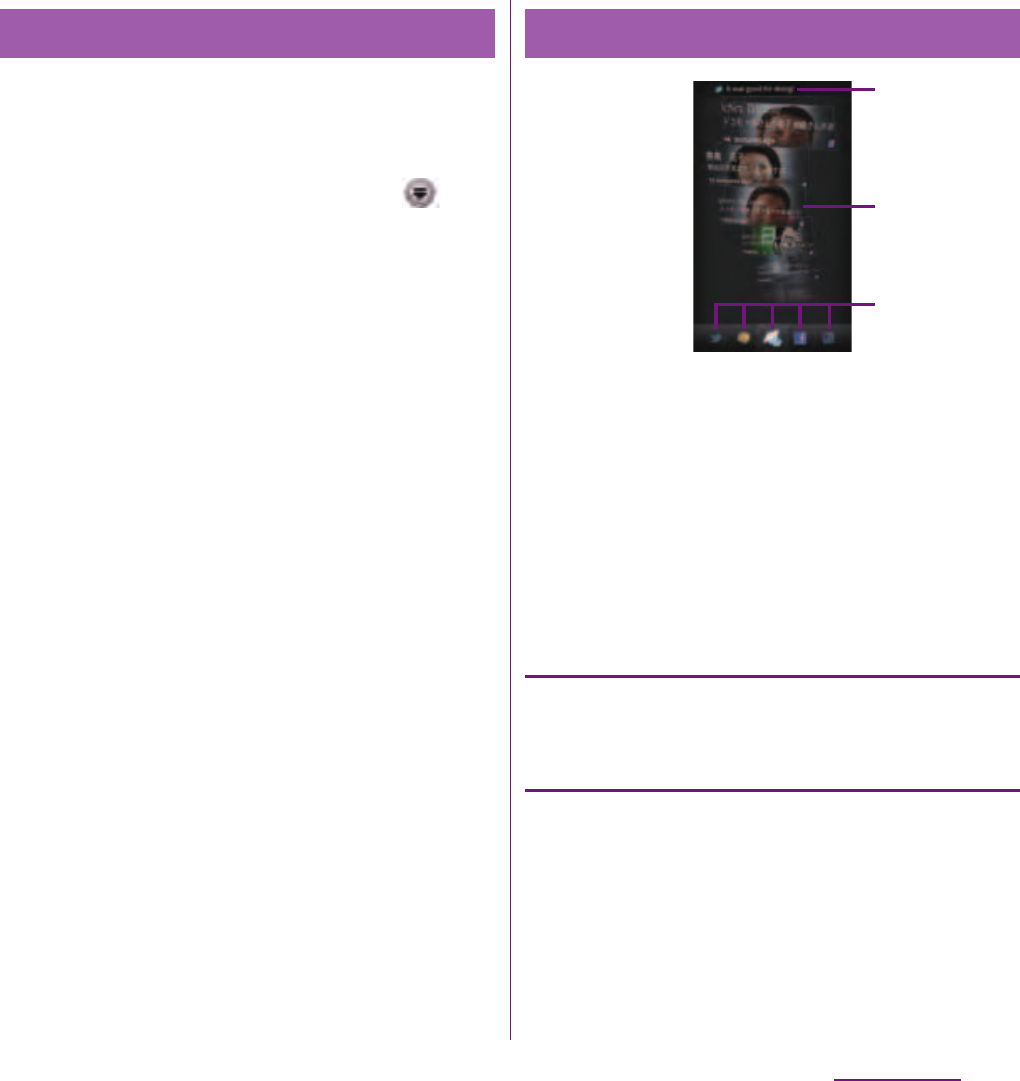
202
Applications
・
The first time you start Timescape, a setup
wizard will guide you the necessary steps to
set up account.
1
From the Home screen, tap ,
then tap [Timescape
™
].
2
Tap a tile.
3
If you want, enter your Facebook/
Foursquare/Twitter/mixi account
information.
4
Tap [Done].
❖
Information
・
In the setup wizard, tap [Extension search] on the
account registration screen to connect to Android
Market and search new services for Timescape.
・
After completion of setup wizard, you can change
the settings. On the Timescape screen, tap
t
and
tap [Settings].
・
If the automatic update of Facebook/Foursquare/
Twitter/mixi is set, you can check information update
sooner; however, the battery runs out quickly. To
save the battery, set to manual update.
a
Latest comment : Display the latest comments
posted to Facebook/Foursquare/Twitter/mixi.
・
To narrow the services to post down, use filter.
b
Tile : Display various information such as Facebook,
Foursquare, Twitter or mixi friend's updates in
chronological order.
c
Filter : Tap a filter item to narrow the information
down to a certain type.
・
Display order of filters may differ.
Scrolling through tiles in Timescape
1
Drag a tile up and down.
Previewing tiles in Timescape
Select a tile to view the content on the tile.
1
Tap a tile.
Setting up Timescape Timescape screen
a
b
c
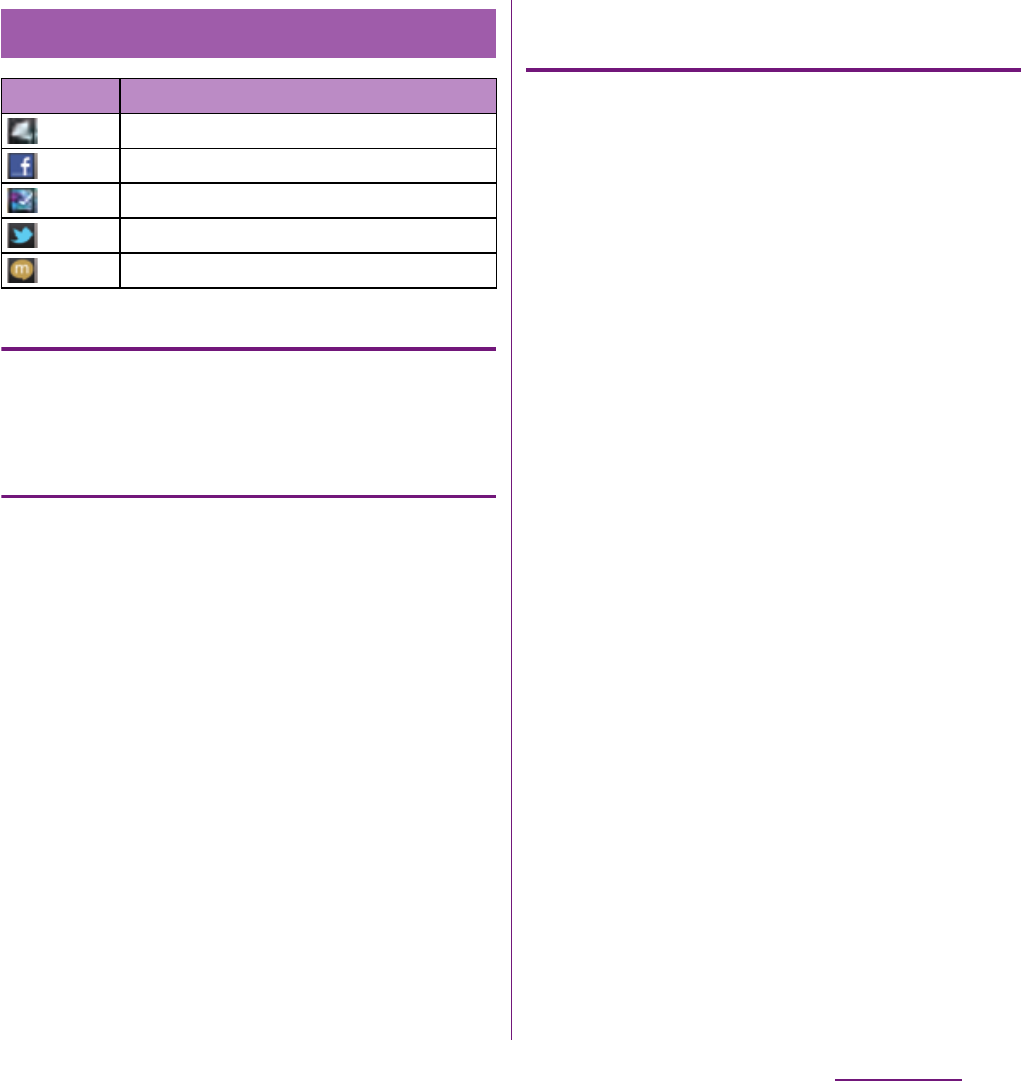
203
Applications
Filtering the displayed tile
1
Tap the filter icons on the
Timescape screen.
Refreshing the Timescape screen
When you refresh the Timescape screen, the
terminal connects to the Internet to update
information from your Facebook, Foursquare,
Twitter and mixi whose accounts are set in
Timescape.
1
On the Timescape screen, tap
t
and tap [Refresh].
Posting to Facebook, Foursquare,
Twitter, mixi from Timescape
1
On the Timescape screen, tap
t
and tap [Update status].
2
Mark the service you want to post
and tap [Continue].
3
Enter the text and tap [Post].
Filter icons
Filter Icon Displayed tile
All tiles
Updates from your Facebook contacts
Updates from your Foursquare contacts
Updates from your Twitter contacts
Updates from your mixi contacts

204
Applications
The following icons on a tile indicate a type of
event.
Displaying tile information
1
On the Timescape screen, tap a
tile.
When you tap a tile, (infinite button) may
appear in the upper right corner. By tapping
, you can view the communication log by
registered information in the contacts or tile
filter event.
Viewing the registered information of
contacts in Timescape
1
On the Timescape screen, tap a
tile.
2
Tap .
・
Communication logs and information
related to the selected tile by event
appear. Flick the filter at the bottom of
the screen to switch displayed
information.
Displaying the Timescape setting
screen
1
On the Timescape screen, tap
t
, then tap [Settings].
・
You can set the following operations.
Tile icons
Icon Event
A Facebook update. Tap the tile to
display the update.
A Foursquare update. Tap the tile to
display the update.
A Twitter update. Tap the tile to display
the update.
A mixi update. Tap the tile to display the
update.
The infinite button in
Timescape
Timescape settings
Update mode
Set your Facebook/Foursquare/
Twitter/mixi account information to
be updated manually/automatically
when Timescape is activated.
Timescape
™
content
Change a content type displayed in
Timescape.
Set up services
Set Facebook/Foursquare/Twitter/
mixi account or search new service
of Timescape.

205
Applications
There are two ways to find your location,
using Mobile networks with Wi-Fi (Wireless
network) or GPS. Wireless network
technology determines your position fast but
accuracy may vary. If you use GPS technology
it may take a little longer, but it will find your
exact position. You can enable both Wireless
network and GPS to benefit from both
technologies when trying to find your
position.
The terminal has a GPS receiver that uses
satellite signals to calculate your location.
Some GPS features use the Internet. Data
rates and charges may apply.
When you use functions that require the GPS
receiver to find your location, make sure you
have a clear view of the sky. If the GPS
receiver does not find your location after a
few minutes, you should move to another
location. To help the search, stand still and do
not cover the GPS/Wi-Fi/Bluetooth antenna
section (P.29). The first time you use the GPS it
may take up to 10 minutes before your
location is found.
・
Use the GPS system with great care. DOCOMO
is not liable for any damage caused by
abnormality of the system.
・
Note that DOCOMO shall have no liabilities for
any purely economic loss including those due
to missing a chance to check the
measurement (communication) results
because of external factors (including the
running out of the battery), such as a failure,
malfunction, or any other problems of the
terminal or the power failure.
About location services
GPS function

206
Applications
・
You cannot use the terminal as a navigation
device for an aircraft, vehicle, and person.
Note that DOCOMO shall have no liabilities
whatsoever even if you suffer damage or loss
while performing a navigation using the
location information.
・
You cannot use the terminal as a high-
accuracy measurement GPS. Note that
DOCOMO shall have no liabilities whatsoever
even if you suffer damage or loss due to a
deviation of the location information.
・
The GPS signals cannot be easily received
near a vehicle's sun visor with metal parts.
・
GPS is operated by the U.S. Department of
Defense. The department controls the
accuracy of the system, and manages the
system. Therefore, GPS radio wave condition
may be controlled (degradation of accuracy,
suspension of radio wave transmission, etc.) at
the discretion of the U.S. Department of
Defense.
・
Some wireless communications products
(mobile phone, data detectors and some
others) block satellite signals and also causes
instability of signal reception.
・
Some map displays based on location
information (latitude/longitude information)
may be not accurate due to some countries'
or regions' regulations.
■
Where radio waves are difficult to
receive
Note that radio waves may not be received
or it may be difficult to receive radio waves
in the following conditions, since GPS uses
radio waves from a satellite.
・
Inside or immediately under a building
・
Inside a bag or box
・
Inside or under a thick covering of trees
・
In a car, inside a train compartment
・
When there are obstructions (people or
objects) near the terminal
・
Inside a basement or tunnel, and below
the ground or water
・
In buildings-clustered or residential area
・
Near a high-voltage cable
・
Bad weather such as heavy rain or snow
❖
Note
・
If some of the GPS functions are not available, or if
none of them are, check that your contract includes
the use of the Internet, and see "Wireless & networks"
(P.109).
・
NTT DOCOMO is not liable for navigation services or
for the accuracy of location services.

207
Applications
Enabling GPS function
1
From the Home screen, tap
t
and tap [Settings].
2
Tap [Location & security].
3
Tap [Use GPS satellites].
4
Read the note and tap [Agree].
・
[Use GPS satellites] is marked.
Enabling Wireless networks to find
position
・
Enable to search a current location using
mobile network and Wi-Fi.
1
From the Home screen, tap
t
and tap [Settings].
2
Tap [Location & security].
3
Tap [Use wireless networks].
4
Read the note and tap [Agree].
5
Read the note on location
information and tap [Agree].
・
[Use wireless networks] is marked.
・
Wireless network users' location
information is stored without specifying
who they are. Some location
information is stored even when the
application is not running.
The Google Maps application lets you view
your current location, find other locations
and calculate routes. When you start the
Google Maps application, your approximate
location is shown using information from
nearby mobile towers. Your location is
updated with a more precise position when
the GPS receiver finds your location.
❖
Information
・
Make sure to enable the current location information
setting before trying to get your position.
・
To use Google Maps, enable data connection (3G/
GPRS) or connect to Wi-Fi.
・
Google Maps does not cover the whole world.
・
Only using 3G/Wi-Fi connection may not detect
some locations.
・
Google may provide updated service or function.
1
From the Home screen, tap .
2
Tap [Maps]
u
[OK].
・
A map screen appears.
Finding the current location on the
map
1
On the map screen, tap .
・
The blinking blue arrow shows the
current location.
Using Google Maps

208
Applications
Viewing Street View
・
Street View does not cover some areas.
1
Touch and hold a spot on the map
that you are going to look at in
Street View.
2
Tap the displayed call-out.
3
Tap (Street View)
u
[OK].
・
On the Street View display, tap
t
and tap [Compass mode]. The compass
in Street View shows the same direction
as the terminal's geomagnetic
compass.
・
Uncovered area for Street View appears
in light gray.
Searching for a location you want to
look at
1
On the map screen, tap
t
, then
tap [Search].
2
Fill out the search box.
・
You can enter addresses, city names,
business types and institution names
(for example, London and art museum).
・
If a list of places searched or referred
previously appears on the screen, tap
an address, etc. on the list to check the
location on the map.
3
Tap .
・
Search result appears on the map.
・
If appears, tap to select the place
to display.
・
When "Do you mean:" appears at the
top of the map, you can tap "Do you
mean:" to select the place.
4
Tap a destination.
・
A detailed information screen appears.
❖
Information
・
You can use / / on the detailed
information screen. The options you can use vary
depending on the location.
・
On the map screen, tap
t
and [More], then tap
(Places) to select a category such as "Restaurants",
"Cafes", etc. to search around your current location
and show it on the map. You can add the search
categories.
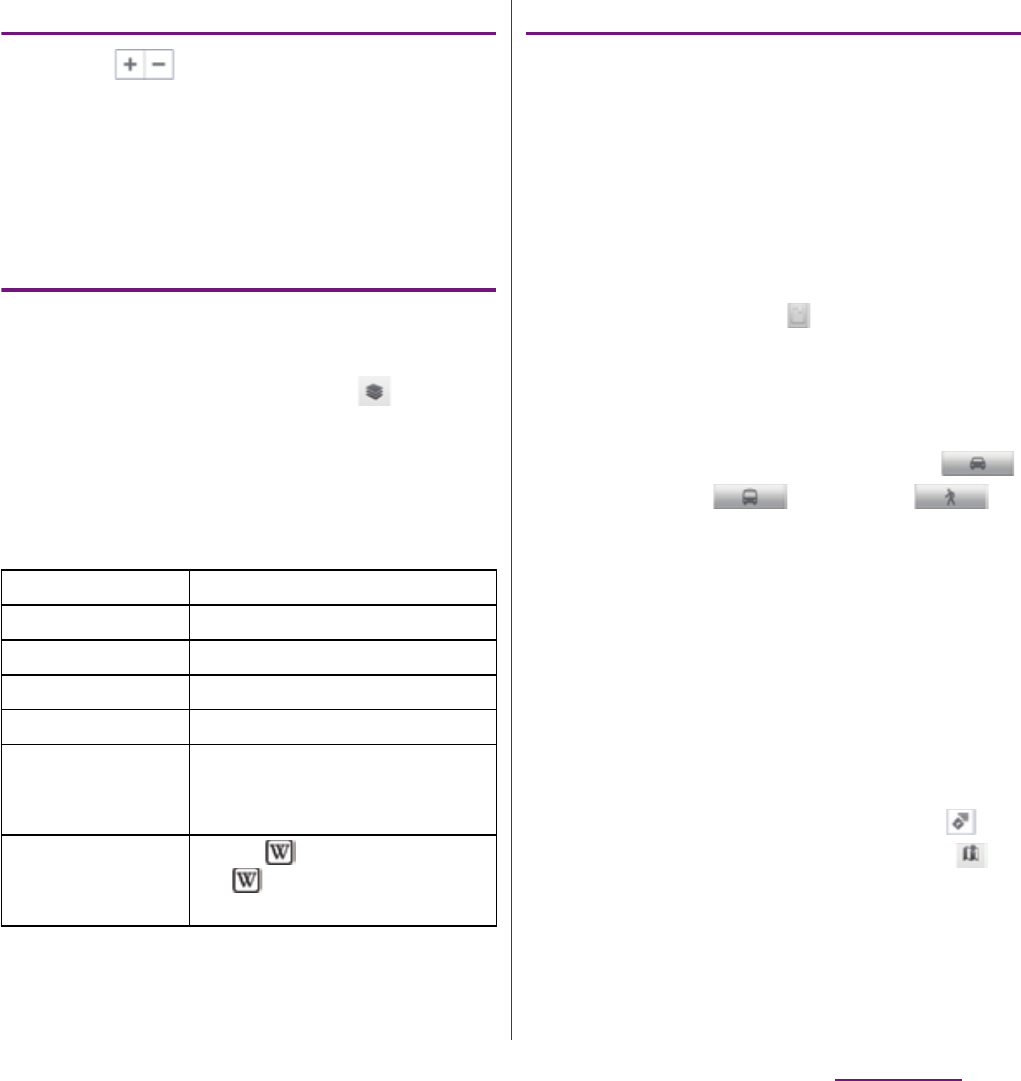
209
Applications
Zooming in or out on a map
1
Tap to zoom in or out on a
map.
❖
Information
・
Alternatively, double-tap or pinch on the screen to
zoom in/out.
Changing the layers
You can select information to overlay on the
map.
1
On the map screen, tap .
2
Tap the information you want to
view.
・
Traffic information and routes are not
available in all locations.
Receiving guides
Google Maps helps you receive detailed
guides for your destination.
1
On the map screen, tap
t
, then
tap [Directions].
2
Enter a start point in the upper
text box, and an end point in the
lower text box.
・
Alternatively, tap at the right of the
text box to select a Start point and End
point from [My current location]/
[Contacts]/[Point on map]/[My Places].
3
Select a transportation from
(Driving)/ (Transit)/
(Walking).
4
Tap [Get directions].
・
A list of guides for your destination
appears.
5
If you search directions for public
transportation, tap a route in the
list.
・
A route is displayed on the map if you
search in car or walk option. Tap to
display routes on the list, and tap to
display routes on the map.
❖
Information
・
With "Navigation" application, you can use easy route
search with current location as a departure point.
Traffic
Show traffic condition.
Satellite
Display satellite photo.
Terrain
Display geological formation.
Transit Lines
Show route information.
Latitude
Join Latitude.
My Maps
View My Maps that you create on
a PC. Only viewing : You cannot
create My Maps on the terminal.
Wikipedia
Display .
Tap to display a Wikipedia
article related to the location.

210
Applications
Clearing the Maps
Clear displayed layers, route search results
and some others.
1
On the map screen, tap
t
and
tap [Clear Map].
・
If there is nothing to clear, "Clear Map" is
displayed in light gray.
Google Latitude enables you to check where
a friend is on the map, and to share status
messages. Latitude also enables you to send
messages (SMS) and emails, to make phone
calls, and to find the route to where a friend
is.
Location information cannot be
automatically shared. You need to join
Latitude and invite a friend who gives his or
her location information, or to receive an
invitation from him or her.
Joining Latitude
1
On the map screen, tap
t
, then
tap [More]
u
[Join Latitude].
・
For the first time to join Latitude, a
message confirming whether to agree
to share location information with
friends appears.
・
Once you join Latitude, the menu name
changes into [Latitude].
❖
Information
・
To set Latitude or log out, tap
t
on the map
screen, then tap [Settings]
u
[Location reporting] to
display a screen for the operation.
Opening Latitude
If you join Latitude, you can confirm where a
friend is, and check update with opening the
screen.
1
On the map screen, tap
t
, then
tap [More]
u
[Latitude].
❖
Information
・
For details of Latitude, tap
t
on the map screen,
then tap [Help] to view the mobile help.
Checking where a friend is by
Google Latitude

211
Applications
1Seg is a terrestrial digital TV broadcasting
service that allows mobile devices to receive
broadcasted data along with images and
sounds. You can also acquire detailed
program information, participate in quiz
programs, enjoy TV shopping, etc.
For details on "1Seg", refer to the following
website.
The Association for Promotion of Digital
Broadcasting
http://www.dpa.or.jp/
Using 1Seg
1Seg is a service provided by TV
broadcasting enterprises (stations), etc. A
communication fee for receiving video
picture and sound is not required. Contact
NHK for details on your NHK viewing fees.
There are 2 types of information displayed in
the data broadcasting area: "Data
broadcasting" and "Data broadcasting site".
"Data broadcasting" is displayed using
airwave along with images and sounds; while
"Data broadcasting site" is displayed by
connecting to a site provided by TV
broadcasting enterprises (stations), etc.,
using information of data broadcasting.
For viewing "Data broadcasting site", etc.,
packet communication fees are charged.
・
Some sites require information fees.
Airwaves
1Seg is one of the broadcast services and a
different type of radio waves (airwaves) from
that of FOMA service is received. Therefore,
regardless of whether you are in or out of
FOMA service area, it cannot be received
where airwaves do not reach or during
broadcasting interruptions.
Also, even in a terrestrial digital TV
broadcasting service area, reception
condition may be poor or reception may be
unavailable in the following places:
1Seg

212
Applications
・
A place far from the tower that the airwaves
are sent from
・
Mountain-ringed regions or a place between
buildings where airwaves are interrupted by
geography or buildings
・
Tunnel, underground or far back from a
building where airwaves are weak or do not
reach
1Seg antenna
To make the reception condition better,
stretch out the 1Seg antenna.
To make the reception condition better, try to
change the direction of the antenna or move
to another location.
・
Stretch out the 1Seg antenna until it stops.
・
1Seg antenna can be rotated by 360 degrees.
Use 1Seg antenna in the direction you can
receive a stronger airwaves.
❖
Information
・
Please note the followings when you operate 1Seg
antenna.
- When changing the direction of the 1Seg antenna,
hold a part close to the root of the 1Seg antenna
and check the direction.
- When retracting the 1Seg antenna, shorten the
antenna, set it up and retract it carefully checking
its direction.
Make channel setting from 1Seg menu when
you activate 1Seg for the first time. After
setting is complete, you can watch 1Seg
programs.
1
From the Home screen, tap ,
and then tap [1Seg].
2
Tap [Channel setting]
u
[Current
area].
・
Available channels are searched.
Initial settings for 1Seg
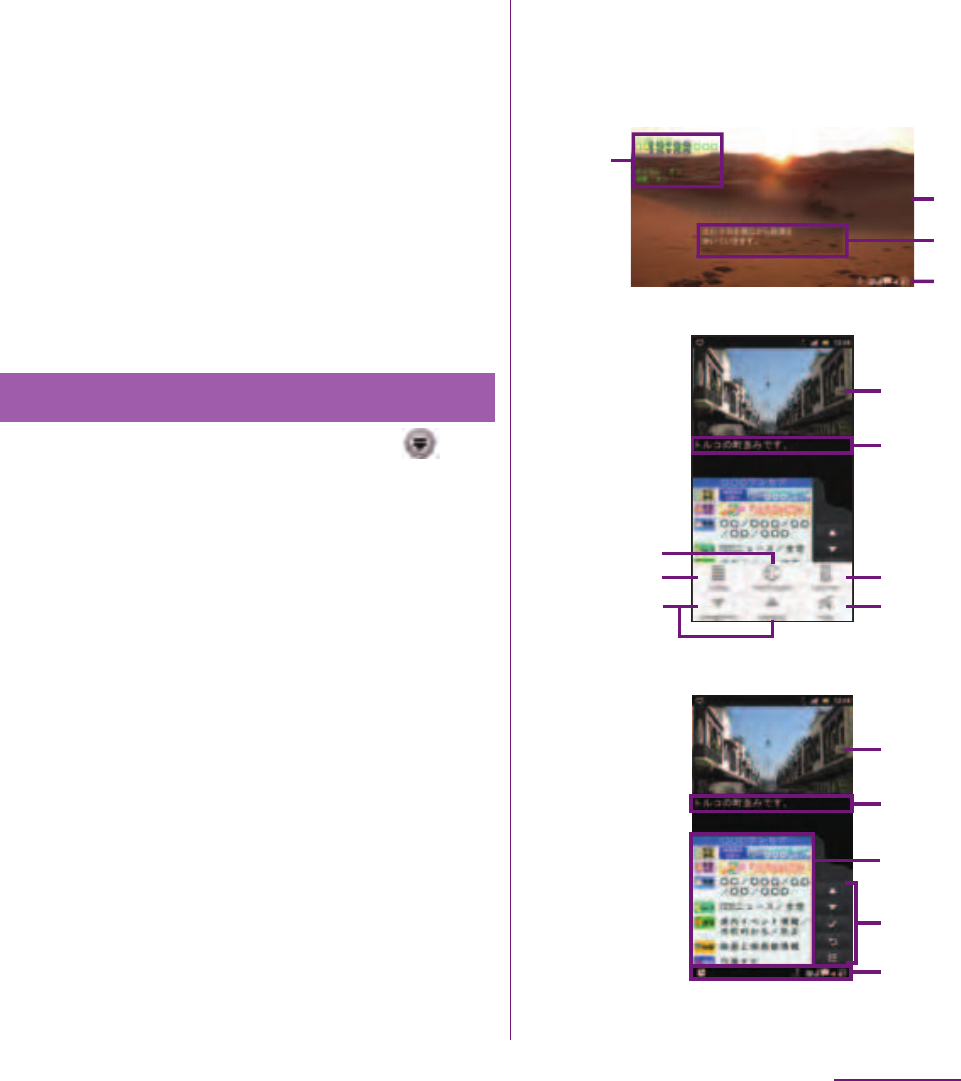
213
Applications
3
Tap [YES].
4
Tap entry box, enter a title name
and tap [OK].
・
To go back to 1Seg menu, tap
x
.
❖
Information
・
Alternatively, tap [Select area] in Step 2 then select
area to make channel setting.
・
Channel setting may not be made in the area where
a terrestrial digital TV broadcasting service has just
started.
1
From the Home screen, tap ,
and then tap [1Seg].
2
Tap [Activate 1Seg].
・
1Seg watching screen appears. Tap the
image to temporarily view program
information such as channel, program
name, multi-channel formation
(multiple services), etc.
・
Tap
t
on the 1Seg watching screen
to display operation bar.
❖
Information
・
It may take a time to acquire image data or
broadcasted data when you activate 1Seg or change
channels due to characteristic of digital
broadcasting.
・
According to the airwave condition, image or sound
may be interrupted or stopped.
・
If the terminal receives a call while watching 1Seg,
1Seg is interrupted and resumes after the call ends.
■
1Seg screen
Watching 1Seg program
k
a
c
b
1Seg watching screen (Full screen)
1Seg watching screen (operation bar screen)
d
a
b
g
hf
e
i
j
k
a
b
1Seg watching screen (with Data broadcasting)
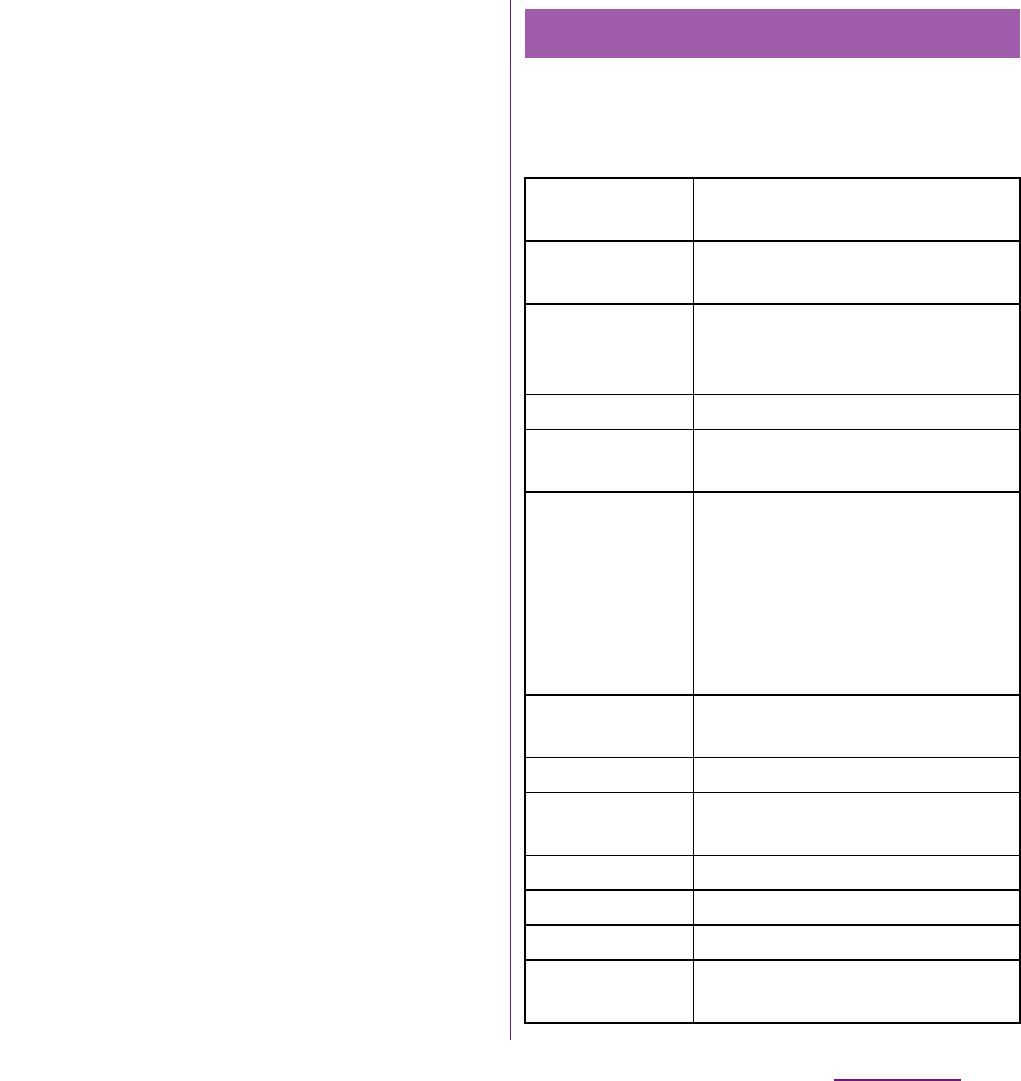
214
Applications
a
Image
b
Subtitle
c
Program information
d
Switch screen view : Switch screen between full
screen data broadcasting and 1Seg program with
data broadcasting (only for vertical view).
e
Advanced settings
f
DOWN selection/UP selection : Select previous or
next channel you are currently watching.
g
Remote controller : Display numeric keys 1-12 to
switch channels and keys for searching stations.
h
Mute
i
Data broadcasting : Display data broadcasting
content.
j
Remote controller for data broadcasting : Display
operation keys for data broadcasting such as Move
focus, Select focus, Back, Show numeric keys, etc.
k
1Seg status bar : Display icons for reception level,
subtitle, muting, channel, volume, off timer, etc.
❖
Information
・
Press
m
on the 1Seg watching screen to adjust
volume.
・
Recording 1Seg program is not supported.
・
You can watch 1Seg turning the terminal sideways. If
the screen orientation does not change
automatically when you turn the terminal sideways,
from the Home screen, tap
t
and tap
[Settings]
u
[Display], then mark [Auto-rotate screen]
checkbox.
・
For data broadcasting, screen display supports
portrait only.
・
Flick the 1Seg watching screen left and right to select
the previous or next channel you are currently
watching.
・
To exit 1Seg, tap
x
on the 1Seg watching screen.
1
On the 1Seg watching screen
(P.217), tap
t
and tap [Setting].
・
You can set the following options.
Setting 1Seg
Channel info
Display information for available
channels.
Program info
Display information for received
programs.
Channel list
Registered areas (broadcasting
service area) are listed as a channel
list.
Channel setting
Make channel setting.
Add to channel
list
Add a channel from 1Seg watching
screen.
Program guide
Activate "G
ガイド番組表
(G-Guide
program table)" to view program
table.
・
Alternatively, from the 1Seg
menu, tap [Program guide] to
activate "G
ガイド番組表
(G-Guide
program table)".
Switch display
Switch display between image and
data broadcasting.
Caption setting
Switch Display subtitle to on or off.
Off timer
Make a timer setting to end 1Seg
watching.
Main/sub sound
Set main/sub sound.
Sound switch
Set to switch sound.
Volume setting
Adjust the volume level.
Sound effect
setting
Switch sound effect of data
broadcasting between on and off.
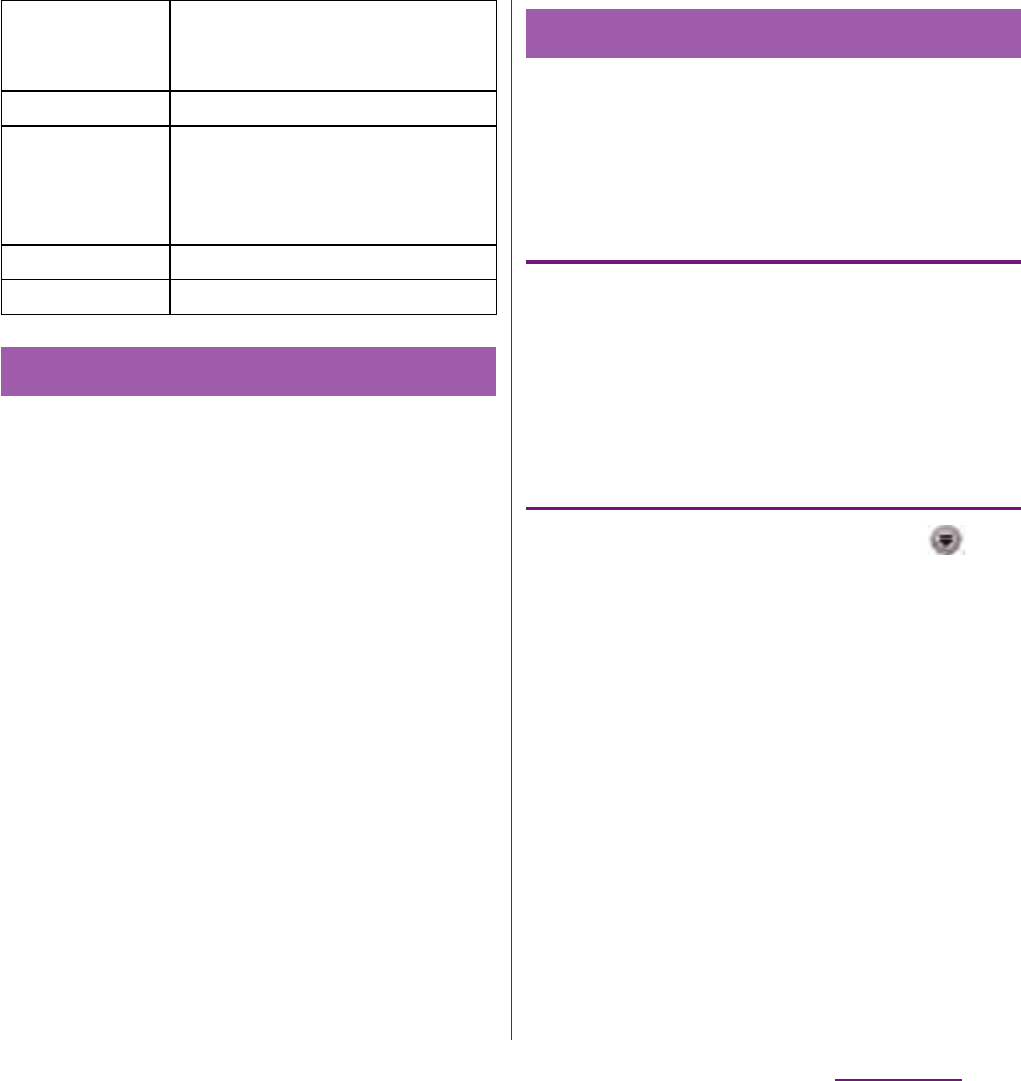
215
Applications
For data broadcasting, you can view various
information by following the onscreen
instructions.
❖
Information
・
To watch data broadcasting, call charge or packet
communication charge is not required. If you use
additional services of data broadcasting, etc. via
packet communication, packet communication fees
are charged.
For some data broadcasting programs, link
information to related websites (TVlink) is
displayed. Save TVlinks to connect to related
websites later.
Saving TVlinks
1
On the 1Seg watching screen
(including data broadcasting)
(P.217), select TVlink to store.
・
After this step, follow the onscreen
instructions to operate.
Display TVlinks
1
From the Home screen, tap ,
and then tap [1Seg].
2
Tap [TVlink].
・
A TV link list screen appears.
3
Select a TVlink.
■
When a link content or HTML content
is selected
Tap [Yes]/[OK].
❖
Information
・
Some TVlinks have period of validity. Out of date
TVlinks are no longer available.
Reset
confirmation
status
Initialize the confirmation screen
display.
Back to data BC
Display data broadcasting.
Tune service
You can select a sub-channel when
several programs (services) are
broadcasted for separated sub-
channels in a channel.
TVlink
Stored TVlinks appear.
Operation guide
A guide for watching 1Seg appears.
Watching data broadcasting
Using TVlink
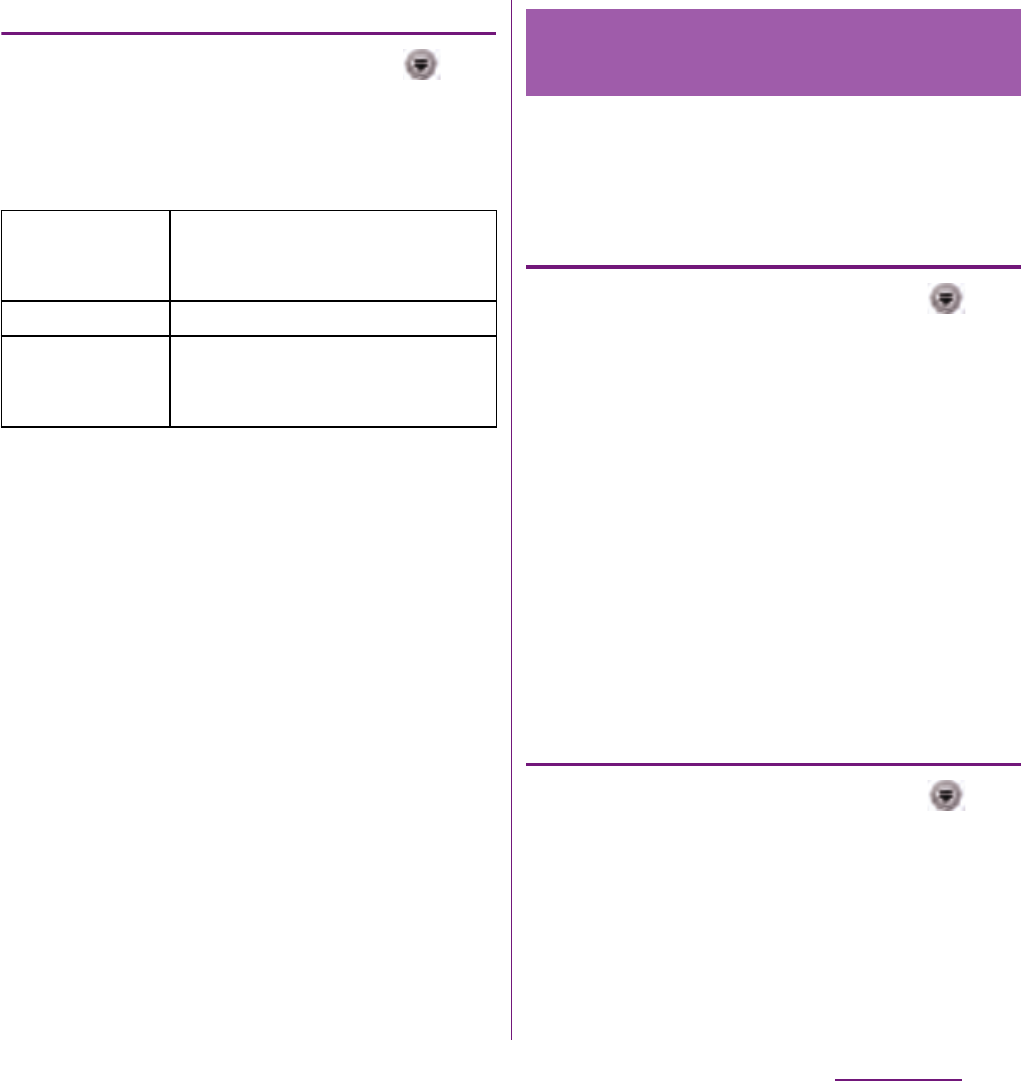
216
Applications
Viewing/Deleting details of TVlink
1
From the Home screen, tap ,
and then tap [1Seg].
2
Tap [TVlink] and tap
t
.
・
A menu list appears.
❖
Information
・
On the list screen in TVlink, touch and hold a TVlink
item to display menus for displaying detailed
information, etc.
・
When TVlink is not registered, tapping
t
on the
list screen in TVlink does not display the menu.
Available channels vary depending on the
area (broadcasting service area) you are
using in.
Storing broadcasting service areas
1
From the Home screen, tap ,
and then tap [1Seg].
2
Tap [Channel setting]
u
[Current
area].
・
Available channels are searched.
3
Tap [YES].
4
Tap entry box, enter a title name
and tap [OK].
❖
Information
・
Alternatively, tap [Select area] in Step 2 then select
area to make channel setting.
Changing broadcasting service area
1
From the Home screen, tap ,
and then tap [1Seg].
2
Tap [Channel list] to select a list
from registered channel lists.
・
The broadcasting service area is
changed.
Check the
number of
registration
Check the number of stored
TVlinks.
Delete all
Delete all stored TVlinks.
Delete selected
Delete several stored TVlinks.
Mark TVlink to delete and tap
t
, tap [Delete data?]
u
[YES].
Storing/Changing
broadcasting service areas

217
Applications
■
Using menus on the channel list
selection screen
Touch and hold the channel list selection
screen to display menus for displaying
information, setting, editing titles, deleting,
etc.
Change TV remote number assigned to each
broadcasting station. Each broadcasting
station can be called up via the
corresponding TV remote number.
1
From the Home screen, tap ,
and then tap [1Seg].
2
Tap [Channel list]
u
A list you want
to change.
3
Touch and hold the channel
information.
4
Tap [Remote control No.]
u
A
broadcasting service area you
want to change.
5
Tap a remote number you want to
save to.
6
Tap
x
, then tap [YES].
You can set, initialize, and reset watching
screen, data broadcasting screen from User
setting.
Initializing settings
You can initialize the channel setting and
1Seg setting.
1
From the Home screen, tap ,
and then tap [1Seg].
2
Tap [User setting]
u
[Reset channel
setting]/[Reset 1Seg settings].
3
Tap [YES].
Changing numbers for TV
remote
Making User setting
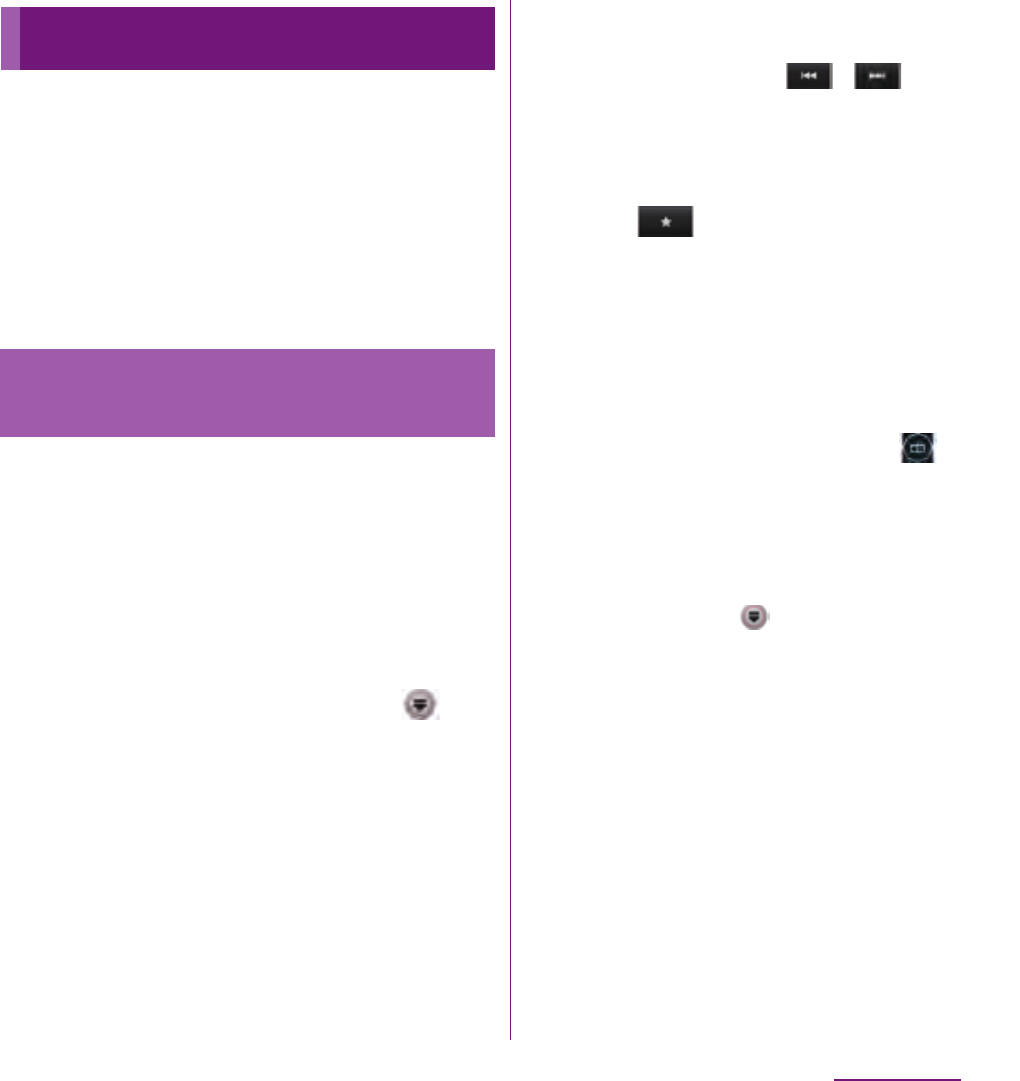
218
Applications
You can listen to the FM radio with the
terminal. Tuning can be made automatically
or manually, and you can register your
favorite channels to Favorites. To use FM
radio, use a handsfree device such as Stereo
Headset with Microphone (Sample), etc. or a
headphone. They work as antenna.
1
Connect Stereo Headset with
Microphone (Sample) to the
terminal.
・
For connection of Stereo Headset with
Microphone (Sample), see "Using
Stereo Headset with Microphone"
(P.193).
2
From the Home screen, tap ,
then tap [FM radio].
・
FM radio screen appears and selecting
channel starts automatically. You can
select channel by dragging the screen.
To select channel automatically
furthermore, go to Step 3.
3
Tap
t
, then tap [Search for
channels].
・
Alternatively, tap / to search
for channels.
・
The search ends when radio waves are
received.
4
Tap , then tap [+ Add XX.X to
favorites].
5
Tap entry box, enter a name and
tap [Save].
・
The frequency bands of searched
channels are registered to Favorites.
6
To stop the FM radio, tap .
❖
Information
・
You can return to the Home screen to perform
another operation while listening to FM radio in the
background. To return to the FM radio screen, from
the Home screen, tap then tap [FM radio], or drag
the status bar downward and tap [FM radio] on the
Notification panel.
・
When the UIM is not inserted, the frequency band
range is 87.5MHz - 108.0MHz. You cannot listen to
the FM radio programs in Japan.
FM radio
Searching and registering
channels

219
Applications
■
FM radio screen
a
Monaural sound/stereo effect
b
Play in speaker/Play in handsfree
c
Channel point displayed in a good radio wave
condition
d
On/Off of FM radio
e
Broadcasting station now listening
f
Channel assigned to favorite
g
Search channels automatically
h
Move left to select next favorite
i
Tuning button ( for Favorites)
j
Move right to select next favorite
1
On the FM radio screen, tap
t
.
2
Tap [Play in speaker]/[Play in
headphones].
・
The sound output is switched to the
speaker/handsfree device.
Osaifu-Keitai equipped with IC card is a
function which allows you to pay money or
to use coupon, stamp-rally, etc. only by
holding the terminal over an IC card reader in
stores etc.
You can access a site or website, obtain the
latest coupon, check credit or payment of
electronic money, etc. by holding the
terminal over the IC card reader. In addition,
you can lock your Osaifu-Keitai to provide
against loss or theft, and you can use Osaifu-
Keitai with safe.
For details on Osaifu-Keitai, refer to "
ご利用ガ
イドブック
(sp
モード編
) (Mobile Phone User's
Guide [sp-mode]) (in Japanese only)" or
dmarket.
* A setting from the dedicated website or
application is required to use Osaifu-Keitai
compatible services.
Switching the speaker and
handsfree device
c
d
e
j
i
h
f
g
a
b
Osaifu-Keitai

220
Applications
Precautions on using Osaifu-Keitai
・
The data (including electronic money, points,
etc.) in the IC card may be lost or modified
because of the malfunction of the terminal
(When we take your Osaifu-Keitai for repair
etc., as we cannot take it with data remained,
you are required to erase the data by
yourself). For support such as reissuance,
restoration, temporary preservation or
transfer of data, contact Osaifu-Keitai
compatible service providers. For important
data, be sure to use a service with backup
service.
・
If the data in the IC card is lost, modified or
damaged by any means related to Osaifu-
Keitai compatible service such as malfunction
or model change, DOCOMO assumes no
responsibility for the loss of data.
・
If the terminal is stolen or misplaced,
immediately contact Osaifu-Keitai
compatible service provider for an advice.
・
The terminal does not support iC transfer
service.
1
From the Home screen, tap
then tap [Osaifu-Keitai].
2
Select a service you want to use
from a service list.
・
At the first time you activate Osaifu-
Keitai, an initial setting screen appears.
Follow the onscreen instructions.
You can exchange data with an IC card reader
only by holding mark over the card reader.
・
When holding mark over an IC card reader,
make sure not to hit the terminal strongly.
・
Hold mark horizontally over the center of
the IC card reader.
・
Slowly move the terminal to hold mark
over the IC card reader.
Using Osaifu-Keitai
Holding Osaifu-Keitai over IC
card reader
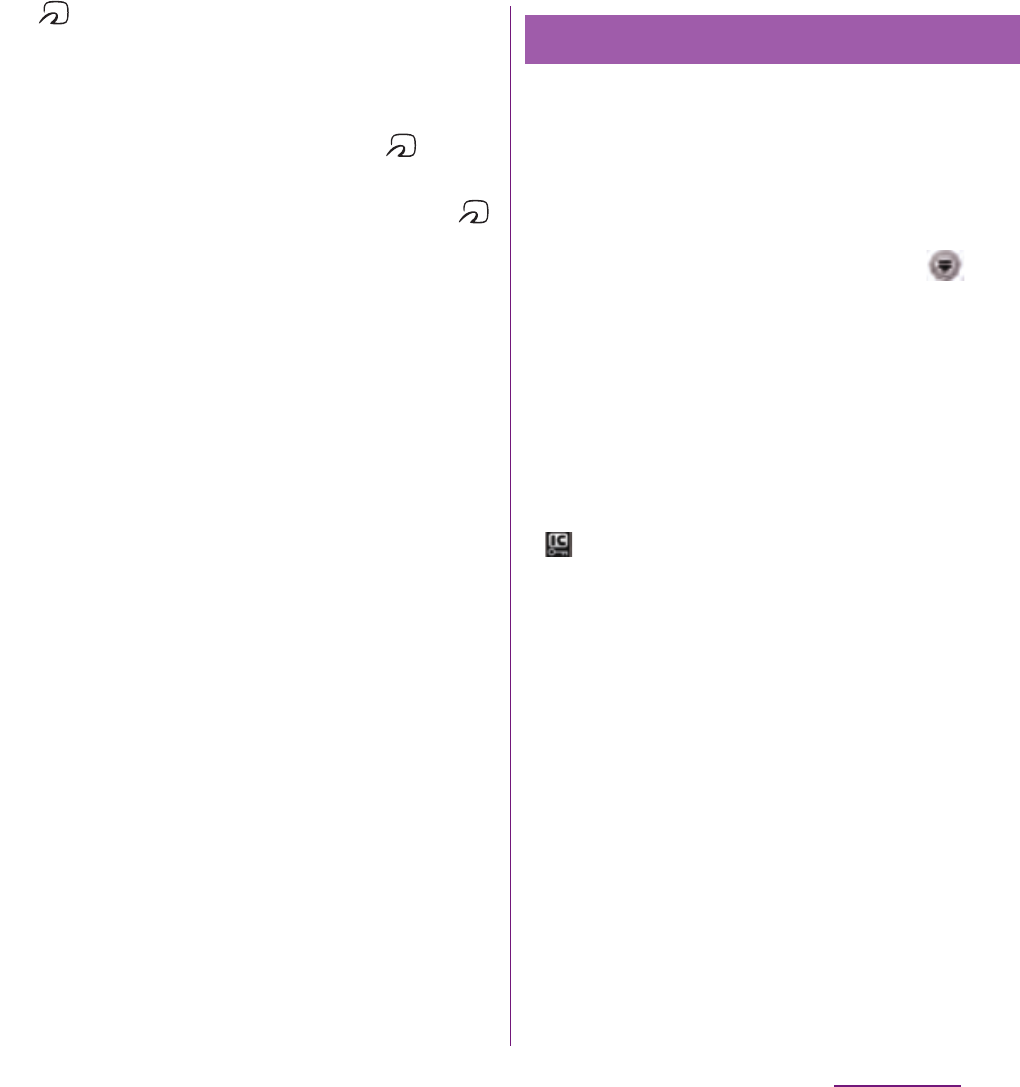
221
Applications
・
If mark is not recognized even when
holding over the IC card reader, try slightly
picking the terminal up off the reader, or
moving the terminal back, forth and around.
・
If there are metal objects between mark
and an IC card reader, scanning may be failed.
And note that a sticker put on nearby the
mark may affect communication
performance.
❖
Information
・
You can scan and write data to or from an IC card
reader without activating Osaifu-Keitai compatible
application.
・
The function is available even if the terminal is off,
but it may not be available in case you leave the
terminal off for a long time or the battery level is low,
etc.
Use "Osaifu-Keitai Lock Setting" to restrict the
use of Osaifu-Keitai function and related
services.
・
Osaifu-Keitai lock is different from screen lock
for the terminal, SIM card lock.
1
From the Home screen, tap
then tap [Osaifu-Keitai].
2
Tap
t
, then tap [Osaifu-Keitai
Lock Setting].
3
Follow the onscreen instructions
to enter unlock pattern.
❖
Information
・
is displayed in the status bar when you set
"Osaifu-Keitai Lock Setting".
・
Note that you cannot cancel "Osaifu-Keitai Lock
Setting", if the battery runs out while using "Osaifu-
Keitai Lock Setting". Be careful about remaining
battery level. If the battery runs out, charge the
terminal before canceling "Osaifu-Keitai Lock Setting".
・
You need to enter unlock pattern to use Osaifu-Keitai
menu while using "Osaifu-Keitai Lock Setting".
・
IC card unlock pattern will not be deleted even if you
reset the terminal.
・
Note that you cannot cancel "Osaifu-Keitai Lock
Setting" if you forget both the lock pattern and
answer for security question.
Locking Osaifu-Keitai function

222
Applications
iD is a convenient electronic money by credit
clearance scheme. You can enjoy shopping
simply and conveniently only by holding
Osaifu-Keitai with credit information set or
the iD-compatible card over the IC card
reader in stores. Because up to 2 types of
credit information can be registered in
Osaifu-Keitai, you can use them according to
the benefits, etc. It also supports cashing,
depending on the card issuer.
・
To use iD with Osaifu-Keitai, subscribing to a
card issuer that supports iD, settings for iD
setting application are required.
・
The charges required for iD service (including
the annual charge) vary by card issuer.
・
For using the application, a packet
communication charge is applied.
・
A packet communication fee for oversea use
differs from the one in Japan.
・
For details on iD, refer to iD website (http://id-
credit.com/ (In Japanese only)).
ToruCa is an electronic card that can be
obtained to mobile terminals. It can be
obtained from the IC card reader or site as
store information, coupon ticket, etc.
Obtained ToruCa is saved to the "ToruCa"
application. Use the "ToruCa" application to
display, search or update.
For details on ToruCa, refer to "
ご利用ガイド
ブック
(sp
モード編
) (Mobile Phone User's
Guide [sp-mode]) (in Japanese only)" or
dmarket.
❖
Information
・
For obtaining, displaying or updating ToruCa, a
packet communication charge may be applied.
・
Some ToruCa provided to i-mode terminal may not
be obtained/displayed/updated.
・
Depending on the settings of IP (Information
Provider), the following functions may not be
available.
- Obtaining/Updating from the IC card reader,
sharing ToruCa, moving to microSD card, copying/
displaying map
・
Some ToruCa which can be displayed in a map from
ToruCa (details) may not be displayed in a map from
the ToruCa list depending on the IP settings.
・
While using Osaifu-Keitai Lock Setting, you cannot
obtain ToruCa with an IC card reader.
・
If you set
重複チェック
(Duplication check) to "ON",
obtaining the same ToruCa redundantly is not
available. To obtain the same ToruCa redundantly, set
it to "OFF".
iD
設定アプリ
(iD setting
application)
ToruCa

223
Applications
・
When you send ToruCa attaching to email, it is sent
in the condition before obtaining ToruCa (details).
・
Depending on email application, ToruCa received via
the emails may not be saved.
・
Depending on browser, ToruCa cannot be obtained.
・
When ToruCa is moved/copied to the microSD card,
it is moved/copied in the condition before obtaining
ToruCa (details).
・
You may not be able to obtain ToruCa with an IC card
reader, if you do not make initial setting for Osaifu-
Keitai.
The terminal has a built-in calendar for the
schedule. If you have a Google account, you
can synchronize the terminal's calendar and
web calendar. See "Accounts & sync" (P.132).
・
When you register Google account, tap the
Google account displayed in "Accounts &
sync" and a sync item "Sync Calendar". You
can create schedule etc.
1
From the Home screen, tap ,
then tap [Calendar].
2
Tap [Month]/[Week]/[Day] to
select.
Calendar
Setting the calendar view

224
Applications
1
From the Home screen, tap ,
then tap [Calendar].
2
Tap at the upper right.
・
Tap
t
and tap [New event] to
create a schedule in Calendar.
3
Enter a schedule name, date, and
time.
4
If you have two or more calendar
accounts, select one.
5
If necessary, select the repetition
intervals of the calendar.
6
Select the notification intervals of
the schedule.
・
Tap to add a new notification into
the schedule.
7
Enter a place and some others of
schedule.
8
Tap [Save].
❖
Information
・
Tap [More] and scroll through the screen to set "Time
zone", "Guests (Email addresses)", "Show me as:", and
"Privacy".
Displaying a schedule in Calendar
1
From the Home screen, tap ,
then tap [Calendar].
・
Flick the calendar left or right to display
the next or previous month/week/day
according to the view mode.
2
Tap a schedule you want to
display.
❖
Information
・
To view the events created in "Schedule" application
in the Calendar, while the Calendar is displayed, tap
t
and [My calendars] to synchronize with the
docomo account.
・
If you log in to Facebook, tap [Sync Calendar] in the
"Facebook inside Xperia
™
" (P.134) to display events
in Facebook in the Calendar.
1
If a reminder icon ( ) appears in
the status bar, drag the bar
downward.
・
The notification panel opens.
・
The reminder icon appears at set
Notification time.
2
Tap a schedule.
3
Tap [Snooze all] or [Dismiss all].
・
If you have any schedules on hold, they
appear on the same screen.
Creating a schedule in Calendar
Releasing the reminder of a
schedule or setting the snooze

225
Applications
・
If you tap [Snooze all], all the alarms
sound again 5 minutes later.
(Snooze is a function that sounds the
alarm some time later even though you
stop it.)
Set Calendar view, reminder notifications,
ringtone, vibration, reminder time.
1
From the Home screen, tap ,
then tap [Calendar].
2
Tap
t
and [Settings].
3
Select an item to change.
With "Alarm and Clock" application, you can
set an alarm, show the clock or photo
slideshow on the display, or play music with
the Media player.
1
From the Home screen, tap .
2
Tap [Alarm and Clock].
・
The Clock screen appears.
a
Alarm display
・
Appear when there is a set alarm.
b
: Turn off the backlight.
・
Tap the screen to light up.
c
Clock display
・
When 5 minutes are passed without touching the
display, the day and time view appears.
d
: Display the alarm list screen.
e
: Display a slideshow.
f
: Display the Media player screen.
g
: Go to the Home screen.
Changing the calendar settings
Alarm and Clock
b
a
c
efg
d

226
Applications
❖
Information
・
If you tap
t
on the Clock screen, "Dock settings"
appears. However the dock compatible to this
function is not sold by Sony Mobile Communications
Japan, Inc. (as of February, 2012).
1
From the Home screen, tap ,
then [Alarm and Clock]
u
Tap .
・
The alarm list screen appears.
2
Tap [Add alarm].
・
An alarm setting screen appears. You
can set the following items.
3
Tap [Done].
・
Return to the alarms list screen.
❖
Information
・
To set on/off of the alarm, mark the checkbox on the
alarm list screen.
・
On the alarms list screen, tap "Time" at the top of the
screen to display the clock screen (P.229).
・
While using World clock/Stopwatch/Timer, tap
[Alarm] at the bottom of the screen to display the
alarm list screen.
Deleting the alarm
1
On the alarm list screen, tap
t
and [Delete].
2
Mark the alarm setting you want to
delete.
3
Tap [Delete]
u
[Yes].
❖
Information
・
Alternatively, on the alarm list screen, touch and hold
the alarm setting you want to delete, then tap
[Delete alarm]
u
[Yes] to delete the alarm setting.
Setting alarm
Time
Tap number to set the time.
Repeat
Set a day of the week for the alarm.
Alarm text
Enter texts that appear while alarm
is sounding.
Snooze
duration
Set time interval to sound the
ringtone again after stopping the
ringtone.
Style settings
Mark the checkbox to display an
image while alarm is sounding.
Alarm sound
Set alarm sound.
Vibrate
Mark to vibrate at the alarm time.
Mute alarm
Mark not to sound at the alarm time.
Customize
volume
Mark to change alarm volume.
Alarm volume
Drag the slider left or right to adjust
the level.
Alarm in silent
mode
Mark to sound alarm even in silent
mode.
Side keys
behavior
Select an effect when pressing
m
/
k
while alarm is
sounding.
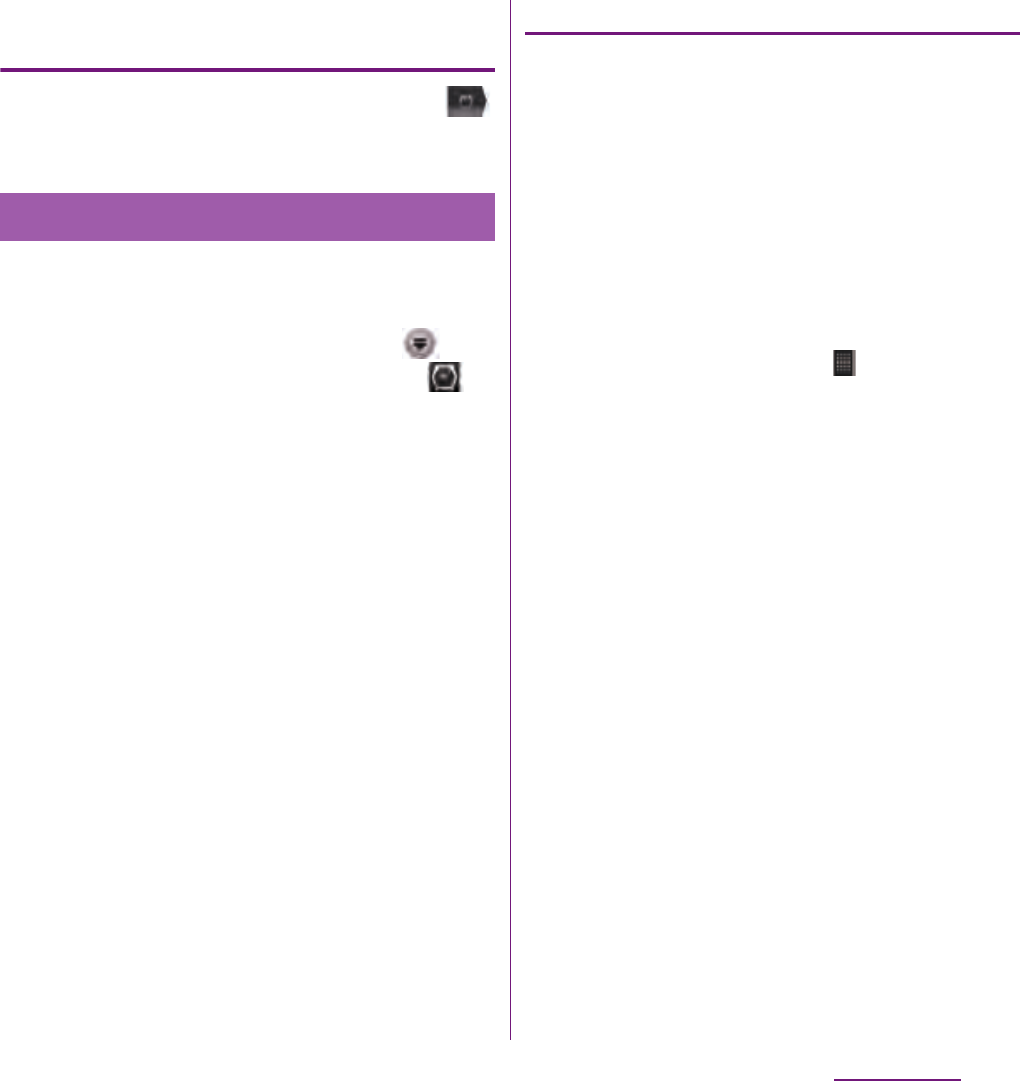
227
Applications
Stopping an alarm while the alarm is
sounding
1
While alarm is sounding, touch
and drag it to the right.
Display the date and time in cities around the
world.
1
From the Home screen, tap ,
then [Alarm and Clock]
u
Tap .
2
Tap [World clock].
・
The list screen of the world clock
appears.
3
Tap [Add new].
4
Drag the screen up and down to
select a city.
❖
Information
・
Date and time of the world clock synchronizes with
date and time set on the terminal.
・
On the list screen of the world clock, tap "Time" at
the top of the screen to display the clock screen
(P.229).
・
On the list screen of the world clock, tap [Compare
time] to graphically display dates and time in regions
around the world that you set.
Changing World clock
You can switch, sort or delete Celsius/
Fahrenheit displayed on World clock.
1
On the list screen of the world
clock, tap
t
.
■
Switching Celsius/Fahrenheit
Tap [Celsius]/[Fahrenheit].
・
Switch Celsius/Fahrenheit.
■
Sorting
Tap [Rearrange]
u
Drag of the date in
the world clock up and down
u
Tap
[Done].
■
Deleting
Tap [Delete]
u
Mark world clock
checkbox you want to delete
u
Tap
[Delete]
u
[Yes].
Using World clock
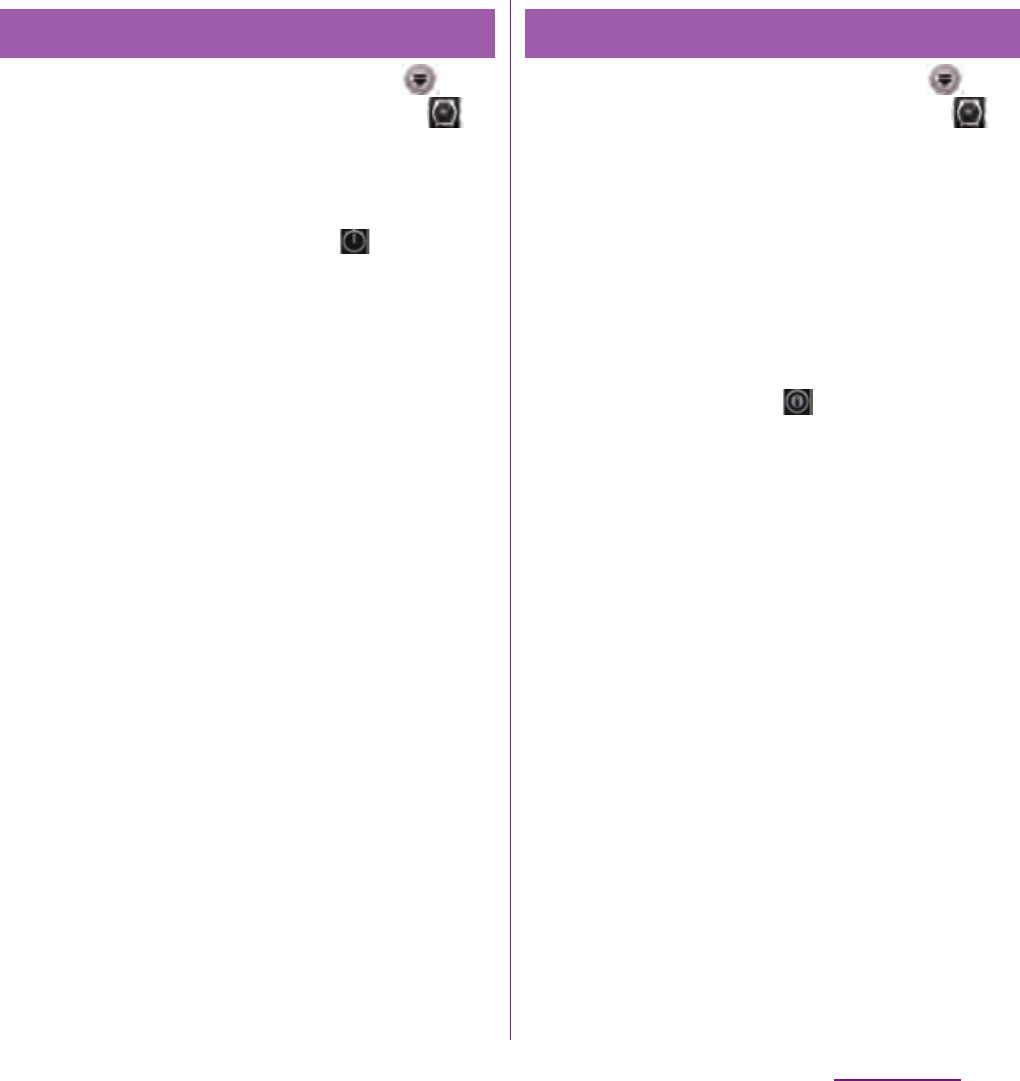
228
Applications
1
From the Home screen, tap ,
then [Alarm and Clock]
u
Tap .
2
Tap [Stopwatch].
3
Tap [Start].
・
Measurement starts and appears in
the status bar.
・
Tap [Lap] to measure elapsed time.
4
Tap [Stop].
・
Tap [Start] to resume measuring.
・
Tap [Reset] to delete measured time
and lap time.
1
From the Home screen, tap ,
then [Alarm and Clock]
u
Tap .
2
Tap [Timer].
・
Time screen appears.
3
Tap [Set time].
4
Tap number to adjust the time and
then tap [Set].
5
Tap [Start].
・
Timer starts, and appears in the
status bar.
6
Tap [Stop].
・
Stop sounding alarm after a set time
has elapsed.
・
Tap [Stop] within a set time duration to
pause timer. Tap [Start] to resume timer.
❖
Information
・
To change alarm sound, on the timer screen, tap
t
, then [Settings] and select the alarm sound you
want to change, and then tap [Done].
Using Stopwatch Using Timer

229
Applications
With OfficeSuite, you can view files of Word,
Excel, etc. from the terminal or a microSD
card.
1
From the Home screen, tap .
2
Tap [OfficeSuite].
・
OfficeSuite starts.
You can use the following online services on
the terminal.
PlayNow is a web application which allows
you to use news flash, dictionary service, etc.
To use the application, on the Browser
screen, tap
t
and tap [Bookmarks] and
tap [PlayNow] to connect the dedicated site.
For membership registration etc., operate
following the onscreen instructions.
Show dedicated website to access SE Home.
To use the function, from the Home screen,
tap [SE HOME].
Follow the screen to download the "SE
Home" application, allowing you to access
"SE Home", the website for the smart phone
introducing Sony Ericsson products and
campaign information.
Show dedicated website to access the PS
Store.
To use the application, from the Home
screen, tap [PS Store
を始めよう
(Let's start PS
Store)].
Follow the onscreen instructions to
download necessary application. You can
buy games from PS Store to enjoy it on your
terminal.
OfficeSuite
Starting OfficeSuite
Other applications
PlayNow
SE Home
PS Store
を始めよう
(Let's start
PS Store)
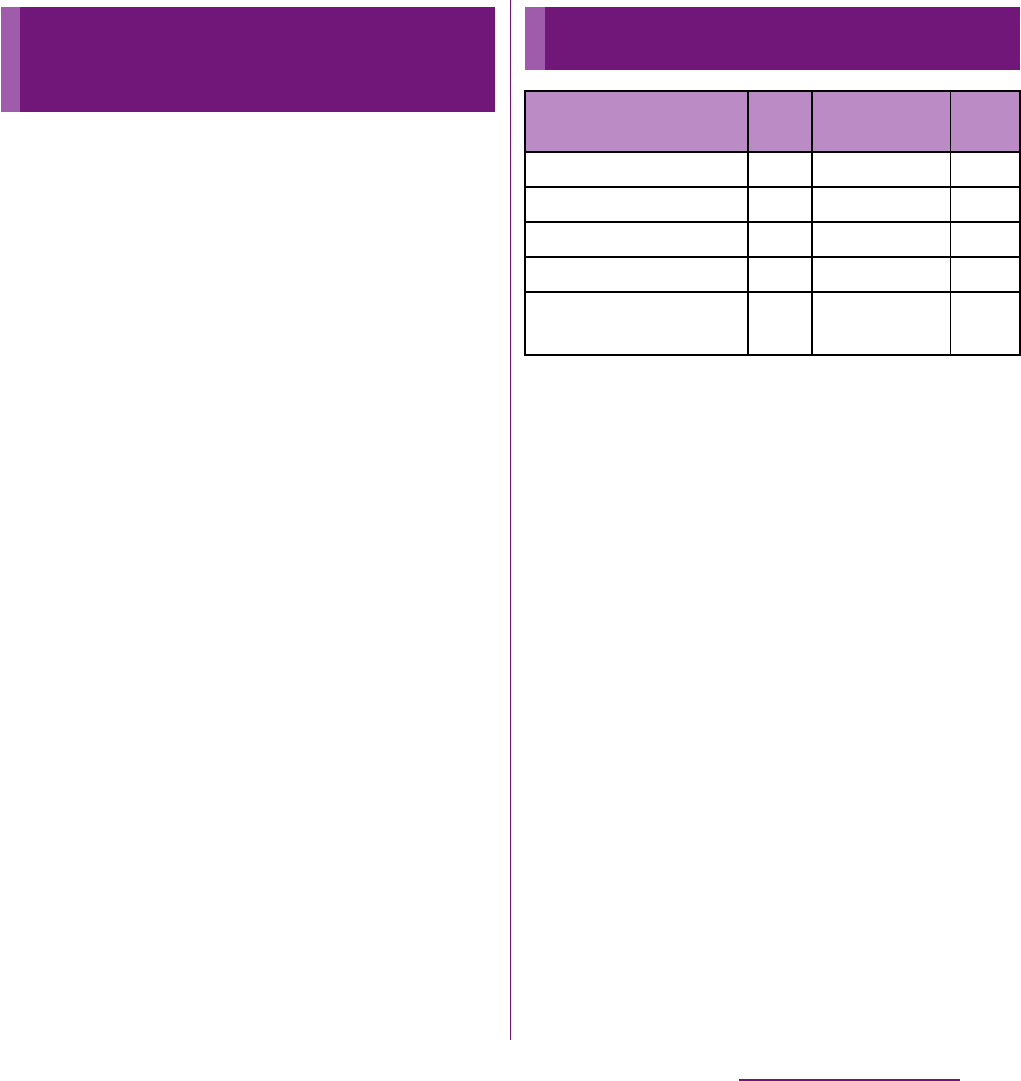
230
International roaming
International roaming
With the international roaming (WORLD
WING), you can use the terminal without
changing phone number or mail address in
the service area of the overseas network
operator affiliated with DOCOMO. You do not
need to change the settings of call and SMS.
■
Service area
The terminal works in a 3G roaming area
and GSM/GPRS service area. Services are
also available in countries and areas
supporting 3G850MHz/GSM850MHz. Check
available areas.
■
Before using the terminal overseas,
refer to the followings.
・
"Mobile Phone User's Guide [International
Services]"
・
DOCOMO International Services website
❖
Information
・
For Country codes, International call access codes,
Universal number international prefix, supported
countries/areas and network operators, refer to
"Mobile Phone User's Guide [International Services]"
or DOCOMO International Services Website.
*1 To use data communication during roaming, mark
[Data roaming] checkbox in Mobile network
settings. (P.238)
*2 For GPS positioning (Positioning location), a packet
communication charge is applied.
・
Some services are not available depending on
the overseas network operator or network.
Overview of International
roaming (WORLD WING)
Available Services
Main communication
services 3G GSM/GPRS GSM
Phone
○ ○ ○
Message (SMS)
○ ○ ○
Email
*1
○ ○
u
Browser
*1
○ ○
u
Position location of
GPS
*2
○ ○
u

231
International roaming
To use the terminal overseas, check the
following in Japan.
■
Subscription
・
Check if you subscribe WORLD WING. For
details, contact "General Inquiries" on the
last page of this manual.
■
Usage charge
・
Overseas usage charges (call and packet
communication) differ from those in
Japan.
・
Some applications automatically perform
packet communications. Your packet
communication charges may be higher.
For operation details of each application,
please contact the application provider.
Network service settings
If you subscribe to network services, you can
use network services such as Voice Mail
Service, Call Forwarding Service, Caller ID
Notification Service, etc., even overseas.
However, some network services cannot be
used.
・
To use network services overseas, you need to
set "Remote access" to activate. You can set
"Remote access" in the country you stay.
(P.242)
・
Even if the setting/canceling operation is
available, some network services cannot be
used depending on overseas network
operators.
Before using
Before leaving Japan
Advance preparation

232
International roaming
When you arrive overseas and turn on the
terminal, an available network is
automatically set.
Connectivity
When you have set search mode of "Available
networks" to "Automatic" in "Service
providers" settings, optimized network is
automatically selected.
When you connect to the network operator
conducted in flat-rate service manually, you
can use the service with flat-rate packet
communication charges overseas up to the
specified upper limit per day. To use this
service, subscription of packet flat-rate
service is required. For details, refer to
"Mobile Phone User's Guide [International
Services]" or DOCOMO International Services
Website.
Display
In the status bar, the type of your operator's
network is displayed.
: During International roaming
/ : GPRS available/in communication
/ : 3G (packet) available/in
communication
/ : HSDPA available/in communication
・
You can confirm the name of the connected
network operator on the Notification panel.
Date & time settings
When "Date & time" is set to "Automatic", the
date, time and time differences of the
terminal clock are corrected by receiving the
information related to time and time
differences from the network of overseas
network operator you connect to.
・
Correction of the time/time differences may
not be performed correctly depending on the
network of overseas network operator. In that
case, set time zone manually.
・
Timing of correction varies by the overseas
network operator.
・
Date & time (P.139)
About inquiries
・
For loss or theft of the terminal or UIM,
immediately contact DOCOMO from the spot
to take the necessary steps for suspending
the use. For inquiries, see the last page of this
manual. Note that you are still liable for the
call and communication charge incurred after
the loss or theft occurred.
・
For using from land-line phone, entering
"International call access code" or "Universal
number international prefix" for the country is
needed.
After arriving overseas

233
International roaming
After returning to Japan
When you return to Japan, the terminal is
connected to DOCOMO network
automatically. If connection is failed, perform
the following operations.
・
Set "Network Mode" to "WCDMA (preferred)/
GSM". (P.238)
・
Set "Search mode" to "Automatic" in "Service
providers" settings. (P.237)
When you start the international roaming or
move out of your operator's network, you
need to reconnect the terminal to another
available network.
❖
Information
・
Some applications automatically perform packet
communications. To disconnect packet
communication manually, from the Home screen,
tap
t
and tap [Settings]
u
[Wireless &
networks]
u
[Mobile networks]
u
[Data enabled] to
unmark.
Confirming and switching the
network search mode
By default, network search mode is set to
"Automatic". When you connect manually to
an overseas network operator conducted in
flat-rate service, confirm the search mode
with the following operations and switch to
"Manual".
1
From the Home screen, tap
t
and tap [Settings].
2
Tap [Call settings]
u
[Service
providers].
3
Tap [Search mode]
u
[Manual].
4
From "Available networks", tap a
network to mark.
・
To display available networks, tap
[Search networks].
❖
Information
・
If you set a network manually, the terminal is not
reconnected to another network automatically even
if you move out of the network area.
・
To return to "Automatic", tap [Automatic] in
Step 3.
Making setting for
international use

234
International roaming
Changing network mode settings
You can change network mode settings
according to the network mode
(communication method) adopted by the
overseas network operator.
1
From the Home screen, tap
t
and tap [Settings].
2
Tap [Wireless &
networks]
u
[Mobile
networks]
u
[Network Mode].
3
Select a network mode you use.
・
You can select from [WCDMA only],
[GSM only] or [WCDMA (preferred)/
GSM]. If you select [WCDMA
(preferred)/GSM], you can use both
GSM and WCDMA.
Activating data roaming
1
From the Home screen, tap
t
and tap [Settings].
2
Tap [Wireless &
networks]
u
[Mobile networks].
3
Tap [Data roaming].
4
Read the cautions displayed, tap
[Yes].
・
[Data roaming] checkbox is marked.
When you arrive overseas and turn on the
terminal, an available network is
automatically set.
・
Check that the battery and signal levels are
high enough.
・
Depending on the network operator, even if
the Caller ID notification is active, the caller ID
may not be notified or appear properly.
In this case, calls cannot be made from the call
log.
You can make a call from overseas using the
international roaming service.
・
You can easily make international calls from
the country you stay to Japan or to other
countries by entering prefix "+" and then the
country code and phone number.
1
From the Home screen, tap
[Phone]
u
[Dial] tab.
Making/Receiving calls in
the country you stay
Making a call to outside
country you stay (including
Japan)

235
International roaming
2
Dial + (touch and hold
[0])
u
Country code
u
Area code
(City code)
u
Enter a phone
number.
・
If the area code begins with "0", omit "0".
However, "0" may be required to dial to
some country or area such as Italy.
・
To call an overseas "WORLD WING" user,
enter "81" (Japan) for the country code.
・
You can enter country code using the
preset Convert country code list. Enter
a phone number and tap
t
to tap
[International call], then select country
code from the Convert country code.
3
Tap .
❖
Information
・
During international roaming, if you make an
international call to Japan using DOCOMO's
phonebook application, the "International dialing
assist" screen appears. You can make a call without
entering country code from that screen.
・
Convert country code list cannot be edited.
You can make a call by entering the phone
number of the other party's land-line phone
or mobile phone in the same way you do in
Japan.
1
From the Home screen, tap
[Phone]
u
[Dial] tab.
2
Enter the other party's phone
number.
・
To make a call to land-line phone, enter
the area code (city code) + other party's
phone number.
3
Tap .
When the other party uses international
roaming service, make a call as an
international call to Japan even when you
stay in the same country as the other party.
You can receive a call using the international
roaming service.
Making a call within the
country you stay
Making a call to WORLD WING
user overseas
Receiving a call in the country
you stay

236
International roaming
1
While receiving a call, touch
(left) and drag it to (right).
2
When the conversation is finished,
tap [End call].
❖
Information
・
When you received a call during the international
roaming, regardless of which country the call is from,
it is forwarded internationally from Japan. A caller is
charged for a call fee to Japan, and the receiver is
charged for a reception fee.
■
Having the other party call you
・
Calling from Japan to the country you stay
To have the other party make a call from a
land-line phone or mobile phone in Japan
to the terminal in the country you stay,
the other party only needs to dial the
phone number as in Japan.
・
Calling from the country except Japan to
the country you stay
You have to receive a call through Japan
no matter where you are; therefore, the
other party needs to enter the
international call access code and "81"
(Country code of Japan).
International access code - 81 - 90 (or 80)
- XXXX - XXXX
Make settings for using international
roaming or international calls.
Set restricting incoming calls overseas or
using roaming guidance.
・
For some overseas network operators,
settings may not be made.
Restricting incoming calls for
roaming
1
From the Home screen, tap
t
and tap [Settings].
2
Tap [Call settings]
u
[Network
service setting]
u
[Roaming
settings].
3
Tap [Restricting incoming calls].
・
Select items you want to use.
International roaming
settings
Settings for making/receiving
calls overseas
Activate
restricting
Tap any of [Restricting all incomings]/
[Restricting incoming of video call/
64K data], enter the network security
code, and tap [OK].
Deactivate
restricting
Enter the network security code and
tap [OK].
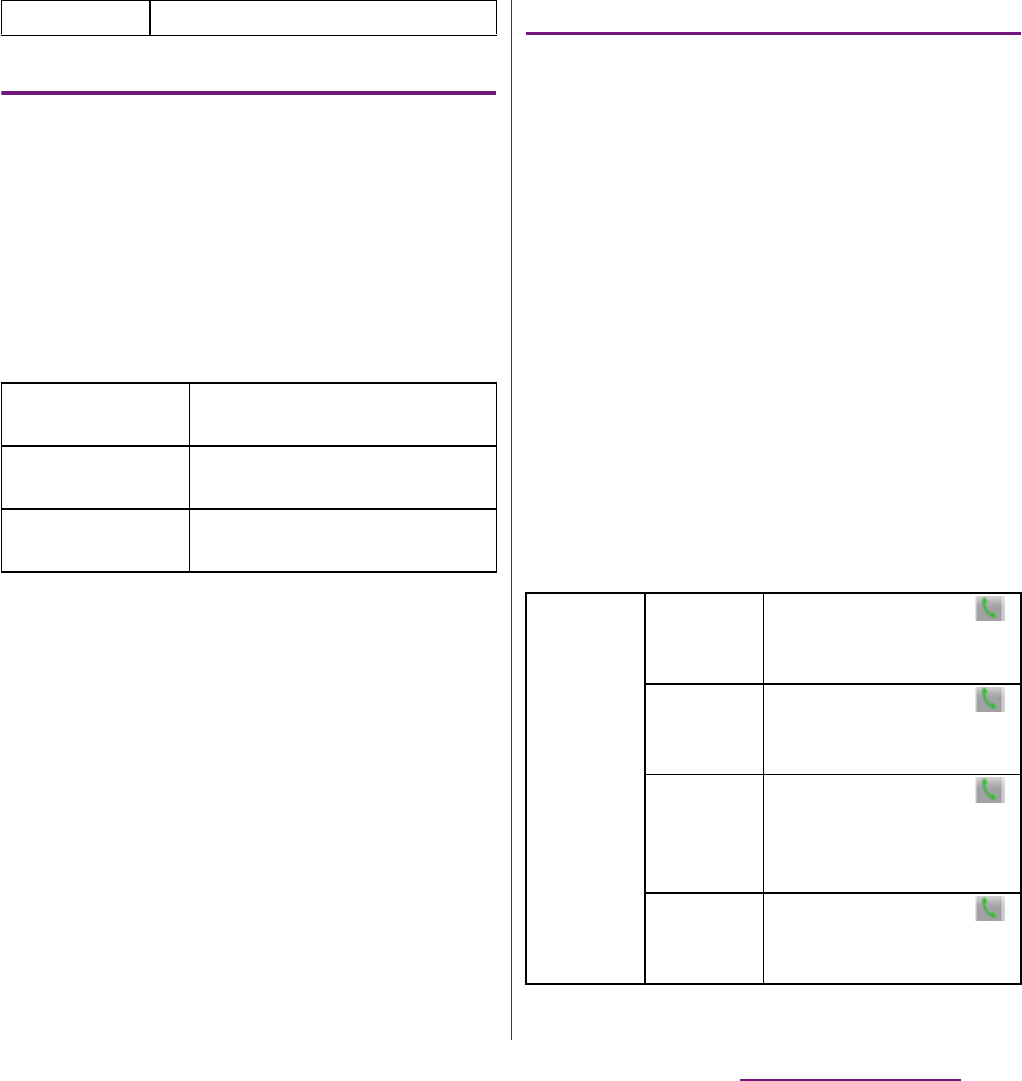
237
International roaming
Setting roaming guidance
1
From the Home screen, tap
t
and tap [Settings].
2
Tap [Call settings]
u
[Network
service setting]
u
[Roaming
settings].
3
Tap [Roaming guidance].
・
Select items you want to use.
Settings Network service (overseas)
Set network service such as voice mail from
overseas.
・
If you make the settings overseas, you are
charged a call fee to Japan from the country
you stay.
・
For some overseas network operators,
settings may not be made.
1
From the Home screen, tap
t
and tap [Settings].
2
Tap [Call settings]
u
[Network
service setting]
u
[Roaming
settings].
3
Tap [Network service].
・
Select items you want to use. You need
to set "Remote access" to activate.
Check settings
Check the current service settings.
Activate roaming
guidance
Tap [OK] to activate roaming
guidance.
Deactivate
roaming guidance
Tap [OK] to deactivate roaming
guidance.
Check settings
Check the current service
settings.
Voice mail
(charged)
Activate
Voice mail
(roaming)
Tap [OK], and then tap .
*
Deactivate
Voice mail
(roaming)
Tap [OK], and then tap .
*
Play voice
mail
message
(roaming)
Tap [OK], and then tap .
After this step, follow the
voice prompts to play the
message.
Voice mail
settings
(roaming)
Tap [OK], and then tap .
*
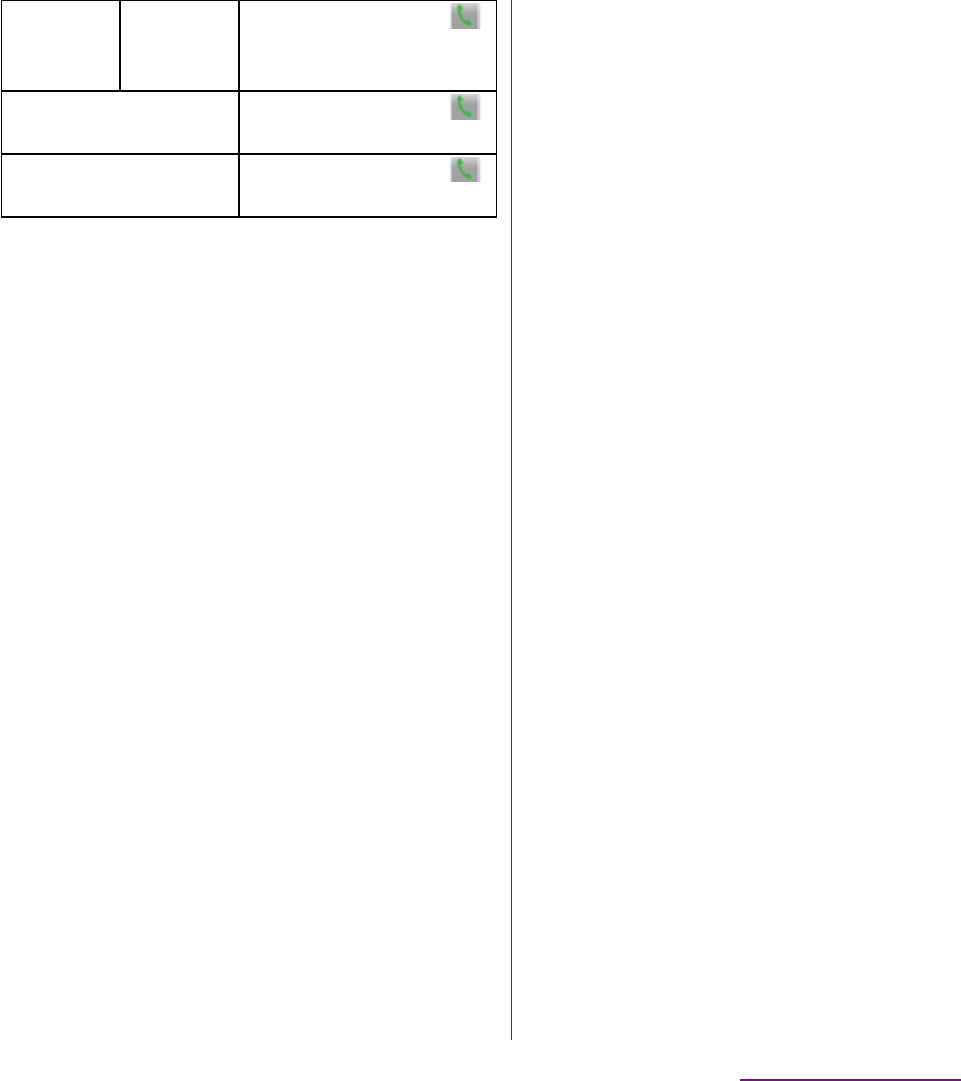
238
International roaming
* Follow the voice prompts to operate.
Voice mail
(charged)
Voice mail
ring time
(roaming)
Tap [OK], and then tap .
*
Roaming guidance
(charged)
Tap [OK], and then tap .
*
Remote operation
(charged)
Tap [OK], and then tap .
*
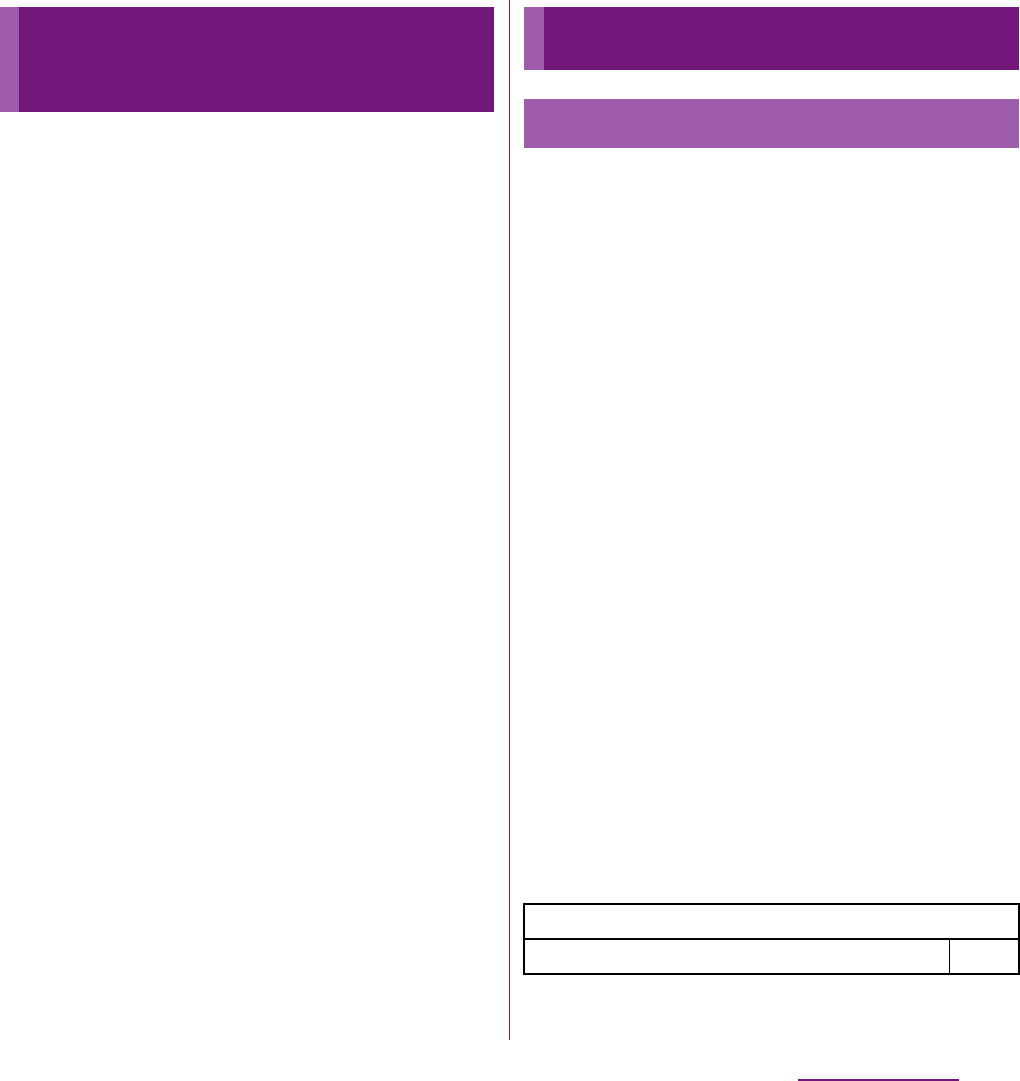
239
Appendix/Index
Appendix/Index
A variety of commercially available optional
devices allows you to expand the terminal's
capabilities by supporting a wide range of
purpose, including personal and business
uses.
Some accessories are only available in some
areas.
For details, please contact a sales outlet such
as docomo Shop.
For details on optional devices, see the user's
manual of each device.
・
AC Adapter cable SO03
・
Carry Case 02
・
FOMA Portable Charging Adapter 02
*
・
Pocket charger 01/02
・
AC Adapter 03
・
DC Adapter 03
・
Desktop Holder SO12
* To charge the terminal, use the supplied
microUSB cable.
・
First, check if the software update is necessary
for the terminal. If necessary, perform the
software update (P.252).
・
When checking the following items not to
improve the state, contact the phone number
given in "Repairs" the last page of this manual
(in Japanese only) or DOCOMO-specified
repair office.
・
If the back cover is removed, check the
direction of the cover and attach to the
terminal body. Push the back cover in the
direction of the arrow until it clicks and make
sure that there are not any spaces between
the body and cover.
■
Power supply
Optional and related
devices
Troubleshooting
Troubleshooting
Cannot power on the terminal.
・
Check if the battery pack is not run out. P.33
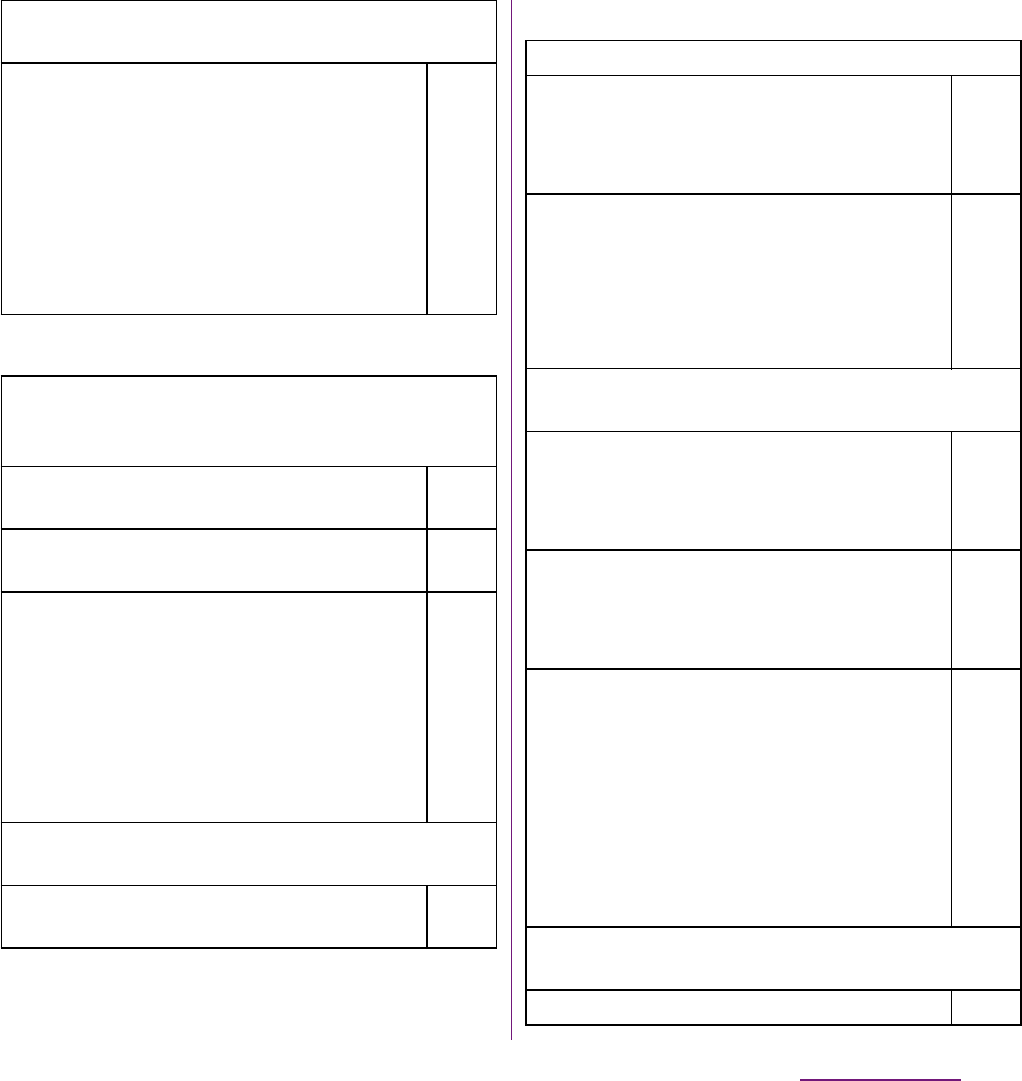
240
Appendix/Index
■
Charging
■
Terminal operation
Screen does not respond. I cannot turn the power
off.
・
Press
p
and upper of
m
at the
same time for approximately 5 seconds, and
release your finger after the terminal
vibrates once to restart the terminal.
Or, press
p
and upper of
m
at the
same time for approximately 10 seconds
and release your finger after the terminal
vibrates 3 times to turn off the terminal
forcibly.
P.38
Cannot charge the terminal.
(The notification LED does not turn on, or the icon
that means charging does not appear.)
・
Check if the AC adapter cable's power plug
is correctly inserted to an outlet.
P.36
・
Check if the AC adapter cable and the
terminal are set correctly.
P.36
・
If you execute calls, communications or
other function operations for a long time
while charging, the terminal may become
hot and the battery status icon may not
indicate charging (charging stops) or
charging may not be completed. In this
case, wait until the temperature of the
terminal drops and charge again.
−
The notification LED blinks in red and cannot
operate the terminal.
・
When the battery level is low, charge the
internal battery.
P.33
Become hot while operating/charging.
・
While calling, depending on the radio wave
condition or call duration time, the terminal
may become hot. This condition is not
abnormal.
−
・
While operating or charging, or if you watch
1Seg or record video etc. for a long time
while charging the battery, the terminal,
internal battery and AC adapter may
become hot. There is no problem about
safety and continue to use it.
−
The operation time provided by the battery pack is
short.
・
Is your terminal left for a long time under
the state of out of service area?
Out of service area, more power is
consumed to search available radio waves.
−
・
The operating time of the internal battery
varies depending on the operating
environment and the degradation level of
the internal battery.
P.33
・
The internal battery is a consumable
accessory. The usage duration of the battery
per one charge decreases gradually each
time the battery is recharged.
Even the full charge state, when the
operation time is too short, contact the
phone number given in "Repairs" the last
page of this manual (in Japanese only) or
DOCOMO-specified repair office.
−
No operations are performed even by pressing the
keys on the terminal.
・
Check if you activate the screen lock. P.127

241
Appendix/Index
■
Phone call
The screen reacts slowly when a button is pressed.
・
When large amount of data is saved in the
terminal or transferring large-size data
between the terminal and microSD card,
the reactions on the screen may be delayed.
−
The UIM is not recognized.
・
Check if the UIM attached in the right
direction.
P.30
The clock is not on time.
・
The clock time may become wrong while
turning on the power for a long time. Check
if "Auto" time adjust setting (Auto time
adjust via network) is set to on and turn the
power off and on in a place with strong
radio wave conditions.
P.139
The terminal operation is unstable.
・
Instability may be caused by applications
that you installed after purchasing the
terminal. If the symptom is improved when
you boot the terminal in safe mode (near
default state), uninstalling the installed
application may improve the symptom.
To boot the terminal in safe mode, press and
hold
p
for over a second with the
terminal OFF until SONY logo appears, and
then touch and hold
t
until the terminal
vibrates once. When safe mode is booted,
"Safe mode" is displayed at the lower left of
the screen.
To exit the safe mode, turn power OFF and
then ON.
* Back up the necessary data before using
safe mode.
* Some widgets that you created may be
removed.
* Safe mode is not a normal booting state.
To use ordinarily, exit the safe mode.
−
Cannot make a call even if you press the dial button.
・
Check if you activate the SIM card lock. P.126
・
Check if you activate Airplane mode. P.111
The ringtone does not sound.
・
Is the call alert volume of volume setting set
to silent?
P.121
・
Check if the silent mode is active. P.120
・
Is the ring time for Voice Mail service or Call
Forwarding Service "0 Sec."?
P.98
P.100
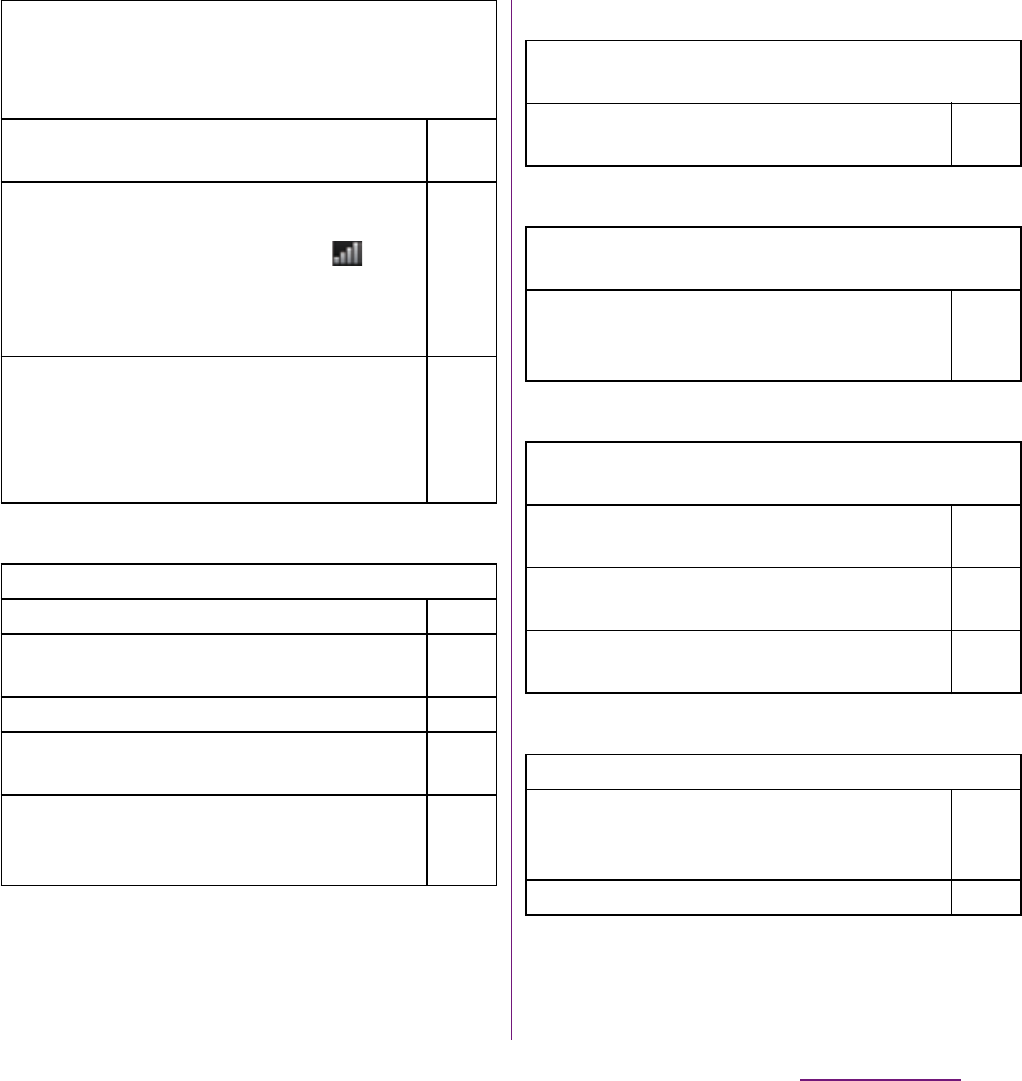
242
Appendix/Index
■
Display
■
Sound
■
Display data
■
Camera
■
1Seg
Calls are not connected.
(Even when moving "
圏外
(out of service area)" does
not disappear, or although radio waves are enough,
making/receiving calls is unavailable.)
・
Turn the power OFF and ON, or remove and
attach UIM.
P.30
P.37
・
Due to the nature of radio waves, making/
receiving calls may be unavailable even
when "not out of service area" or "
appears on the display for the radio wave
condition". Move to the other place and call
again.
−
・
Due to the crossing of radio waves, at the
crowded public places, calls/mails are
crossed and the connection status may not
be good. Move to other place or call again
at other time.
−
The display is dim.
・
Check if the backlight time-out is set. P.123
・
Check if the brightness of screen is
changed.
P.122
・
Check if you activate eco
モード
(eco mode). P.75
・
Check if you cover the Proximity sensor with
sticker etc.
P.29
・
When the temperature of the terminal
becomes high while using, the display may
become darker. It is not abnormal.
−
During a voice call, the distant party's voice is hard
to listen to or too loud.
・
Check if the listening volume of the sound
volume setting is changed.
P.84
Images or ringtones set in each feature do not work
and the terminal operates in the default data.
・
Is the inserted UIM the same one that is set
when the images or ringtones are
obtained?
−
Still images and video taken with the camera are
blurred.
・
Check if clouds or dirt attach to the lens of
camera.
−
・
To shoot a portrait image, use the face
detection function.
P.177
・
Shoot using shake reducing function. P.184
P.190
Watching 1Seg is unavailable.
・
Are you out of terrestrial digital TV
broadcasting service area or in a place
where airwave is weak?
−
・
Is channel set? P.216
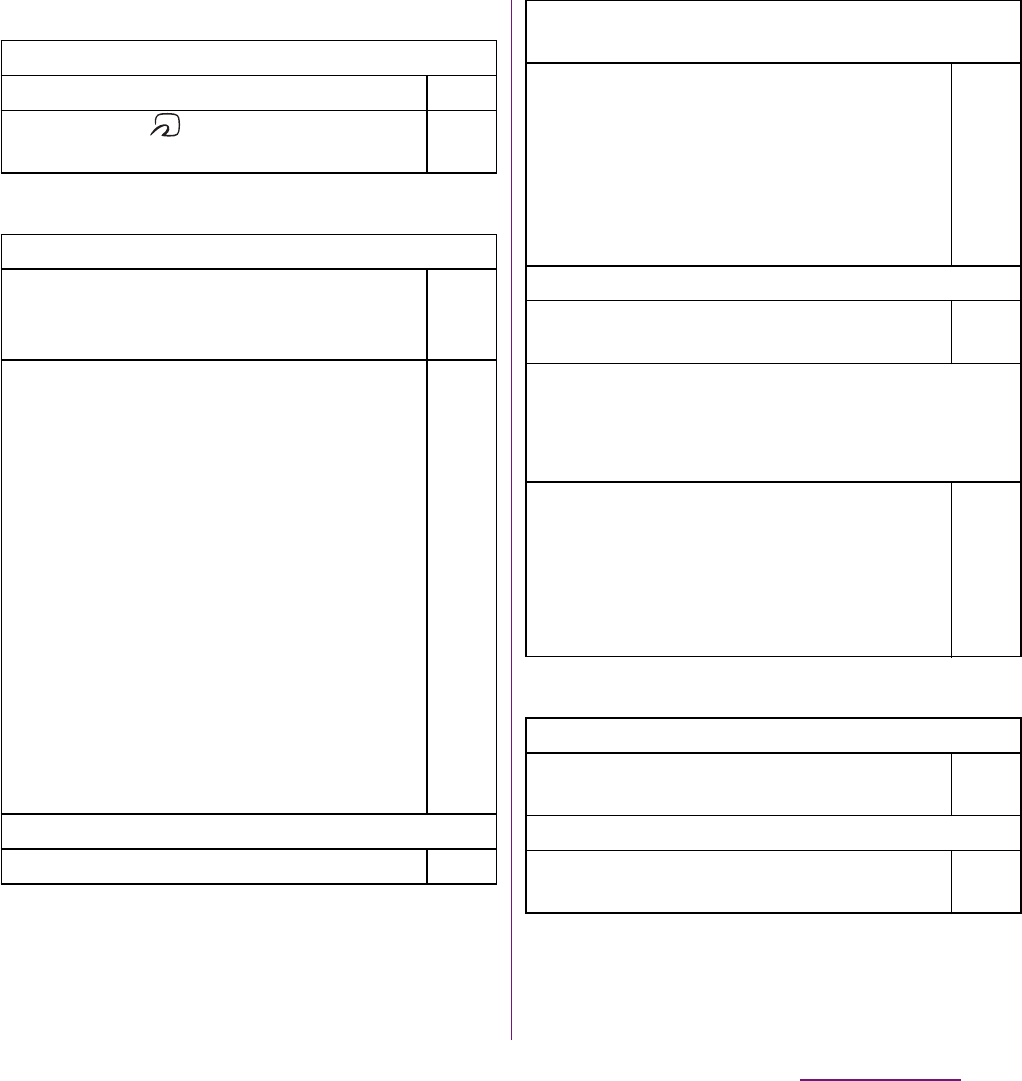
243
Appendix/Index
■
Osaifu-Keitai
■
International roaming
■
Data management
Osaifu-Keitai function is unavailable.
・
Is Osaifu-Keitai lock activated? P.225
・
Do you place mark of the terminal over
an IC card reader?
P.224
Cannot use the terminal overseas.
■
When antenna mark is displayed
・
Do you subscribe WORLD WING?
Check if you subscribe WORLD WING.
−
■
Out of service area indicator appears
・
Check if you are out of the international
roaming service area or in an area with poor
signal strength. Check if the service area and
network operator are available, referring to
"Mobile Phone User's Guide [International
Services]" or DOCOMO International
Services website.
・
Try to change the network settings or
overseas network operator settings.
Set "Search mode" of "Service providers" to
"Automatic".
Set "Network Mode" to "WCDMA preferred/
GSM".
・
Turning off the terminal and then turning
on again may work for the restoration.
P.236
P.238
P.37
Cannot perform data communication overseas.
・
Mark the data roaming checkbox. P.238
The terminal suddenly became unavailable while
using overseas.
・
Check if usage amount exceeds the limit of
maximum charges for use.
For use of "International roaming (WORLD
WING)", the limit of maximum charges for
use is set in advance. If exceeding the limit
of maximum charges for use, pay the
charges.
−
Cannot receive calls overseas.
・
Is "Restricting incoming calls" set to
"Activate restricting"?
P.240
No caller ID is notified/A notified caller ID is
different from that of the caller/Functions for using
contents saved in phonebook or those using Caller
ID notification do not operate.
・
Even if a caller notifies its caller ID, it is not
displayed on the terminal unless the
network or network operator notifies it. And
a different caller ID may be notified
depending on the network or network
operator you use.
−
Data transfer is not performed.
・
Check if USB hub is used. If you use USB hub,
operations may not be performed correctly.
−
Data saved in microSD card is not displayed.
・
Remove the microSD card and insert it
again.
P.31

244
Appendix/Index
■
Bluetooth function
No service
・
The terminal is out of service area, or the
received signal is too weak. Move to a location
where radio signal can be reached.
・
The UIM is not working properly.
Insert the UIM in another terminal. If this
works, it is probably the terminal that is
causing the problem. In this case, contact
"Repairs" on the last page of this manual (in
Japanese only).
Removing and inserting UIM may improve
the problem.
SIM card is locked
Enter your PIN code (P.126) correctly.
SIM card is PUK-locked
Enter your PUK (Personal Unblocking Key)
(P.126) correctly.
The phone storage is full
There is no memory space. Delete
unnecessary applications (P.131) to obtain
memory space.
When trying to display an image, "
u
" appears
instead of it.
Or "
u
" appears for the demo play or the preview
function.
・
"
u
" may appear instead of destroyed image
data.
−
The terminal cannot be connected to a Bluetooth
communication device/A Bluetooth
communication device cannot be found from the
terminal.
・
Make Bluetooth communication device
(commercial item) registering stand-by state
and then register the device on the
terminal. If you delete already registered
device and register the device again as a
new device, delete the registrations on both
Bluetooth communication device
(commercial item) and the terminal and
then perform registration of the devices.
P.167
Calls cannot be made from the terminal connecting
to external device such as car navigation or
handsfree device.
・
If calls are made several times when the
other party does not answer or is out of
service, the call to this number may be
disabled. In this case, turn terminal off and
on.
−
Error messages

245
Appendix/Index
・
Make sure that the warranty is received with
the terminal upon purchase. Check to be sure
that "
販売店名・お買い上げ日
(the name of the
retailer, date of purchase)", and other items
have been filled out on the warranty before
storing it in a safe place. If any necessary
information is not provided, immediately
contact the retailer and request to complete
the warranty. The terminal comes with a year's
free warranty starting from the date of
purchase.
・
Specifications of this product and its
accessories are subject to change for
improvement without prior notice.
・
Data saved in the Contacts etc. may be
changed/lost due to the trouble/repairs or
handling of the terminal. Note down the data
such as the contacts on a separate memo and
keep it safely to prevent such problems.
* You can save contents data in a microSD card
inserted to the terminal.
If you have problems with the
terminal
Before asking repair, see "Troubleshooting"
(P.243) in this manual to check the problem. If
the problem still persists, contact "Repairs"
on the last page of this manual (in Japanese
only).
If repair is required resultingly
Bring the terminal to the DOCOMO-specified
repair office. However, it must be taken
during business hours of the repair office.
Make sure to bring a warranty card with the
product when you visit the shop. Note that
repair may take some days depending on the
problem.
■
Within the warranty period
・
We repair the terminal free of charge
based on the terms documented in the
warranty.
Warranty and After Sales
Services
Warranty
After Sales Services

246
Appendix/Index
・
When requesting a repair, make sure to
bring the warranty card with the terminal.
Repair requests that are not accompanied
by the warranty or that involve
malfunction and damage due to incorrect
handling by the owner (damage of liquid
crystal, connector, etc.) will only be
repaired at the owner's expense, even if
the warranty period is still effective.
・
Malfunction due to use of devices and
consumable parts other than those
specified by DOCOMO will only be
repaired at the owner's expense, even if
the warranty period is still effective.
■
Note that repair may be refused in the
following cases:
・
When some water problem is
acknowledged by the repair office (e.g.
water leak seal is reacted).
・
When the terminal has corrosion due to
wet by liquid, condensation, perspiration,
etc. or the internal circuit board is
damaged or deformed (we may not be
able to repair when the microUSB
connector, headset connecting jack,
HDMI connecting jack, liquid crystal, etc. is
damaged or the frame itself is cracked)
based on the result of our examination.
- Even if repair is possible, it will be done
at the owner's expense, as this type of
corrosion or damage is not covered by
the warranty.
■
If the warranty period expires
We will repair the terminal at the owner's
expense.
■
Parts stock period
The functional parts necessary to repair the
terminal will be basically available for a
minimum of six years after the manufacture
is discontinued.
However, depending on the defective
portion, repair may not be possible because
of a shortage of repair parts. Note that repair
may still be possible depending on the
defective portion even if the stock period
has expired. Contact "Repairs" on the last
page of this manual (in Japanese only).
Precautions
●
Never modify the terminal or accessories.
・
Doing so may result in fire, injuries or
malfunctions.
・
The modified terminal may be repaired
only if the owner agrees on that all the
modified parts are restored to the original
conditions.
However, repairs may be refused
depending on the modifications.

247
Appendix/Index
The following cases may be considered as
modifications.
- Put a seal etc. on the liquid crystal or
keypad.
- Glued decorations on the terminal using
adhesion bond, etc.
- Change the parts such as exterior to
other than DOCOMO standard parts.
・
Malfunction and damage due to
modifications will be repaired at the
owner's expense, even if the warranty
period is still effective.
●
The model plate must not be removed
from the terminal.
The model plate certifies that the terminal
satisfies technical standards. It should be
noted that if the plate is removed or is
replaced with a different plate, and the
original model plate cannot be verified, it
may disqualify the unit from repairs due to
not being able to determine the technical
standards of that particular phone.
●
Note that the settings and other
information may be reset (cleared) as a
result of malfunction, repair or other
handling. In this case, make the settings
again.
●
After the repair, Wi-Fi MAC address or
Bluetooth address may be changed
regardless of the repaired parts.
●
A material that generates a magnetic field
is used in the following parts of the
terminal.
Do not hold an object that is easily
affected by magnetism, such as a cash
card, close to the terminal. You may not
be able to use the card any more.
Where it is used: Speaker, earpiece
Precautions on memory dial
(Contacts function) and downloaded
data
Note that data you created or data you
retrieved or downloaded from sources other
than your terminal may be changed or lost
when you change the model or have repairs
done to the terminal. DOCOMO shall have no
liability for any change or loss of any kind.
Under some circumstances, DOCOMO may
replace your terminal with its equivalent
instead of repairing it.

248
Appendix/Index
You can update the terminal to the most
recent software for optimal performance and
to get the latest enhancements.
❖
Note
・
When the terminal is connected to the Internet using
the mobile network connection, data
communication fee is applied.
・
Make sure you back up and save all data contained in
the terminal before you start updating the terminal.
・
For the first time activating the terminal after
software update, the operation may be slower from
several minutes to several ten minutes due to data
update. The required time varies by the data in the
terminal. Do not turn the power off until usual
operation speed comebacks.
❖
Information
・
For details, refer to http://www.sonymobile.co.jp/
support/.
Setting notification of Software
update
You can set to be notified of updating
software.
1
From the Home screen, tap ,
then tap [Update center].
2
Tap
t
, then tap [Settings].
3
Mark [Notifications] checkbox.
・
To change the notification tone, tap
[Notification tone], then tap notification
tone you want to change, and then tap
[Done].
❖
Information
・
If you mark [Notification vibration] checkbox in Step
3, Software update is notified by vibration.
Updating software
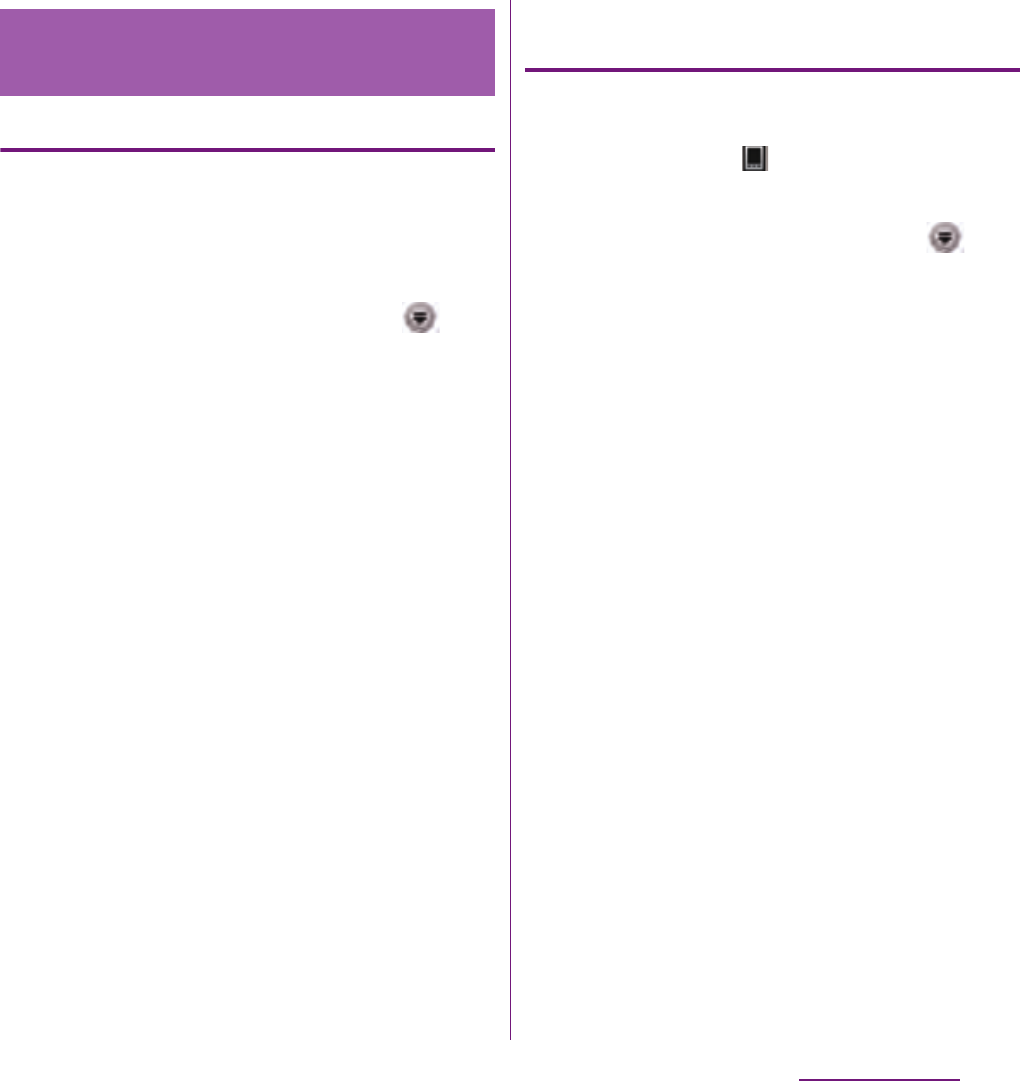
249
Appendix/Index
Downloading software to update
Software can be downloaded wirelessly
directly from your terminal via the Internet by
using mobile network connection or by using
a Wi-Fi network connection.
1
From the Home screen, tap ,
then tap [Update center].
2
Tap [System] tab, then tap
t
,
and then tap [Refresh].
・
The terminal searches for software
updates.
❖
Information
・
"Updates"/"New" tabs in the Update center screen
are not available because the services are not
provided in Japan.
❖
Note
・
For software update via mobile network, a high
packet communication charge will be applied
because of a large amount data communication. For
this reason, subscription of packet flat-rate service is
highly recommended.
・
While you are using roaming service overseas, you
cannot search for or download update software
through the mobile network.
Updating the latest software
automatically
You can update the latest software update
automatically on regular basis. If software
update is searched, appears on the status
bar.
1
From the Home screen, tap ,
then tap [Update center].
2
Tap
t
and [Settings].
3
Tap [Allow automatic
update:]
u
[Via Wi-Fi only]/[Via 3G/
Wi-Fi].
❖
Note
・
Note that if you select [Via 3G/Wi-Fi] in the Step 3, a
Wi-Fi connection automatically switches to 3G
connection when the Wi-Fi connection is unstable
and packet communication fee may apply.
・
Note that packet communication fee may apply for
searching automatically.
Downloading software updates
wirelessly

250
Appendix/Index
You can update software by using PC
Companion that can be installed into a PC
from the terminal.
❖
Information
・
To install PC Companion on a PC, an Internet
connection is required.
When PC Companion is not installed
on your PC
1
Use the supplied microUSB cable
to connect the terminal to a PC.
2
On the terminal, tap [Install].
・
Installer of PC Companion starts on the
PC.
3
Follow the onscreen instructions
on the PC to install.
・
After installation, PC Companion starts
on the PC. If further software update is
searched, it is automatically notified.
Follow the onscreen instructions on the
PC.
When PC Companion is installed on
your PC
1
Check if PC Companion is activated
on the PC. If not, activate PC
Companion from the Start menu.
2
Connect the terminal to a PC using
a microUSB cable.
3
Follow the onscreen instructions
on the PC.
・
If available software update is found, it
is automatically notified.
Connecting to a PC and
updating
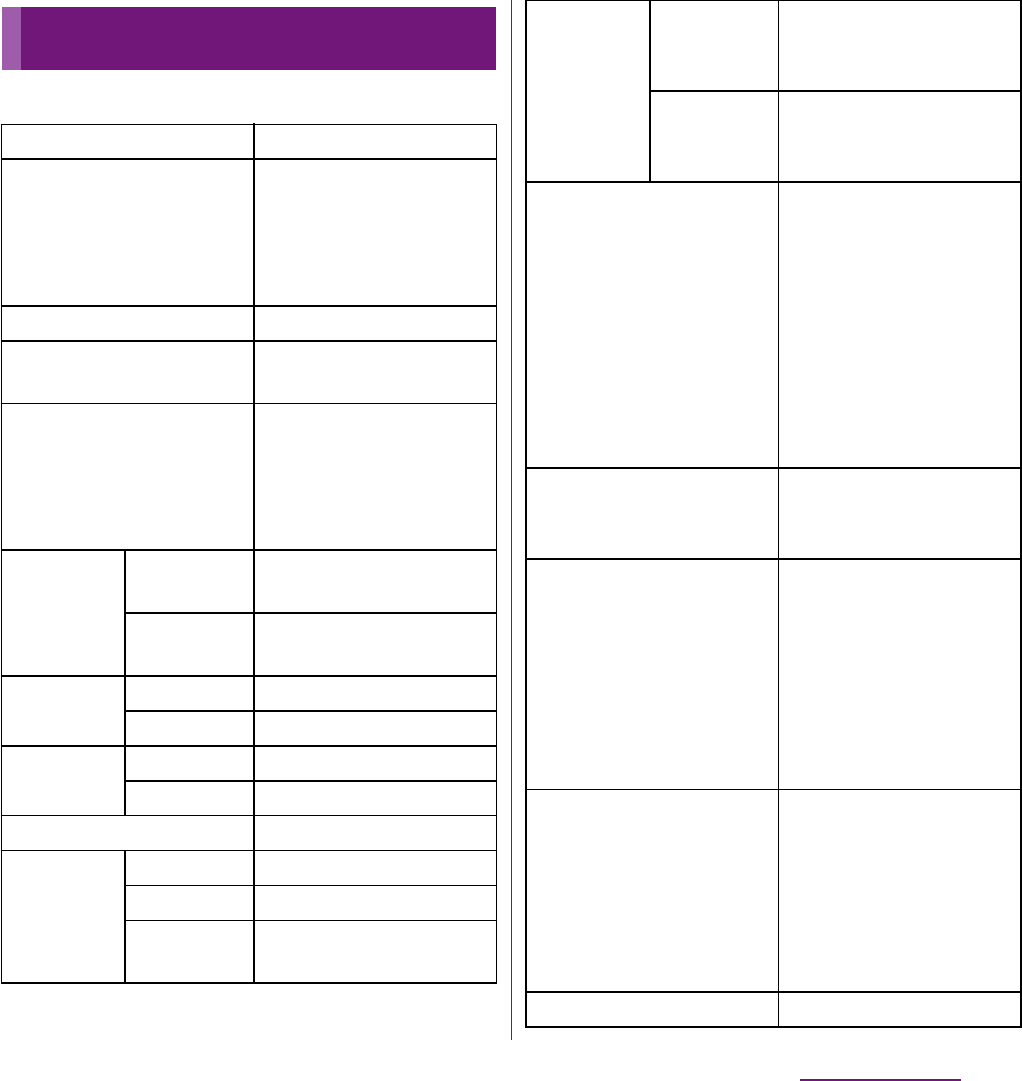
251
Appendix/Index
■
The terminal
Main specification
Product name
SO-04D
Size
Approx. 126mm (H)
u
approx. 66mm (W)
u
approx. 11.9mm (T)
(Thickest part : Approx.
11.9mm)
Weight
Approx. 149g
Storage
ROM 16GB
RAM 1GB
External storage
Compatible with microSD
card of up to 2GB, and
microSDHC card of up to
32GB (as of February,
2012).
Continuous
stand-by
time
FOMA/3G
Approx. 410 hours
(stationary)
GSM
Approx. 290 hours
(stationary)
Continuous
call time
FOMA/3G
Approx. 430 min.
GSM
Approx. 400 min.
Charging
time
AC Adapter
Approx. 190 min.
DC Adapter
Approx. 190 min.
1Seg watching time
Approx. 290 min.
Display Type
TFT16,777,216 colors
Size
Approx. 4.3 inches
Number of
dots
Width 720 dots
u
Hight 1280 dots
Image
pickup
device
Type
Camera : CMOS sensor
Front camera : CMOS
sensor
Size
Camera: 1/3.0 inches
Front camera :
1/6.0 inches
Camera pixels
Camera :
Effective pixels : Approx.
12,100,000 pixels
(Recorded pixels : Approx.
12,000,000 pixels)
Front camera :
Effective pixels : Approx.
1,300,000 pixels
(Recorded pixels : Approx.
1,220,000 pixels)
Digital zoom
Camera : Max. 16x (41
levels)
Front camera :
―
Still image capture size
Camera : 4000
u
3000
(12MP 4:3)
4000
u
2250 (9MP 16:9)
1632
u
1224 (2MP 4:3)
1920
u
1080 (2MP 16:9)
Front camera : 1280
u
720
(1MP 16:9)
1280
u
960 (1MP 4:3)
Video recording size
Video camera :
1920
u
1080 (Full HD)
1280
u
720 (HD 720p)
640
u
480 (VGA)
Front video camera :
1280
u
720 (HD 720p)
640
u
480 (VGA)
Frame rate
Max. 30 fps

252
Appendix/Index
*1 It is confirmed that the terminal and all Bluetooth
devices are compliant with Bluetooth standards
designated by Bluetooth SIG, and they are
authenticated. However, procedures may differ or
data transfer may not be possible depending on the
device's characteristics or specifications.
*2 May vary by the signal status and/or whether there
is an interference between communications
devices.
*3 Bluetooth standards for Bluetooth device
connection procedure according to the product's
applications.
・
Continuous call time is an estimate of the
operation time for calling when radio signal
reception is normal.
・
Continuous stand-by time is an estimate of
the stand-by time when radio signal
reception is normal.
In certain circumstances, the stand-by time
may drop to as low as half the time shown
due to the battery charge, function settings,
temperature, or radio signal reception in the
area (no reception or weak).
・
A use of the Internet reduces the actual call
(communication)/stand-by time.
Composing messages or activating the
camera or applications also reduces call
(communication)/stand-by time even if you
do not call or use the Internet.
・
Stationary continuous stand-by time is the
estimated average operation time when radio
signal reception is normal.
・
Moving continuous stand-by time is the
estimated average operation time when the
terminal remains in the combined conditions
of "stationary" or "moving" in a service area
when radio signal reception is normal and the
condition of "out of area".
・
Charging time is an estimate of the time
required to charge a completely empty
internal battery.
Music
playback
MP3 file
Continuous playback
time
Approx. 1380 min.
(Background playback
supported)
Wireless LAN
Compliant with
IEEE802.11b/g/n
(Corresponding
frequency band to
IEEE802.11n : 2.4 GHz)
Bluetooth Supported
Bluetooth
version
Compliant with
Bluetooth standard Ver.
2.1 + EDR
*1
Radio power
Bluetooth standard
Power Class 1
Available
communication
distance
*2
Within approx. 10 m
Supported
Bluetooth
profile
*3
A2DP, AVRCP, HFP, HSP,
OPP, PBAP, SPP

253
Appendix/Index
■
Internal battery
■
File format
The terminal supports the display or
playback of the following file format:
* Still images are saved in JPEG format.
■
Numbers of still images (Estimation)
* Number of images shot with a resolution of 2MP.
■
Time length of shooting video
(Estimation)
* Time of recording with a resolution of 640
u
480
(VGA).
To refer to details (including certification
numbers) on authorization and compliance
mark particular to the terminal, perform the
following operation.
From the Home screen, tap
t
and tap
[Settings]
u
[About phone]
u
[Legal
information]
u
[Certificates].
Battery type
Lithium Ion Battery
Voltage
DC3.7V
Current
1840mAh
Type File format
Sound
MP3, 3GPP, MP4, AMR, AMRWB, SMF,
XMF, WAV, iMelody, RTTTL/RTX, OTA,
Ogg vorbis
Still image
JPEG, GIF, PNG, BMP
Video
3GPP, MP4
Savable number of shot
images to the internal
storage
Up to approx. 18500
images
Savable number of shot
images to a microSD card
(2GB)
Up to approx. 3300
images
Savable time of
recording to the
internal storage
Per video : Up to approx.
134 min.
In total : Up to approx. 753
min.
Savable time of
recording to a microSD
card (2GB)
Per video : Up to approx.
134 min.
In total : Up to approx. 134
min.
Authorization and
Compliance

254
Appendix/Index
Mobile phone: GSM/GPRS/EDGE 850/900/
1800/1900 & UMTS/HSPA B1/5/6/19 & LTE B1
This model SO-04D mobile phone complies
with Japanese technical regulations and
international guidelines regarding exposure
to radio waves.
This mobile phone was designed in
observance of Japanese technical regulations
regarding exposure to radio waves
*1
and
limits to exposure to radio waves
recommended by a set of equivalent
international guidelines. This set of
international guidelines was set out by the
International Commission on Non-Ionizing
Radiation Protection (ICNIRP), which is in
collaboration with the World Health
Organization (WHO), and the permissible
limits include a substantial safety margin
designed to assure the safety of all persons,
regardless of age and health condition.
The technical regulations and international
guidelines set out limits for radio waves as
the Specific Absorption Rate, or SAR, which is
the value of absorbed energy in any 10 grams
of tissue over a 6-minute period. The SAR
limit for mobile phones is 2.0 W/kg. The
highest SAR value for this mobile phone
when tested for use at the ear is 1.00 W/kg.
There may be slight differences between the
SAR levels for each product, but they all
satisfy the limit.
This is due to automatic changes to the
power level of the device to ensure it only
uses the minimum required to reach the
network. Therefore in general, the closer you
are to a base station, the lower the power
output of the device.
This mobile phone can be used in positions
other than against your ear. This mobile
phone satisfies the international guidelines
when used with a carrying case or a wearable
accessory approved by NTT DOCOMO or the
manufacturer
*2
. In case you are not using the
approved accessory, please use a product
that does not contain any metals, and one
that positions the mobile phone at least 1.5
cm away from your body.
The World Health Organization has stated
that "a large number of studies have been
performed over the last two decades to
assess whether mobile phones pose a
Specific Absorption Rate of
Mobile Phone, etc.
Specific Absorption Rate of
Mobile Phone

255
Appendix/Index
potential health risk. To date, no adverse
health effects have been established as being
caused by mobile phone use."
Please refer to the WHO website if you would
like more detailed information.
http://www.who.int/docstore/peh-emf/
publications/facts_press/fact_english.htm
Please refer to the websites listed below if
you would like more detailed information
regarding SAR.
Ministry of Internal Affairs and
Communications Website:
http://www.tele.soumu.go.jp/e/sys/ele/
index.htm
Association of Radio Industries and
Businesses Website:
http://www.arib-emf.org/index02.html (in
Japanese only)
NTT DOCOMO, INC. Website:
http://www.nttdocomo.co.jp/english/
product/sar/
Sony Mobile Communications Japan, Inc.
Website:
http://www.sonymobile.co.jp/product/SAR/
(in Japanese only)
*1 Technical regulations are defined by the
Ministerial Ordinance Related to Radio Law
(Article 14-2 of Radio Equipment
Regulations).
*2 Regarding the method of measuring SAR
when using mobile phones in positions
other than against the ear, international
standards (IEC62209-2) were set in March
2010. On the other hand, technical
regulation is currently being deliberated on
by national council. (As of October, 2011)
United States & Canada
THIS PHONE MODEL HAS BEEN CERTIFIED IN
COMPLIANCE WITH THE GOVERNMENT'S
REQUIREMENTS FOR EXPOSURE TO RADIO
WAVES.
The SO-04D mobile phones have been
designed to comply with applicable safety
requirements for exposure to radio waves.
Your wireless phone is a radio transmitter and
receiver. It is designed to not exceed the
limits* of exposure to radio frequency (RF)
energy set by governmental authorities.
These limits establish permitted levels of RF
energy for the general population. The
guidelines are based on standards that were
developed by international scientific
organizations through periodic and
thorough evaluation of scientific studies. The
Radio Wave Exposure and
Specific Absorption Rate (SAR)
Information

256
Appendix/Index
standards include a safety margin designed
to assure the safety of all individuals,
regardless of age and health.
The radio wave exposure guidelines employ
a unit of measurement known as the Specific
Absorption Rate (SAR). Tests for SAR are
conducted using standardized methods with
the phone transmitting at its highest certified
power level in all used frequency bands.
While there may be differences between the
SAR levels of various phone models, they are
all designed to meet the relevant guidelines
for exposure to radio waves. For more
information on SAR, please refer to the safe
and efficient use chapter in the User Guide.
The highest SAR value as reported to the
authorities for this phone model when tested
for use by the ear is 0.74 W/kg*, and when
worn on the body is 0.72 W/kg* for speech
and 1.07 W/kg* for data calls. For body-worn
operation, the phone has been tested when
positioned a minimum of 15 mm from the
body without any metal parts in the vicinity
of the phone or when properly used with an
appropriate Sony Mobile communications AB
accessory and worn on the body.
For devices which include "WiFi hotspot"
functionality, SAR measurements for the
device operating in WiFi hotspot mode were
taken using a separation distance of 10mm.
Use of third-party accessories may result in
different SAR levels than those reported.
** Before a phone model is available for sale
to the public in the US, it must be tested and
certified by the Federal Communications
Commission (FCC) that it does not exceed the
limit established by the government-
adopted requirement for safe exposure*. The
tests are performed in positions and
locations (i.e., by the ear and worn on the
body) as required by the FCC for each model.
The FCC has granted an Equipment
Authorization for this phone model with all
reported SAR levels evaluated as in
compliance with the FCC RF exposure
guidelines. While there may be differences
between the SAR levels of various phones, all
mobile phones granted an FCC equipment
authorization meet the government
requirement for safe exposure. SAR
information on this phone model is on file at
the FCC and can be found under the Display
Grant section of http://www.fcc.gov/oet/ea/
fccid/ after searching on FCC ID PY7PM-0000.
Additional information on SAR can be found
on the Cellular Telecommunications &
Internet Association (CTIA) website at http://
www.ctia.org/.

257
Appendix/Index
* In the United States and Canada, the SAR limit for
mobile phones used by the public is 1.6 watts/
kilogram (W/kg) averaged over one gram of tissue.
The standard incorporates a margin of safety to give
additional protection for the public and to account
for any variations in measurements.
** This paragraph is only applicable to authorities and
customers in the United States.
Europe
This mobile phone model SO-04D has been
designed to comply with applicable safety
requirements for exposure to radio waves.
These requirements are based on scientific
guidelines that include safety margins
designed to assure the safety of all persons,
regardless of age and health.
The radio wave exposure guidelines employ
a unit of measurement known as the Specific
Absorption Rate, or SAR. Tests for SAR are
conducted using standardized methods with
the phone transmitting at its highest certified
power level in all used frequency bands.
While there may be differences between the
SAR levels of various phone models, they are
all designed to meet the relevant guidelines
for exposure to radio waves.
For more information on SAR, please refer to
the safety chapter in the User's Guide.
SAR data information for residents in
countries that have adopted the SAR limit
recommended by the International
Commission of Non-lonizing Radiation
Protection (ICNIRP), which is 2 W/kg
averaged over ten (10) gram of tissue (for
example European Union, Japan, Brazil and
New Zealand):
The highest SAR value for this model phone
tested by Sony Mobile communications AB
for use at the ear is 1.00 W/kg (10g).

258
Appendix/Index
Please follow these guidelines. Failure
to do so might entail a potential health
risk or product malfunction. If in doubt as to
its proper function, have the product
checked by a certified service partner before
charging or using it.
■
Recommendations for care and safe
use of our products
・
Handle with care and keep in a clean and
dust-free place.
・
Warning!
May explode if disposed of in
fire.
・
Do not expose to liquid or moisture or
excess humidity.
・
For optimum performance, the
product should not be operated in
temperatures below +5
q
C (+41
q
F)
or above +40
q
C (+104
q
F). Do not expose
the battery to temperatures above +60
q
C
(+140
q
F).
・
Do not expose to flames or lit
tobacco products.
・
Do not drop, throw or try to bend
the product.
・
Do not paint or attempt to
disassemble or modify the
product. Only Sony Mobile
communications AB authorised
personnel should perform service.
・
Consult with authorised medical staff and
the instructions of the medical device
manufacturer before using the product
near pacemakers or other medical devices
or equipment.
・
Discontinue use of electronic devices, or
disable the radio transmitting
functionality of the device, where
required or requested to do so.
・
Do not use where a potentially explosive
atmosphere exists.
・
Do not place the product, or install
wireless equipment, in the area above an
air bag in a car.
・
Caution:
Cracked or broken displays may
create sharp edges or splinters that could
be harmful upon contact.
・
Do not use the Bluetooth Headset in
positions where it is uncomfortable or will
be subject to pressure.
Guidelines for Safe and
Efficient Use

259
Appendix/Index
■
Children
Warning!
Keep out of the reach of
children. Do not allow children to
play with mobile phones or accessories.
They could hurt themselves or others.
Products may contain small parts that could
become detached and create a choking
hazard.
■
Power supply (Charger)
Connect the charger to power sources as
marked on the product. Do not use
outdoors or in damp areas. Do not alter or
subject the cord to damage or stress.
Unplug the unit before cleaning it. Never
alter the plug. If it does not fit into the outlet,
have a proper outlet installed by an
electrician. When a power supply is
connected there is a small drain of power.
To avoid this small energy waste,
disconnect the power supply when the
product is fully charged. Use of charging
devices that are not Sony Mobile
communications AB branded may pose
increased safety risks.
■
Battery
New or idle batteries can have short-term
reduced capacity. Fully charge the battery
before initial use. Use for the intended
purpose only. Charge the battery in
temperatures between +5
q
C (+41
q
F) and
+35
q
C (+95
q
F). Do not put the battery into
your mouth. Do not let the battery contacts
touch another metal object. Turn off the
product before removing the battery.
Performance depends on temperatures,
signal strength, usage patterns, features
selected and voice or data transmissions.
Only Sony Mobile communications AB
service partners should remove or replace
built-in batteries. Use of batteries that are
not Sony Mobile communications AB
branded may pose increased safety risks.
Replace the battery only with another Sony
Mobile communications AB battery that has
been qualified with the product per the
standard IEEE-1725. Use of an unqualified
battery may present a risk of fire, explosion,
leakage or other hazard.

260
Appendix/Index
■
Personal medical devices
Mobile phones may affect implanted
medical equipment. Reduce risk of
interference by keeping a minimum
distance of 22 cm (8.7 inches) between the
phone and the device. Use the phone at
your right ear. Do not carry the phone in
your breast pocket. Turn off the phone if
you suspect interference. For all medical
devices, consult a physician and the
manufacturer.
■
Driving
Some vehicle manufacturers forbid the use
of phones in their vehicles unless a
handsfree kit with an external antenna
supports the installation. Check with the
vehicle manufacturer's representative to be
sure that the mobile phone or Bluetooth
handsfree will not affect the electronic
systems in the vehicle. Full attention should
be given to driving at all times and local
laws and regulations restricting the use of
wireless devices while driving must be
observed.
■
GPS/Location based functions
Some products provide GPS/Location
based functions. Location determining
functionality is provided "As is" and "With all
faults". Sony Mobile communications AB
does not make any representation or
warranty as to the accuracy of such location
information.
Use of location-based information by the
device may not be uninterrupted or error
free and may additionally be dependent on
network service availability. Please note that
functionality may be reduced or prevented
in certain environments such as building
interiors or areas adjacent to buildings.
Caution: Do not use GPS functionality in a
manner which causes distraction from
driving.
■
Emergency calls
Calls cannot be guaranteed under all
conditions. Never rely solely upon mobile
phones for essential communication. Calls
may not be possible in all areas, on all
networks, or when certain network services
and/or phone features are used.

261
Appendix/Index
■
Antenna
Use of antenna devices not marketed by
Sony Mobile communications AB could
damage the phone, reduce performance,
and produce SAR levels above the
established limits. Do not cover the antenna
with your hand as this affects call quality,
power levels and can shorten talk and
standby times.
■
Radio Frequency (RF) exposure and
Specific Absorption Rate (SAR)
When the phone or Bluetooth handsfree is
turned on, it emits low levels of radio
frequency energy. International safety
guidelines have been developed through
periodic and thorough evaluation of
scientific studies. These guidelines establish
permitted levels of radio wave exposure.
The guidelines include a safety margin
designed to assure the safety of all persons
and to account for any variations in
measurements.
Specific Absorption Rate (SAR) is used to
measure radio frequency energy absorbed
by the body when using a mobile phone.
The SAR value is determined at the highest
certified power level in laboratory
conditions, but because the phone is
designed to use the minimum power
necessary to access the chosen network,
the actual SAR level can be well below this
value. There is no proof of difference in
safety based on difference in SAR value.
Products with radio transmitters sold in
the US must be certified by the Federal
Communications Commission (FCC). When
required, tests are performed when the
phone is placed at the ear and when worn
on the body. For body-worn operation, the
phone has been tested when positioned a
minimum of 15 mm from the body without
any metal parts in the vicinity of the phone
or when properly used with an appropriate
Sony Mobile communications AB accessory
and worn on the body.
For more information about SAR and radio
frequency exposure, go to:
http://
www.sonymobile.co.jp/product/SAR/
.

262
Appendix/Index
■
Flight mode
Bluetooth and WLAN functionality, if
available in the device, can be enabled in
Flight mode but may be prohibited
onboard aircraft or in other areas where
radio transmissions are prohibited. In such
environments, please seek proper
authorisation before enabling Bluetooth or
WLAN functionality even in Flight mode.
■
Malware
Malware (short for malicious software) is
software that can harm the mobile phone
or other computers. Malware or harmful
applications can include viruses, worms,
spyware, and other unwanted programs.
While the device does employ security
measures to resist such efforts, Sony Mobile
communications AB does not warrant or
represent that the device will be impervious
to the introduction of malware. You can
however reduce the risk of malware attacks
by using care when downloading content
or accepting applications, refraining from
opening or responding to messages from
unknown sources, using trustworthy
services to access the Internet, and only
downloading content to the mobile phone
from known, reliable sources.
■
Accessories
Use only Sony Mobile communications AB
branded original accessories and certified
service partners. Sony Mobile
communications AB does not test third-
party accessories. Accessories may
influence RF exposure, radio performance,
loudness, electric safety and other areas.
Third-party accessories and parts may pose
a risk to your health or safety or decrease
performance.
■
Disposal of old electrical and
electronic equipment
Electronic equipment and batteries should
not be included as household waste but
should be left at an appropriate collection
point for recycling. This helps prevent
potential negative consequences for the
environment and human health. Check
local regulations by contacting your local
city office, your household waste disposal
service, the shop where you purchased the
product or calling a Sony Mobile
communications AB Contact Center. Do not
attempt to remove internal batteries.
Internal batteries shall be removed only by
a waste treatment facility or trained service
professional.

263
Appendix/Index
■
Disposing of the battery
Check local regulations or call a Sony
Mobile communications AB Contact Center
for information. Never use municipal waste.
■
Memory card
If the product comes complete with a
removable memory card, it is generally
compatible with the handset purchased
but may not be compatible with other
devices or the capabilities of their memory
cards. Check other devices for compatibility
before purchase or use. If the product is
equipped with a memory card reader,
check memory card compatibility before
purchase or use.
Memory cards are generally formatted
prior to shipping. To reformat the memory
card, use a compatible device. Do not use
the standard operating system format
when formatting the memory card on a PC.
For details, refer to the operating
instructions of the device or contact
customer support.
Warning!
If the device requires an adapter for insertion
into the handset or another device, do not
insert the card directly without the required
adapter.
■
Precautions on memory card use
・
Do not expose the memory card to
moisture.
・
Do not touch terminal connections with
your hand or any metal object.
・
Do not strike, bend, or drop the memory
card.
・
Do not attempt to disassemble or modify
the memory card.
・
Do not use or store the memory card in
humid or corrosive locations or in
excessive heat such as a closed car in
summer, in direct sunlight or near a
heater, etc.
・
Do not press or bend the end of the
memory card adapter with excessive
force.
・
Do not let dirt, dust, or foreign objects get
into the insert port of any memory card
adapter.
・
Check you have inserted the memory
card correctly.

264
Appendix/Index
・
Insert the memory card as far as it will go
into any memory card adapter needed.
The memory card may not operate
properly unless fully inserted.
・
We recommend that you make a backup
copy of important data. We are not
responsible for any loss or damage to
content you store on the memory card.
・
Recorded data may be damaged or lost
when you remove the memory card or
memory card adapter, turn off the power
while formatting, reading or writing data,
or use the memory card in locations
subject to static electricity or high
electrical field emissions.
■
Protection of personal information
Erase personal data before disposing of the
product. To delete data, perform a master
reset. Deleting data from the phone
memory does not ensure that it cannot be
recovered. Sony Mobile communications
AB does not warrant against recovery of
information and does not assume
responsibility for disclosure of any
information even after a master reset.
Loudness warning!
Avoid volume levels that may be harmful to
your hearing.
This device complies with Part 15 of
the FCC rules. Operation is subject
to the following two conditions:
Any change or modification not expressly
approved by Sony Mobile communications
AB may void the user's authority to operate
the equipment.
This equipment has been tested and found to
comply with the limits for a Class B digital
device, pursuant to Part 15 of the FCC Rules.
These limits are designed to provide
reasonable protection against harmful
interference in a residential installation. This
equipment generates, uses and can radiate
radio frequency energy and, if not installed
and used in accordance with the instructions,
may cause harmful interference to radio
communications. However, there is no
guarantee that interference will not occur in
a particular installation.
FCC Statement for the USA
(1) This device may not cause harmful interference,
and
(2) This device must accept any interference
received, including interference that may cause
undesired operation.
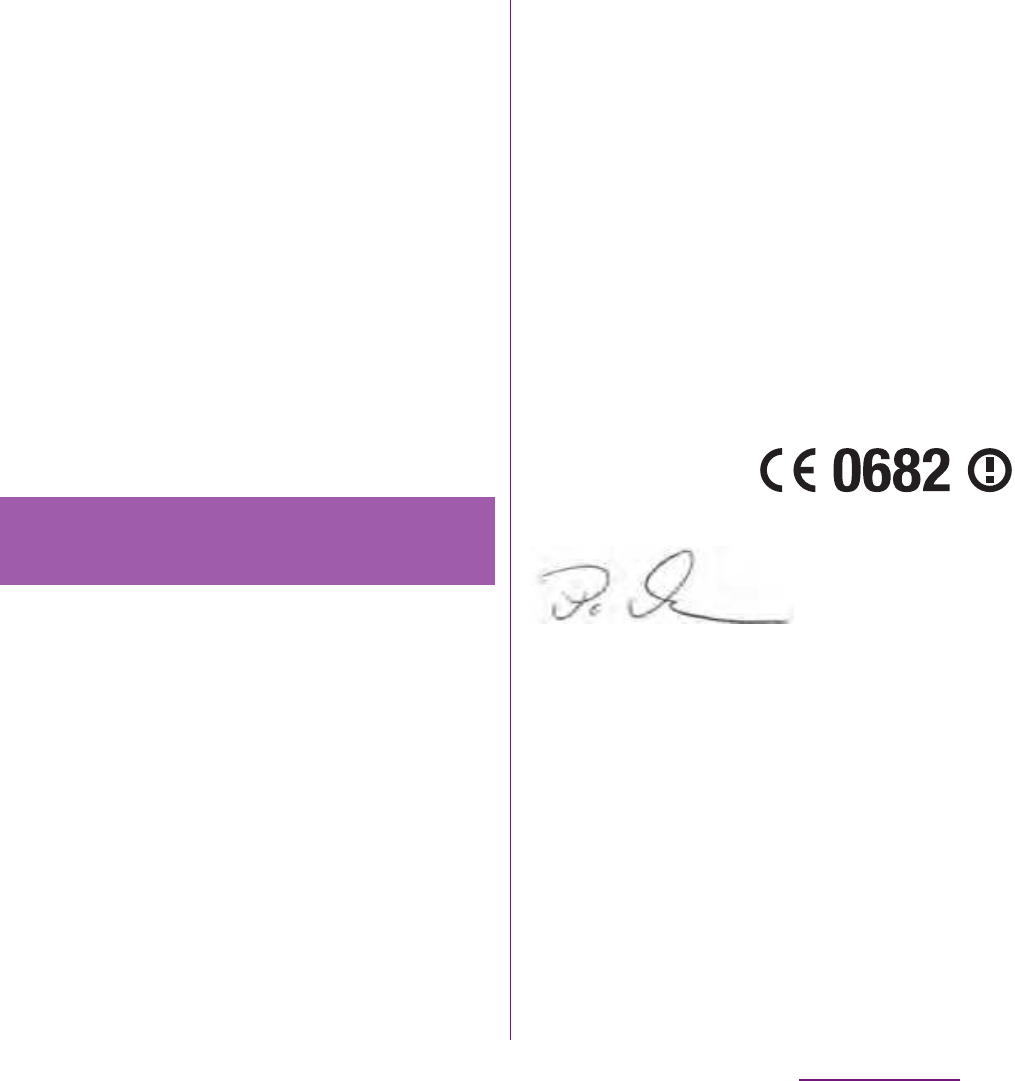
265
Appendix/Index
If this equipment does cause harmful
interference to radio or television reception,
which can be determined by turning the
equipment off and on, the user is
encouraged to try to correct the interference
by one or more of the following measures:
・
Reorient or relocate the receiving antenna.
・
Increase the separation between the
equipment and receiver.
・
Connect the equipment into an outlet on a
circuit different from that to which the
receiver is connected.
・
Consult the dealer or an experienced radio/TV
technician for help.
We,
Sony Mobile Communications AB
of
Nya Vattentornet SE-221 88 Lund, Sweden
declare under our sole responsibility that our
product
Sony type PM-0000-BV
and in combination
with our accessories, to which this
declaration relates is in conformity with the
appropriate standards EN 301 511:V9.0.2, EN
301 908-1:V5.2.1, EN 301 908-2:V5.2.1, EN 300
328:V1.7.1, EN 300 440-2:V1.4.1, EN 302
502:V1.2.1, EN 301 489-3:V1.4.1, EN 301 489-
7:V1.3.1, EN 301 489-17:V2.1.1, EN 301 489-
24:V1.5.1, EN 62 209-1:2006 and EN 60 950-
1:2006+A11:2009+A1:2010+A12:2011,
following the provisions of Radio Equipment
and Telecommunication Terminal Equipment
directive
1999/5/EC.
Lund, May 2012
Pär Thuresson,
Chief Quality Officer Head, of Quality &
Validation
We fulfill the requirements of the R
&
TTE
Directive (1999/5/EC).
Declaration of Conformity for
SO-04D

266
Appendix/Index
Software delivered with this device and its
media is owned by Sony Mobile
Communications AB, and/or its affiliated
companies and its suppliers and licensors.
Sony Mobile grants you a non-exclusive
limited licence to use the Software solely in
conjunction with the Device on which it is
installed or delivered. Ownership of the
Software is not sold, transferred or otherwise
conveyed.
Do not use any means to discover the source
code or any component of the Software,
reproduce and distribute the Software, or
modify the Software. You are entitled to
transfer rights and obligations to the
Software to a third party, solely together with
the Device with which you received the
Software, provided the third party agrees in
writing to be bound by the terms of this
Licence.
This licence exists throughout the useful life
of this Device. It can be terminated by
transferring your rights to the Device to a
third party in writing.
Failure to comply with any of these terms and
conditions will terminate the licence
immediately.
Sony Mobile and its third party suppliers and
licensors retain all rights, title and interest in
and to the Software. To the extent that the
Software contains material or code of a third
party, such third parties shall be beneficiaries
of these terms.
This licence is governed by the laws of
Sweden. When applicable, the foregoing
applies to statutory consumer rights.
In the event Software accompanying or
provided in conjunction with your device is
provided with additional terms and
conditions, such provisions shall also govern
your possession and usage of the Software.
End User Licence
Agreement
End User Licence Agreement

267
Appendix/Index
This product includes certain open source or
other software originating from third parties
that is subject to the GNU General Public
License (GPL), GNU Library/Lesser General
Public License (LGPL) and different and/or
additional copyright licenses, disclaimers and
notices. The exact terms of GPL, LGPL and
some other licenses, disclaimers and notices
are reproduced in the about box in this
product and are also available at http://
opensource.sonymobile.com.
Sony Mobile offers to provide source code of
software licensed under the GPL or LGPL or
some other open source licenses allowing
source code distribution to you on a CD-ROM
for a charge covering the cost of performing
such distribution, such as the cost of media,
shipping and handling, upon written request
to Sony Mobile Communications AB, Open
Source Software Management, Nya
Vattentornet, SE-221 88 Lund, Sweden. This
offer is valid for a period of three (3) years
from the date of the distribution of this
product by Sony Mobile.
This product and its accessories may be
covered and controlled by Japan's export
control regulations ("Foreign Exchange and
Foreign Trade Law" and related laws and
regulations). If you wish to export this
product and/or its accessories, you must
complete the necessary procedures at your
own responsibility and cost. For details about
the procedure, contact the Ministry of
Economy, Trade and Industry.
About Open Source
Software
About Open Source Software
Export Controls and
Regulations

268
Appendix/Index
About the Copyright and Portrait
rights
Copyrighted contents you recorded or
obtained from sites or Internet home pages
using this product by downloading or other
means, such as documents, images, music
data, software, are prohibited from
reproduction, transformation and
transmission over public lines without
consent of the copyright holders, unless
intended for personal use or any other
purpose permitted by law.
Note that some performances, shows, and
exhibitions may not allow photography,
movie shooting, or sound recording even for
personal use.
You should also refrain from taking a picture
of other people and disclosing it by such
means as posting it on a site on the Internet
without their consent because of possible
infringement of their right of portrait.
Trademarks
The company names and product names
appearing in this manual are trademarks or
registered trademarks of their respective
holders.
・
"FOMA", "i-mode", "i-
D
ppli", "Deco-mail", "sp-
mode", "WORLD WING", "WORLD CALL",
"ToruCa", "mopera", "mopera U", "iD", and logo
of "ToruCa" are trademarks or registered
trademarks of NTT DOCOMO, INC.
・
"Bluetooth" is a registered trademark of
Bluetooth SIG. INC., and Sony Mobile
Communications is licensed to use them.
・
"Wi-Fi" is a registered trademark of Wi-Fi
Alliance.
・
Wi-Fi Protected Setup and Wi-Fi Protected
Setup logos are registered trademarks of Wi-Fi
Alliance.
・
The Wi-Fi Protected Setup Mark is a mark of
the Wi-Fi Alliance.
・
"Catch Phone (Call waiting service)" is a
registered trademark of Nippon Telegraph
and Telephone Corporation.
Intellectual Property Right
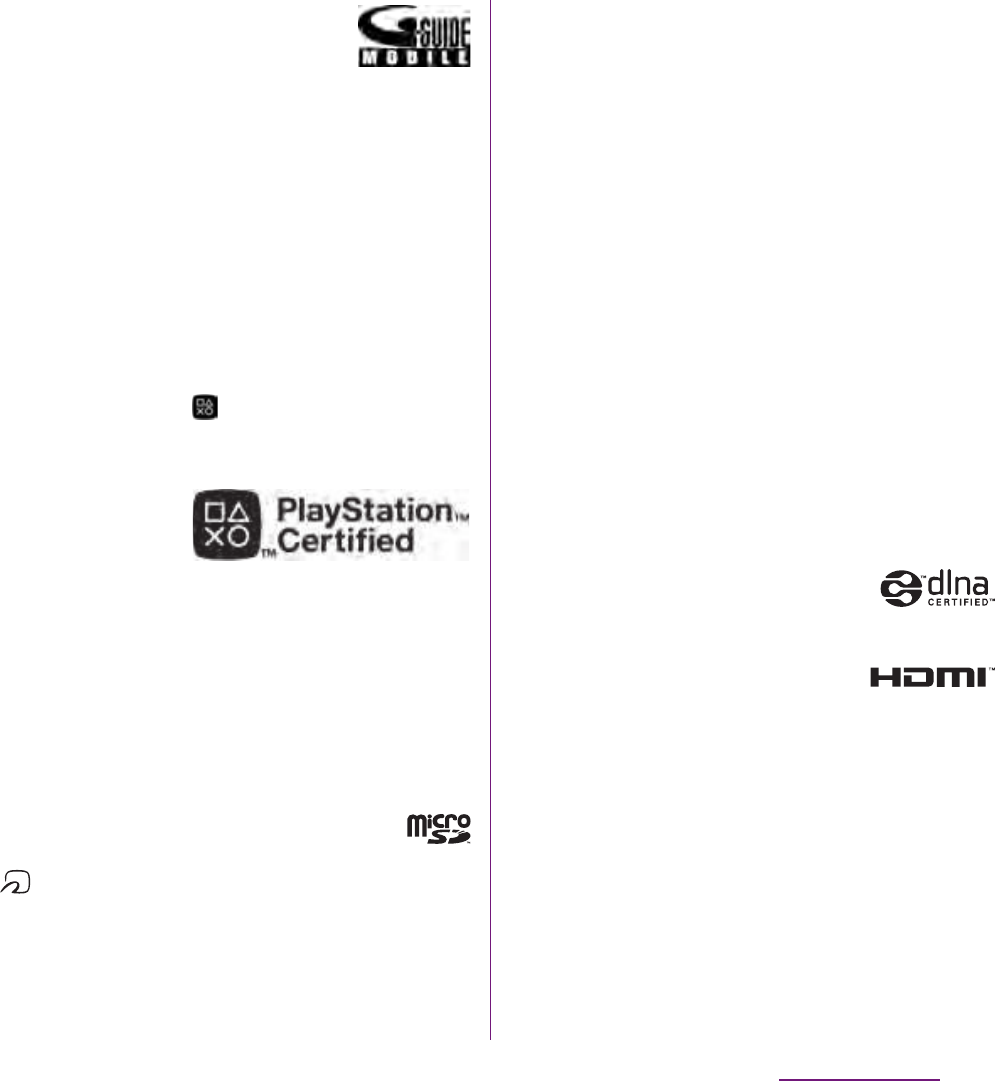
269
Appendix/Index
・
Rovi, G-GUIDE, G-GUIDE MOBILE
and their logos are registered
trademarks in Japan of U.S. Rovi
Corporation and/or its affiliates.
・
"Liquid Identity" logo, "Xperia", "PlayNow", and
"Timescape" are trademarks or registered
trademarks of Sony Mobile Communications
AB.
・
"APP NAVI", "acro" is a registered trademark of
Sony Mobile Communications, Inc.
・
"Media Go" is a trademark or registered
trademark of Sony Electronics Inc.
・
"PlayStation" and " " are trademarks or
registered trademarks or Sony Computer
Entertainment Inc.
・
"BRAVIA", "POBox", "Sony" and "Exmor R for
mobile" are trademarks or registered
trademarks of Sony Corporation.
・
"POBox" is a co-developed technology of
Sony Computer Science Laboratories, Inc. and
Sony Mobile Communications Japan, Inc.
・
"xLOUD" is a trademark of Sony Corporation.
・
microSD logo is a trademark of SD-3C,
LLC.
・
is a registered trademark of FeliCa
Networks, Inc.
・
FeliCa is a contactless IC card technology
developed by Sony Corporation.
・
FeliCa is a registered trademark of Sony
Corporation.
・
"Twitter" is a trademark or registered
trademark of Twitter, Inc.
・
"3GPP" is a trademark or registered trademark
of ETSI.
・
"Google" and "Google" logo, "Android" and
"Android" logo, "Android Market" and
"Android Market" logo, "Gmail", "mobile
Google Maps", "Google Talk", "Google
Latitude", "Google Calendar", "YouTube" and
"YouTube" logo and "Picasa" are trademarks or
registered trademarks of Google, Inc.
・
"Facebook" is a trademark or registered
trademark of Facebook, Inc.
・
mixi and mixi logo are registered trademarks
of mixi, Inc.
・
DLNA is a trademark or registered
trademark of the Digital Living
Network Alliance.
・
HDMI, the HDMI Logo and High-
Definition Multimedia Interface, are
trademarks or registered trademarks of HDMI
Licensing LLC.

270
Appendix/Index
・
"Microsoft", "Windows", "Outlook", "Windows
Vista", "Windows Server", "Windows Media"
and "ActiveSync" are trademarks or registered
trademarks of Microsoft Corporation in the
United States and other countries.
・
This product contains technology subject to
certain intellectual property rights of
Microsoft. Use or distribution of this
technology outside of this product is
prohibited without the appropriate license(s)
from Microsoft.
・
Content owners use Microsoft PlayReady
™
content access technology to protect their
intellectual property, including copyrighted
content. This device uses PlayReady
technology to access PlayReady-protected
content and/or WMDRM-protected content.
If the device fails to properly enforce
restrictions on content usage, content owners
may require Microsoft to revoke the device's
ability to consume PlayReady-protected
content. Revocation should not affect
unprotected content or content protected by
other content access technologies. Content
owners may require you to upgrade
PlayReady to access their content. If you
decline an upgrade, you will not be able to
access content that requires the upgrade.
・
Contains Adobe
®
Flash
®
Player technology by
Adobe Systems Incorporated.
Adobe Flash Player Copyright
©
1996-2011
Adobe Systems Incorporated. All rights
reserved.
Adobe, Flash and Flash logo are either
registered trademarks or trademarks of
Adobe Systems Incorporated in the United
States and/or other countries.
・
This product is licensed under the MPEG-4
visual and AVC patent portfolio license for the
personal and non-commercial use of a
consumer for (i) encoding video in
compliance with the MPEG-4 visual standard
("MPEG-4 video") or the AVC standard ("AVC
video") and/or (ii) decoding MPEG-4 or AVC
video that was encoded by a consumer
engaged in a personal and non-commercial
activity and/or was obtained from a video
provider licensed by MPEG LA to provide
MPEG-4 and/or AVC video. No license is
granted or shall be implied for any other use.
Additional information including that relating
to promotional, internal and commercial uses
and licensing may be obtained MPEG LA,
L.L.C. ("See http://www.mpegla.com "). MPEG
Layer-3 audio decoding technology licensed
from Fraunhofer IIS and Thomson.

271
Appendix/Index
・
Other product and company names
mentioned herein may be the trademarks of
their respective owners.
In context, TM and
®
mark are omitted.
・
Any rights not expressly granted herein are
reserved. All other trademarks are property of
their respective owners.

272
Appendix/Index
A
About phone .............................................. 140
Access point
Initializing................................................ 110
Setting ..................................................... 109
Accessibility ................................................ 139
Account setting
Facebook................................................. 133
Google ..................................................... 132
Accounts & sync......................................... 132
Auto-sync ................................................ 135
Adjusting sound volume.......................... 120
Airplane mode ........................................... 111
Alarm and Clock......................................... 229
Setting alarm .......................................... 230
Android Market.......................................... 204
Anshin Scan ................................................... 73
APP NAVI ........................................................ 73
Applications. .........................................71, 129
Adding to Home screen........................... 77
Icon ............................................................. 72
Managing................................................ 130
Searching ................................................... 79
Sorting........................................................ 77
Uninstalling.......................................77, 131
Applications button ..................................... 66
Applications screen...................................... 71
Group................................................... 78, 79
Learning ..................................................... 71
Switching ................................................... 80
Area Mail ...... ............................................... 152
Audible touch tones ........................... ....... 121
AUTO-GPS............................................. 75, 107
Auto-rotate screen .............................. .......122
B
Backlight
Turning off ........................................ 38, 123
Turning on ........................................ 39, 132
Backup & restore ........................................ 108
Backing up........................................ .......108
Restoring.................................................. 109
Battery level.......................................... 34, 140
Bluetooth.............................................. ....... 166
Device name .................................... ....... 167
Pair setting............................................... 167
Book Store MyShelf...................................... 73
Bookmark ............................................. ....... 156
Bookmarking a web page..................... 156
Editing ...................................................... 157
Opening ............................................ ....... 157
Brightness........................ ............................ 122
Browser ........................................................ 153
Adjusting settings .................................. 155
Auto-fitting a web page ........................ 155
Closing ..................................................... 154
Copying text................ ............................ 155
Displaying................................................ 154
Displaying new browser window . ....... 154
Exiting ............................................... ....... 154
Going back to the previous page . ....... 153
Moving ..................................................... 153
Index

273
Appendix/Index
Opening .................................................. 153
Searching text ........................................ 154
Setting home page..... ........................... 155
Switching browser windows................ 154
Zooming in/out...................................... 154
C
Calculator....................................................... 75
Calendar ...................................................... 227
Creating schedule.................................. 228
Displaying schedule .............................. 228
Call................................................................... 81
Declining.................................................... 83
Ending a call .............................................. 82
Making................................................. 81, 83
Mute............................................................ 84
On hold....................................................... 85
Receiving............................................. 82, 83
Speaker....................................................... 84
Call forwarding.............................................. 99
Call history ..................................................... 85
Adding to Phonebook ............................. 86
Deleting...................................................... 86
Making a call.............................................. 86
Call settings ................................................ 119
Call Waiting................................................. 101
Caller ID Display Request Service............ 103
Caller ID Notification................................. 102
Camera ........................................................ 172
Face detection............. ........................... 177
Front camera .......................................... 176
Front video camera ............................... 186
Quick launch........................................... 176
Recording videos ................................... 186
Settings (still camera) ............................ 181
Settings (video camera)......................... 188
Shooting still pictures..................... ....... 174
Smile detection................................ ....... 178
Sweep Multi Angle .......................... .......179
Sweep Panorama.................................... 179
3D Sweep Panorama.............................. 179
Character entry............................................. 47
Character mode.................... 49, 52, 56, 57
Input method........................ 49, 52, 56, 57
Settings ...................................................... 60
Charging ........................................................ 33
Using a PC.................................................. 36
Using AC adapter...................................... 36
Using desktop holder .............................. 34
Chat .............................................................. 151
Checkbox....................................................... 46
Connected devices (Media server).......... 170
Contact Picker 2.3.................................. 49, 64
Contacts......................................................... 72
D
Data synchronization................................. 134
Auto-sync................................................. 135
Date & time. ................................................. 139
Dial.................................................................. 72
Disaster kit..................................................... 73
Display.......................................................... 122
dmarket.......................................................... 72
dmenu............................................................ 72
docomo backup ........................................... 72
docomo location information.................... 76
docomo service .......................................... 107

274
Appendix/Index
E
Ear speaker volume ...................................... 84
Early Warning "AreaMail".......................... 152
eco mode ....................................................... 75
Email ............................................................ 144
Deleting................................................... 147
Forwarding ............................................. 147
Initial settings ......................................... 144
Receiving................................................. 145
Replying .................................................. 147
Saving attachment file.......................... 146
Sending ................................................... 144
Email account
Adding..................................................... 148
Changing................................................. 148
Deleting................................................... 149
Emergency call.............................................. 81
F
Facebook..................................................... 133
Deleting................................................... 134
Flash Player Settings .................................... 76
FM radio ...................................................... 222
Force-quite..................................................... 38
Foursquare.................................................. 205
G
Gallery (photos/videos) ............................ 193
G-Guide program table ............................... 74
Gmail............................................................ 151
Google......................................................... 132
Deleting................................................... 134
Google Maps .............................................. 211
Current location ..................................... 211
Directions ................................................ 213
Google Latitude...................................... 214
Layers........................................................ 213
Street View .............................................. 212
Google Talk.................................................. 151
Google+ ......................................................... 74
GPS function ........................................ ....... 209
Enabling GPS function........................... 211
Enabling Wireless networks.................. 211
H
Handwritten input ....................................... 57
HDMI............................................................. 199
Home application......................... 66, 80, 108
Home screen ................................................. 66
Adding........................................................ 70
Deleting ..................................................... 70
Folder ......................................................... 69
Group ......................................................... 70
Kisekae ....................................................... 69
Learning.. ................................................... 66
List............................................................... 67
Shortcut ..................................................... 67
Sorting........................................................ 70
Wallpaper................................................... 69
Widget........................................................ 68
I
i-Channel........................................................ 72
Index character............................................. 45
Infrared communication ........................... 163
Infrared data port ............................ 29, 163
Initial settings................................................ 39
Internal storage .......................................... 136

275
Appendix/Index
Format ..................................................... 137
International call........................................... 82
International roaming service ................. 234
International roaming setting ................. 240
J
Japanese syllabary keyboard...................... 56
K
Key lock
Setting ........................................................ 38
Unlocking. .................................................. 39
Keys................................................................. 44
Kisekae............................................................ 69
Koe-no-Takuhaibin .................................... 105
L
Landscape view ......................................... 122
Language & keyboard............................... 138
Light sensor ................................................... 29
Link............................................................... 156
Location information ................................ 209
Location & security......... ........................... 124
M
Machi-chara................................................... 72
Map Application ........................................... 74
Media Go..................................................... 162
Data transfer ........................................... 163
Installing.................................................. 162
Playlist...................................................... 203
Media Player .................................................. 73
Memo ............................................................. 74
Message (SMS)............................................ 141
Deleting message................................... 143
Deleting thread................................ .......143
New registration of contact.................. 142
Receiving ................................................. 142
Sending........................ ............................ 141
Setting............................................... ....... 143
Messenger ..................................................... 74
micro USB cable.............. ............................ 158
microSD card........................................ 31, 136
Format..... ................................................. 137
Missed call ..................................................... 86
mixi ............................................................... 205
Mobile BRAVIA Engine........................ ....... 122
mopera U..................................................... 111
mopera U Mail ................ ............................ 149
Moving data ................................................ 158
Music player ......................................... ....... 200
Playback.. ................................................. 200
Playlist ...................................................... 203
Share........ ................................................. 202
My profile....................................................... 90
N
Name card creator........................................ 75
Network connection settings............ .......109
Network mode............................................ 238
Notification icon........................................... 41
Notification LED............................................ 43
Notification panel......................................... 42
Notification ringtone ..... ............................ 121
Nuisance Call Blocking service................. 103

276
Appendix/Index
O
OfficeSuite .................................................. 233
Online dictionary.......................................... 63
Osaifu-Keitai ............................................... 223
Osaifu-Keitai Lock Settings .................. 225
Own number ................................... 7, 90, 140
P
PC Companion ........................................... 159
Personal area ................................................. 80
Phone language......................................... 138
Phonebook .................................................... 87
Adding a new entry.................................. 88
Combining ................................................. 89
Deleting...................................................... 90
Editing ........................................................ 89
Exporting ............................................ 92, 95
Favorites ..................................................... 91
Importing............................................ 93, 95
Making a call.............................................. 90
My profile ................................................... 90
Searching ................................................... 88
Sending ...................................................... 91
Setting photo ............................................ 92
PhoneBookCopy ........................................... 94
Phonepad keyboard....... .............................. 49
PIN code ...................................................... 126
Playing video.............................................. 197
PlayNow ...................................................... 233
POBox Touch User Guide...................... 58, 65
Preferred apps settings.......................66, 108
Privacy ......................................................... 135
Proximity sensor ........................................... 29
PS Store ....................................................... 233
PUK code (Personal Unblocking Key)...... 126
Q
QWERTY keyboard ....................................... 52
R
Radio button ................................................. 46
Recording videos........................................ 186
Remote operation settings....................... 104
Reset............................................................. 135
Restart ............................................................ 38
Ringtone setting.................................. ....... 121
Ringtone volume................................. 84, 121
S
Schedule ........................................................ 74
Creating ................................................... 228
Displaying................................................ 228
Screen lock . ................................................. 127
Changing ................................................. 128
Setting............................................... ....... 127
Screen lock setting..................................... 123
Screenshot....................... ............................ 191
SE Home........................... ............................ 233
Searching....................................................... 46
Voice search............................................... 46
Second call settings ................................... 104
Security code
Network security code........................... 125
PIN code................................................... 126
Setting menu .............................................. 107
Setup guide................................................... 39
Shooting still pictures................................ 174
Silent mode ................................................. 120

277
Appendix/Index
Slideshow..... ............................................... 196
Software keyboard ....................................... 48
Software update ........................................ 252
Sound .......................................................... 119
Specific Absorption Rate of Mobile Phone
...................................................................... 258
Specification............................................... 255
sp-mode ...................................................... 110
sp-mode mail ............................................. 141
Status bar ....................................................... 41
Status icon ... .................................................. 41
Stereo Headset with Microphone
...................................................... 83, 193, 222
Stopwatch................................................... 232
Storage ........................................................ 136
T
Tethering..................................................... 116
USB tethering ......................................... 116
Wi-Fi tethering ....................................... 117
Theme.......................................................... 122
Timer............................................................ 232
Timescape................................................... 205
Display Tiles ............................................ 208
Filter ......................................................... 207
Setting ............................................ 206, 208
Tile............................................................ 206
ToruCa.......................................................... 226
Touch screen ................................................. 44
Drag ............................................................ 44
Flick ............................................................. 45
Pinch ........................................................... 45
Tap............................................................... 44
Touch .......................................................... 44
Transferring data........................................ 158
Troubleshooting......................................... 243
Turning power on/off .................................. 37
Twitter .......................................................... 205
U
UIM .......................................................... 20, 30
PIN............................................................. 126
Update center ............................................. 252
USB connection ................................... 36, 158
USB storage................................................. 136
Format..... ................................................. 137
User dictionary.............................................. 62
English user dictionary ............................ 62
Japanese user dictionary ........................ 62
User dictionary settings .............................. 62
Backing up and restoring........................ 63
V
Vibration .......................... 120, 143, 229, 230
Videos............................................................. 74
Viewing photos .......................................... 196
Voice input & output........................... ....... 138
Voice Mail service ......................................... 97
VPN ............................................................... 118
W
Wallpaper....................................................... 69
Web history ................................................. 157
Wi-Fi.................................. ............................ 112
Sleep policy ...................................... ....... 115
WPS settings............................................ 114
Wireless & networks............................ .......109
Word suggestion .......................................... 61
Words by learning ........................................ 63

278
Appendix/Index
WORLD CALL ................................................. 82
World clock ................................................. 231
WORLD WING ............................................. 234
X
xLOUD.......................................................... 119
Xperia........................................................... 108
Xperia Japanese keyboard .......................... 47
Setting ........................................................ 60
Y
YouTube ...................................................... 198
Numerics
1Seg ............................................................. 215
Initial settings ......................................... 216
TVlink....................................................... 219
Watching program ................................ 217
1Seg antenna ...................................29, 216
3D album..................................................... 194

Don't forget your mobile phone ... or your manners!
Remember to be courteous to others when you use your terminal.
Turn the power off when you are:
■
In places where use is prohibited
Be sure to switch the power off in an aircraft or a
hospital.
* Turn off your terminal even in hospital lobbies
and waiting rooms as well as hospital wards if
electronic medical devices may be in use near
you.
■
In crowded places such as peak-hour trains if
implanted electronic medical devices may be in
use near you
Radio waves emitted by the terminal may
adversely affect implanted pacemakers and ICDs
when used in close proximity.
■
Driving
Using a handheld mobile phone while driving will
result in a penalty.
However, absolutely necessary cases such as
rescue of a sick person or maintaining public's
safety are exempted.
■
In places such as theaters, cinemas, and art
galleries
Using the terminal in a public place, where you
need to be quiet, annoys people around you.
Keep your voice and ring tone down
■
Keep your voice down in quiet places like
restaurants and hotel lobbies.
■
If you are in an outdoor public place, make sure
you do not disturb others.
Respect privacy
Please be considerate of the privacy of
individuals around you when taking and
sending photos using camera-equipped
mobile phones.
Have good manners
The terminal is equipped with useful functions
not to answer an incoming call or to mute the
sound.
【
Vibrate
】
(P.120)
Vibrates when there is an incoming call.
【
Silent mode
】
(P.120)
Silent mode mutes the sounds of the terminal such
as the keypad sounds and the ring tone.
* Shutter sound cannot be muted.
You can also use optional services such as the
Voice Mail Service (P.97) and Call Forwarding
Service (P.99).
Make various applications or charge your billing plan, check your charges and points, and more
online.
My docomo (http://www.mydocomo.com/) ⇒ 各種お申込・お手続き (Various applications/procedures) *In
Japanese only.
* "docomo ID and password" are required for use.
*
Please contact "General Inquiries" described on the last page of this manual if you forget or do not have "docomo ID and password".
* May not be available in some cases depending on the conditions of your subscription.
* There are cases where the site may not be available due to system maintenance, etc.

General Inquiries
<docomo Information Center>
0120-005-250 (toll free)
*Service available in: English, Portuguese, Chinese, Spanish, Korean.
*Unavailable from part of IP phones.
(Business hours: 9:00 a.m. to 8:00 p.m.)
■From DOCOMO mobile phones (In Japanese only)
(No prefix) 151 (toll free)
*Unavailable from land-line phones, etc.
■From land-line phones (In Japanese only)
0120-800-000 (toll free)
*Unavailable from part of IP phones.
(Business hours: 9:00 a.m. to 8:00 p.m. (open all year round))
●Please confirm the phone number before you dial.
●For Applications or Repairs and After-Sales Service, please contact the above-mentioned information center or the docomo
shop etc. near you on the NTT DOCOMO website.
NTT DOCOMO website http://www.nttdocomo.co.jp/english/
Loss or theft of terminal or payment of cumulative cost overseas
<docomo Information Center>
(available 24 hours a day)
From DOCOMO mobile phones
Failures encountered overseas
<Network Support and Operation Center>
(available 24 hours a day)
From DOCOMO mobile phones
International call access code
for the country you stay -81-3-6832-6600* (toll free)
*
You are charged a call fee to Japan when calling from a land-line phone, etc.
*If you use SO-04D, you should dial the number +81-3-6832-6600
(to enter '+', touch and hold '0').
From land-line phones
<Universal number>
Universal number international
prefix -8000120-0151*
*You might be charged a domestic call fee according to the
call rate for the country you stay.
*For international call access codes for major countries and
universal number international prefix, refer to DOCOMO
International Services website.
●If you lose your terminal or have it stolen, immediately take
the steps necessary for suspending the use of the terminal.
●
If the terminal you purchased is damaged, bring your terminal
to a repair counter specified by DOCOMO after returning to Japan.
Don’t forget your mobile phone・・・or your manners!
٧When using your mobile phone in a public place, don’t forget to show
common courtesy and consideration for others around you.
-81-3-6718-1414* (toll free)
International call access code
for the country you stay
*
You are charged a call fee to Japan when calling from a land-line phone, etc.
*If you use SO-04D, you should dial the number +81-3-6718-1414
(to enter '+', touch and hold '0').
From land-line phones
<Universal number>
Repairs
■From DOCOMO mobile phones (In Japanese only)
(No prefix) 113 (toll free)
*Unavailable from land-line phones, etc.
■From land-line phones (In Japanese only)
0120-800-000 (toll free)
*Unavailable from part of IP phones.
(Business hours: 24 hours (open all year round))
-8005931-8600*
Universal number international
prefix
*You might be charged a domestic call fee according to the
call rate for the country you stay.
*For international call access codes for major countries and
universal number international prefix, refer to DOCOMO
International Services website.
Sales: NTT DOCOMO, INC.
Manufacturer: Sony Mobile
Communications Japan, Inc
’12.02 (1st Edition) 1261-6948.1
We collect old phones, etc. regardless of brands and
manufacturers. Bring them to your nearest docomo Shop.
*
Items to be collected: mobile phones, PHS, battery
packs, chargers, desktop holders (regardless of brands
and manufacturers)
Li-ion 00